Truly Tokyo
A Tokyo Travel Guide

Hakone Day Trip Itinerary
Make the most of a day out in the mountain town of Hakone, only 1.5 hours from Tokyo, with our Hakone Day Trip Itinerary. We’ve included a second day extension for those who want to stay overnight and explore the area further.

When it comes to day trips, Hakone is one of the top choices for most visitors to Japan. With its tranquil caldera lake, atmospheric shrines and temples, historical walking trails, and a concentration of great art museums, this mountainous hot spring town has a lot going for it. Our itinerary will help you make the most of your time here.

This itinerary contains the following sections:
- Notes Before You Go
- Overview of the 2-day Hakone Free Pass
- The Full Hakone Day Trip Itinerary
- Day 2 Extension for the Hakone Itinerary
Hakone Day Trip Map
- Recommended Accommodation in Hakone

Notes Before You Go To Hakone
- We suggest using the 2-day Hakone Free Pass to explore the Hakone area. See the following section for further details.
- We suggest leaving on a reasonably early train from Shinjuku and aiming to arrive at Hakone-Yumoto Station between 8:45am – 9:30am. This will give you a full day there, with ample time to explore at leisurely pace.
- Our itinerary covers a day trip from Shinjuku. Day one includes the majority of the classic tourist highlights in Hakone.
- As there are many great hot spring resorts in Hakone and it makes sense for some to do overnight stays, we’ve included a second day extension for anyone wishing to do just that. It’s also a good alternative to the first day for those who prefer a leisurely, nature-filled day.
- If you are staying overnight, you may want to seriously consider a Japanese-style ryokan with a hot spring bath. See our accommodation recommendations at the end of this itinerary for more information.
- We strongly recommend visiting during off-peak seasons or at least on a weekday.
- Itinerary timings are approximate, particularly as train, bus, funicular, and boat times can vary with the season. Adjust the timings to suit your schedule. It’s an excellent idea to check train or bus times when changing mode of transport to make sure you won’t miss a connection.
- This itinerary is a guideline. Add or subtract places as you like.
- We’ve put in directions at the end of each section to minimise clutter.
- This is mostly a walking itinerary. Although this itinerary takes you on several modes of public transportation, there’s still some walking involved. Put on your most comfortable shoes and give it a shot.

Should you get the 2-day Hakone Free Pass?
In a word, yes. This is by far the most economical way to travel around the Hakone area. It provides you with a return trip from Shinjuku to Odawara Station, and then unlimited travel around the Hakone area on all modes of public transportation, including bus, boat, funicular, and train. Flashing the pass will also net you small discounts at many of the museums and attractions in the area.
Best of all, it minimises all the hassle of travel, saving you the headache of counting change on the bus to pay your fare each time you alight, or buying tickets for each train, funicular, bus, and boat ride.

You cannot purchase the Hakone Free Pass at most smaller stations along the Odakyu line; it’s also not available as an option at the ticket machines. You can buy the pass at the Odakyu Sightseeing Center at the West Ground Gate of Shinjuku Station. However, the queue can be lengthy at the counter, especially during peak season. Who wants to deal with that first thing in the morning when you’re itching to go?
We suggest minimising your time spent in ticket lines by purchasing the 2-day Hakone Free Pass online . After that, it’s a simple process of picking it up at the Odakyu Sightseeing Center. We strongly suggest popping by the day before your day trip to pick up your pass. If you’re still on the fence, consider this: purchasing it online is actually cheaper than buying it from the Odakyu counter. The catch is that you have to be a tourist, so this is not an option open to Japan residents.

Hakone Itinerary: Day 1
7:00am travel from shinjuku to hakone-yumoto station.
Begin bright and early at Shinjuku Station. You’ll need to find the entrance to the Odakyu Line. If you haven’t picked up your 2-day Hakone Free Pass yet, you can purchase this at the Odakyu Sightseeing Center or Odakyu Romance Car counter. Both are next to each other. Getting to Hakone-Yumoto Station means getting the rapid express bound for Odawara. From there, you’ll change to the Hakone-Tozan line and get off at the final stop.

However, if you’d like to travel on the Romance Car – which essentially is a reserved-seat train with very few stops that goes directly to Hakone-Yumoto Station – you’ll save about half an hour in travel time. Ask the counter staff for a ticket along with your Free Pass. This will cost an additional JPY1,090.

Is the Romance Car worth it? If you want to travel in a little extra comfort and be able to eat breakfast on the train, definitely.
The earliest direct Romance Car train to Hakone-Yumoto Station leaves at 7:00am. There’s also one available at 7:38am. But, you should always check train times before you go.

9:20am Hakone-Yumoto Station
If you’ve taken the later train, you’ll arrive around 9:20am. Head towards the exit. If you have luggage or extra bags to leave at the station, there’s a baggage counter that will take care of them for you – they are located outside the ticket barriers. Alternatively, you can use the coin lockers. They are available both inside and outside the ticket barriers.

For those staying overnight, they provide a rather nifty luggage delivery service, sending your suitcases directly to any inn or hotel in the Hakone area. If you’ve dropped off the luggage before 10:00am, they deliver the luggage by 3:00pm on the same day – how’s that for efficiency?

Showing them your Free Pass also nets you a JPY100 discount for this service.

10:15am Hakone Shrine and the Peace Shrine Gate
Hakone Shrine is rather beautiful and atmospheric, starting with its lantern-lined path through the forest and ending with the red ‘Peace’ torii gate floating in the water. The latter must be one of the most iconic sights in Hakone. Short of visiting its larger and more famous counterpart at Miyajima Island, this is as atmospheric a Shinto scene as you’re going to find anywhere near Tokyo. It is gorgeous all year, but especially in the rain or when shrouded in mist.

To get here, head over to buses bound for Hakone. Turn left at the ticket barriers and follow the signs to the bus stops. You need to head for Hakone Shrine – either the Moto-Hakone-ko or Hakone-jinja-iriguchi stop. Buses departing from Stop 4 go to these places. If you’re unsure, your best bet is to ask the bus station attendants hovering around the area. Buses leave frequently. You should aim to leave by 9:40am to arrive around 10:15am. Settle in for a scenic 40-minute bus ride through the mountains.

Alight at the bus stop. Turn and cross the road, walking anti-clockwise around Lake Ashinoko, towards the mountains with the lake on your left. You’ll pass an Italian restaurant on your right. Walk through the large red torii gate. The steps to Hakone Shrine are up ahead to your right after a little more walking.

After exploring the shrine, walk back down the steps towards the lake. Keep walking down, crossing the road. You’ll see the floating Peace Shrine Gate at the bottom of the steps – plus some people waiting to take photographs in front of it.

11:00am Old Tokaido Highway Cedar Avenue and Hakone Checkpoint
Hakone was once a major checkpoint along the old Tokaido road, one of five main highways linking Tokyo and Kyoto during the Edo period. Not much remains of the original highway, but there is a pleasant hiking trail along which remains a section of original stone pavement. For this itinerary, you’ll walk along another original section of the Tokaido highway, a 500 metre-long cedar avenue.

This cedars flanking this forest passage are centuries old, some reaching up to 3 metres high and having a diameter of over 4 metres.

Those interested in Japanese history should consider a visit around the buildings of the Hakone Checkpoint, if not also the exhibition hall. It’s quite fascinating seeing the various facilities common at checkpoints along these feudal period highways, from foot soldier housing to a prison chamber. You can even climb all the way to the lookout tower. Security was tight during the Edo period!

Of course, passing through the checkpoint without going inside the buildings won’t cost you a thing.

If you wish, you can stop by Onshi Hakone Park en route – just before the Sekisho Museum – and check out some views of the lake.

To get here, walk back the way you came. Continue onwards, skirting clockwise along and around the lake. You’ll pass Moto-Hakone Port on the way. When you see a large red shrine gate ahead to your left, pass through and continue keeping left. You’ll see an avenue flanked by tall cedar trees ahead of you. This is approximately 500 metres long.

Once you’re through the avenue, you’ll see a parking lot to your right, a park, and glimpses of the lake beyond. Essentially, you want to continue skirting along the lake to visit the Hakone Sekisho Exhibition Hall and the Hakone Checkpoint. If you want to walk around more, you could explore Onshi Hakone Park en route. This is right where the parking lot is. The way to the barrier checkpoint and the small museum are clearly signposted.

12:15pm Lunch
It’s time to refuel after a busy morning of exploring. As there are limited options on the other side of the lake at Togendai, we suggest eating around the area just after the Hakone Checkpoint. There are a decent number of restaurants here. Take your pick from udon or soba noodles, curry, seafood rice bowls, and ramen. We’ve marked several of these on the accompanying Google Map towards the end of this post.

Daimasa, located a 3-minute walk from the Hakone Checkpoint, is a decent place for a fresh sashimi set lunch. Portions are generous and there are English-language menus.

To get here, walk straight from the Hakone Checkpoint to the main road. Cross the road and turn right. Walk down the hill. Daimasa will be on your left shortly.

1:00pm Pirate Ship Cruise from Hakone-machi to Togendai
En route, you will probably have seen colourful ships sailing across the caldera lake. These ‘pirate’ ships are modeled on English battleships of yore, and are operated by the Hakone Sightseeing Boat company. The Hakone Free Pass is valid for these ships. Sure, the pirate ships are a little cheesy, but it’s one way to cross the lake to the other side.

The white passenger ships, in contrast, are operated by Izuhakone Sightseeing Boats, and you can’t use the Free Pass on them.

It takes about half an hour in total to cross the lake on this ship, passing by Moto-Hakone port on the way. This is also a good time to photograph the floating red torii gate from the other side as the boat passes by.

To get here, keep walking along the lake, passing a huge concrete hotel on your right. You’ll see the port on your right after a while. The pirate ships leave twice an hour. We boarded the ship departing at 1:10pm; boarding time begins 10 minutes prior. Departure times can vary with the season, however, so it’s best to check them if you don’t want to be stuck waiting too long.

1:45pm Togendai Station to Gora Station
At this juncture, we would suggest riding a cable car along the Hakone Ropeway to enjoy stunning views of the volcano below, and exploring Owakudani. However, an increase in volcanic activity led to them suspending the cable car operations and closing off the general area for the time being. We’ll update this if there are any changes.
Nevertheless, the replacement shuttle bus running between Togendai and Sounzan stations is still the most efficient way to go across this mountain. Follow the signs for the shuttle bus. It’s a short 10+ minute ride to Sounzan Station.
From Sounzan Station, you’ll take the funicular down to Gora Station. The ride is slow but pleasant, with beautiful greenery on either side. It’s especially beautiful in autumn when they turn fiery reds and golds. This is, of course, covered by the Free Pass. After the short bus ride, you’ll alight at Sounzan Station and follow the signs to the cable car station.
If you’ve decided to stay overnight in Hakone, it is likely that your inn will be in the Gora area. Many of them are located on the slopes along this cable car route. There are also a number of attractions in the area. These include the Hakone Museum of Art, Gora Park, and a ninja cafe.

2:50pm Hakone Open Air Museum
If you visit just one museum in the Hakone area, it should be the Hakone Open Air Museum. This alone is worth a day trip out here – there’s nothing quite like it in Tokyo. Wander around the sprawling, verdant grounds of the Hakone Open Air Museum and take in a superb collection of sculptures.

The museum closes at 5:00pm, and we recommend spending the rest of your afternoon exploring the museum grounds. You could easily spend two to three hours just doing that. With works ranging from the delightful and powerful to the eccentric and surprising, there’s a great deal to see. There’s even an entire exhibition hall showcasing a good collection of Picasso’s paintings and drawings.

We’d rather not spoil the whole experience, so here are just a few highlights from the museum:

One of the more surreal but arresting works here is La Pleureuse by Francois-Xavier and Claude Lalanne. It means ‘the mourner,’ depicting a woman’s head in stone, shedding a tear into the water she lies in.

The aptly-named ‘Curved Space – Diamond Structure’ is a fantastic gemstone installation by Peter Pearce. Unfortunately, only children below 12 are allowed to climb in and around the structure, but you can still walk around and admire it.

Another great installation for children to interact with is Horiuchi MacAdam’s Knitted Wonder Space 2. Created using over 650kg of braided nylon, it’s a colourful and charming structure that’s sure to delight both children and adults alike.

To get here after riding the funicular, transfer at Gora Station to the train platform. Ride it one stop to Chokunomori Station. Exit the station and walk up the road about 100 metres to the museum. Enjoy.

4:45pm Head back to Shinjuku Station
After a full day out in Hakone, it’s time to head back to Tokyo. Hop back on the train and ride it to Hakone-Yumoto Station. From there, you can make your way back to Shinjuku either on the Romance Car, or via Odawara Station. For the latter, you’ll ride the Hakone-Tozan Line to Odawara Station, and change to the Odakyu Line and take the next rapid express or express train to Shinjuku Station. Your Free Pass includes this trip back.
If you’re staying overnight in Hakone, this is a good time to head to your inn to for check-in and a soak in the hot springs before dinner. Check out our list of recommended accommodations in the area at the end of this itinerary.

Hakone: Day 2 Extension
While the first day alone covers the tourist highlights of the Hakone area, it’s not a bad idea to stay overnight at a Japanese-style inn so that you can continue exploring all that this town has to offer. There’s plenty more in the way of museums, natural attractions, and hiking in the area. This is a good example of how you can do it.

9:15am Hakone Botanical Gardens of Wetlands
The Hakone Botanical Garden of Wetlands is a large park showcasing over 1700 varieties of marsh and alpine plants. It’s far more interesting than it might sound at first. Not only will you walk through different types of marshland from fens to bogs, and see dozens of different flowers, a walk through this verdant plant wonderland is just such a great way to begin your morning.

We visited in early June when the Nikko Kisuge (day lilies) were in full bloom. At this time of the year, you’ll also see beautiful Japanese irises (ayame).

They also hold special exhibitions of flowers and plants native to other parts of the world. At the time of our visit, there were dozens of bewitching Himalayan blue poppies.

The best thing about botanical gardens is that each season brings different plants and flowers. Be warned that this garden is closed during winter.

You’ll want to spend at least an hour slowly soaking in the various plants and enjoying the scenery. Don’t forget to allocate some time to have coffee at the cafe after exploring the botanical gardens. They serve a delicious affogato that’s a great mid-morning pick-me-up. As a plus, the cafe itself is delightfully airy and plant-filled, with plenty of natural light streaming in through the windows.
A note about ticket prices here: at the Botanical Gardens, Lalique Museum, POLA Museum of Art, and other museums in this area, there are combination tickets available that net you a larger discount than if you show your free pass to purchase them separately. (They’re a little pricey if you purchase tickets for each attraction separately too.)
For example, asking for a combination ticket for the Lalique Museum and the POLA Museum of Art costs JPY2700 in total, but that is a discount of around JPY400 compared to purchasing both of them separately. Do note that you can’t use your Free Pass for a further discount in this case.

To get here, begin at Gora Station. Exit and walk straight ahead. The bus stops are clearly signposted – you will want bus stop No. 2, next to the train tracks with a large hotel on your right. Board the S bus headed for Shissei-Kaen-mae and and ride the bus to No. 450, which is the last stop – the botanical gardens. This will take approximately 22 minutes.

Bus times vary between weekdays and weekends and are subject to change, but the earliest departure is around 8:20am. We suggest being at the bus stop for an approximately 8:50am departure time to make it to the botanical gardens just after their opening time at 9:00am.

Incidentally, if you have any luggage and you can’t leave it at the inn, there are coin-operated lockers in Gora Station right next to the ticket barriers. This isn’t a bad option if you’ve stayed in the area and don’t necessarily want to head back to your inn – which might be a little out of the way – to pick up your luggage.

10:30am Sengokuhara Pampas Grass Field
A short 15-minute walk takes you to the Sengokuhara pampas grass (susuki) field on the west slopes of Mount Hakone. Tall grasses blanket the hillside, and change colour across the seasons – from verdant greens in spring to browns in winter. It’s a pleasant and scenic path at any time of the year, but the pampas grass field is most striking during autumn, when the hillside is covered in rolling swathes of silver-gold pampas grass.

There is a single walking path through the field, leading up and along the hillside. While you can’t wander off the path – trampling the grasses is disallowed – for half an hour or so, the stunning views will make you feel like you’re walking through Eva Cassidy’s Fields of Gold. If you’re pressed for time or you’re visiting outside autumn, however, skip this and head straight to the Lalique Museum (see below).

To get here, exit the Botanical Gardens. Take the first left and head out to the main road. Turn left and keep walking until you reach a set of traffic lights. There will be a restaurant across the road and you’ll see the fields beyond. Turn right and walk down the road. You’ll see the entrance on the left near the next set of traffic lights. It’s not signposted, but it’ll be obvious where the path is. This is approximately 15 minutes on foot.

11:45am Lalique Museum
The Hakone area is home to a handful of museums, some more worth visiting than others. It can be tricky to decide which one to spend your time on. If you’re an Art Deco and/or Art Nouveau fan, however, visiting the Lalique Museum is a non-negotiable experience.

This museum has a remarkable collection of 1,500 pieces – ranging from perfume bottles to ashtrays – designed by René Jules Lalique, a renowned glassmaker and jeweller. The permanent exhibition features approximately 230 artworks, which are rotated twice a year. Many of these incorporate natural motifs into their design and are utterly exquisite. Think necklaces of gold and enamel in the shape of stylized, darting swallows, or a bracelet of women with translucent blue bat wings, adorned with baroque pearls, or a cut-glass perfume bottle covered in ferns.

There’s also a ‘Butterfly Forest’ just before the museum, which is basically a small section of greenery with a babbling brook running through it. It’s a quick and pleasant walk. If you’re very lucky, you might spot a wild boar bathing in the water, as we did. (Don’t worry – they are usually more frightened of humans than we are of them.)

To get here from the Botanical Gardens, exit and walk back towards the bus stop. Head to the main road and turn right. Keep walking until you see the Lalique Museum on your right, about 7–9 minutes or so.

To get here from the Sengokuhara Pampas Grass Field, retrace your steps back the way you came, but keep walking past the Botanical Gardens until you reach the Lalique Museum.

1:00pm Lunch
The area surrounding the Little Prince Museum has a number of restaurants that serve lunch. We’ve marked some of these on the Google map for you.

Hanasai is a cheap and cheerful option. This family-run operation serves a variety of rice and noodle bowls for lunch. Think soba with vegetables, whitebait and grated mountain yam on rice, and udon noodles with pork and miso.

To get to Hanasai from the Lalique Museum, exit and turn right. Head out to the main road and keep walking straight. You’ll know you’re going the right way when you’ve crossed a river, several hotels, and a Lawson’s. Keep walking until you see the Little Prince Museum ahead on your left across the road. Continue walking along the road until you see a nondescript paved road on your right that looks like this. Walk along until you see the sign for Hanasai.

2:00pm POLA Museum of Art
Built in 2002 to showcase Suzuki Tsuneshi’s extensive private art collection, the POLA Museum of Art is relatively new. But if you have to visit just one more museum in the Hakone area, this is the one to visit. Set amidst a forest of beech trees, the glass and concrete structure is designed such that it barely looks out of place here. Plus, it has an impressive and eclectic collection of artworks spanning modern and contemporary paintings, ceramics, glassware, and sculptures.

Though the exhibits skew mainly towards European art, there’s a good selection of Japanese painting too, with major names like Leonard Foujita and Kuroda Seiki making an appearance.

The French Impressionists in particular are well-presented here. During our visit, they were showing several works by Monet, Renoir, Cezanne, and Renoir. There was even a beautiful Van Gogh painting depicting a vase of thistles.

Unlike many museums in Japan, photography is allowed in some of the exhibition spaces.

There’s also a room full of glassware mostly designed by Emile Galle, featuring some truly gorgeous floral motifs on each piece.

As you exit the museum, you’ll see a signpost for the nature trail. This is a short, contained route through the beech forest that takes you around and to the other side of the museum. Try not to skip this if you can. It’s just a few hundred metres long in total, and makes a very scenic and pleasant walk on a cool day.
To get to the POLA Museum of Art, head back to the main road. Walk across to the nearest bus stop. You’ll want to take the S bus headed back towards Gora Station. Alight at the stop for the museum – the whole ride is less than 10 minutes.

4:15pm Head back to Shinjuku Station
After two days of exploring Hakone, it’s time to head back to Tokyo. Hop back on the S bus to Gora Station, and from here, transfer to the train back to Hakone-Yumoto Station. You can then either take the Romance Car train back to Shinjuku, or the local Hakone-Tozan Line to Odawara Station, changing to the Odakyu Line for a rapid express train back into town.
View the full size version of our Hakone map which has each of the places discussed above marked on it.
Recommended Accommodation for Hakone
Although Hakone is an easy day trip from Tokyo, you might want to slow down and spend a night there. This will give you a break from the city and allow you to explore the area in more depth. Here are some recommended accommodations.
:: Check availability and pricing on Booking.com or Agoda.com If it’s luxury you’re looking for, Gora Kadan is by far the best in Hakone. In a former life, this Japanese-style inn was a summer villa for one of the Imperial family members. Rooms here fuse traditional Japanese aesthetics with contemporary design elements. Standard rooms are generously-sized, but the full-sized suites are practically sprawling – like having your own villa! With gorgeous outdoor hot spring baths, exquisite seasonal kaiseki cuisine at dinner and breakfast, and impeccable service, Gora Kadan is an experience of a lifetime. Just be prepared to pay for it.

Gora Hanougi Madoka no Mori

Ashinoko Hanaori
:: Check availability and pricing on Booking.com or Agoda.com Located right on the shores of Lake Ashinoko, this hotel is great if you want to enjoy lakeside views first thing in the morning. Many rooms here are in contemporary Japanese-Western styles, featuring traditional tatami floors and Western-style beds; most have stunning views of the lake. If you can, go all out and book one of the rooms with a private open-air bath.

Hakone Highlands Hotel
:: Check availability and pricing on Booking.com or Agoda.com With rooms set amid sprawling lawns, this is one of the older resorts in the area, but no worse for that! The rooms here are comfortable, and the food is a delicious and accessible fusion of French and Japanese cuisine. Some rooms have their own private hot spring bath attached. If you’re lucky, you’ll be able to snag rooms for around $125 a night. Try booking this if you’re visiting during off-peak season. While it’s accessible by bus, it’s a little better if you’ve rented a car.

:: Check availability and pricing on Booking.com or Agoda.com Located near Kami-Gora Station on the cable car line between Sounzan and Gora stations, this homey inn is a very decent mid-priced option for the Hakone area. The Japanese-style rooms here are fairly basic, but as with many inns the highlight here is the hot spring bath and the food. Soak in the hot onsen before and after dinner. Breakfast and dinner here are a real treat. Alongside the usual melange of delicious small side dishes, rice, and soup, dinner features a giant platter of seafood, beef, and chicken, which you’ll grill to your liking in front of you.

Check Hotel Availability
Destination, check-in date, check-out date.

Tokyo Vacation Checklist
- For all the essentials in a brief overview, see my First Time In Tokyo guide
- Check Tokyo accommodation availability and pricing on Booking.com and Agoda.com - often you can book with no upfront payment and free cancellation
- Need tips on where to stay? See my one page guide Where To Stay In Tokyo
- You can buy shinkansen (bullet train) tickets online from Klook - popular routes include Tokyo to Kyoto , Tokyo to Osaka and Tokyo to Hiroshima
- You can buy a Japan SIM card online for collection on arrival at Tokyo Narita or Haneda airports. Or rent an unlimited data pocket wifi router
- See my comprehensive Packing List For Japan
- Compare airline flight prices and timings for the best Japan flight deals . Check my guides to arriving at Narita Airport and at Haneda Airport .
- If you're visiting more than one city, you might save money with a Japan Rail Pass – see if it's worth it for you
- A prepaid Suica card makes travelling around Tokyo much easier - here's how
- World Nomads offers simple and flexible travel insurance. Buy at home or while traveling and claim online from anywhere in the world
Tokyo District Map

- Imperial Palace Area
- Tokyo Station
- Shimbashi Shiodome Hamamatsucho Shinagawa
- Akihabara Kanda
- Roppongi Akasaka
- Harajuku Aoyama
- Ebisu Daikanyama Meguro
Disclosure: trulytokyo.com is a participant in the Amazon Services LLC Associates Program, an affiliate advertising program designed to provide a means for sites to earn advertising fees by advertising and linking to amazon.com and amazon.co.uk. World Nomads provides travel insurance for travellers in over 100 countries. As an affiliate, we receive a fee when you get a quote from World Nomads using this link. We do not represent World Nomads. This is information only and not a recommendation to buy travel insurance.
The Perfect Hakone Day Trip From Tokyo
This page may contain affiliate links which earn us a commission at no extra cost to you to support the site. Thank you!
Hakone makes for the perfect little getaway from the big city. With beautiful views of Mount Fuji, countless onsens and a volcanic valley, Hakone has a lot to offer. Find out how to take the perfect day trip to Hakone from Tokyo below.
The beautiful mountain town of Hakone is located less than 100 km from Tokyo (1.5–2 hours). And with its stunning scenery, Mount Fuji views and hot springs, it makes for the perfect day trip from Japan’s capital city.
While staying overnight in Hakone is something I would highly recommend, it’s not always possible to find two days in your Japan itinerary. If you only have one day to visit Hakone, you can still make sure to visit all the main sights and make it an unforgettable day trip. We’ve got all the info you need!
For a relaxing break from busy Tokyo, check out the one-day Hakone itinerary below.
9. Head back to Shinjuku Station
One day in hakone map & overview.
No time to read the full guide? No problem! Here’s a map with the highlights of this Hakone itinerary:
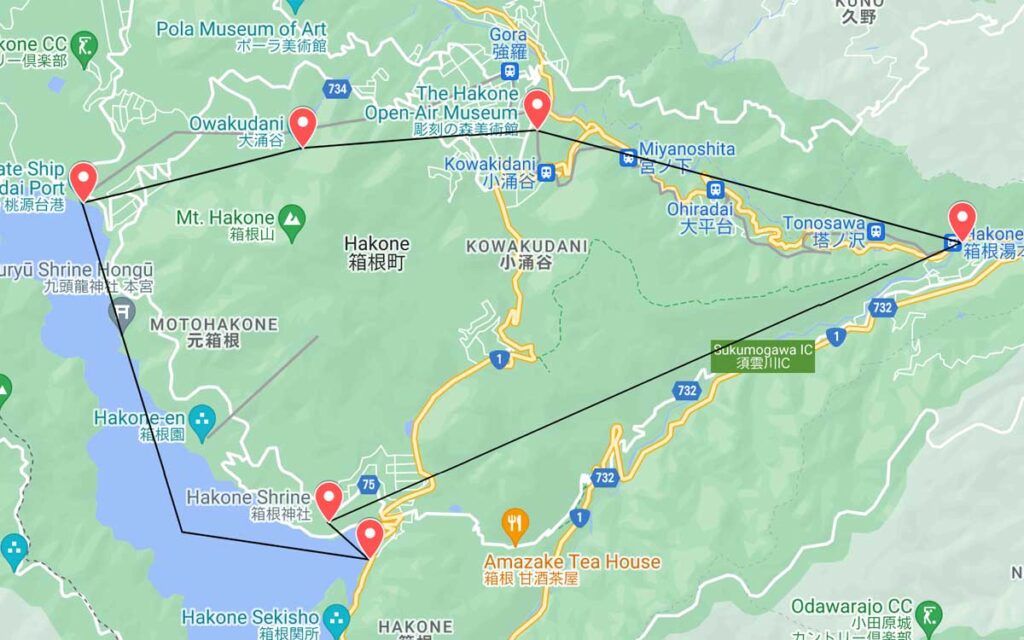
Hakone Day Trip Itinerary
Here is my one day Hakone itinerary from Tokyo:
1. Take the train from Tokyo to Hakone-Yumoto Station
Try to get the train from Tokyo as early as possible. Since you’ll only have one day to explore Hakone, you want to make the most out of it. There are different ways to get to Hakone, depending on what passes you have (more information about the different options below), but the easiest way is by using the Hakone Free Pass .
The Hakone Free Pass is a discount pass that can help you save money (and time) while exploring Hakone. Apart from unlimited access to public transport in the Hakone area and countless discounts on museums, restaurants and onsens, the pass also gives you a return ticket from Shinjuku Station to Hakone.
You can book the Hakone Free Pass online and redeem it at Shinjuku Station on the morning of your day trip. Once you’ve got the Hakone Free Pass, you also have the option to upgrade your return ticket to the limited express Romancecar. This is essentially a faster train service and comes at a surcharge on top of the Hakone Free Pass (1,200 yen one-way).
Without the upgraded express ticket, the journey from Shinjuku to Hakone takes around two hours. With an upgrade express ticket, it takes around 80 minutes.
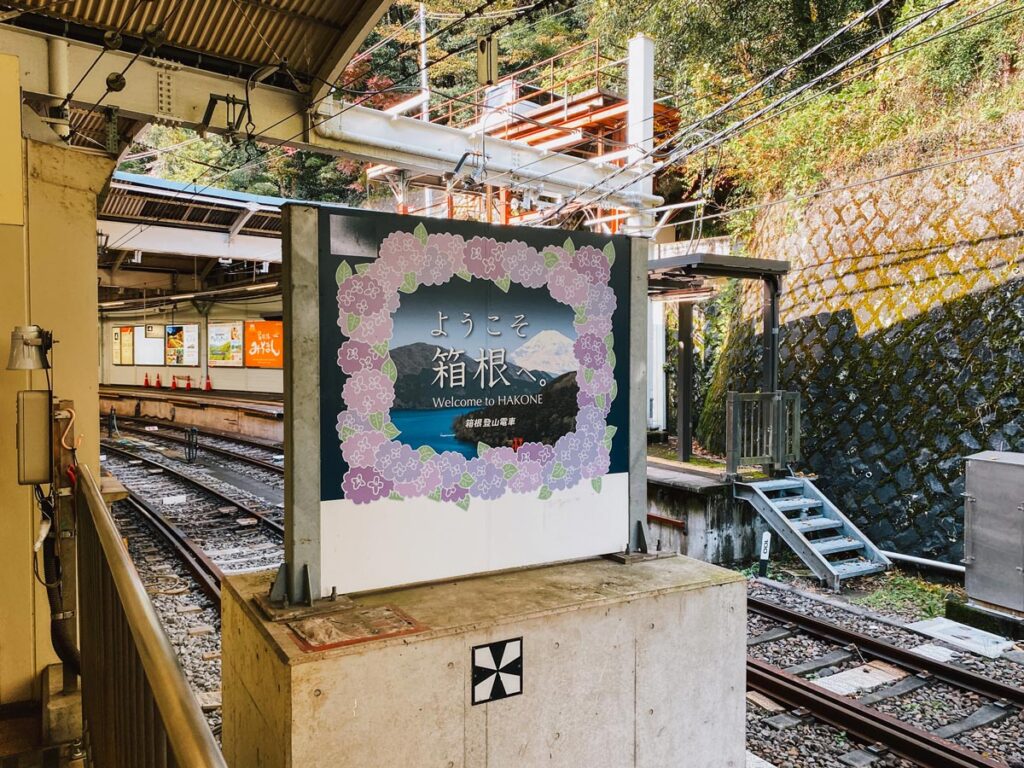
2. Take the bus to Lake Ashi
After arriving at Hakone-Yumoto Station, jump on the bus towards Lake Ashi. There are multiple bus routes that will take you there and you can use the Hakone Free Pass to ride them for free. The bus takes around half an hour.
Once arrived at Lake Ashi, you can take some time to explore. Around the lake, there are tons of opportunities for small nature hikes. But since we’re on a tight schedule, it’s best to only walk to Hakone Shrine – one of Hakone’s most famous landmarks .
3. Visit Hakone Shrine
The floating torii gate on Lake Ashi is probably one of the most iconic and beautiful images from Hakone. Hakone Shrine is a must-visit when in the area but prepare for queues near the torii gate (you won’t be the only one wanting to take a picture – we waited around 20 minutes).
Behind the famous torii gate, you can walk up the steps towards the main entrance of the shrine. The original shrine was built in 757 but was later relocated to where it stands today.
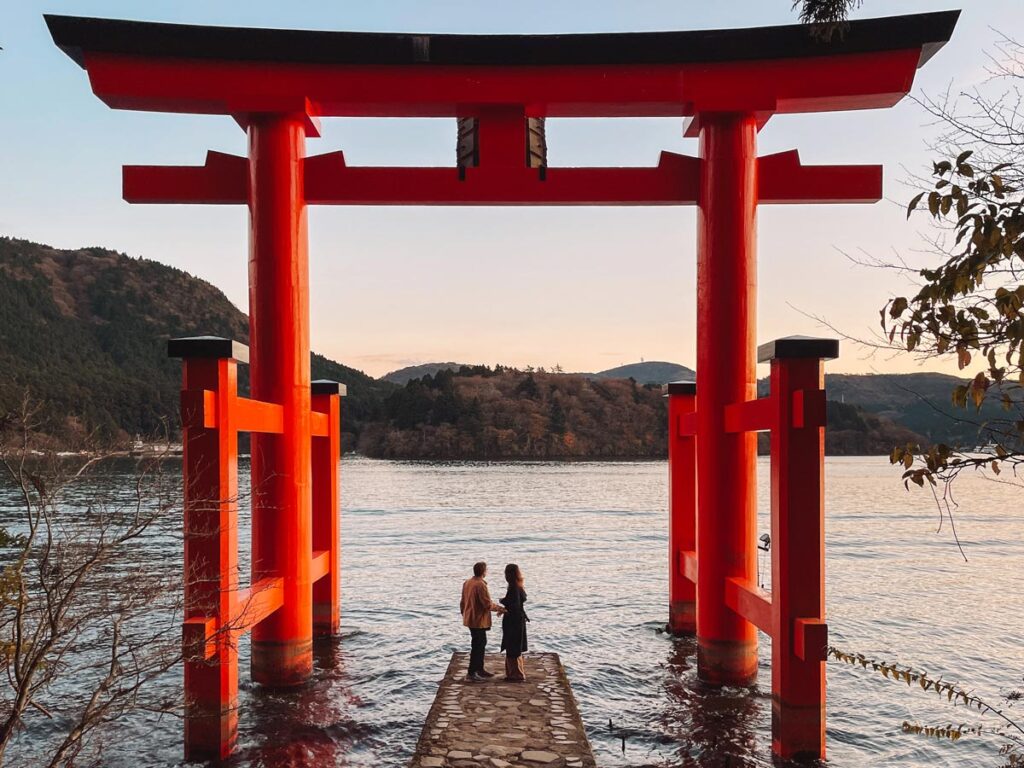
4. Spot Mount Fuji
Hakone is known to be one of the best places to spot the famous Mount Fuji. Mount Fuji, or Fuji-san, is one of the things Japan is most famous for – and it’s pretty clear why. This beautiful mountain (and active volcano) has been inspiring the Japanese for centuries.
After visiting Hakone Shrine, start making your way to Moto-Hakone Port or Hakone-machi-ko.
5. Sail Lake Ashi on a pirate ship
Lake Ashi looks stunning from Hakone Shrine, but it’s even more beautiful when you’re sailing across it. Especially, when you’re doing it in style…
There are three different pirate ships (yes, pirate ships, you read that correctly) sailing across Lake Ashi, each with a unique design. The trip itself takes 25–40 minutes, depending on where you board (Hakone-machi-ko or Moto-Hakone-ko).
The trip on these pirate ships is included in the Hakone Free Pass , so you can board without having to pay for an individual ticket (unless you want to upgrade for the special room and access to the front of the ship. In my opinion, this isn’t worth it! The ticket that’s included with your Hakone Free Pass is more than good enough).
On a clear day, you can find some of the very best views of Mount Fuji from the ship. The first time we saw it from here, I teared up a little. You can also see the floating torii gate from Hakone Shrine from the ship, along with Kuzuryu-Jinja Shrine and the beautiful forest surrounding the lake.
Plus, it’s the easiest way to get to the Ropeway Station, which brings us to our next stop on this Hakone itinerary…
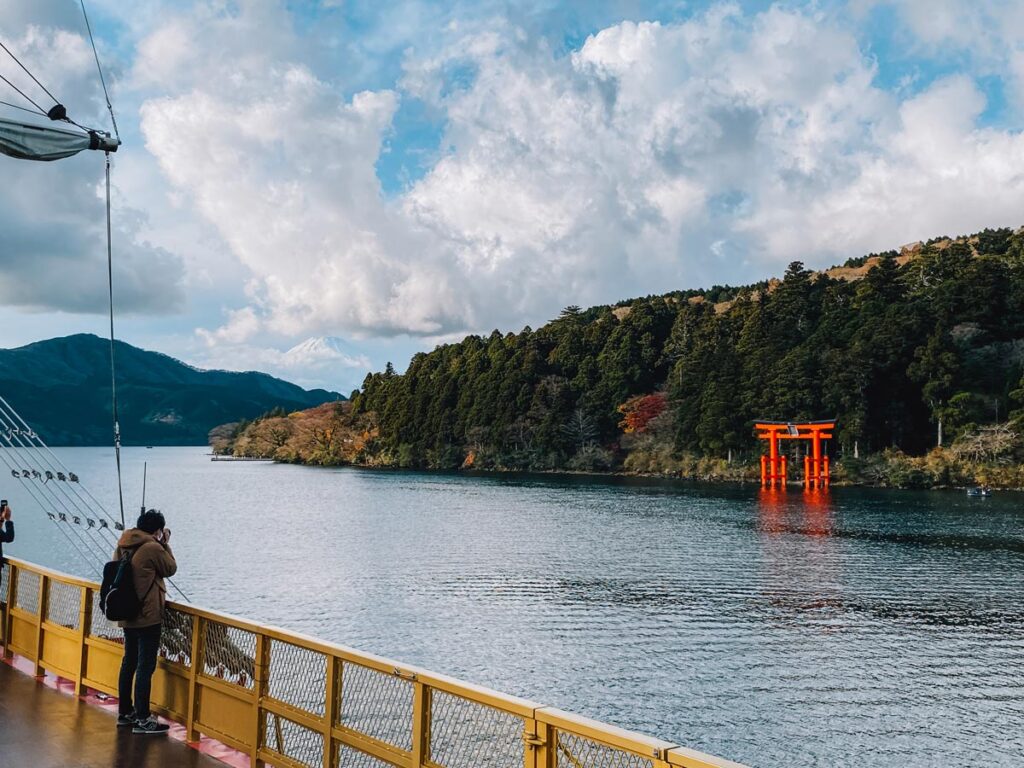
6. Visit the Great Boiling Valley (Owakudani)
After getting off the pirate ship at Tōgendai Port, you can walk over to the Ropeway Station. Hakone’s Ropeway is also included in the Hakone Free Pass, another reason why this pass will save you so much time and money.
Stay on until you reach Owakudani Station. This should take around 30 minutes, but on a clear day, you’ll be able to see Mount Fuji and Lake Ashi. There is one stop in between, Ubako Station, which is a five-minute walk to Hotel Green Plaza Hakone. We stayed here during our trip to Hakone, but it also has a public onsen with stunning Mount Fuji views.
Once arrived at Owakudani Station, you’ll immediately see why this is called the Great Boiling Valley. When Mount Hakone erupted around 3,000 years ago, this volcanic wasteland was left behind.
The sulphurous fumes and steaming pools make for a pretty unique experience (it smells!). There are even signs that warn you of the toxic volcanic fumes.
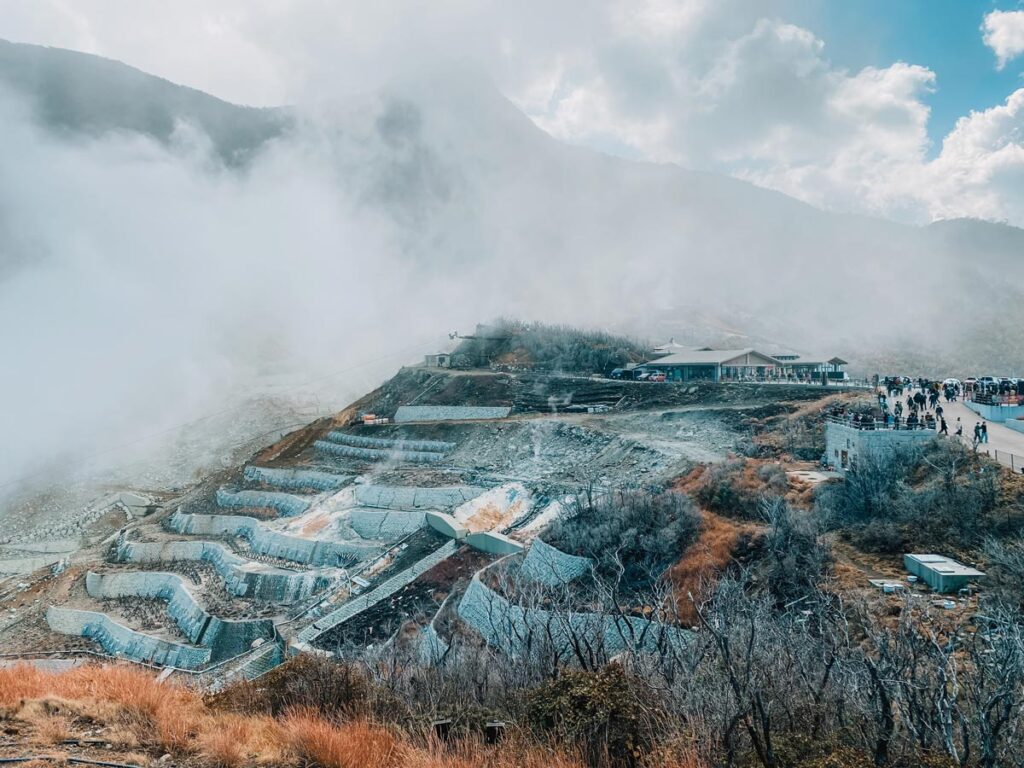
7. Eat a black egg
Visiting Owakudani is one of the best things to do in Hakone, but you can’t leave without trying one of the iconic black eggs (Kuro Tamago). These famous eggs are regular chicken eggs, but they’re boiled in the natural hot springs in this volcanic wasteland.
The minerals in the water turn the shell black – don’t worry, the egg inside will be untouched, it looks and tastes the same as an egg you’d boil at home. But according to local lore, eating one will add seven years to your lifespan.
Whether it’s true or false, it’s not worth the risk, is it? I ate two…
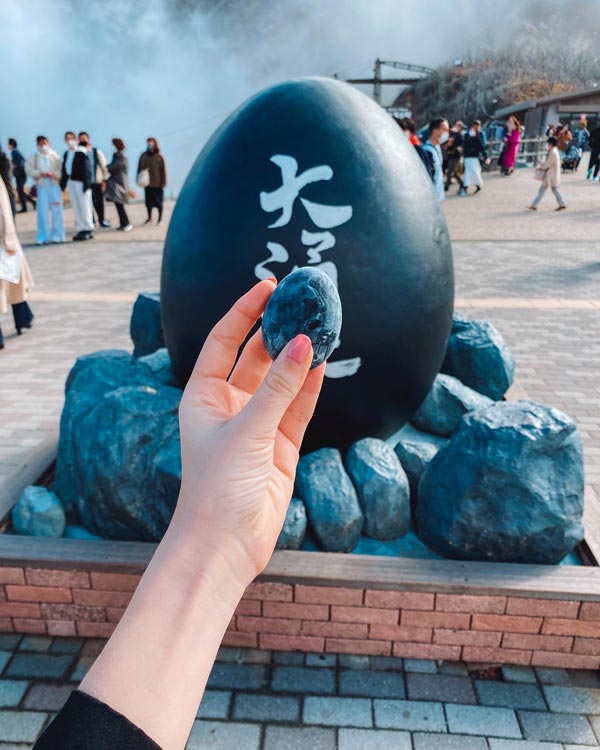
8. Visit Hakone Open Air Museum
Hakone is home to quite a few museums, but Hakone Open Air Museum is one of the most popular. It’s on the Hakone Loop, making it easy to visit if you’re using the Hakone Free Pass to get around the area.
From Owakudani Station, take the ropeway to Sounzan Station. From there, you can take the Hakone Tozan Cablecar to Chokoku-no-mori Station (also included in the Hakone Free Pass). Hakone Open Air Museum is only a few minutes from here.
While the entree itself isn’t covered by the Hakone Free Pass, you will get a discount with it. The museum displays beautiful sculptures across the valley. There are multiple exhibitions, both indoors and outdoors.
After a busy day trip to Hakone, it’s time to make your way back to Tokyo again. After visiting the Open Air Museum, you can get back on the Hakone Tozan Railway and travel to Hakone-Yumoto Station. From there, the Hakone Free Pass allows you to take the train back to Shinjuku.
How to get to Hakone from Tokyo
There are different ways to get to Hakone from Tokyo, depending on what passes you hold:
1. Odakyu local express train (Hakone Free Pass)
The cheapest way to get to Hakone from Tokyo is by taking the Odakyu local express train from Shinjuku. This is the route included with the Hakone Free Pass and requires a change at Odawara Station. From there, you travel onwards to Hakone-Yumoto Station.
The train does stop at every station along the way and takes around two hours , but you can enjoy some stunning views of Mount Fuji. Plus, it’s a real money-saver!
2. Romancecar (Hakone Free Pass upgrade)
The fastest way to get to Hakone from Tokyo is by taking the Odakyu Romancecar. This direct service takes you from Shinjuku to Hakone in around 80 minutes.
If you already have purchased the Hakone Free Pass, you can pay an additional fee to upgrade to the Romancecar. You can opt for this at the Odakyu Sightseeing Service Centers
If you’re using the JR Pass to travel through Japan, you can use it to travel towards Hakone (but not all the way). From Tokyo, you can take the Shinkansen to Odawara on the JR lines. This part of the journey will be covered by the JR Pass.
From Odawara Station, you won’t be able to use the JR Pass. Instead, it’s best to pick up a Hakone Free Pass from Odawara Station – this version doesn’t include the return ticket from Shinjuku and is slightly cheaper. However, it still includes all public transport within the Hakone area and countless discounts on restaurants and museums.
Is Hakone included in JR Pass?
No, the Hakone area is not included in the JR Pass . You can get to Odawara Station from Tokyo with the JR Pass, but from there, it’s best to use the Hakone Free Pass.
Normally, it comes with a return train ticket from Shinjuku Station to Hakone, but it’s also possible to buy it at a discounted price without this ticket. This is a good option if you hold the JR Pass during your trip to Hakone.

Is the Hakone Free Pass worth it for one day?
The Hakone Free Pass is a discount pass that can help you save money and time while exploring Hakone. Despite the name, it’s not actually “free”, but you can buy them for two or three days. Sadly, there’s no one-day equivalent of the pass.
So, what should you do when you’re going on a day trip to Hakone? I recommend still getting the two-day Hakone Free Pass.
This pass is such a big money and time saver, even when you’re only using it for a day trip. It includes a return train ticket from Shinjuku Station to Hakone, unlimited access to public transport within the Hakone area (including the sightseeing cruise and the ropeway), and countless discounts for restaurants, onsens and other attractions.
But the money saving isn’t the only big plug of this pass. It’ll save you a lot of time and hassle. Since the pass gives you access to all public transport in Hakone, you don’t have to worry about buying individual tickets or paying the correct fare. Instead, you simply flash your Hakone Free Pass and you’re good to go.
We have a full guide on the Hakone Free Pass for more information – but I highly recommend it!
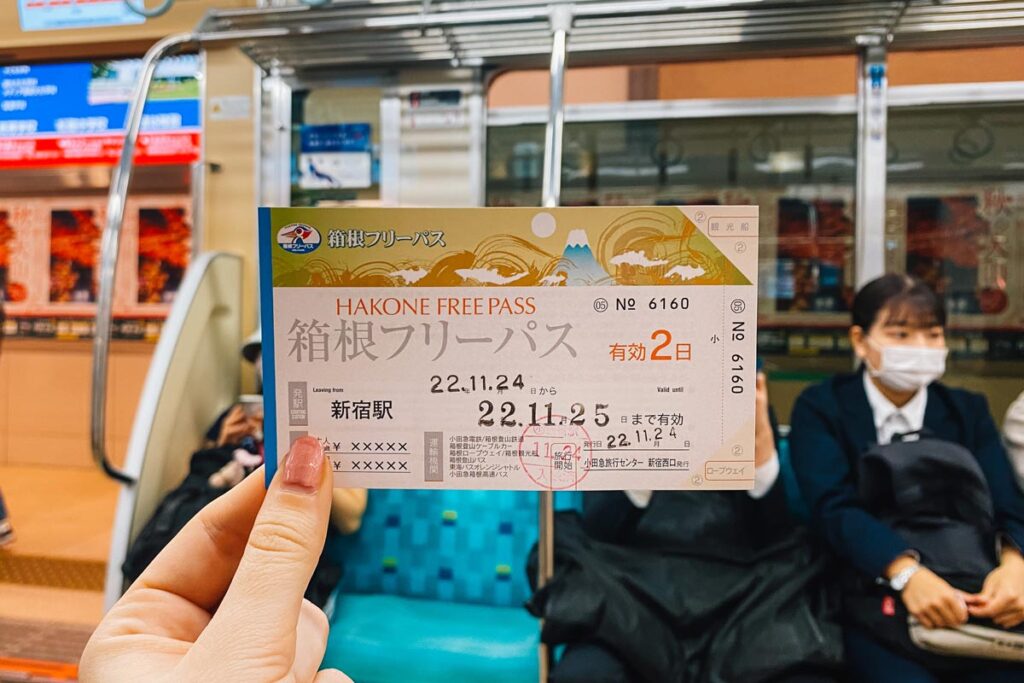
Is Hakone worth a day trip?
Yes, Hakone makes for a great day trip from Tokyo. It’s a lovely getaway from the big busy city, and there’s a lot you can see in a day. If you follow the Hakone Loop with the Hakone Free Pass, you should be able to see most of the area in 6–8 hours.
However, if you have enough time to add an extra day to your itinerary, I recommend staying for longer. Two or three days in Hakone is the sweet spot. Since the town is home to many onsens (Japanese hot springs), it’s an excellent opportunity to stay in an onsen hotel and try the naturally heated water for yourself.
We have a guide on where to stay in Hakone with our top hotel and Ryokan recommendations.
Finish your Japan itinerary

Weather note – the weather in Hakone can be a little temperamental. Clouds are often covering Mount Fuji, making it (almost) impossible to see. If you have a few days in Tokyo, try to be flexible when choosing your Hakone day trip.
Hakone is one of my favourite places in Japan, so I hope this guide has helped you plan your own trip there. If you’re looking for more Japan travel inspiration and advice, check out the following guides:
- Three week Japan itinerary
- Two week Japan itinerary
- Best things to do in Japan
- 6 day Tokyo itinerary .
Nele (Nay-la) graduated from Manchester Metropolitan University with an English and Creative Writing Degree and has lived in the UK for nearly 10 years. She has had an interest in Japan and its culture for as long as she can remember. Since her first trip in 2018 surpassed all expectations, she has continued to return to Japan to explore more of all it has got to offer. You can read her full story here .
View all posts
2 thoughts on “The Perfect Hakone Day Trip From Tokyo”
I normally don’t bother to leave comments but for you I have to make an exception… I was looking desperately for 1 day tour of Hakone capturing the highlights, to do on my own using public transport instead of taking expensive tours. You nailed it! Thank you so much!
Thank you so much! Super glad to hear it’s been useful 🙂 Hope you have a great time in Hakone!
Leave a Comment Cancel reply
This site uses Akismet to reduce spam. Learn how your comment data is processed .
Must-Read Articles

50+ Best Things To Do In Japan

Is The Japan Rail Pass Worth it?

The Perfect Three Week Japan Itinerary

Japan Travel Tips Group

The Japan Travel Newsletter
Sign up to get inspired! Receive insider tips, special discounts and more to plan your perfect Japan trip.
You have successfully joined our subscriber list.
japan travel Blog
Tokyo Kyoto Osaka Hiroshima Hakone Kobe Nikko Nara Kyushu All Japan Content
Plan Your Trip
Best Things To Do Japan Rail Pass 2 Week Itinerary 3 Week Itinerary Accommodation Japanese Phrases
About The Navigatio Work With Us

The Hakone day trip guide that covers everything (2024 edition)
By: Author Sylvia
Posted on Last updated: January 23, 2024
Are you making a Hakone day trip and wondering what you could do? You came to the right place.
A Hakone day or weekend trip is ideal to escape the hustle and bustle of Tokyo. Hakone is a small town but it has lots to offer to its visitors.
Besides the famous hot springs and the gorgeous views of Mount Fuji, there are plenty of other activities to keep you busy.
Many people visit Hakone as a day trip but if you don’t want to rush through the place we would recommend a visit of 2 or 3 days.
In this Hakone travel blog post we share the best time to visit Hakone, how to get to and around Hakone, the best organized day tours to Hakone , and more.
So definitely keep on reading.
There is a really good chance that this post contains affiliate links. If you click one of them, we may receive a small commission (for which we are deeply grateful) at no extra cost to you.
Table of Contents
Japan Essentials
We almost always find the best flights to Tokyo and Osaka on Momondo . It may be worthwhile to compare these with Skyscanner and a new but promising flight aggregator, WayAway .
Don’t lose time upon arrival at the airport and order your Japan travel SIM or portable WiFi device in advance so that it’s ready and waiting for you at the airport when you arrive.
Find out which JR Pass will save you the most for your trip to Japan.
Check out our ultimate Japan travel blog where you can find many more interesting Japan articles to prepare for your trip.
Need help with your Japan trip planning? Check out this post on how to plan your trip to Japan.

Where is Hakone?
Hakone is situated in the Fuji-Hakone-Izu National Park.
It is less than a hundred kilometers from Tokyo and can be reached by train from Tokyo in about an hour and a half.
You can also take a bus, the bus will take two hours to reach Hakone.
- How to plan your day trip from Tokyo to Mt. Fuji.
- Where to stay in Tokyo.
What’s the best time to visit Hakone
Since Hakone is only 100 km from Tokyo, the climate is more or less similar to Tokyo. In general, the temperatures are slightly lower and there is a higher chance of rain.
Since both climates are the same, Hakone is an ideal day or weekend trip in spring or autumn .
However, the best chances of seeing Mt Fuji are in winter, when temperatures are milder. From November to February there are usually more clear and sunny days during which you have fantastic views of the mountain.
Complete Japan packing list
How many days should you spend in Hakone
The Hakone loop that we describe below can be done in a day.
Keep in mind that if you are making a day trip to Hakone, much of the day will be traveling, both to and from Hakone, as well as between the various points of interest on the spot.
Therefore, if you want to rush less, go hiking, and relax in an onsen we recommend staying for 2 or 3 days in this splendid region.
Hakone has some charming ryokans and several Spa resorts. A number of highly rated recommended accommodations can be found at the end of this article .
The Hakone Loop
The so-called Hakone loop brings you along most of the main attractions in one day.
The circuit is very touristy and quite easy and straightforward to follow.
You can do the loop clockwise or counterclockwise. Here we briefly describe the counterclockwise circuit which is done by most visitors. Further on in this article, we go into more detail about the different sights you will see. Here we just describe the loop itself.
1 – Most people start at Odawara.
You start your adventure by hopping on the Hakone Tozan train that will take you to Gora.
The route is quite spectacular as the train takes some switchbacks halfway to overcome the 400-meter height difference.
2 – Once in Gora, you continue your journey with the Hakone Tozan cable car to Sounzan.
3 – Next, you jump on the Hakone ropeway to Owakudani.
4 – From Owakudani you can continue on the ropeway to Togendai.
5 – In Togendai you can board the pirate ship for a cruise on Lake Ashi.
You can choose to get off the boat at Hakone-machi or you can directly continue to Moto-Hakone.
Are you wondering which stop to get off?
Those who don’t mind a little hiking can get off at Hakone-machi where you can visit the Hakone Checkpoint and the Onshi Hakone Koen Park. Once you’ve visited these sights you can make a lovely stroll along the lakeshore to the Hakone Shrine. It’s just 20 minutes and you will be rewarded with some nice views.
If you’re short on time, don’t like walking, or aren’t interested in the Hakone Checkpoint and the park you can stay onboard until Moto-Hakone. From here it’s a 5-minute walk to the Hakone Shrine.
6 – The Hakone Tozan Bus will bring you back to Odawara or your next destination.

What you need to know about the Hakone loop:
The loop takes 6-8 hours if you don’t spend too much time at the various sights along the way. It’s a super touristy loop and it can be done without much preparation or planning.
It can be done clockwise but most people do it counterclockwise. This is also how we described it above.
If you don’t want to rush, we recommend that you spend at least one night in Hakone and create your own itinerary based on the things we describe below.

Hakone money-saving tip – The Hakone Freepass
One of the best money-saving tips for your day or weekend trip to Hakone is to get a Hakone Freepass.
The Hakone Freepass is a money-saving pass that gives you unlimited access to most of the transportation options in the Hakone region.
The Hakone loop is completely covered and you can also go shopping at the Gotemba Outlets and admire the view from the Mishima Skywalk
The pass also offers discounts at over 60 facilities including hot spring resorts, souvenir shops, museums, shrines, etc.
There is a pass for 2 or 3 days, but even if you do a day trip to Hakone and just do the Hakone loop, you will benefit from the pass. The most comprehensive version includes a return ticket from Tokyo and can be purchased online . The other version starts in Odawara.
Check out our Hakone Freepass Guide for
- All the details about the Hakone Freepass
- Including a map of the coverage area
- A detailed calculation of how much you can save
Check prices and availability: Hakone Freepass
How to get to Hakone
Taking the bus to hakone.
Buses leave from Shinjuku station for Hakone approximately every half hour. The buses pass by Gotemba where you have the popular premium outlets. The bus journey takes around 2 hours.
The Hakone Freepass covers part of the journey.
Taking the train to Hakone
With a JR Pass
JR has no trains to Hakone itself but you can use JR to get to Odawara which is pretty close.
If you have a JR pass this will be your best and cheapest option.
With the Japan Rail Pass (the nationwide pass) you can ride the Shinkansen from Tokyo or Shinagawa station to Odawara.
With the Tokyo Wide Pass and other regional JR-East passes you can use the Tokaido Line or the Limited Express Odoriko to get to Odawara.
At Odawara station will need to transfer to the Hakone Tozan Train to Gora. This train is covered by the Hakone Freepass. (you don’t need the option of the round-trip ticket)
- An overview of the various JR passes in Japan .
- The complete guide to Tokyo’s public transport.

If you don’t have a Japan Rail Pass
If you don’t have a JR Pass our advice would be to buy the Hakone Freepass with a round-trip ticket from Tokyo. You can then hop on the Odakyu trains at Shinjuku Station (or any other Odakyu station in the Tokyo area).
Odakyu runs local, express, and limited-express trains on this route. Some trains will require a transfer. Only the local and express trains are covered by the Hakone Freepass. To ride the Romancecar , that’s what the limited-express train is called, you will need to pay a supplement of 1,200 JPY (one-way) .
Beware that the Romance car also requires advance seat reservations. If you have a Hakone Freepass and you want to ride the Romancecar you can use this page to reserve your seat .
Cost to get from Tokyo to Hakone
In this table, you can find an overview of the different prices.
(You may need to scroll left-right to see the full table)
How to get around Hakone
The Hakone Freepass includes the following 8 different transportation options in the Hakone area.
- The Hakone Tozan Train: To travel from Odawara or Hakone-Yumoto to Gora (part of the Hakone Loop)
- The Hakone Tozan Cable Car: Travel between Gora and Sounzan (part of the Hakone Loop)
- The Hakone Ropeway: Takes you over the mountain ridge and Owakudani Valley from Sounzan to Lake Ashi (Togendai) (part of the Hakone Loop)
- The Hakone Sightseeing Cruise: The Pirate Ship Cruise on Lake Ashi (part of the Hakone Loop)
- The Hakone Tozan Bus: A fairly dense bus network that connects the major hubs (Gotemba Station, the Gotemba Premium Outlets, Gora, Togendai, Moto-Hakone, HakoneMachi, Hakone-Yumoto, and Odawara) with most tourist sights
- Two sightseeing-busses to additional tourist attractions
- The Odakyu Highway Bus: Between Gotemba Station and the Odakyu Hotel de Yama (and the Komagatake Ropeway)
- The Tokai Bus to the Mishima Skywalk
This makes this pass all you need to visit the major sights in the region. Below is a map of the coverage area.

Taking an organized Hakone day tour
If you are short on time or don’t like to explore the region independently, you can opt for an organized Mount Fuji Day Tour.
Keep in mind that the below-mentioned tours combine the region around Lake Kawaguchiko and Hakone.
There are many things to do in Hakone. Because the tours combine both regions you won’t visit all Hakone sights that we mention in this article.

Mt Fuji and Hakone Cruise & Bus Tour
This tour, which you can book with Klook , starts with a visit to a Mt. Fuji 5th station.
Next, you will make a cruise on the waters of Lake Ashi and take the Mt. Komagatake Ropeway which offers great views of Mount Fuji on a clear day.
This is a great family tour with lots of possibilities to take amazing pictures of Mt Fuji.
Note that the cruise can be canceled in case of bad weather.
Read reviews and book: Mount Fuji and Hakone Day Tour

Mt Fuji & Hakone Day Tour: Lake Ashi & Ropeway Day Trip from Tokyo
GetYourGuide offers this Mount Fuji day tour where you will visit Mount Fuji’s 5th Subashiri station.
In addition you will cruise Lake Ashi on a pirate ship and take the cable car to the Owakudani Valley. At Owakudani you can taste the famous Kuro Tamago black eggs that are boiled in the hot volcanic spring water of the Valey.
According to an old tradition eating these black eggs will extend your life for seven years. It doesn’t harm to try, right?
More information and booking: Mount Fuji and Hakone Day Tour
Mount Fuji and Hakone 1 Day Tour with optional return by bullet train
This 10-hour tour offered by Viator will take you to Mount Fuji highlights such as Mount Fuji Subaru Line 5th Station, Lake Ashi, and the Hakone Ropeway from where you can enjoy beautiful views of Mount Fuji.
At the end of the tour, you have the possibility to be dropped off at Odawara station where you can board the Shinkansen which will take you back to Shinjuku station in just 40 minutes.
This is a great option that allows you to get back to Tokyo faster at the end of this exciting but also tiring day. An added bonus is that you get to experience the iconic Shinkansen.
Of course, you can also return by bus.
You can also choose to include lunch in the package.
This is a flexible tour with a number of options that can make your experience more comfortable. Especially the return in the fast and comfortable bullet train is highly-valued after a long and tiring day.
Check prices and availability: Mount Fuji tour
If you aren’t convinced of these tours, check out our full overview of the different Mount Fuji tours that exist.
You can also put together your own private tour together with a guide. Have a look at the different private Mt Fuji Tours here.

Things to do in Hakone
Here is an overview of what to do in Hakone.
Best places to enjoy the views of Mount Fuji
Everyone who comes to Hakone hopes to get a glimpse of this mountain. For many, it is the main reason for their visit.
If you are planning on making a day trip to Hakone to see Mount Fuji, we would definitely advise checking the weather forecast and especially the cloud cover. It goes without saying that you increase your chances if you stay for 2 or 3 days.
On clear days the mountain can be seen from many different viewpoints. Here are some of the best places to enjoy the views of Mount Fuji.
Moto Hakone
Moto Hakone, a village on the banks of Lake Ashi, is a stop of the pirate ship cruise.
It offers some of the best views of the lake and Mount Fuji.

Hakone ropeway
On a clear day, you’ll be able to spot a scenic view of Mount Fuji as you ride the ropeway.
Are you considering joining a guided tour? This ropeway is included in a number of different tours. Have a look at this tour , this tour with optional bullet train retour , this 12-hour tour offered by Klook , and this one that ends at the Gotemba outlets .
Mishima Skywalk
This is Japan’s longest pedestrian bridge. The bridge crosses a deep valley and takes you to an adventure center with zip lines, a treetop parcours, mountainbike rentals and more.
Most people come for the view of Mt. Fuji from the bridge but also the ziplines are always very popular.
Check prices and availability: Mishima Skywalk Ticket

Gotemba Premium Outlets
This is without any doubt the best viewing spot for those shopaholics out there. Here you can shop and at the same time enjoy great views of Mount Fuji.
The Gotemba Premium Outlets are a good destination if you want to go shopping without feeling too guilty about not doing anything touristy. 😉
If you think about taking a guided tour. The Gotemba premium outlets are included in 6 different tours. Check out the various options:
- Lake Kawaguchiko with the outlets
- Classic route including Mt. Fuji 5th station, Oshino Hakkai, and Gotemba outlets
- Tour including Lake Kawaguchi, Oshino Hakkai, and Gotemba outlets
- This tour that covers Oishi Park, Arakurayama Sengen Park, Oshino Hakkai, and the outlets
- This tour with lunch at the Gotemba Outlets
- A tour with a visit to a Mt. Fuji 5th station, Fuji-Q Highland, and a generous 3h and 30 minutes stop at the outlets .

Go bathing in an Onsen
Hakone is a good destination if you’re looking for tranquil onsen or hot springs. Historically the onsen were all situated near Hakone-Yumoto.
Today, this is still the region with the most sites, but the popularity of the Onsen has seen much more pop up throughout the whole Hakone region.
The onsen are typically split by gender because tradition dictates that you bathe naked in the mineral-rich hot springs. Some onsen also have private baths for families or couples.
Most onsen welcome kids as long as they’re accompanied by their parents.
Here you can find more info on the best onsen in Hakone.

Go hiking around Lake Ashi
Hiking is a good way to escape the crowds and an excellent option to enjoy this green region.
It is possible to hike around Lake Ashi and there are several other trails with various difficulty levels.
Here is an overview of the different trails.
Ride the Hakone ropeway
On clear days the Hakone Ropeway offers unparalleled views of Lake Ashi, Owakudani, and Mount Fuji.
The cable car fee is 1.550 JPY one way. It is covered by the Hakone Free Pass.
This ropeway is included in several guided tours. Have a look at this tour , this tour with optional bullet train retour , this 12-hour tour offered by Klook , and this one that ends at the Gotemba outlets .

Eat black eggs in Owakudani Valley
Owakudani means “the great Boiling Valley”. By the locals, it’s also known as the “Hell Valley”. The valley was created about 3000 years ago when the Hakone Volcano exploded.
Nowadays it’s a popular tourist spot.
People come here to hike, enjoy the scenic views ( on a clear day, you’ll have a scenic view of Mount Fuji), and eat the famous black eggs which are said to extend your life for 7 years.
Opening hours: 9 am – 4 pm (determined by the operation hours of the Hakone Ropeway)
How to get there: The easiest way is by taking the Hakone Ropeway.
In the event of increased seismic activity in the region, Owakudani may be closed. In case of stormy weather, the ropeway is closed.
Do you prefer to join a guided tour? All tours that include the Hakone Ropeway do a stop in Owakudani. This tour , this tour with optional bullet train retour , this 12-hour tour offered by Klook , and this one that ends at the Gotemba outlets .

Take the Komagatake Ropeway
The Komagatake Ropeway takes you from the shore of Lake Ashi to the Komagatake peak of Mount Hakone.
It is not the same ropeway as the Hakone ropeway which leads from Gora to Togendai.
On a clear day, you can enjoy beautiful views of Lake Ashi and Mount Fuji from the top. Several hiking trails start here, leading to the banks of Lake Ashi, to Owakudani, and Sounzan station.
The ropeway may be closed in case of increased volcanic activity in the area.
A short walk from the ropeway’s upper station is the Hakone Shrine Mototsumiya. This is the original Hakone Shrine. Today the Hakone Shrine at the lakeshore in Moto Hakone is more popular because it is easier to reach.
Round-trip fee: 1,800 JPY. This ropeway is not included in the Hakone Freepass but you get a 10% discount if you have the pass.
Opening hours: 9 am- 4.30 pm ( up) and 4.50 pm ( down)
How to get there:
Take the Odakyu Highway Bus (covered by the Hakone Free Pass).
This attraction is also included in this guided tour.

Visit The Hakone Open-Air Museum
The Hakone Open-Air Museum is a lovely place to visit. In a beautiful setting, you can enjoy spectacular modern and contemporary sculptures.
There even is a Picasso exhibition.
Definitely worth a visit.
Entrance fee: adults: 1.600 yen, university, and high school students: 1.200 yen, middle and elementary school: 800 yen
With the Hakone Freepass adults get a 200 yen discount, all others 100 yen.
Opening hours: 9 am-5 pm ( entry until 4.30 pm) How to get there: Take the Hakone Tozan Railway to Chokoku No Mori Station ( covered by the Hakone Freepass).

Take beautiful pictures of the Hakone Shrine
The Hakone Shrine is one of the most iconic symbols of Hakone. It features a photogenic floating torii gate that is close enough to the shore for some Instagram-worthy selfies. The picture is very popular so expect long lines…
Miyajima’s floating torii gate may be more popular, but if you aren’t going to Miyajima, this is the place to see this iconic Japanese symbol.
How to get there:
From Hakone Yumoto, take the Hakone Tozan Bus to Moto-Hakone Boat Pier (35 minutes).
When following the Hakone Loop you will pass the shrine during the sightseeing cruise. To visit it, get off at Hakone-Machi or Moto-Hakone.

Make a Hakone Sightseeing cruise
Although the pirate ships look ridiculously touristy this cruise is the best way to see the lake. The cruise passes the famous floating torii gate of the Hakone Shrine.
By the time we did the cruise, the sky had become completely cloudy. On a clear day, you will also have views of Mount Fuji from the ship. (and for that you don’t need to climb into the crow’s nest 😉)
There are 3 points where you can start your cruise.
Either at the northern side of the lake in Togendai-ko or at the southern edge of the lake in Hakone-machi or Moto Hakone.
There are 1 to 2 boats per hour, check the boat schedule to plan your trip.
Cost: 1.200 yen for a one-way ticket. We sailed the lake up and down starting in MotoHakone-ko and ending in HakoneMachi-ko. We had the Hakone Freepass but it seemed like everybody could just stay onboard once they boarded the ship.
Free with the Hakone Freepass.
Would you rather join a guided tour? The following tours include the Lake Ashi Pirate Cruise. This tour , this tour with optional bullet train retour , this 12-hour tour offered by Klook , and this one that ends at the Gotemba outlets .

Visit Hakone Checkpoint
The Hakone Checkpoint is located at the southern end of Lake Ashi.
It is a replica of an Edo-era checkpoint that was used to control the traffic along the Tokaido highway between Kyoto and Tokyo.
It used to be one of the largest and most important checkpoints at its time and was restored to its former glory in 2007.
You will see the original fences and gates, the officer’s quarters, the prison, and the lookout tower. There is also a small museum attached to it.
You can walk along a small section of the old Tokaido highway that leads to Moto Hakone. The road is lined with more than a hundred-year-old cedar trees.
Those who want can continue to follow the road to Hakone-Yumoto.
Part of the road between Moto Hakone and Hatajuku still has the original stone pavements but the last section from Hatajuku to Hakone-Yumoto hasn’t been preserved and here you just walk along the main road.
Entrance Fee: 500 yen (400 yen for Hakone Freepass Holders)
You only pay an entrance when you want to go inside the buildings.
Opening Hours: 9 am–5 pm (Closes at 4:30 pm from Dec – Feb)
How to get here :
It’s a short walk from the Hakone-machi boat pier.
You could also take the Hakone Tozan bus in the direction of Hakone-machi and get off at the Hakone Sekishoato bus stop ( covered by the Hakone Free Pass ).

Go shopping in Gotemba Premium Outlets
Shopaholics should definitely visit the Gotemba Premium Outlets. It’s one of the largest outlets in Japan. There are stores of most American and European premium brands such as Hugo Boss, Gap, Prada, Ralph Lauren, Godiva chocolates, etc.
We wouldn’t exactly call ourselves shopaholics, but we went to take a look and couldn’t resist some bargains. The prices of some things were really cheaper than what we are used to at home.
Most of the stores are also tax-free. We enjoyed an additional discount on the advertised price with our passport. Some shops offered this automatically, at others we needed to ask the cashier.
As a bonus you will be rewarded with amazing views of Mount Fuji as you’re shopping on clear days.
Here you can read some TripAdvisor reviews .
Many organized tours also include some time for shopping. Check out the various options:
Opening Hours: March-November: 10 am-8 pm, December-February: 10 am-7 pm.
Closing Day: once a year on the third Thursday in February.
There are many possibilities to reach the Gotemba Premium Outlets. We decided to only list the quickest ways.
From Tokyo:
If you have a Japan Rail Pass: Take the JR Tokaido Line or JR Shonan Shinjuku Line from Tokyo or Shinjuku Station to Kozu Station. Transfer to the JR Gotemba Line to Gotemba Station where you can take the free shuttle bus to the outlets.
The journey will take approximately 2h30 minutes and is fully covered by the Japan Rail Pass.
If you don’t have a Japan Rail Pass or want to reach the Gotemba mall quicker: Take the Mount Fuji Limited Express Romancecar from Odakyu Shinjuku Station to Gotemba Station. At the station, take the free shuttle bus to the outlets.
The trip takes around 100 minutes and costs about 2.800 yen. It is not covered by the Hakone Freepass and since the train is not operated by JR it is not covered by the Japan Rail Pass either.
From Hakone:
There are several options to drive to the Gotemba Premium Outlets from the Hakone region and it is (almost) always included in the Hakone Freepass
There are both direct buses to the outlet or to Gotemba station. If you don’t find a direct bus to the outlet you can ride to the station and then use the free shuttle bus of the outlet to continue your journey.

Visit Odawara Castle
There are many castles in Japan so it would be really odd if there were none in the Hakone region.
The Odawara castle used to be the stronghold of the Hojo clan that used to reign over Tokyo.
It is the closest castle to Tokyo and a visit can be easily combined with a visit to the Hakone region.
Entrance fee : adults: 500 yen, elementary and high school students: 200 yen. (50 yen discount for adults, 20 yen discount for students with the Hakone Freepass)
Opening Hours: from 9 am-5 pm (last entry at 4:30 pm)
How to get here : Odawara Castle is a 10-minute walk from Odawara station.

Walk over the Mishima Skywalk
The Mishima Skywalk is with a length of 400 meters the longest pedestrian-only suspension bridge in Japan.
It lies about an hour by bus from Hakone.
You can see views of both Mt. Fuji and Suruga Bay from the bridge.
Entrance Fee: Adults: 1.100 yen, high school, and junior high school students: 500 yen; elementary school students: 200 yen. There is a 10% discount with the Hakone Freepass.
Opening Hours: from 9 am-5 pm
The bridge is open all year round but the service may be limited in the event of bad weather conditions such as strong wind or snow. For the best views it is recommended to go early in the morning or towards closing time.
From Hakone-Yumoto Station:
Take the Hakone Tozan bus bound for Hakone Port ( route K) to Moto-Hakone Port. From here take the Tokai Orange Shuttle Bus ( route N) bound for Mishima Station. Exit at Mishima Skywalk.
You can use your Hakone Freepass.
If you have a Japan Rail Pass the quickest way to Mishima is by Shinkansen. At Mishima, you can take the Tokai Orange bus to the skywalk.

Visit Lake Kawaguchiko
Do you also want to visit Lake Kawaguchiko , that other beautiful region near Mt. Fuji?
Hakone and Lake Kawaguchiko are not that far apart. A bus ride takes you to Lake Kawaguchiko in 2 hours.
Fujikyu runs several buses a day between Hakone and Lake Kawaguchiko. Buses leave from the JR Gotemba station or the Gotemba Outlets and take you to the train station in Kawaguchiko.
You can use the Hakone Tozan Bus to travel between Hakone and Gotemba. The bus is covered by the Hakone Freepass .
Where to stay in Hakone
Did we convince you to stay more than one day in the Hakone area? Excellent idea! Here are some hotel suggestions.
Since Hakone is famous for its hot springs we picked two hotels with private onsen. Excellent for relaxing your muscles after a busy day of exploring.
This is just a small selection of the many hotels available. We discuss many more hotels in the next 2 articles.
- Ryokans with private onsen in Hakone.
- Ryokans in Hakone with a public onsen.
Hakone onsen ryokan
Mount view hakone ryokan.

Mount View Hakone is centrally located and easily accessible by public transportation. There’re also several dining options as well as a convenience store nearby. This traditional ryokan offers spacious, comfortable rooms. Very friendly and helpful staff. The hotel has a public onsen but if you are shy to go nude in public can use the private onsen.
This ryokan offers a luggage carry service from the train station. You can arrange with them to pick-up and take your luggage to and from the train station. Very convenient if you want to start exploring the area immediately upon arrival.
This is an excellent Ryokan and a great place to experience the traditional rooms, the onsen, and the generous Japanese hospitality. It is an experience not to be missed.
More information and booking:
Booking.com
Hyatt Regency Hakone Resort and Spa

If you prefer the comfort of a regular bed or more extended spa facilities then the Hyatt Regency might be what you’re looking for.
The Hyatt Regency Hakone Resort and Spa is a beautiful hotel with spacious rooms, great views, and excellent service.
The hotel offers a complimentary shuttle to/from Gora Station.
Awesome Onsen Hotel with a view of Mt Fuji
Hakone is an excellent destination for a side trip from Tokyo.
The region owes its popularity to the beautiful view of Mount Fuji on a clear day, but it also has a lot to offer in its own right.
The Owakudani Valley is nothing but spectacular and a must-see. Lake Ashi is a magnificent lake and the area around the lake has some breathtaking scenery. The icing on the cake is the floating torii gate of the Hakone Shrine.
Lastly, don’t skip a visit to an onsen. Nothing beats relaxing in an onsen while enjoying a beautiful view of Mt. Fuji
Are you planning your Japan trip? Check out our Japan guide with much more useful information about Japan.
- Tokyo Cheapo (繁體中文)
Hitting Up Hakone: Day Trip from Tokyo
There’s plenty to do in Hakone . Take a dip in a hot spring, head to the mountains, walk around a stunning lake, and take in the views of Mt. Fuji .
Hakone also has volcanic scenery, hiking trails, art museums, pirate ships, and bountiful history. And if you’re an Evangelion fan, there’s probably no need to tell you there’s plenty to see from the anime . Really, there’s no end to what you can do, whether you are going for a day , a weekend, or longer. Here are a few pro tips on how to get the most out of your getaway from Tokyo — of course, while keeping that budget nice and low.
How to get to Hakone
Hakone-Yumoto is the main gateway to Hakone and is a jumping-off point for most of the main sights. If you’re getting to Hakone by train (as most people do), you’ll arrive at Hakone-Yumoto Station.
There are lovely hot springs and a couple of shrines to see in Hakone-Yumoto itself; however, most visitors travel further, heading either to Gōra , a town in the mountains, or Lake Ashi , a crater lake with stunning views of Mount Fuji.
While you can do both on a day trip, we recommend not burning yourself out and staying overnight instead. After all, Hakone is a place people go to relax.
Pro tip: The Hakone Free Pass (HFP) is almost always a good deal. It gives you unlimited rides on Hakone area transport, plus small discounts to some popular attractions, and you can buy it from Klook or Headout . Hakone travel notice Following increased volcanic activity and area closures in mid-2019, the Hakone ropeway has since resumed full operations, and the Owakudani area can also now be visited, although some pathways remain closed. As it is still a level-two warning area (as determined by the Japan Meteorological Agency), it is advised that you check for transport updates before traveling -- just in case. --> Read about all the different ways of getting to Hakone from Tokyo .
Hakone Free Pass
If you opt to go on your own, we recommend getting the Hakone Free Pass from Headout or Klook . This useful 2 or 3-day transport voucher gives you free access to many methods of transportation around Hakone, including the funicular railway, most buses, the ropeway, and the sightseeing pirate ship that sails across Lake Ashi.
The full pass also covers round-trip travel from Tokyo (usually Shinjuku Station) to Hakone-Yumoto Station via the Odakyu Line. However, if you want to take the special limited express Romancecar train, you’ll need to buy a separate limited express ticket for ¥ 1,200 ( ¥ 1,150 if bought online) each way.
Getting to Hakone from Tokyo

make a reservation for a panoramic view. You'll likely need to book a week or more in advance, but on weekdays and later in the day it is much easier to find seats available.-->
Where can I buy the Hakone Free Pass?

Using buses in Hakone

Hakone tours and deals
There are many ways to enjoy Hakone, and you’ll find a range of package deals on offer for Cheapo travelers.
Mt Fuji and Hakone Day Trip
One of the most popular packages is an all-inclusive sightseeing day trip from Tokyo that takes you to both Mt Fuji and Hakone.
You can take a bus tour with Klook — this costs ¥ 12,980 . However, Viator also offers a similar itinerary, but you can ride the Shinkansen back to Tokyo .
If those are sold out, there’s two more “bus out, bullet train back” itineraries we suggest, one on Viator which includes a trip to the boiling sulfurous Owakudani Valley and a similar Mt Fuji and Lake Ashi option with JTB Sunrise Tours ( ¥ 24,500 ). The exact itinerary varies between providers.
Private guide
If you fancy having someone take you around, there are plenty of private guide options. This highly rated 6-hour private guide service costs ¥ 24,000 per person. You’ll need to make your own way to Hakone though, and the price only includes the guide — so you’ll probably want to pick up the Hakone Free Pass as well.
Outdoor adventures
If you like a bit of exercise and a good view, check out this relatively easy hiking tour of Hakone . The hike has an altitude gain of about 500 meters, includes lunch at a Japanese restaurant, and hot spring at the end.
There are also a number of mountain biking tours of the Hakone and Mount Fuji area .
Lake Ashi: Mt. Fuji views and more

Lake Ashi is at the southern end of Hakone. We recommend visiting the lake early in the day — for a better chance of seeing a clear panoramic view of Fuji.
Getting to Lake Ashi
From Hakone-Yumoto Station, take the Hakone-machi (H) Line bus from stand No. 2. The top sights can be accessed on foot from H Line bus stops around Lake Ashi.
For reference, it takes about 30 minutes from Hakone-Yumoto Station to the bus stop at Motohakone, the most developed part of Lake Ashi. The bus fare is ¥ 1,080 — or free with the Hakone Free Pass .
Things to do in Lake Ashi
There’s a lot to do on the southern edge of Lake Ashi. Sights are spread out between the two ports, Hakonemachi-kō and Motohakone-kō.
Hakone Shrine
10-minute walk from Hakone-jinja-iriguchi (Bus Stop No. 150) H Line bus from Hakone-Yumoto Station (30 minutes, ¥ 1,080 without HFP) Free
Hakone Shrine draws visitors with its Heiwa no Torii, the red shrine gate that appears to be rising out of the waters of Lake Ashi. It reminds us of Miyajima down in Hiroshima (which is one of Japan’s most famous viewpoints!).
If you plan to get a photo in front of the Hakone gate, we’d ask you to reconsider: there is nearly always a long line leading up to it — and the photo usually comes out under-lit.

The shrine itself has quite a few buildings and is surrounded by tall cedar trees, but the most interesting spot is the gate (and the somewhat hidden vermillion bridge nearby).

Hakone Checkpoint
2-minute walk from Hakone-sekisho-ato (Bus Stop No. 154) H Line bus from Hakone-Yumoto Station (40 minutes, ¥ 1,080 without HFP) ¥ 500 ( ¥ 400 with HFP)

The Old Tōkaidō Road was once a vital trade route connecting Tokyo and Kyoto. This was during the Edo period (1603–1868) when the route was heavily guarded. Travelers had to pass through several checkpoints, with Hakone being one of the most important ones.
Hakone Sekisho — “sekisho” means “checkpoint” — served as a customs and immigration station, where officials would check travelers’ paperwork and belongings before allowing them to pass. Today, it’s a museum showcasing Edo period customs and traditions.
Parts of the Old Tōkaidō Road still exist, and visitors can walk some of it in Hakone. The closest part of the road to the checkpoint is Cedar Avenue, which gives you a little sample of what to expect on a proper hike.
Hakone Sekisho Checkpoint

Amazake-chaya: A traditional teahouse
Amazake-chaya (Bus Stop No. 322) K Line bus from Hakone-Yumoto Station (23 minutes, ¥ 710 without HFP) Sweets and drinks around ¥ 500
If you have spare time, it’s worth going to Amazake-chaya . This rustic little teahouse is situated alongside the Old Tōkaidō Road and has served as a pit stop for travelers to the region since before Tokyo was, well, Tokyo. It’s been run by the same family for about 400 hundred years.
A fun way to spend an hour or two is to add a visit to the teahouse on your way to Lake Ashi from Hakone-Yumoto. The bus stop for Amazake-chaya is on the K Line route; it takes about 25 minutes to get there from Hakone-Yumoto.
At the teahouse, enjoy a cup of the warm, sweet, nutritious rice drink known as amazake (it’s not actually tea), together with some homemade mochi (sticky rice cakes).
Then, carry on walking along a preserved section of the Old Tōkaidō Highway to Motohakone. The walk, over cobblestones worn smooth with age, takes about 30 minutes.
Amazake-chaya Teahouse
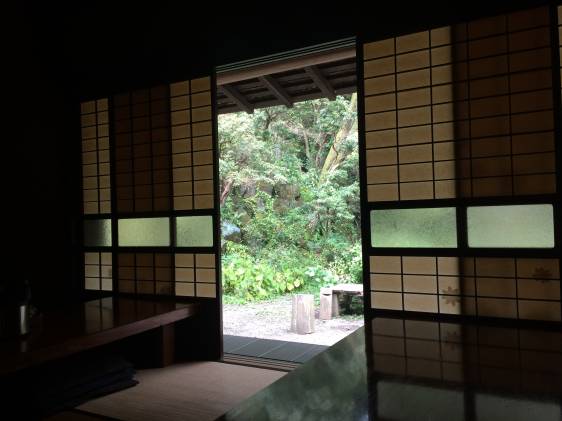
For more details on hiking the Old Tōkaidō Highway, see our guide to three stunning hikes in Hakone .
Onshi Hakone Park
1-minute walk from Onshi-kōen-mae (Bus Stop No. 153) H Line bus from Hakone-Yumoto Station (35 minutes, ¥ 1,080 without HFP) Free
Onshi Hakone Park is a serene area that isn’t overrun with people like some other spots in Hakone. It features a variety of walking paths, picnic areas, and seasonal flowers, such as cherry blossoms and azaleas. You also shouldn’t miss the view of Mount Fuji from the observation deck.
The park is a short walk from Hakone Checkpoint and Cedar Avenue.

Hakone Sightseeing Cruise
1-minute walk Motohakone-kō (Bus Stop No. OH67) H or K Line bus from Hakone-Yumoto Station (32–35 minutes, ¥ 1,080 without HFP) ¥ 1,200 one-way , round-trip ¥ 2,220 (free with HFPass)
Feel like a buccaneer (or Luffy from the anime One Piece) aboard the Hakone Sightseeing Cruise. You’ll set sail on a golden boat that resembles a pirate ship from Motohakone Port to Tōgendai Port — where you can get the ropeway up to Ōwakudani.
During the trip across Lake Ashi (25 to 30 minutes), visitors can see the beautiful Hakone mountains and the famous torii gate of Hakone Shrine. The cruise is also an excellent way to get a closer look at Mt. Fuji, especially on clear days.

Note: You can also get the ship from Hakonemachi Port — which is closer to Hakone Sekisho — but the circuitous route only goes one way and will take you to Motohakone first before stopping at Tōgendai.
Ōwakudani: The Great Boiling Valley
As the whole Hakone area is a hot-spring hotspot, a visit to Ōwakudani, The Great Boiling Valley (not to be confused with the snow monkey haunt of Jigokudani ), is a must-visit on any Hakone tour. Riding a gondola up the mountain, you pass over an ominous, sulfuric landscape that looks like the lair of Smaug.
Getting to Ōwakudani
You can reach Ōwakudani via the J Line bus (or car, though parking is expensive) but most people visit via the Hakone Ropeway, which travels between Tōgendai and Sōunzan. Sōunzan is closer to Gōra, reached via the Hakone Tozan Cable Car.
From Tōgendai, the ropeway takes 30 minutes and costs ¥ 1,500 ; from Sōunzan, it’s 15 minutes and ¥ 1,500 . Or with the Hakone Free Pass rides on the Hakone Ropeway are free. There’s no admission price to Ōwakudani.

From Togendai Port: Hakone Ropeway (through station Ubako) to Owakudani (30 minutes, [price amount=1500] without HFP)[cheapo_icon name="route-solid"] From Hakone Yumoto Station: Hakone Tozan train to Gōra (40 minutes), Hakone Tozan cable car to Sounzan (10 minutes), Hakone Ropeway to Owakudani (10 minutes) ([price amount=2390] without HFP)[cheapo_icon name="map-marker-alt-solid"] Ōwakudani Ropeway Station[cheapo_icon name="coins-solid"] Free-->
Things to do in Ōwakudani
Once you reach Ōwakudani, you are invited to try the area’s signature black eggs — hard-boiled eggs that have been cooked in steaming, mineral-laden water. Supposedly they’re lucky and eating them can add years to your life, but mostly it’s the novelty of it, the hellfire and brimstone surroundings, and the distinctive smell that make it worth the trip.

Note: There are various side trails and hiking routes around Ōwakudani, but they are sometimes access-restricted because of noxious volcanic gases. Currently, only the short nature trail loop around Ōwakudani is open but requires advanced reservations (online in Japanese). While the main gondola route generally remains open, people with asthma or other respiratory conditions might want to give Ōwakudani a wide berth.
Gōra: Museums in the mountains
Gōra is up in the mountains, at an elevation of 533 meters (1,749 ft). Take your time with Gōra as there are plenty of museums, activities, and sights to see.

Getting to Gōra
Gōra is closer to Hakone-Yumoto. The Hakone Tozan Train runs between Gōra Station and Hakone-Yumoto Station and takes around 40 minutes. Coming from Hakone-Yumoto, Gōra is the last stop.
It’s deceptively far from Lake Ashi, so you may find yourself overstretched if you plan to do both in a day.
To get to Gōra from Lake Ashi, you can follow the circuitous route via Ōwakudani that involves taking the Hakone Sightseeing Cruise, the Hakone Ropeway, and the Hakone Tozan Cable Car, alighting at the terminus in Gōra. This takes well over an hour, not accounting for time spent in transit or at Ōwakudani.
Things to do in Gōra
If you only have time to see one or two museums, take a look at our personal favorites below. But if you want to take it slow, there are plenty of others to find here and elsewhere around Hakone.
5-minute walk from Gōra Station ¥ 550 (free with HFP)
Even those without a botanical bent will appreciate this delightful mountainside park. The views across to the steep and sometimes misty mountains make for a great setting in which to appreciate the glasshouses of tropical plants, trees, and shrubbery.
There’s also a traditional teahouse for you to enjoy a cuppa the Japanese way. Gōra Park scores bonus points for being quiet with no lines of tourists, and has free entry with the Hakone Free Pass.
Hakone Gora Park

Hakone Open-Air Museum
2-minute walk from Chokoku-no-mori Station Hakone Tozan Train from Gōra (2 minutes, ¥ 160 without HFP) ¥ 1,600 ( ¥ 1,400 with HFP or ¥ 1,500 with online discount )
There are over a dozen museums in Hakone, but our favorite has to be the Hakone Open-Air Museum . This expansive outdoor sculpture museum on the side of a mountain has lots of fun interactive art and a breathtaking setting.
It showcases over 100 modern and contemporary pieces by renowned artists from all over the world. They often have limited-time exhibitions — just like the shy, giant pink cat we spotted.
Hakone Open Air Museum

Pola Museum of Art
Pola-bijutsukan (Bus Stop No. 439) S Line bus from Gōra Station (15 minutes, ¥ 310 without HFP) ¥ 1,800 ( ¥ 1,600 with HFP)
The Pola Museum of Art is a beautiful facility with a great collection of Impressionist artists, including Matisse, Monet, and Renoir. The museum’s building is also a work of art in itself, designed by architect Ban Shigeru to blend into the surrounding forest. Its spacious galleries and scenic location make it a popular destination for art lovers and nature enthusiasts alike.
Note: You can go direct from Hakone-Yumoto Station, but there are limited bus departures per day and it takes around 40 minutes on winding roads.

Top hot springs in Hakone
Onsen in Hakone are too numerous to count. However, some picks that may be of particular interest to international guests are Yunessun, Hakone Yuryō, and Tenzan.
Hakone Kowakien Yunessun
2-minute walk from Yunessun-mae (Bus Stop No. 138) H Line bus from Hakone-Yumoto Station (20 minutes, ¥ 650 without HFP) From ¥ 2,100

Yunessun is a kind of hot spring theme park, with sprawling grounds and baths both inside and out. They have lots of fun baths, including tubs filled with wine, coffee, and herbs (separately, of course), as well as a water slide.
The most important thing to note is that this is a co-ed, swimsuit-wearing onsen . It’s a good choice for those who want to try the hot spring experience but are just too shy to go starkers, or those who want to share the experience with friends or family of different sexes. Read more about Yunessun . For admission, you can buy discounted tickets online .
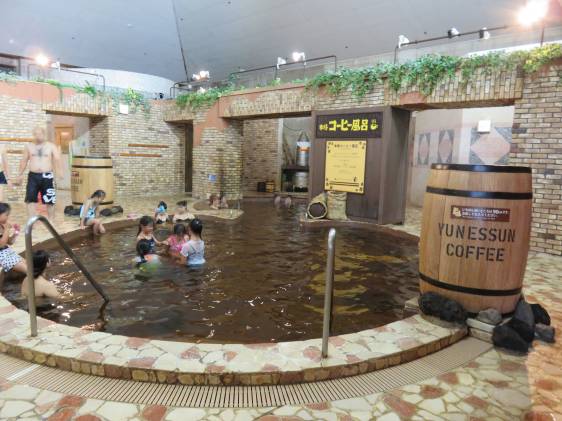
Hakone Yuryō
16-minute walk from Hakone-Yumoto Station Shuttle bus from Hakone-Yumoto Station (3 minutes, free) From ¥ 1,600 ( ¥ 200 – ¥ 300 discount with HFP)
Hakone Yuryō boasts several outdoor and indoor hot spring baths, offering guests the opportunity to relax and rejuvenate in therapeutic waters while taking in the surrounding nature.
There are both public and private baths available. Entry for the public onsen starts at ¥ 1,600 . The private onsen is considerably more expensive, starting at ¥ 9,400 for two hours, but you can get a discount with the Hakone Free Pass.
There is also an atmospheric restaurant in the facility where you can cook your food over an open hearth.
Hakone Yuryo

Tenzan Onsen
2-minute walk from Okuyumoto-iriguchi bus stop Free shuttle or K Line bus from Hakone-Yumoto Station (6 minutes, ¥ 240 without HFP) ¥ 1,450
Tenzan is a standard hot spring, with beautiful rock-lined rotenburo (open-air baths) against the mountainside. The onsen offers a free shuttle bus from Hakone-Yumoto Station, but what makes this spa notable is its acceptance of tattoos , somewhat rare in the world of Japanese baths. The official policy is that inked patrons aren’t exactly welcomed — guidelines say you need to come alone — but you won’t exactly be booted out, either. Just be discreet, and you should be fine.

Kohan-no-yu
How to avoid the crowds, faqs: what is hakone known for and more, what is hakone famous for.
Most of all, Hakone is known for its hot springs. Onsen are everywhere — in day spas, ryokan, hotels, and foot baths. This is the main reason people visit. That and views of Mt. Fuji from Lake Ashi. If you’re an anime fan, you might also recognize Hakone from Neon Genesis Evangelion .
How many days should I spend in Hakone?
While Hakone can be done in a day, most stay overnight to take in all the areas. Two to three days is enough to see everything, but one day is sufficient if you cut out some sights.
When is the best time to visit Hakone?
Hakone can get very busy, so it is best to visit on a weekday and outside of the fall season when it is extra crowded and hotel prices shoot up.
Late spring is when the ajisai (hydrangeas) bloom alongside the tracks of Hakone’s cute mountain train and winter is preferable because of clear Mt. Fuji views and toasty hot springs.
While on the way to Hakone, why not jump off at Odawara Station and see Odawara Castle ?
Looking for more day-trip recommendations? Consider checking out top day-trip destinations like Kawaguchiko and Kamakura .
While we do our best to ensure information is correct, it’s subject to change. This article was first published in January 2015 and has been contributed to by Carey Finn and Chris Kirkland. Last updated in February 2024 by Alexandra Ziminski.
- Hot springs
- Mountain walks
- Weekend-getaway
Get our Tokyo Cheapo Hacks direct to your inbox

How and Where to Buy Shinkansen Tickets

Top Japanese Phrases You Need Before Traveling to Japan

Tokyo's Best Airport: Flying into Narita vs. Haneda

A Beginner's Guide to Shibuya - Scramble Crossing, Shopping & Great Views!

The Best eSIMs for Visiting Japan

A Guide to ALL Pokemon Centers in Tokyo, Japan

24 Hours in Tokyo — The Ultimate Itinerary Guide

Yozakura: 8 Best Nighttime Cherry Blossom Illuminations in Tokyo
Light-ups have been extended, since the blossoms were so late this year.

Tokyo Events This Week: Pink Petals and a Fertility Festival
Tokyo events for Monday, April 1 to Sunday, April 7, 2024.

New Video: Tokyo's Best Airport — Flying into Narita vs. Haneda
Which one should you use when flying to Tokyo?

Updated Forecast: 2024 Tokyo Cherry Blossom Dates
They've been teasing us — but looks like they're about to bloom, at last.

April 2024: 5 Events Not To Miss in Tokyo
A chance to see the infamous "penis festival", puppies, processions, and more!

Mega Guide: 24 Best Places to See Cherry Blossoms in Tokyo
Choose from parks, traditional gardens, mountains and more.

The Hokuriku Arch Pass: Taking the Slow Route Between Tokyo and Osaka
Meander along Japan's "golden route" — exploring Nagano, Kanazawa and more.

Spring Escapes: Top 7 Day Trips from Tokyo
Must-see cherry blossom, moss phlox, and wisteria locations — all easily accessible from Tokyo.

Ashi Angels: Hakone for Evangelion Fans
Explore the real Tokyo-3.

Top 10 Tokyo Cherry Blossom Festivals in 2024
Where to go for street food, music — and lots of sakura.

Recommended hotels located nearby

Close without accepting
12 Hakone Things To Do – A One Day Trip Itinerary With All The Best Activities
Things to do in Hakone
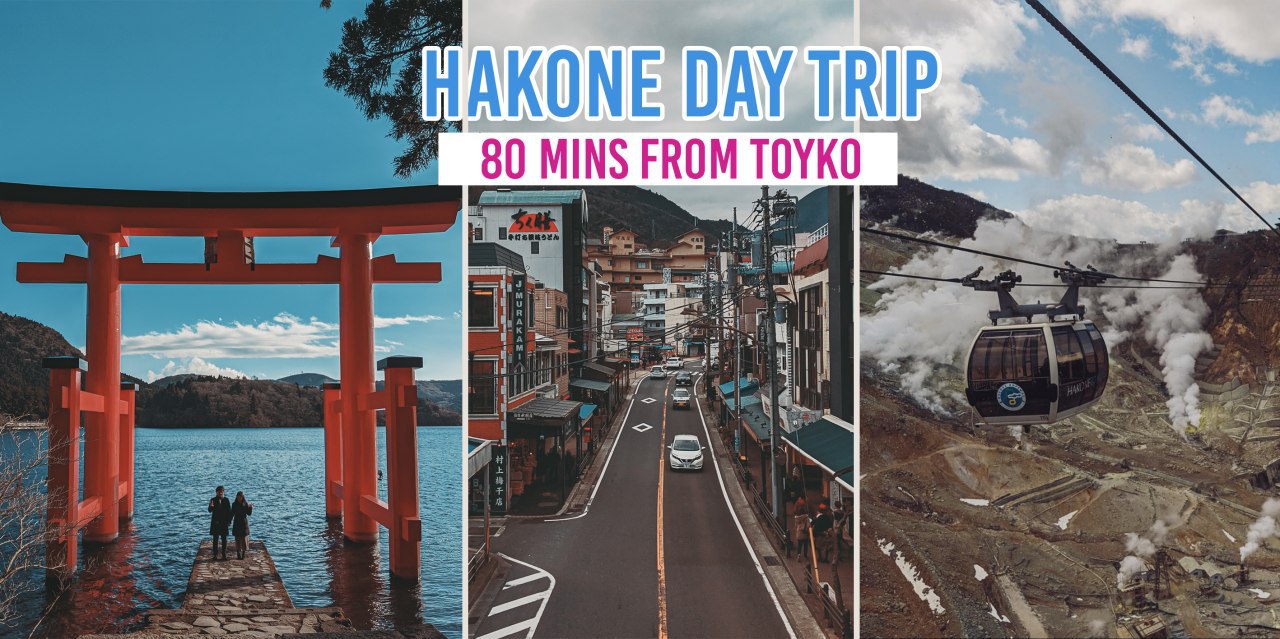
Tokyo may be the epicentre of all Japanese experiences, but nothing quite ripens one’s historical and cultural appreciation for all things Japanese like a day trip to charming Hakone – an idyllic town just an 80-minute train ride from Shinjuku station.
Even if your current holiday itinerary has city pit stops such as Kyoto and Osaka , from leveling up your onsen experience with a sake bath to extending your life with a legendary black egg, here are 12 Hakone experiences not to be missed on your next trip to the Land of the Rising Sun.
PSA: Expect Sakura blooms if you’re travelling in April or even during the winter months – the snow adds to Hakone’s already gorgeous aesthetic, with the nearby Mount Fuji looming majestically in the background wherever you go.
Getting to Hakone
The easiest way to get to Hakone from Tokyo is through Shinjuku station. We recommend picking up a Hakone Freepass (¥5,700, ~S$73.60) which can be purchased there or from any station on the Odakyu line . It is difficult to travel by taxi in Hakone because there aren’t many of them, so familiarising yourself with the public transport system will come in handy.
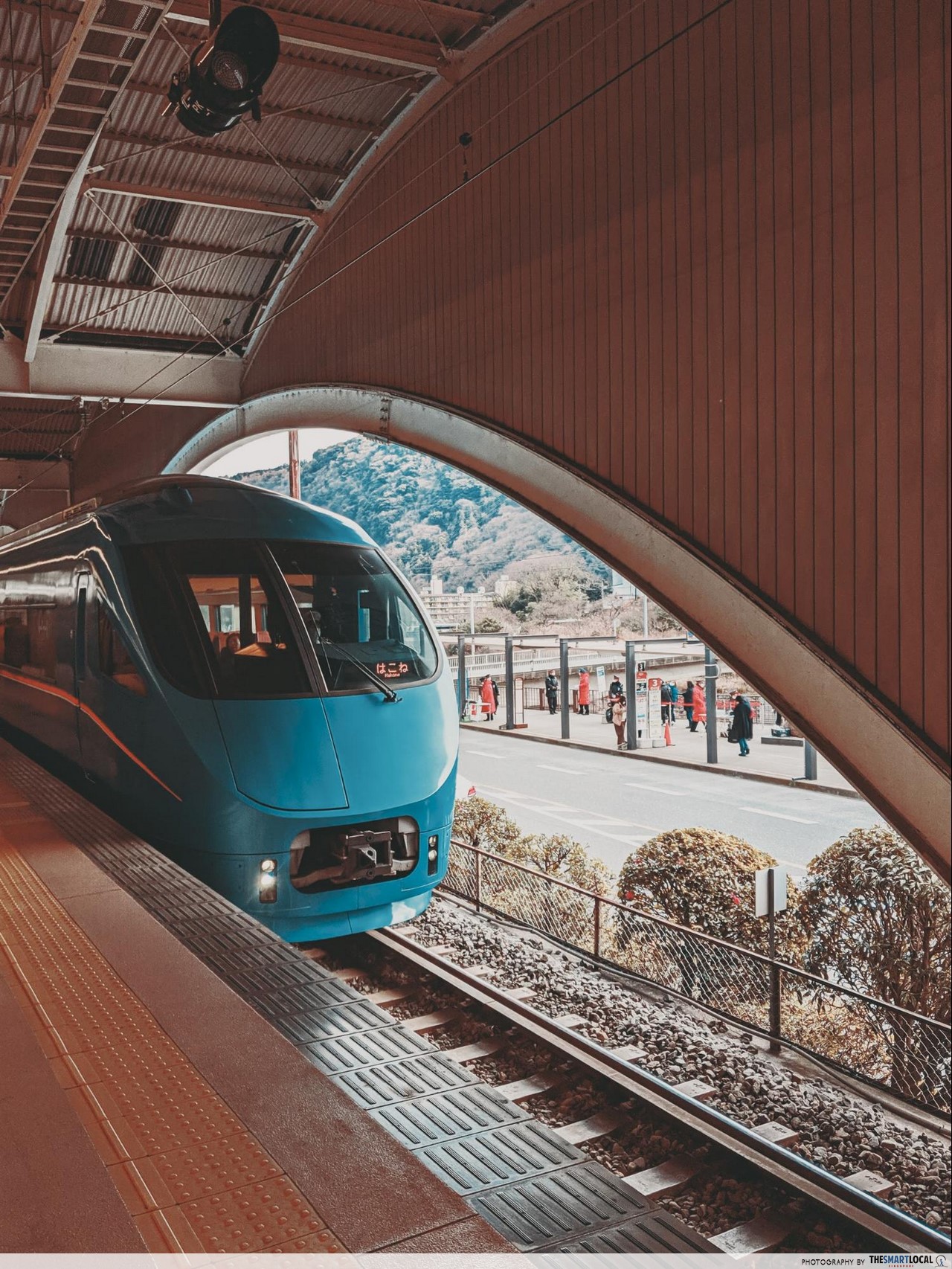
The 2-day Hakone Freepass gives you unlimited rides on any Odakyu -affiliated transport and free or discounted admission to most attractions. One of the trains that takes you from Shinjuku to Hakone-Yumoto is called the Romancecar.
To ride the Odakyu Limited Express Romancecar , both a regular ticket (free with the Hakone Freepass) and a limited express ticket are required. The limited express ticket from Shinjuku to Hakone-Yumoto is priced at ¥1,110 (~S$14.20) one-way so it requires an additional top-up.
Here’s our suggested itinerary for a day trip to Hakon e:
Hakone Day Trip Itinerary
- 8AM: Shinjuku Station – Board the Odakyu Romancecar bound for Hakone-Yumoto
- 9.30AM: Hakone-Yumoto Station – Take the Hakone Tozan Bus bound for Hakone-machi-ko (H Line)
- 10.30AM: Take a 10-minute walk to Hakone-jinja Shrine
- 12PM: Take a 10-minute walk back to Motohakone-ko and board the Hakone Sightseeing Cruise
- 1.30PM: Reach Togendai Station and take the Hakone Ropeway bound for Owakudani
- 2.30PM: Disembark at Owakudani Station
- 3.30PM: Board the Hakone Ropeway again bound for Sounzan . At Sounzan Station, board the Hakone Tozan Cable Car* bound for Gora .
- 4PM: Take a 5-minute walk to Hakone Gora Park or bus (or a 15-minute walk) to the Hakone Open Air Museum
- 5PM: Head back to Hakone-Yumoto Station to take the return train to Shinjuku .
*The Hakone Tozan Cable Car will resume operation on 20th March 2020.
We’ve created a GoogleTrip map which you can see here . Most travellers will take the train from Shinjuku to Hakone-Yumoto – which is the train station located in Hakone town. They’ll start their sightseeing and eventually circle back to Hakone town to take the train back to Shinjuku .
This route is the most recommended way to explore Hakone as you get to tick off all the major sights including the Hakone Shrine, Lake Ashi and the volcanic Owakudani area along Hakone Ropeway .
If you’d like to extend your trip, you can follow our recommendations at the bottom of this article – stay at one of the onsen hotels at GORA or head over to the the GOTEMBA outlets for some shopping.
1. Hakone Town – Eat kamaboko
Hakone town serves as the hub that connects Hakone to the rest of Japan, set against a beautiful mountain backdrop. After alighting from the train station, you can visit one of the hot springs in the area, the souvenir shops, foot baths or try some of the street food the town is known for like Kamaboko (fish paste).
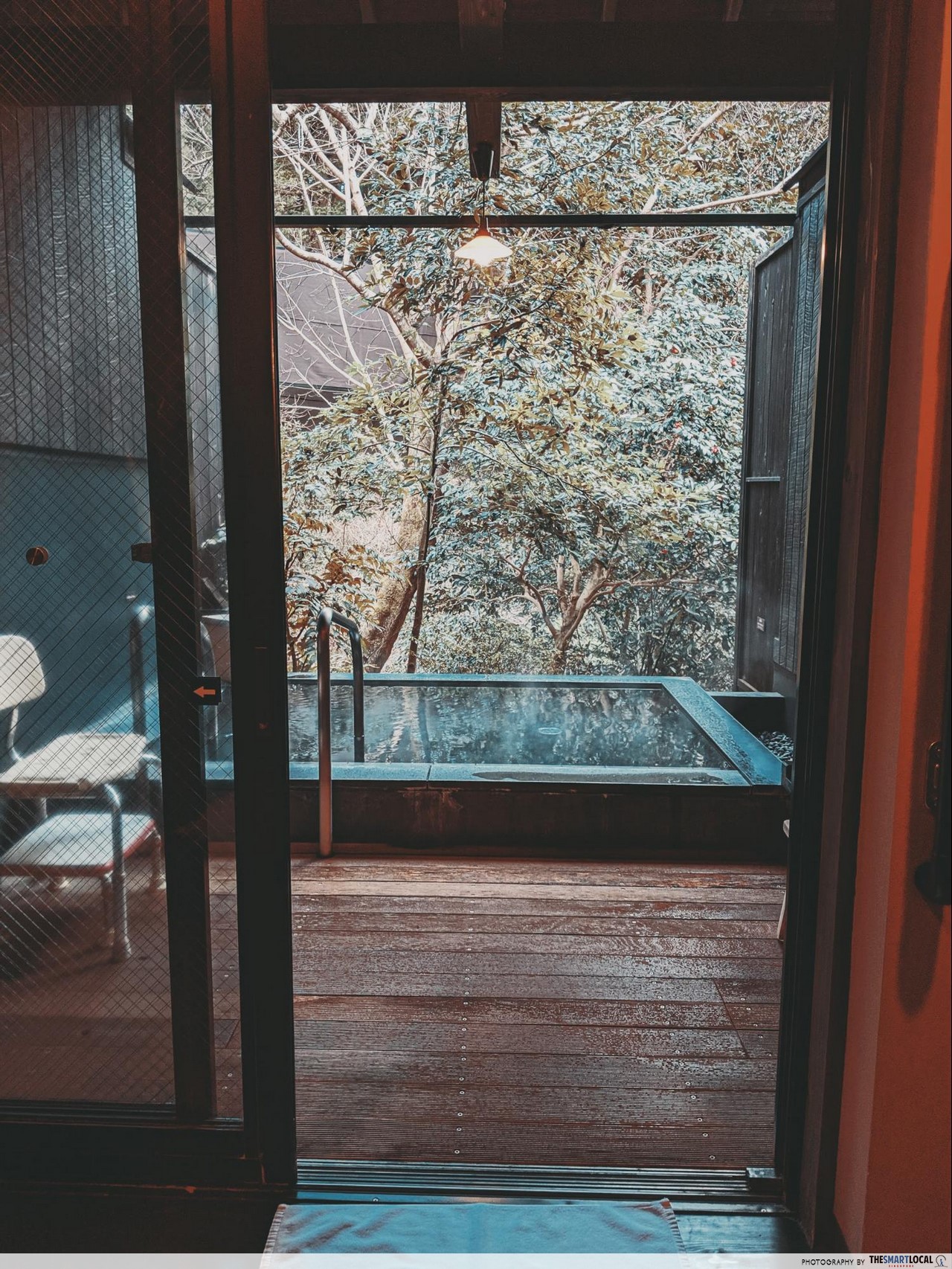
When you’re on a day-trip, hours are limited so we recommend only exploring Hakone at the end of the day if time permits. Take the 35-minute bus ride at Hakone-Yumoto Station by Hakone Tozan Bus (Line H) to Moto-Hakone boat pier. It’s free if you have the Hakone Freepass or priced at ¥980 (~S$12.65) otherwise. Buses depart every 15 minutes.
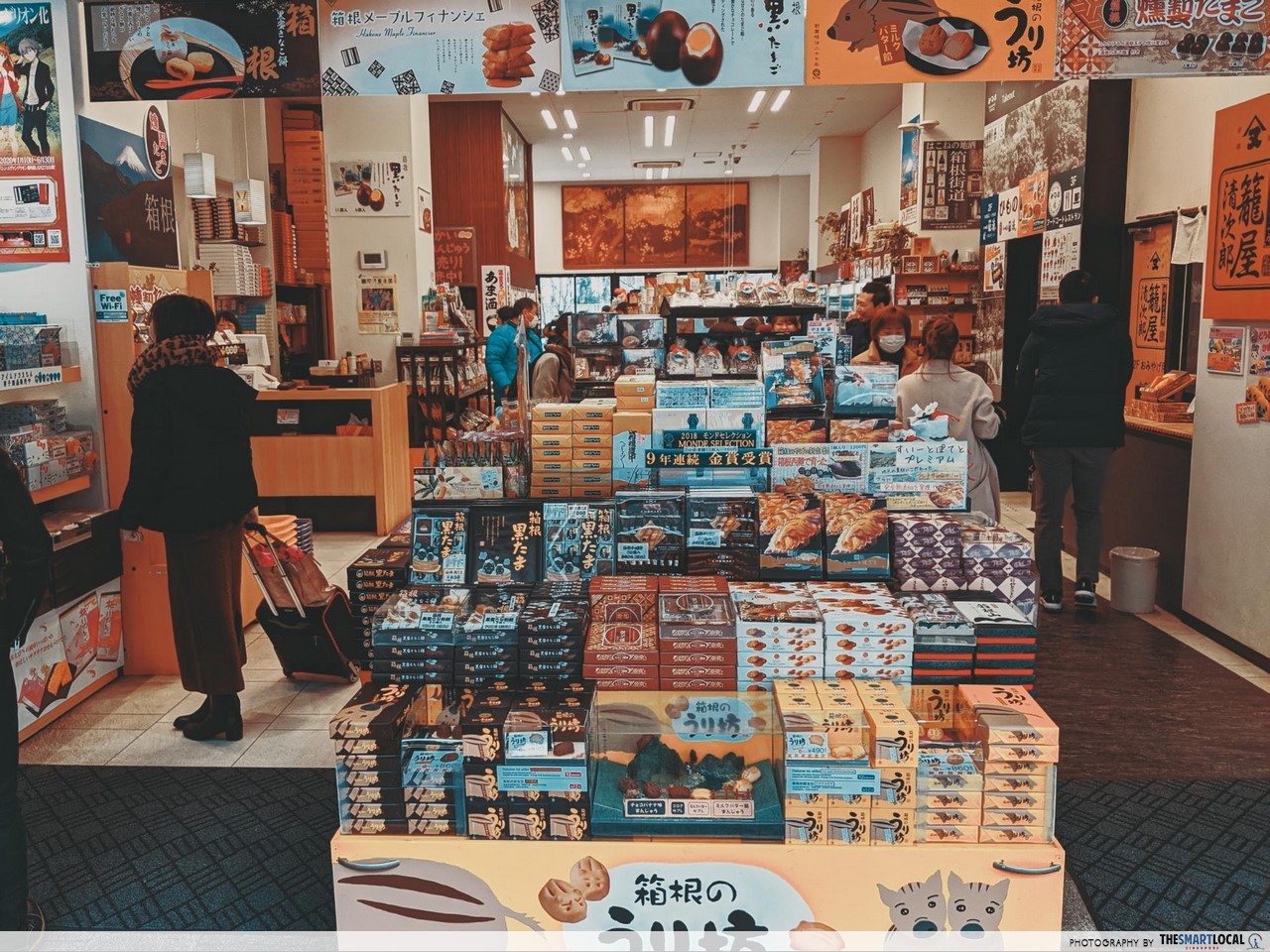
2. Hakone-jinja Shrine – receive love blessings
We recommend checking Google maps during your commute so you know where to alight. After you arrive at Moto-Hakone boat pier, Hakone-jinja Shrine is a 5-minute walk away.
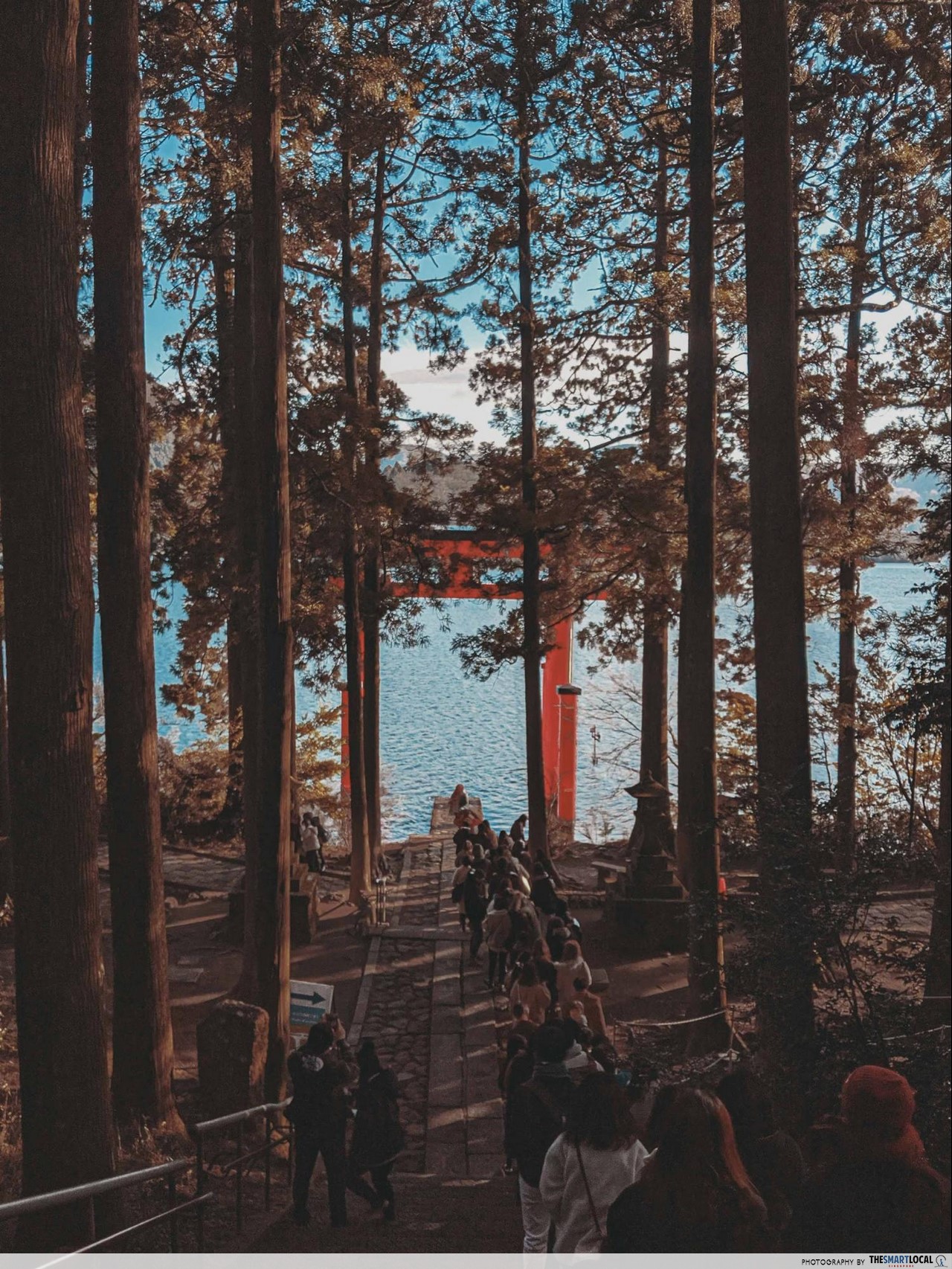
You’re going to pass two large wooden structures called Torii gates, which in Shintoism signifies that you’re entering a sacred area. Walk down to the Heiwa no Torii (Gate of Peace) that appears to be floating on the surface of Lake Ashi . Be prepared to wait about an hour for your turn to take a picture.
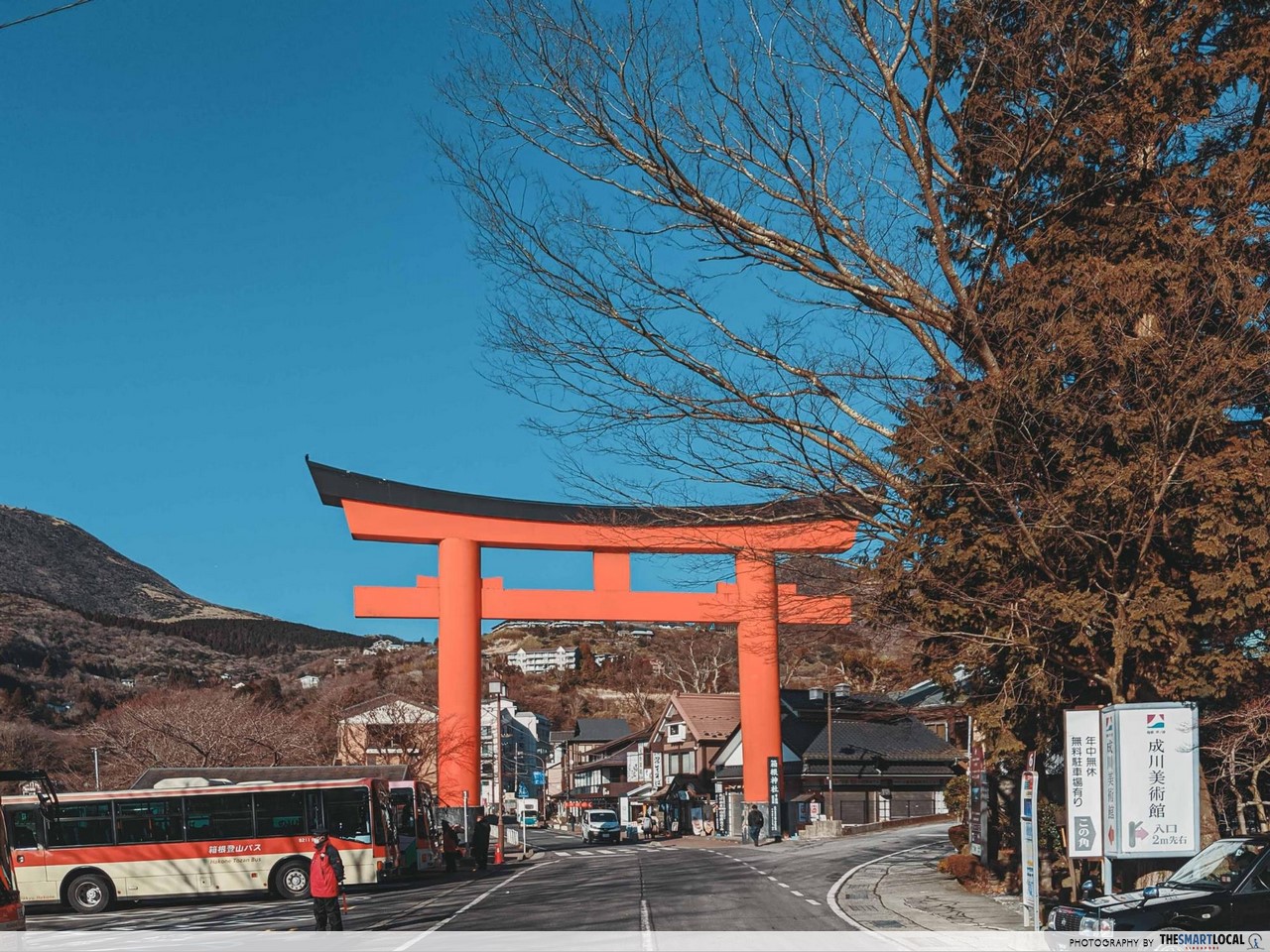
If you’d like to visit the main shrine, you can climb up the Seisando (path of pilgrimage) which is several hundred stone steps long. Hakone-Jinja was a popular shrine for samurai with its origins tracing back to the Nara period in AD 757. You’ll see lots of pine and cedar trees here which can’t grow in Tokyo. We were told that these trees are exceptionally popular for their straightness and height that represent honesty in Japanese culture.
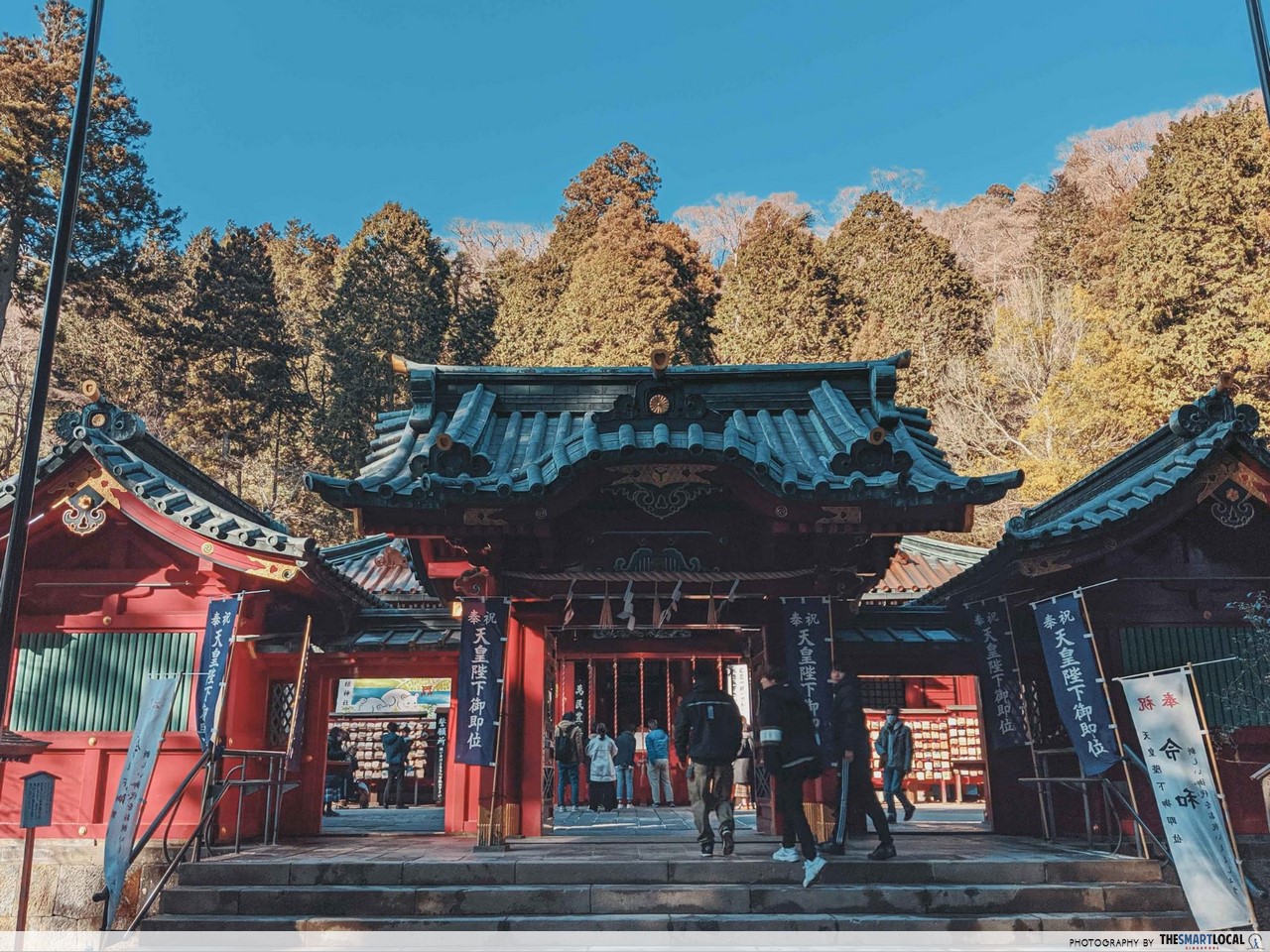
Today, these sacred trees along with Lake Ashi make Hakone Shrine a spiritual hotspot for blessings in relationships. And that’s why you’ll see many couples from all over Japan coming here to take a picture at the Heiwa no Torii .
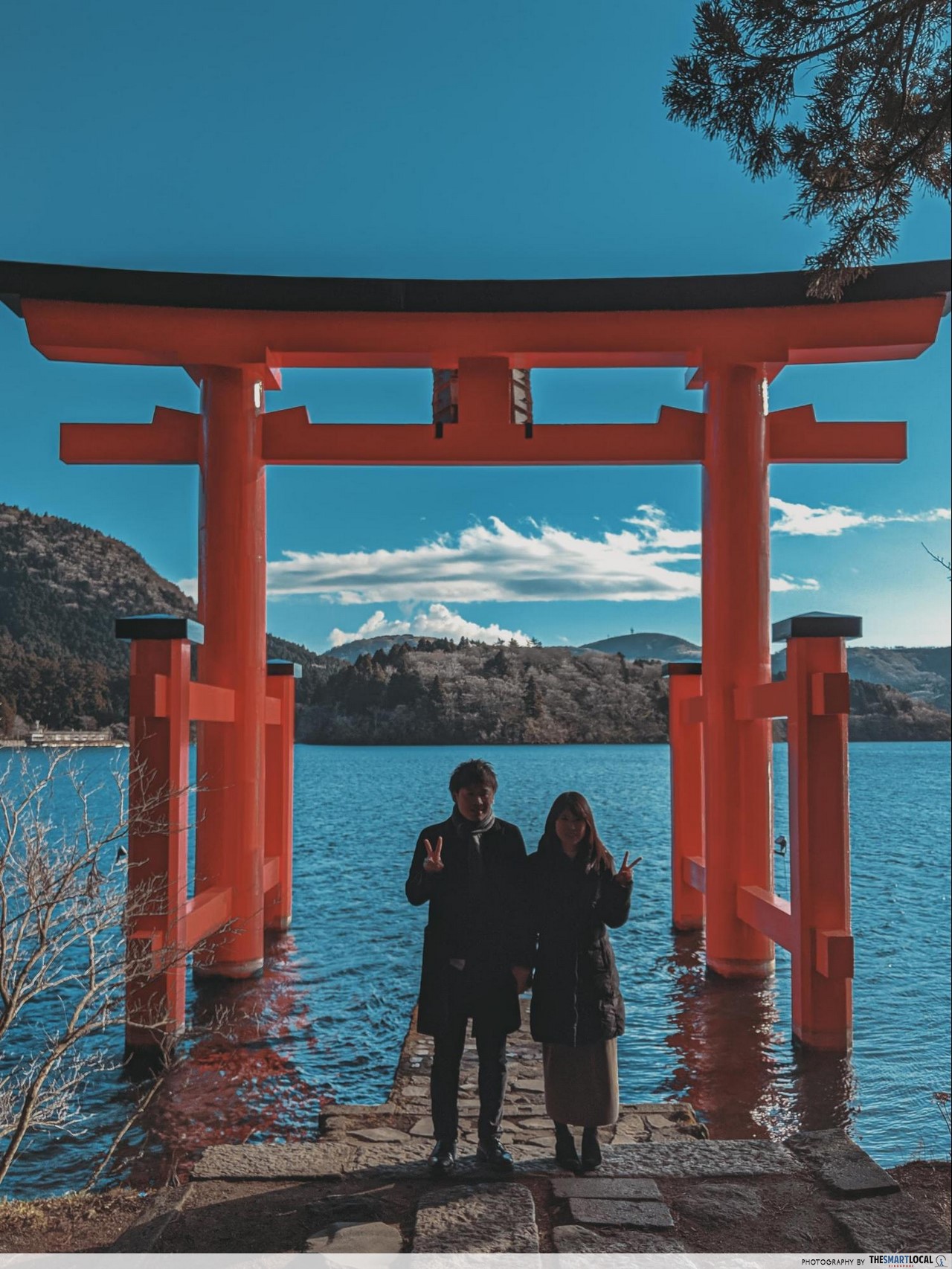
Address: 80-1 Motohakone, Hakone, Ashigarashimo District, Kanagawa 250-0522, Japan Price: Free Treasure house (Homotsuden) : Adults: ¥500 (~S$6.46), Students: ¥300 (~S$3.87) Opening Hours : Main Shrine 9AM | Heiwa no Torii 24 hours Directions : 35-minute bus ride at Hakone-Yumoto Station by Hakone Tozan Bus (bus line H) to Moto-Hakone boat pier
3. Board a pirate ship through the Hakone Sightseeing Cruise
Walk back to Moto Hakone and board one of the three Hakone Sightseeing Cruise ships – the Royal II, Victory or Queen Ashinoko that’ll take you across Lake Ashi and straight to the Hakone Ropeway. Be sure to head to the Moto Hakone pier which is slightly further down. The Lake Ashi cruise pier is for boats run by Izuhakone , which are not covered under the Hakone Freepass.
Lake Ashinosko or Lake Ashi for short, was formed after Mount Hakone erupted about 3,000 years ago. The Hakone Sightseeing Cruise offers a lovely view of Lake Ashi and Mount Fuji, with the journey to the other side taking around 30 minutes.
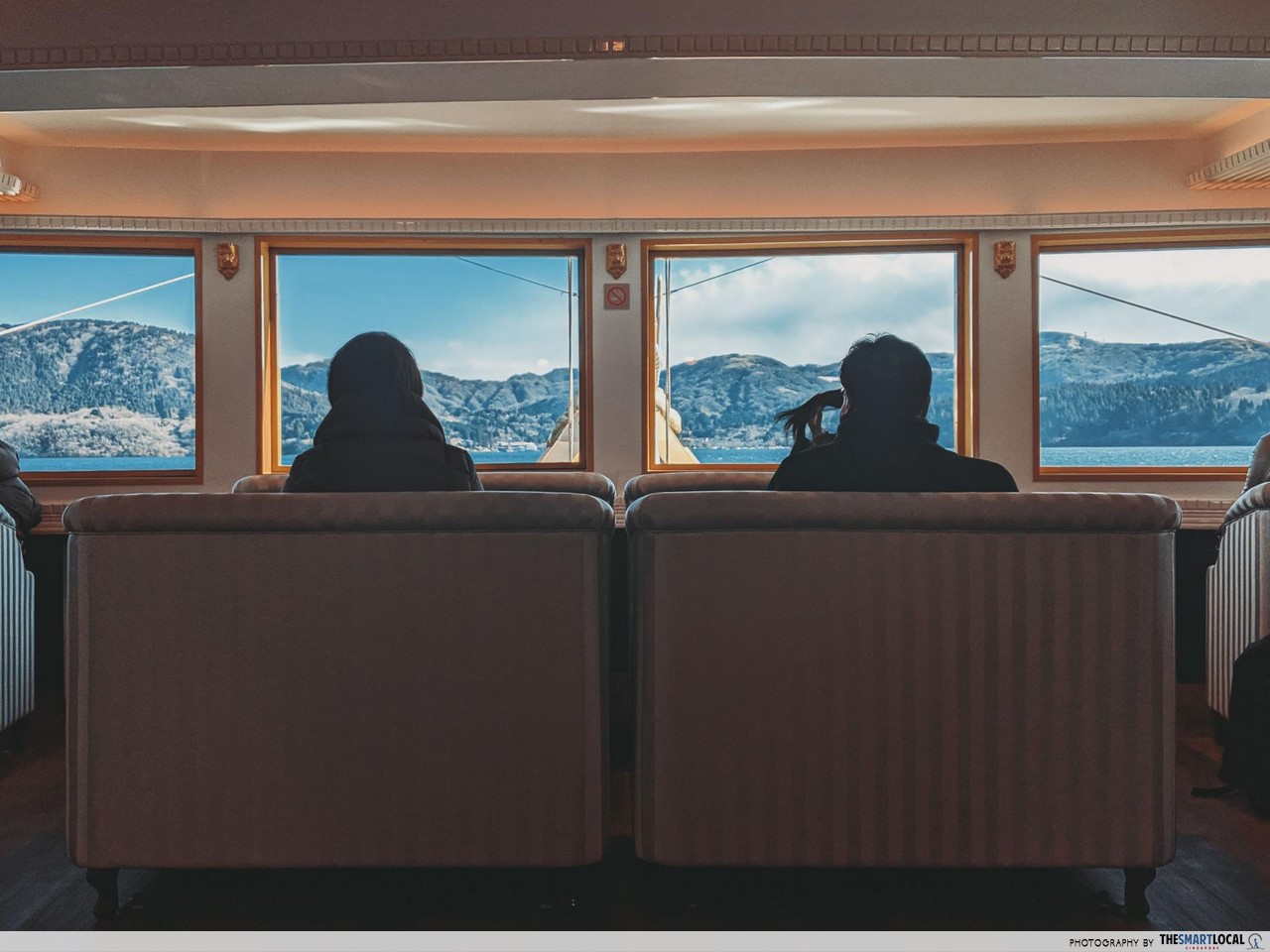
C heck the cruise schedule for the latest timings.

Address: 6-40 Motohakone, Hakone, Ashigarashimo-gun, Kanagawa 250-0522, Japan Price: Free with the Hakone Freepass or ¥1050 (~S$13.56) otherwise, for the full cruise from opposite sides. Opening Hours : 10AM-5PM. Cruises operate every half an hour but operating hours may differ based on the season.
Hakone Sightseeing Cruise
4. Get the best view of Hakone on the Hakone Ropeway
After you depart at Togendai , you can walk right over to Hakone Ropeway. Togendai is the first of 4 stations belonging to this cable car-like ride more accurately called funitels . It’ll take you 24 minutes to go from this station to the last – Sounzan Station.
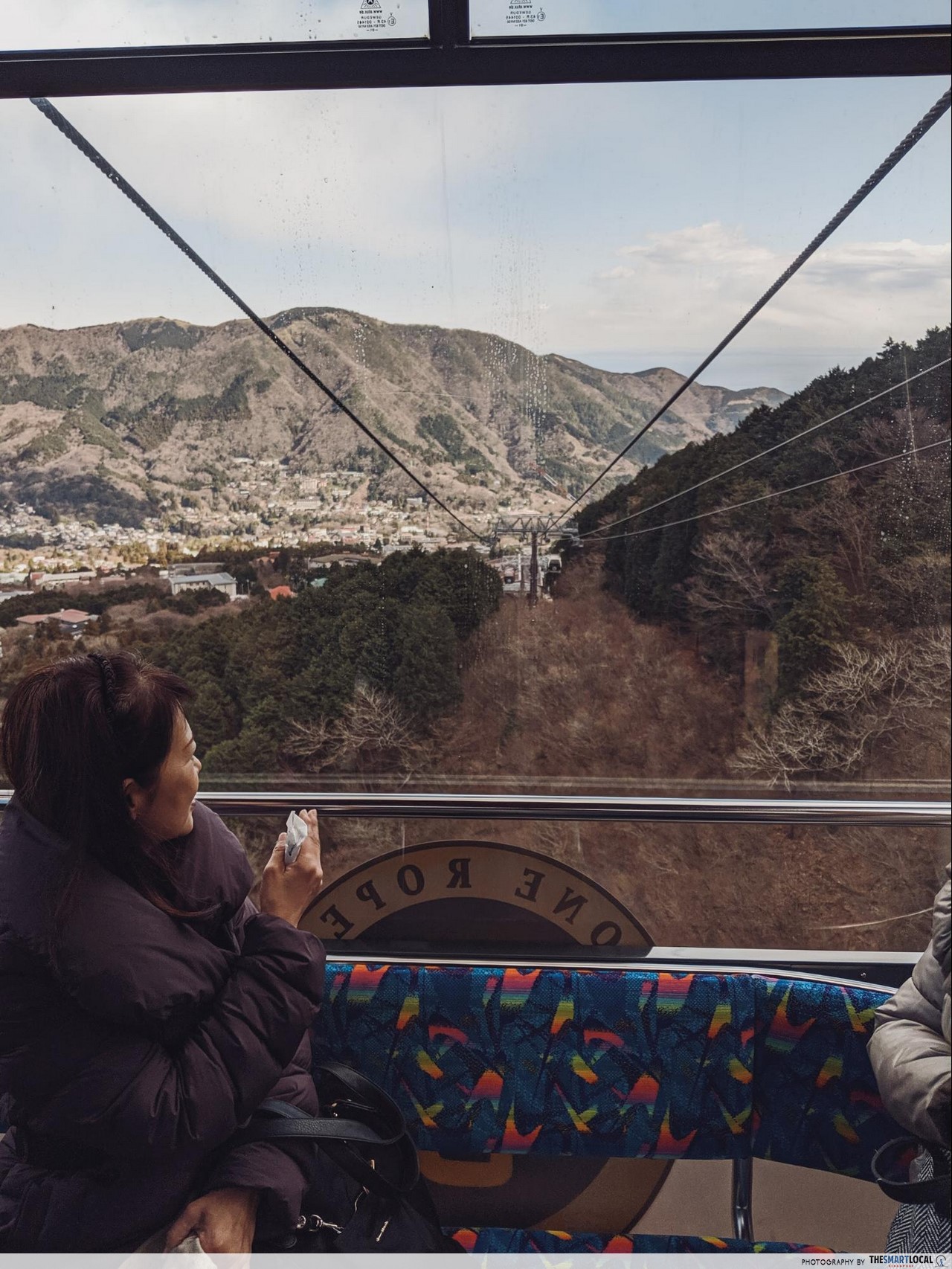
Hakone Ropeway ride cuts through the mountainous terrain while giving you a gorgeous view of Hakone from above including sights like Lake Ashi and Mount Fuji. We recommend skipping Ubako – the station you have to stop at is Owakudani .
Address: Togendai Station – 164 Moto-Hakone, Hakone-machi, Ashigarashimo-gun, Kanagawa-prefecture Price: Free with the Hakone Freepass, otherwise from ¥740 ( ~S$9.54 ) one way. Opening Hours : 1st Feb – 30th Nov 9AM-5PM | 1st Dec – 31st Jan 9AM-4.15PM
Hakone Ropeway Website
5. Eat Japanese Curry amidst volcanic activity
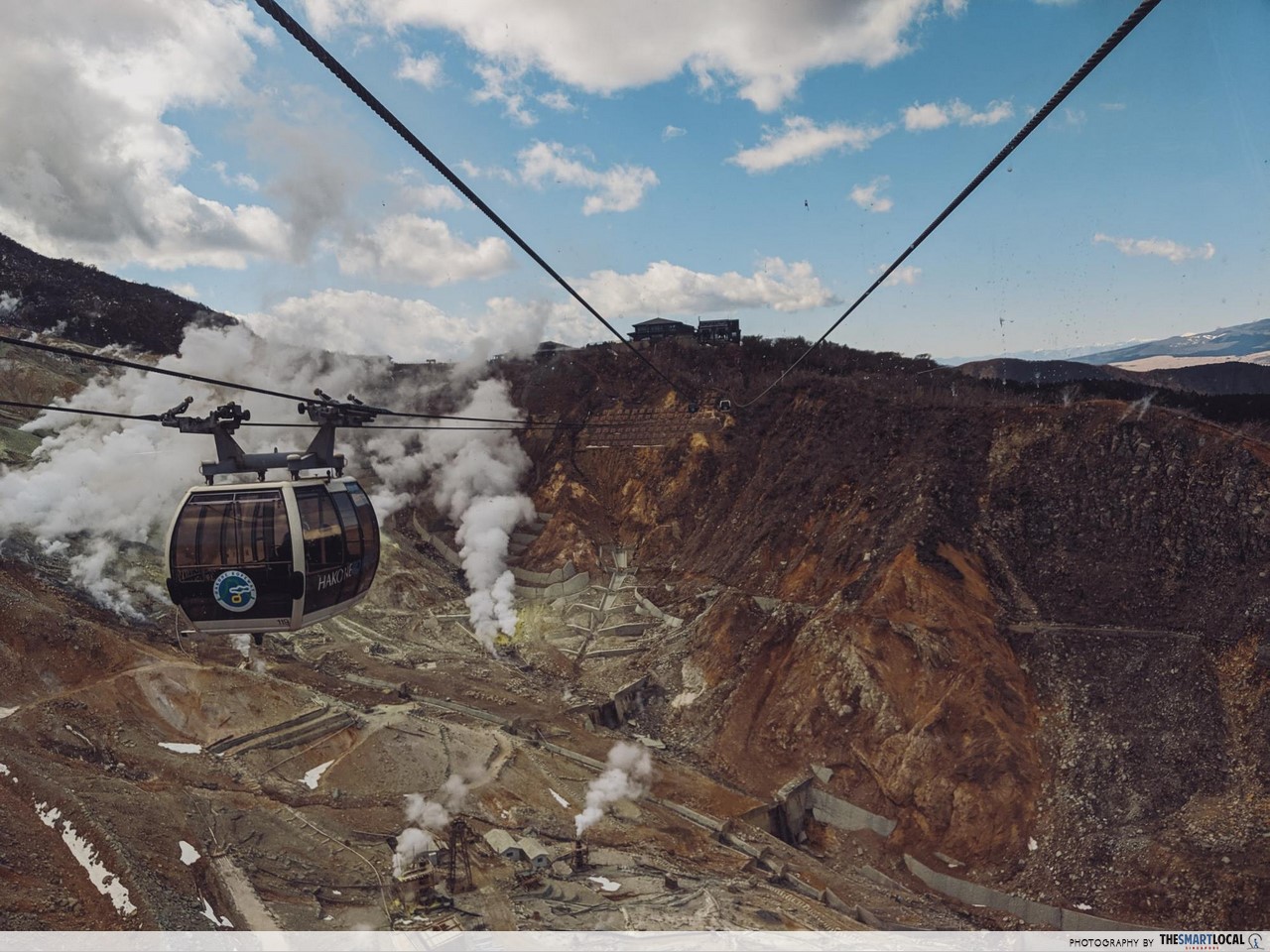
You’ll be greeted by the volcanic fumes of sulphur as you approach Owakudani , an active volcanic area that dates back 3,000 years. You’ll also be able to visit an onsen here thanks to the natural hot springs, or grab a bowl of Japanese curry from Owakudani Station restaurant.
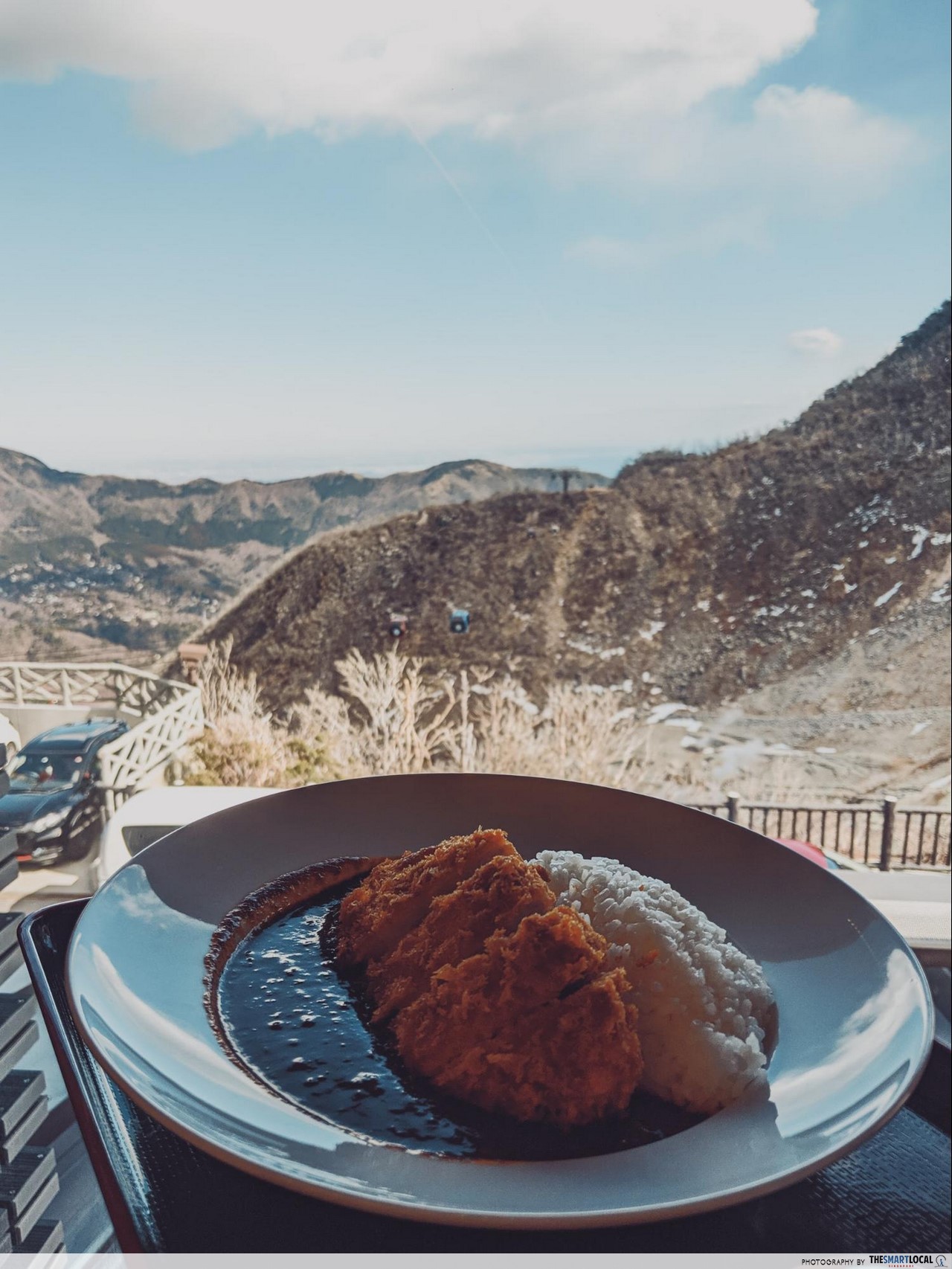
The smell of sulphur was a bit too intense for me and some advise wearing a mask if you’re sensitive.
6. Extend your life with a black egg
Grab a black egg also known as kurotamago from this shop while you’re at Owakudani station before continuing your journey to Sounzan station. Legend has it that these black eggs prolong your life for 7 years, but don’t report us for fake news if that doesn’t turn out true. These eggs get their colour after being boiled into sulphuric water and after you peel the shell away, they taste like your typical yummy hard-boiled egg.
Address: Owakudani Station – 1251 Sengokuhara, Hakone, Ashigarashimo-gun, Kanagawa-prefecture Price: Free with the Hakone Freepass, otherwise from ¥570 (~S$7.36) one way. Opening Hours : 1st Feb – 30th Nov 9AM-5PM | 1st Dec – 31st Jan 9AM-4.15PM
Once you’re at Sounzan station, transfer to the Hakone Tozan Cable Car, a railway train that will take you to Koen-kami station at Gora . Hakone Gora park is a 5-minute walk away.
7. Create couple art at Hakone Gora Park
Hakone Gora Park is a French-style landscape park that’s been around for over a hundred years. The main attraction here is the craft house which attracts couples who partake in workshops that range from ceramics to sandblasting. You can even create your own customised matching couple beads here.
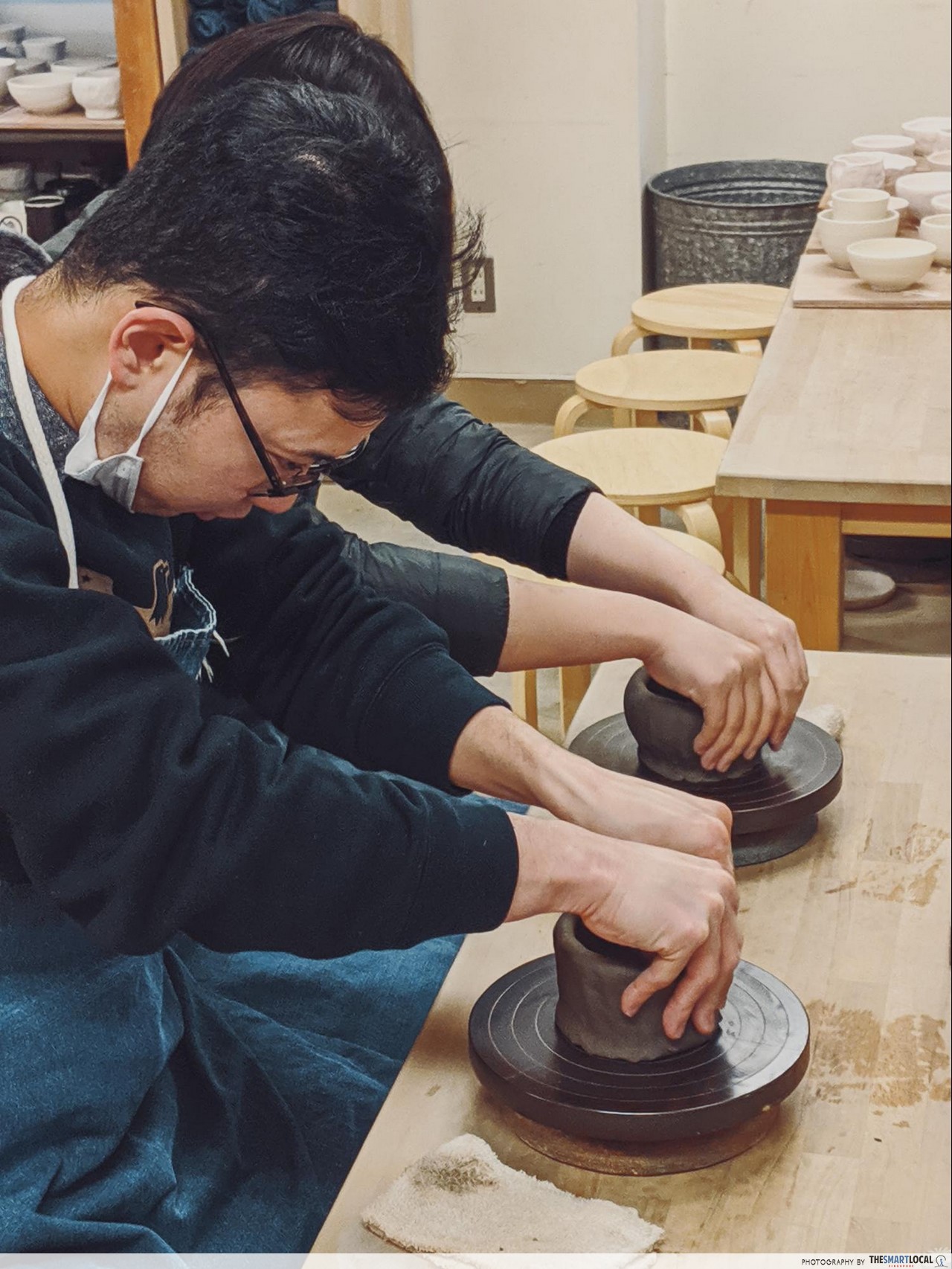
Highlights include a tropical plant pavilion, greenhouses and a tea house which consist of 3 tea rooms.
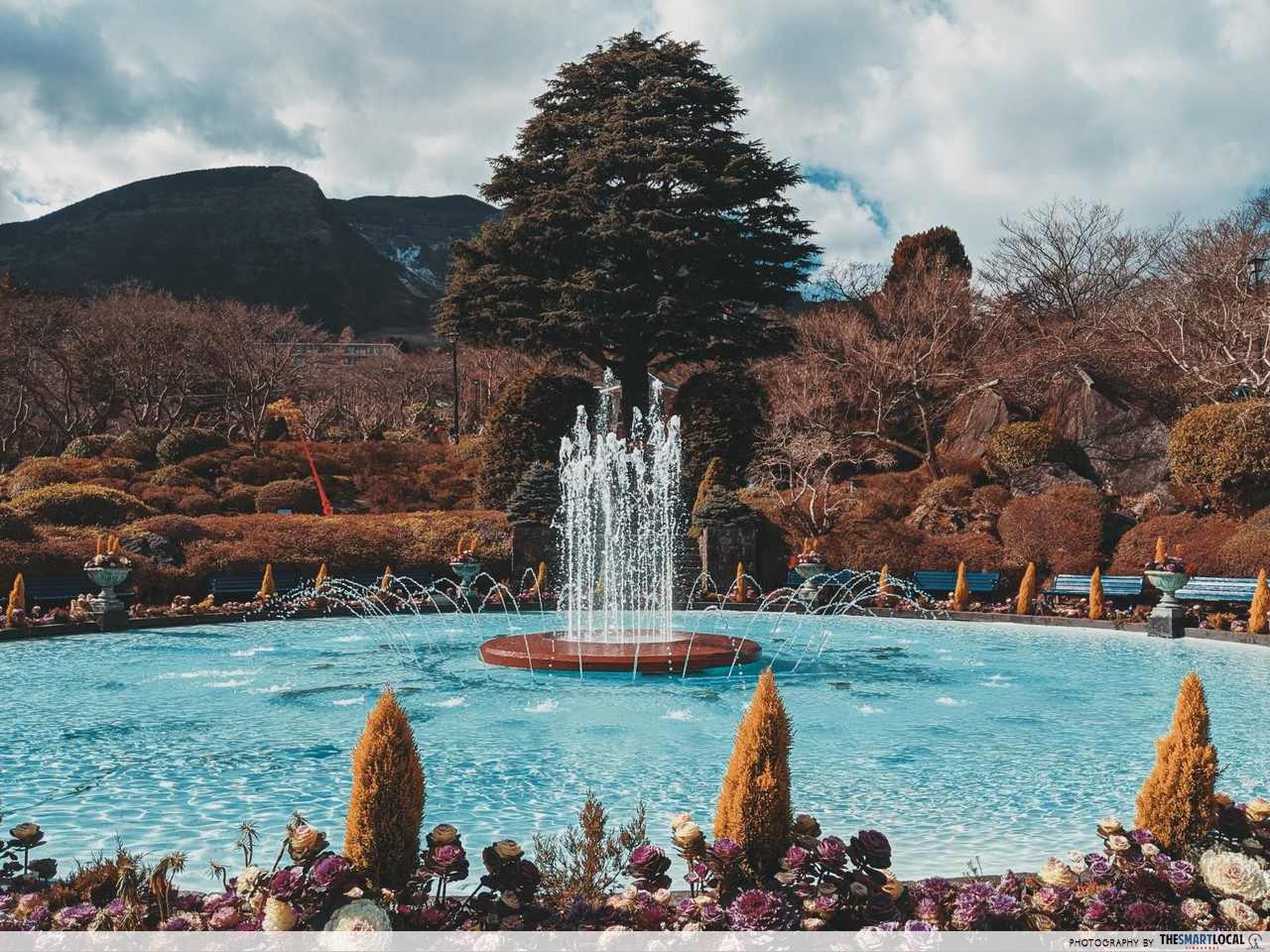
Address: 1300 Gora, Hakone-machi, Ashigarashimo-gun, Kanagawa Prefecture 250-0408 Price: Free under the Hakone Freepass, otherwise ¥550 (~S$7.10). Opening Hours : HAKONE CRAFT HOUSE 9AM-5PM, Entry until 4.30PM | Isshikido Saro 10AM-5PM, L.O. 4.15PM | HAKUUN-DO tea garden (Tea ceremony houses) morning session 10AM-12PM, afternoon session 1PM-4PM
8. Visit the Hakone Open-Air Museum
Hakone Open-Air Museum is Japan’s first outdoor art museum, that’s about 600M away from Gora Park. It opened in 1969 with the mission to make sculpture art more popular. There are over 120 all-weather art pieces scattered over the park and five indoor exhibits.
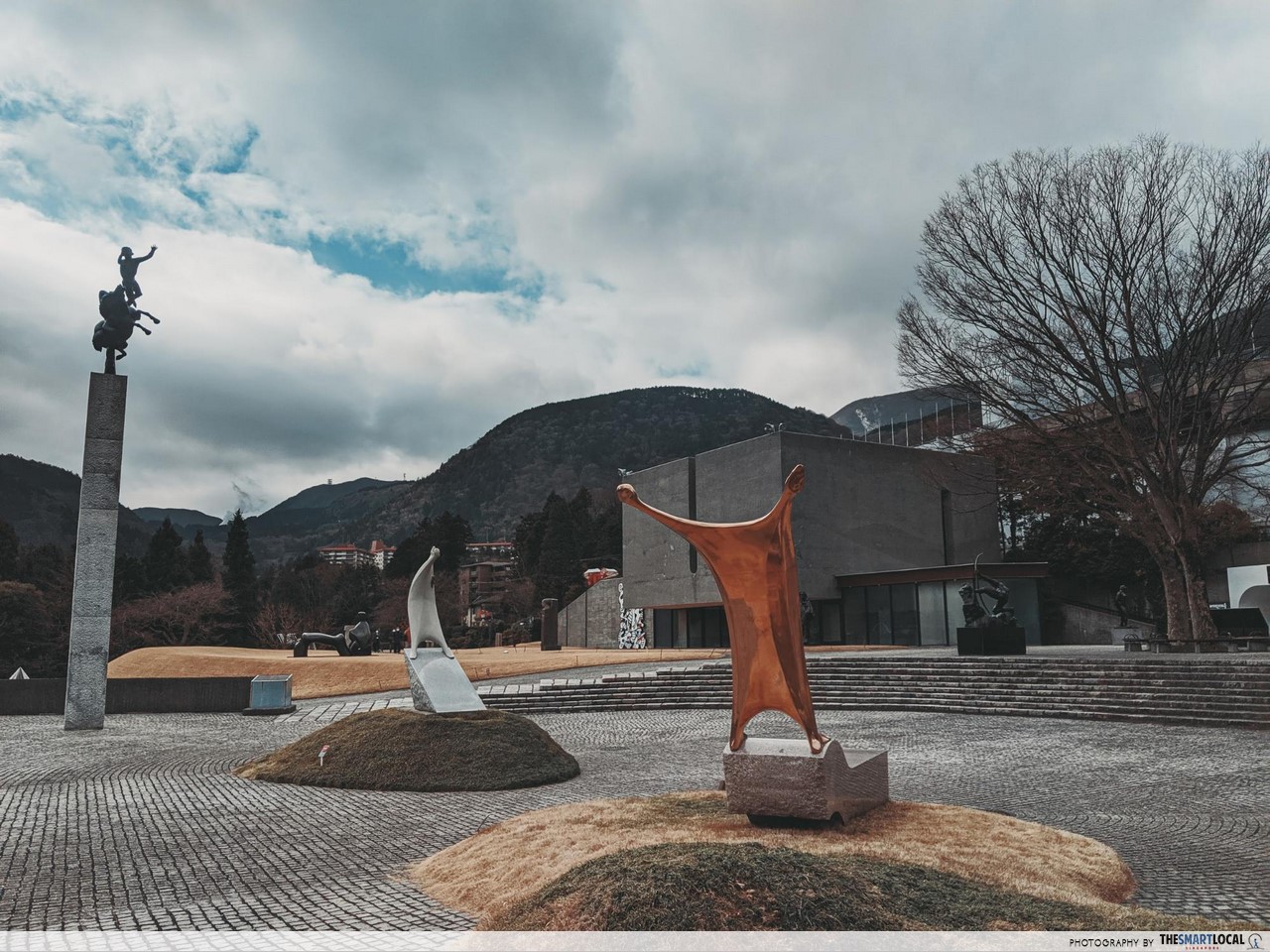
Here are 2 exhibits popular with kids – “Wood of Net” and “Curved Space-Diamond”.
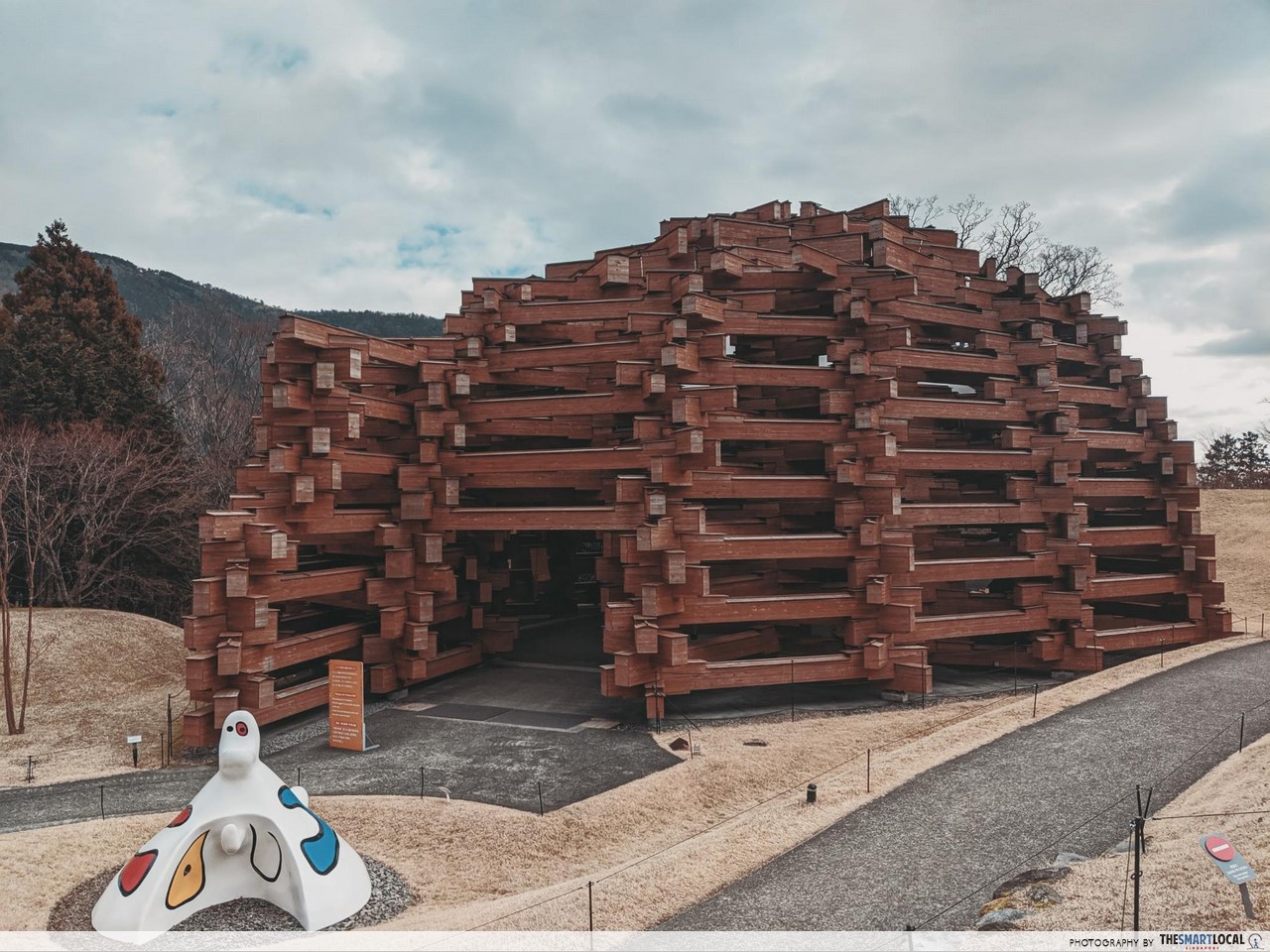
The highlight for me was the Picasso museum , which houses over 300 works of Pablo Picasso. It includes over 188 ceramic works that are all real.

One of the most eye-catching exhibits here is “Miss Black Power”, created by Niki de Saint Phalle.
Address: 1121 Ninotaira, Hakone-machi, Ashigarashimo-gun, Kanagawa-prefecture 250-0493 Price: ¥1,600 for adults (~S$20.66), ¥1,200 for students (~S$15.49) with Hakone Freepass save ¥200 adults, ¥100 students Opening Hours : 9AM-5PM, last admission at 4.30PM. Directions: Here
Hakone Open-Air Museum
If you’re following our 1-day itinerary, it would be getting quite late now and you can opt to head back to Hakone-Yumoto to head back to Tokyo, or head over to the Yunessun spa area which has a host of onsen accommodation options. Here are some other ideas if you’re planning to stay in Hakone for the night.
9. Soak in a Wine spa at Yunessun Complex
Hakone is also known for being the main location in the anime series Neon Genesis Evangelion, so don’t be surprised to be greeted by its manga memorabilia at the entrance of Yunessun .
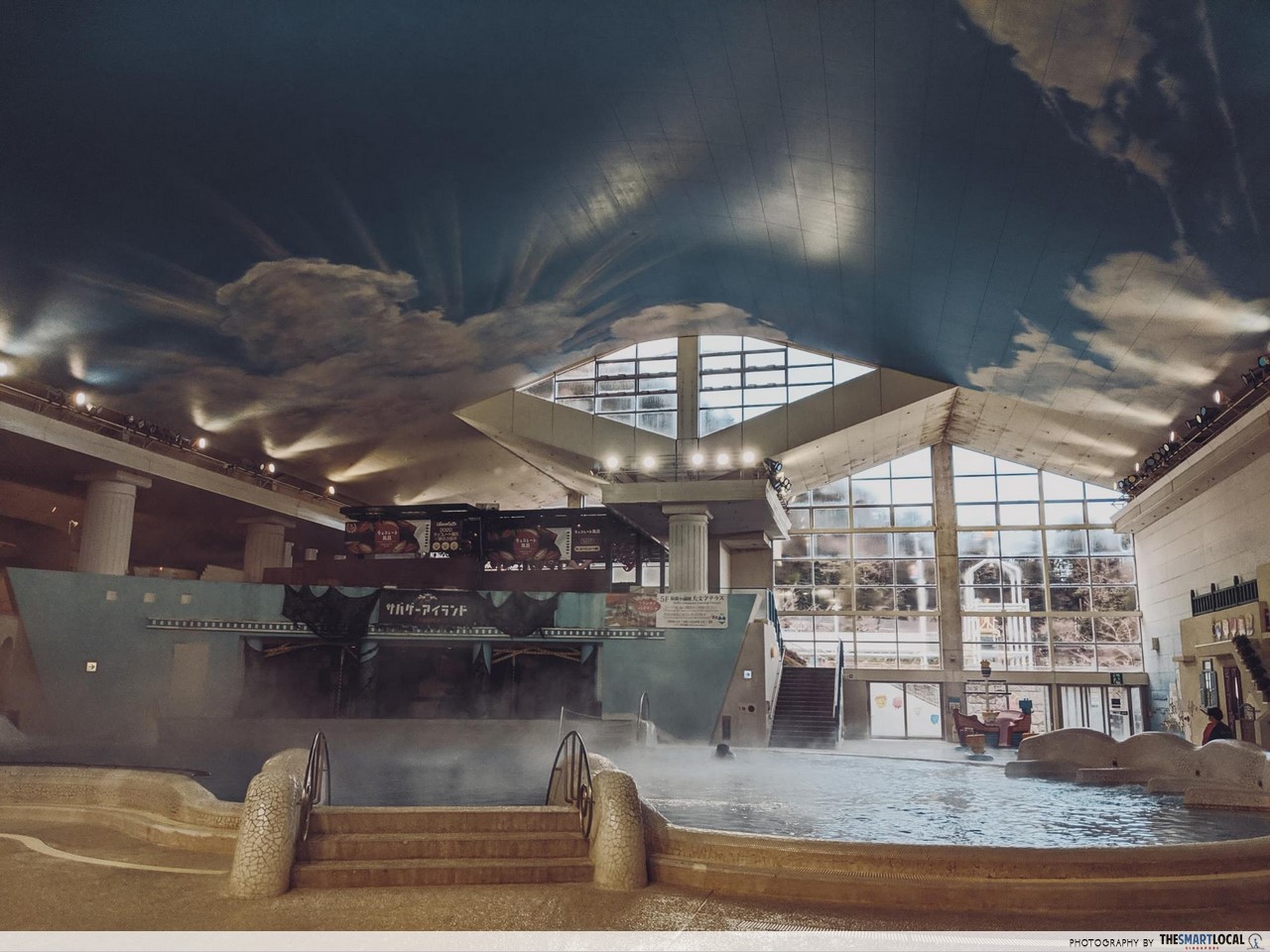
Hakone Kowakien Yunessun is an outdoor and indoor spa complex that looks a bit dated, but holds fond memories for many Japanese. The complex is divided into two areas, a Mori no Yu (no clothes) area and a Yunessun unisex area where everyone is in swimsuits.
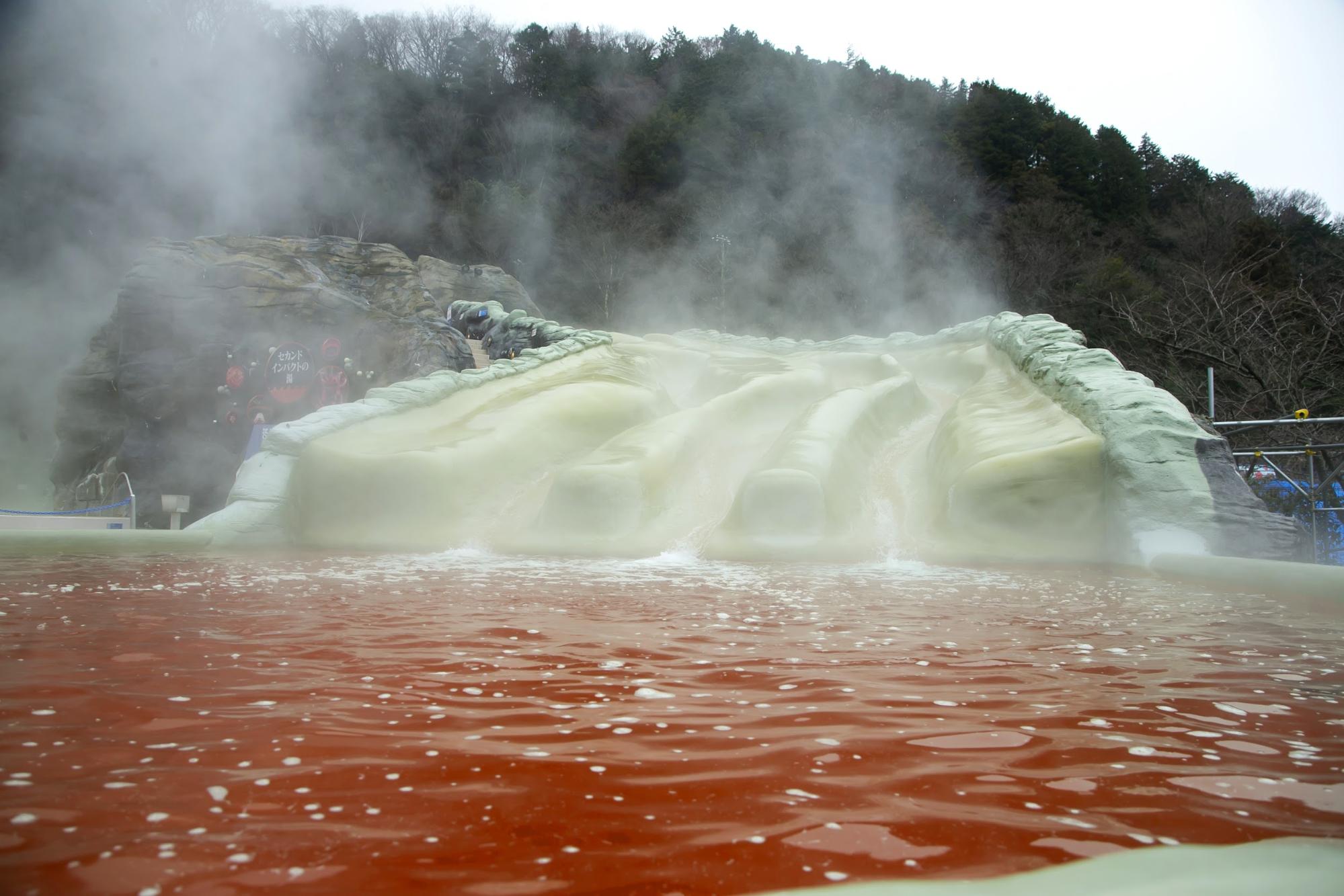
You’ll see groups of guys hanging out together and groups of girls mingling and it kinda feels like you’re at the start of a Japanese high school movie where the 2 leads meet each other.

What makes this spa interesting is its unique baths. There’s a wine bath, coffee bath, sake bath and performances every few hours where staff bring out actual wine and coffee and pour them into the baths. There’s also a foot spa area called Doctor Fish.
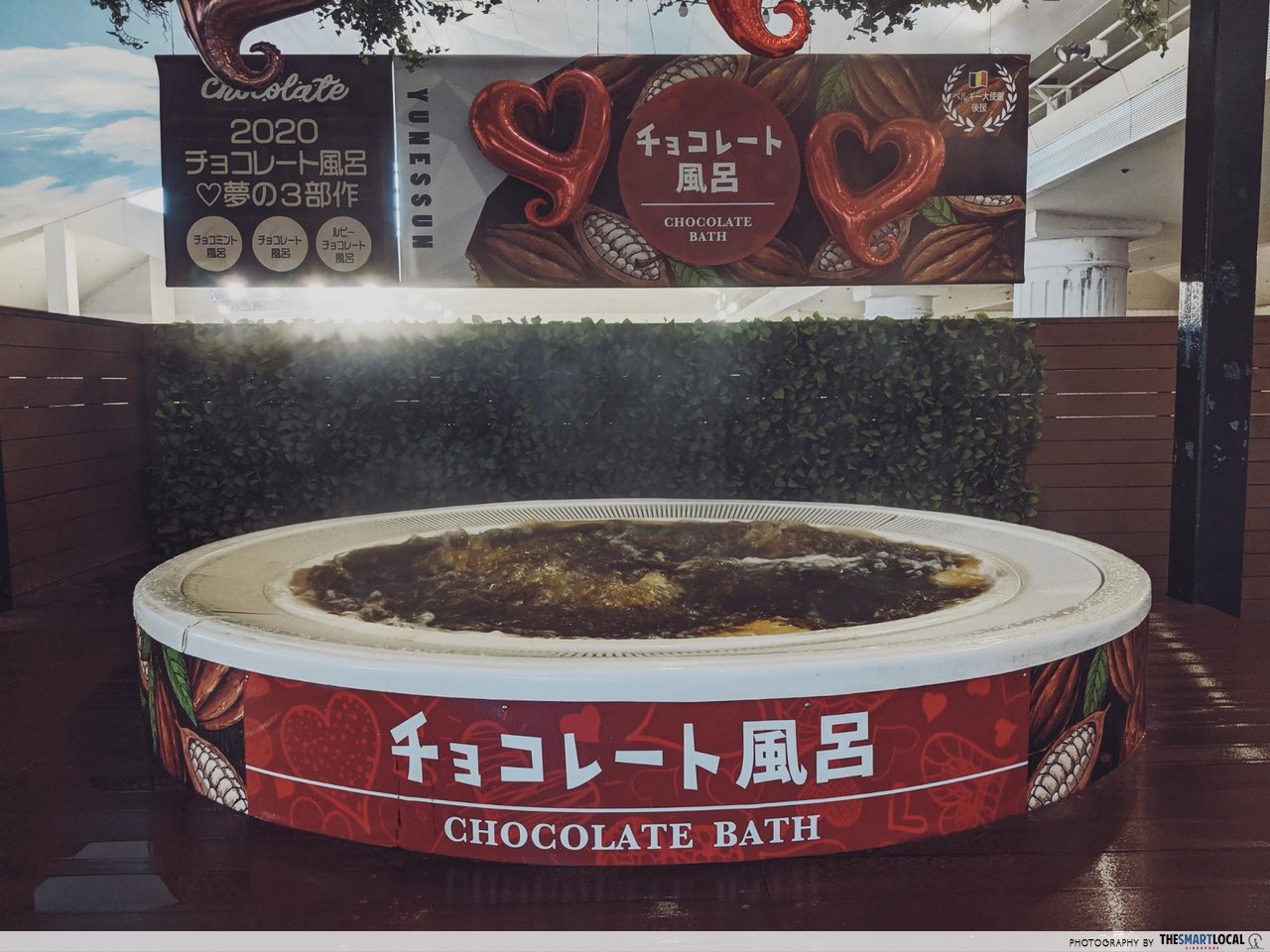
Address: 1297 Ninotaira, Hakone-machi, Ashigarashimo-gun, Kanagawa-ken 250-0407 Japan. There’s a free shuttle bus at Gora station. Price: Passport for both areas Adults: ¥3,500 (~S$45.19) or with the Hakone Freepass save ¥500 for adults and ¥300 for children Yunessun area only: Adults: ¥2,500 (~S$32.28) Mori no Yu area only: Adults: ¥1,500 (~S$19.37) Opening Hours : Varies – do refer to their website for more accurate opening hours.
10. Shop At Gotemba Premium Outlets
About 30 minutes away from the Gora area is Gotemba Premium Outlets, one of Japan’s most popular outlet malls. Located near Mount Fuji, you can shop at over 200 shops divided across the East and West Zone, separated by a photogenic bridge. It’s a very popular area among Chinese tourists.
The West Zone is located at the entrance where the shuttle buses alight, and here you can expect fashion brands like LongChamp, Burberry and Michael Kors.
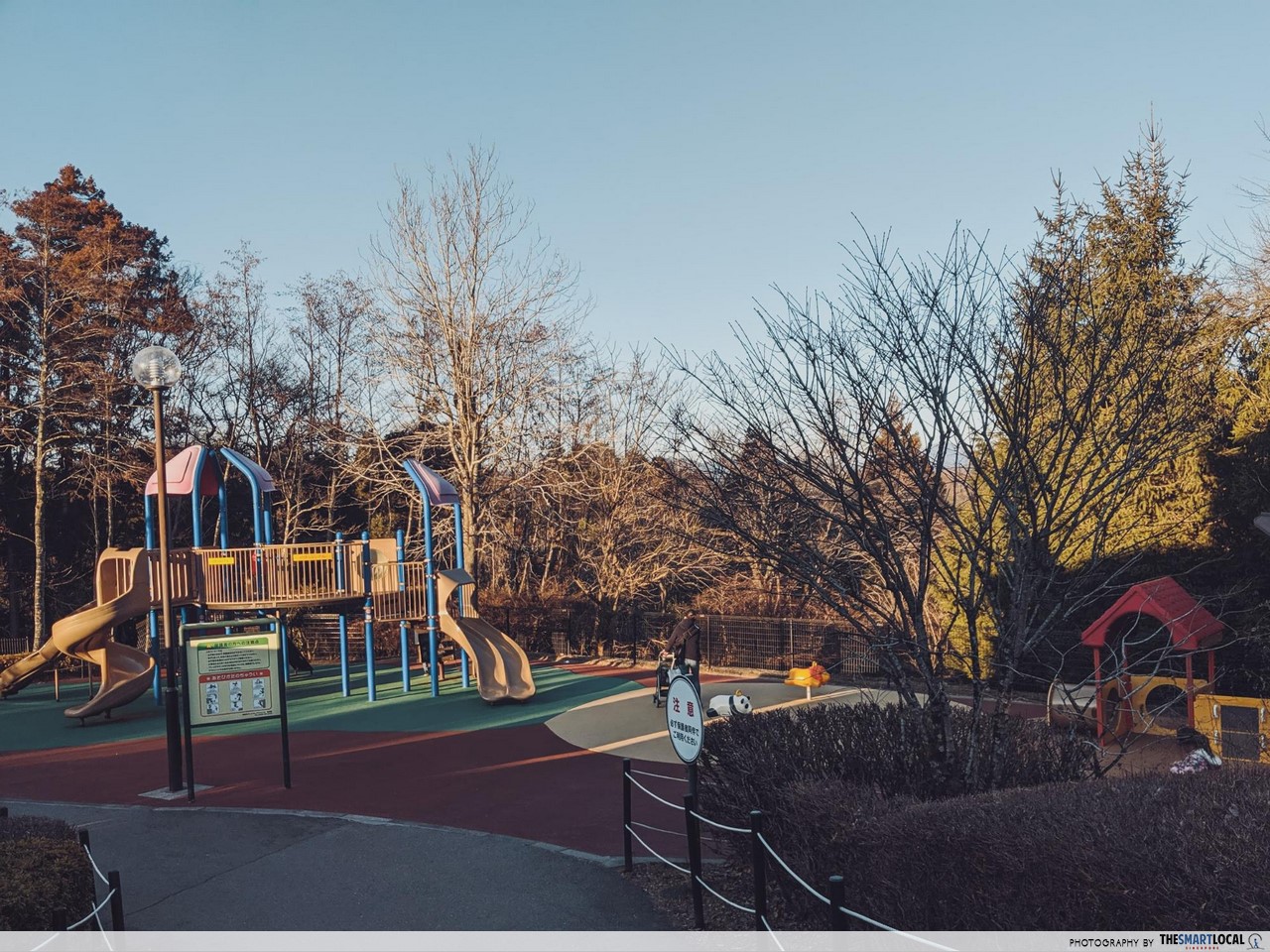
Look out near the bridge for a kids playground if you wish to deposit your little ones here before heading over to the East Zone. There, you’ll find brands like Nike, Polo Ralph Lauren and a Food Bazaar that even sells Singapore chicken rice!
The biggest discounts at outlet malls are usually from the fashion apparel from previous seasons. You can also visit the visitor centre and show them your passport to get tax free purchases at designated stores or scan certain discount QR codes.
In April 2020, a brand new Hillside zone is going to open up with another 88 stores. This new zone will also make Hotel Clad accessible by foot from the outlet area.
Address: 1312, Fukasawa Gotemba-Shi, Shizuoka, Japan 412-0023 Opening Hours : 10AM-8PM
Website | Map of shopping area | Directions
11. Stay at the aesthetic HOTEL CLAD
HOTEL CLAD is a spanking new hotel and the only one within walking distance from the Gotemba Premium outlets. Styled in Japanese modern aesthetics, you can think of the hotel as a more upmarket version of the Muji hotel. You can get amazing views of Mount Fuji from the restaurant, lobby and your hotel room on a non-misty day.

The onsen facilities at Konohana no Yu are worth mentioning. Apart from special private bathing rooms you can book, their facilities include 3 indoor onsen baths including a carbonic acid and cold onsen bath and 2 outdoor onsen baths with a view. There are also many resting areas and a massage area.
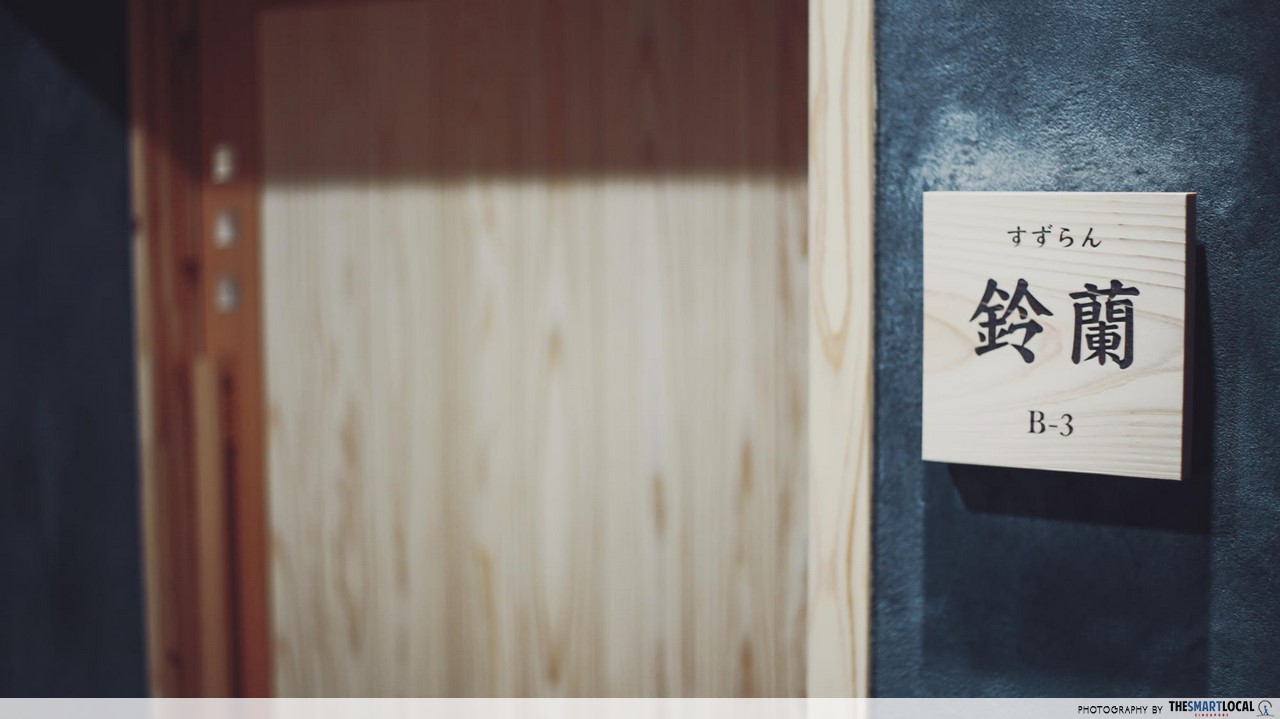
Address: 2839-1 Fukasawa, Gotemba City, Shizuoka Prefecture 412-00233
12. Find yourself at Choanji Temple
Choanji Temple isn’t one of the most convenient locations to get to, located 5KM between both Gotemba and Gora . It’s a Buddhist shrine that was founded in 1658, known for its gohyaku rakan – over 500 statues of disciples of Buddha. These statues are carved with unique facial expressions and some people come here to try and find a statue with a face that is similar to theirs.
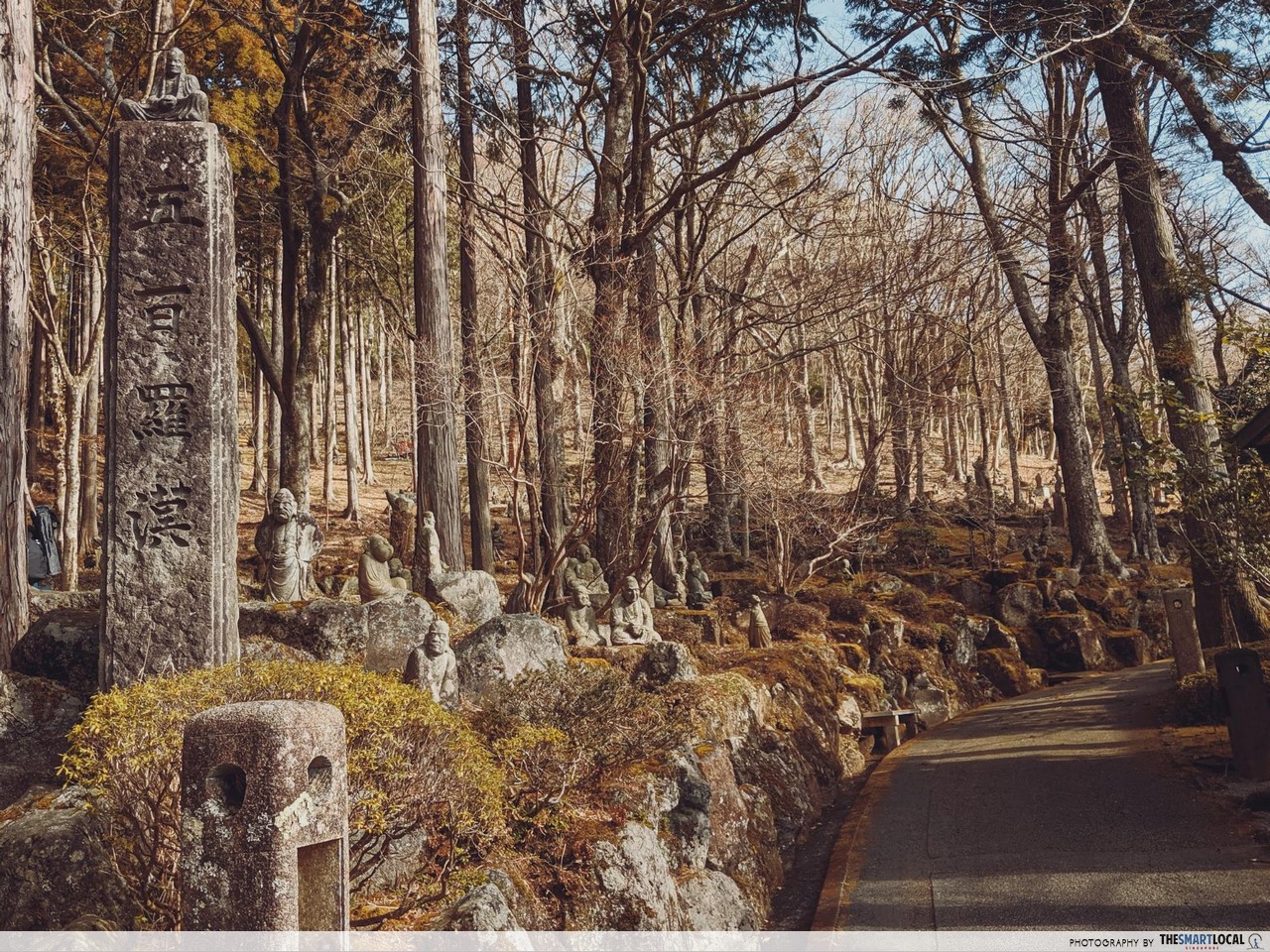
You can get here by buses covered under the Hakone Freepass and it’s a 25-minute-ride away from Hakone-Yumoto .
Address: 82 Sengokuhara, Hakone, Ashigarashimo District, Kanagawa 250-0631, Japan Directions : Ride the Hakone Tozan bus (Lines T and L) bound for Sengoku/Togendai from Hakone-Yumoto . Stop at the Sengoku (仙石) bus stop and walk for 1 minute.
Hakone is a town filled full of natural beauty that’ll have you falling more in love with Japan. It’s great for first-time inter-city travellers, who have never been out of Tokyo who want to explore a more scenic part of the country. Find out more about Hakone and the Hakone Freepass here .
Check out our other Japan guides:
- 8 non-touristy things to do in Tokyo
- 11 restaurants in Tokyo with affordable and satisfying meals under USD8
- How to navigate the Tokyo train system
- A guide to Shibuya Scramble Square – Tokyo’s newest attraction
- 11 authentic Japanese ramen places

Get more stories like this.
Drop us your email so you won't miss the latest news.


A Tokyo to Hakone Day Trip Itinerary (Hakone Round Course Loop)
By: Author Charles
Posted on October 25, 2023
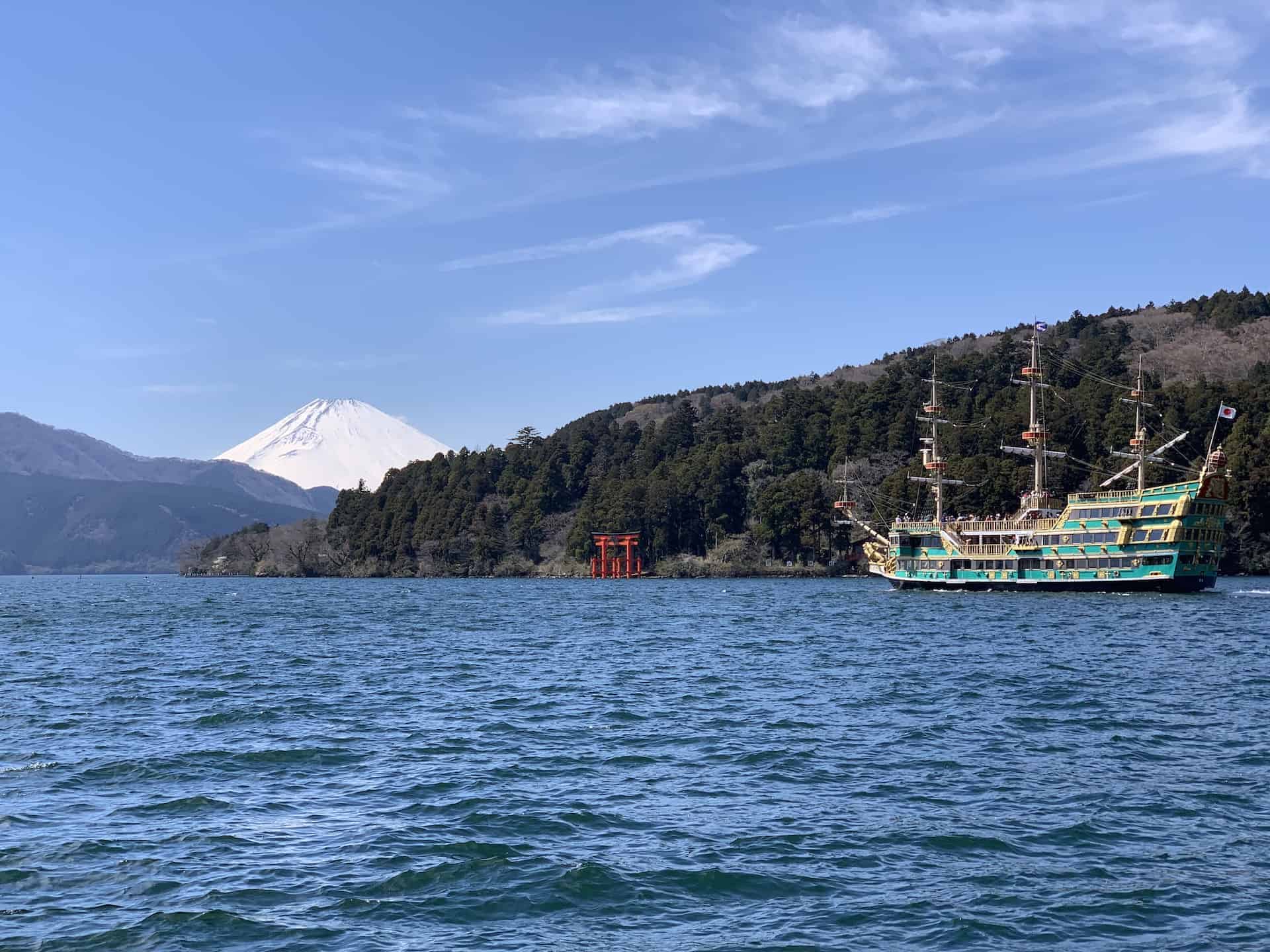
Just south of Tokyo, you will find Hakone – one of the most unique places to visit in Japan. A Hakone day trip will give you plenty to see and do as you explore all that it has to offer.
You will find beautiful views of Mt. Fuji, relaxing hot springs, and some incredible natural beauty. From the geothermal activity to the area down by Lake Ashi, Hakone is surely not to disappoint.
It is also home to the Hakone Round Course Loop – a series of several different transportation options to take you on a full circle around the Hakone area.
This guide will focus on everything you need to know when taking part of a Tokyo to Hakone day trip and the Hakone round course loop in particular.
By the end of reading through, you should have no trouble getting yourself on your way. With that said lets get into it!
* Affiliate Disclosure : This post may contain affiliate links, which means I may receive a commission if you make a purchase through the links provided, at no additional cost to you. Thanks for supporting the work I put into TripTins!
1) Tokyo to Hakone Day Trip Overview
Without a doubt, one of my favorite memories of Japan is the Tokyo to Hakone day trip.
If you are not familiar with Hakone, it is a town that is made famous due to its proximity to Mount Fuji. Throughout a day exploring Hakone, you will be able to take in views of Mount Fuji consistently from all different angles.
The Round Course Route
One of the most popular ways to go about the day trip is to take part of the Hakone Round Course. This loop route has you going on several different transportation types, as you get to see all that Hakone has to offer along the way.
A standard Hakone day trip will look something like this:
- Train : Tokyo to Odawara or Hakone Yumoto
- Hakone Tozan Railway : Odawara / Hakone Yumoto to Gora
- Hakone Tozan Cable Car : Gora to Sounzan
- Hakone Ropeway : Sounzan to Togendai (with stop in Owakudani)
- Lake Ashi Boat : Togendai to Hakone-machi or Moto-Hakone
- Hakone Tozan Bus : Moto-Hakone to Odawara or Hakone Yumoto
- Train : Odawara or Hakone Yumoto to Tokyo (or next destination)
Now, while a Hakone day trip is a popular option, staying overnight in Hakone is another way to about it. That way you can spend more time exploring and also take part of some relaxing Ryokans.
The Freepass
What makes a trip to Hakone so simple is that you can buy the Hakone Freepass, which will include all the transport for the day (starting in Odawara). There is also the option to include the round trip transport from Tokyo, when purchasing the pass (more on that next!).
The Highlights
Throughout a day of exploring Hakone, there will be many top highlights to look out for along the way. It is not just taking the various transportation that make this day trip so unique, but rather what you will see & experience. Some of these highlights include:
- Exploring Gora
- First Views of Mt Fuji from the Ropeway
- Owakudani Volcanic Valley
- Trying Some Black Eggs
- Cruising Lake Ashi
- Onshi Hakone Koen Park
- Hakone Shrine
- And Plenty of Mt Fuji Views Along the Way!
Here are just a few essentials to think about when going about the day trip:
- Duration : 6 – 8 hours to fully enjoy the experience (starting in Odawara)
- Cost (with JR Pass) : 5,000 JPY
- Cost (without JR Pass) : 6,100 JPY (includes round trip from Tokyo)
- Weather : Mount Fuji Forecast
- Guided Option : Hakone Tour
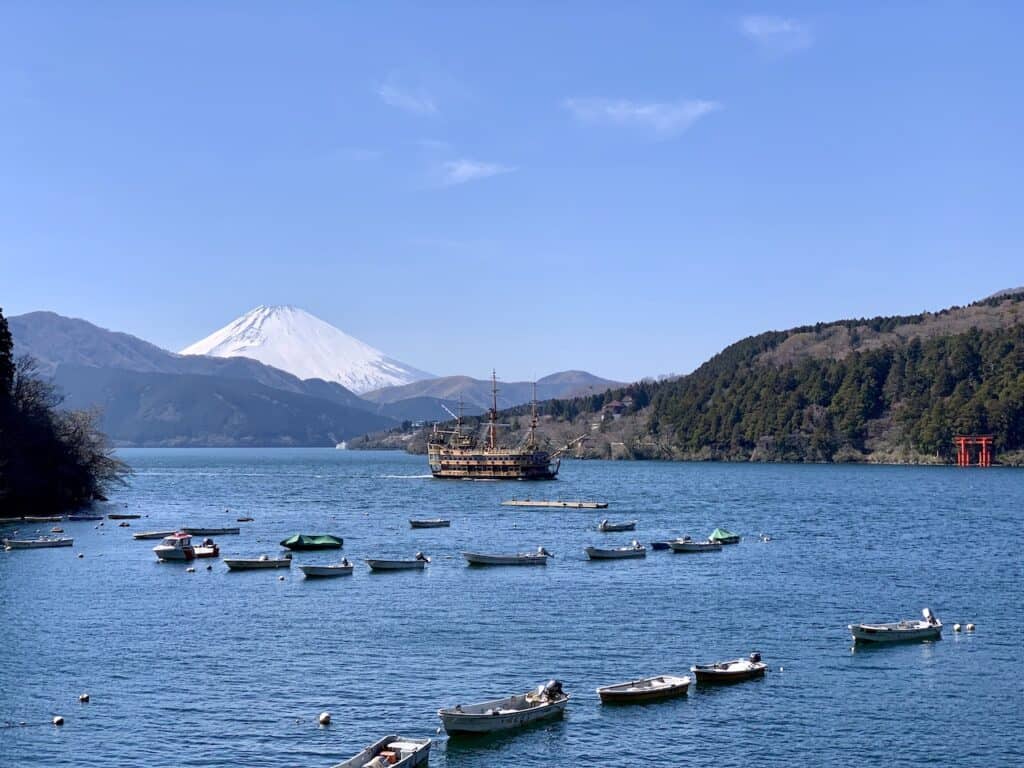
2) Hakone Freepass
I want to start off talking about the Hakone Freepass as that is what you will be using as you make your way around Hakone.
Basically in the Hakone area there are many different transportation options available such as trains, cable cars, ropeways, boats, busses, and more – these in essence make up the Round Course Loop.
The Freepass gives you access to all of these by just showing your pass. No need to purchase separate tickets every time for each mode of transportation. Simply show your pass and be on your way.
It also gives you discounted or free access to many museums, parks and different sites around Hakone, making it a very cost-efficient option for those that will be touring around.
At the end of the day, even if just taking part of the Round Course Loop you will still be saving money (plus the convenience factor) vs. purchasing individual tickets for each mode of transportation around Hakone.
Hakone Freepass Options
There are a two main options when it comes to purchasing the Hakone Freepass:
- 2 Day Hakone Freepass (Starting in Odawara) : the cost for a Freepass is 5,000 JPY for a 2 day pass. Even if just doing a day trip, the 2 day pass is worth the cost (and there is no 1 day pass option). This is recommended if you have the JR Pass (as the JR Pass will already cover free transport to Odawara).
- 2 Day Hakone Freepass (including Round Trip from Tokyo) : If you are coming from Tokyo and doing the day trip (or an overnight and going back to Tokyo after) you can pay 6,100 JPY for the 2 day pass. This gives you the round trip train on Odakyu Railway from Shinjuku Station to Odawara Station.
Romancecar Add On from Tokyo : there is an option to pay an additional fee to upgrade your Odakyu Railway ticket on the Romancecar (+1,150 JPY one way or +2,300 JPY round trip). The Romancecar takes you directly to Hakone-Yumoto (instead of Odawara) in just 75 minutes.
Purchasing the Hakone Freepass
There are a few different ways to purchase the Hakone Freepass for your trip:
- Purchase the Hakone Freepass online (Odakyu)
- Purchase in Person (Shinjuku or Odawara Stations)
You can upgrade to the Romancecar by purchasing a seat reservation online or buying at the Shinjuku train station from Odakyu Railway.
Once you are in Odawara (or Hakone-Yumoto if you took the Romancecar), you will be able to use the Freepass on a bunch of different types of transportation around the round course loop.
Note: there are also 3 day passes available for those who are not planning on doing the day trip, but rather staying a few days in the Hakone area.
3) Hakone Logistics
Before getting into the Hakone Round Course Loop, we first need to get you there. To take part of the Tokyo to Hakone day trip, you will need to utilize the super-efficient train system that Japan offers.
And with that said, there are a few different options to choose from depending on whether or not you have a JR Pass handy.
After departing Tokyo, the first part of the Hakone Round Course Loop journey will start in Odawara and then onto the Hakone-Yumoto station.
This section will focus on the round trip options from Tokyo. In the following section, I will talk more about a one way option (either continuing onto another destination at day’s end or staying overnight).
Here are your options for getting to Odawara / Hakone-Yumoto:
With JR Pass
Getting to Hakone is pretty straightforward if you have a JR Pass. There are trains leaving from Tokyo Station to Odawara and can be as fast as just 35 minutes (with local trains taking closer to 90 minutes).
To get on these faster trains, take a look at the Tokaido Shinkansen on the Kodama or Hikari lines. The timetables can be found on the Hyperdia website (departure Tokyo / arrival Odawara).
Once you arrive in Odawara you can purchase the Hakone Freepass for 5,000 JPY (or purchase online ahead of time).
After you arrive in Odawara and purchase the Freepass, you can then hop on the quick 15 minute local train up to Hakone-Yumoto to start the round course.
Learn More : For more about the JR Pass, check out the Japan helpful tips section
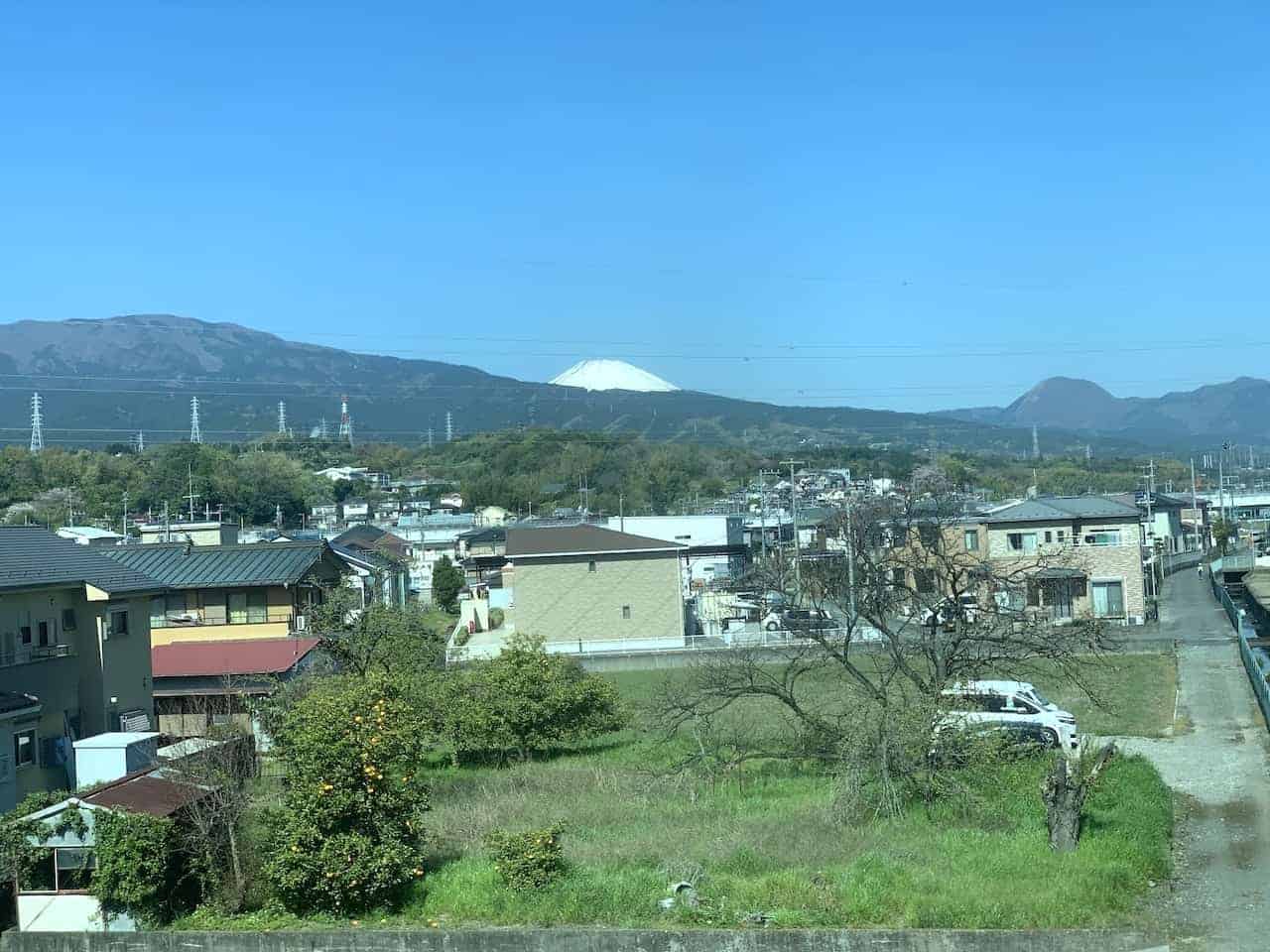
Without JR Pass
Now if you do not have a JR Pass and want to take part of the Hakone Round Course day trip from Tokyo, you can choose from three main options.
Note that all the prices reflect round trip costs including the Hakone Freepass .
1. Hakone Freepass + Shinjuku to Odawara (Odakyu Line) : Purchase a Hakone Freepass for 6,100 JPY, which includes a round trip from Shinjuku Station on the Odakyu line (~90 minutes). This price not only will include your round trip from Tokyo to Odawara, but also includes the unlimited use of transportation in Hakone. Total Cost: 6,100 JPY
2. Hakone Freepass + Shinjuku to Hakone-Yumoto (Odakyu Line) + Romancecar Add On : You also have the option here to upgrade and reserve a seat on the faster Romancecar (75 minutes) for an additional +1,150 JPY one way (+2,300 JPY round trip). This will take you straight to Hakone-Yumoto Station (about 15 further along than Odawara), where you can start the round course journey. Total Cost: 8,400 JPY
3. JR Train from Tokyo to Odawara : Even if you do not have a JR Pass you can still opt to take the fast JR train (35 minutes) to Odawara. This will cost 3,810 JPY one way (7,620 JPY round trip) and leaves from Tokyo Station (not Shinjuku). Total Cost: 12,620 JPY
Options 1/2 make most sense from a cost perspective but if you either want to get there/back as quickly as possible or want to leave from Tokyo station instead of Shinjuku, option 3 could work as well.
Tip : if you opt for the Odakyu line from Shinjuku to Odawara (not the Romancecar) be prepared to stand or have somewhat of a crowded train as this is a commuter train. If you want the peace and quiet, along with a nice reserved seat then opt in for the Romancecar.
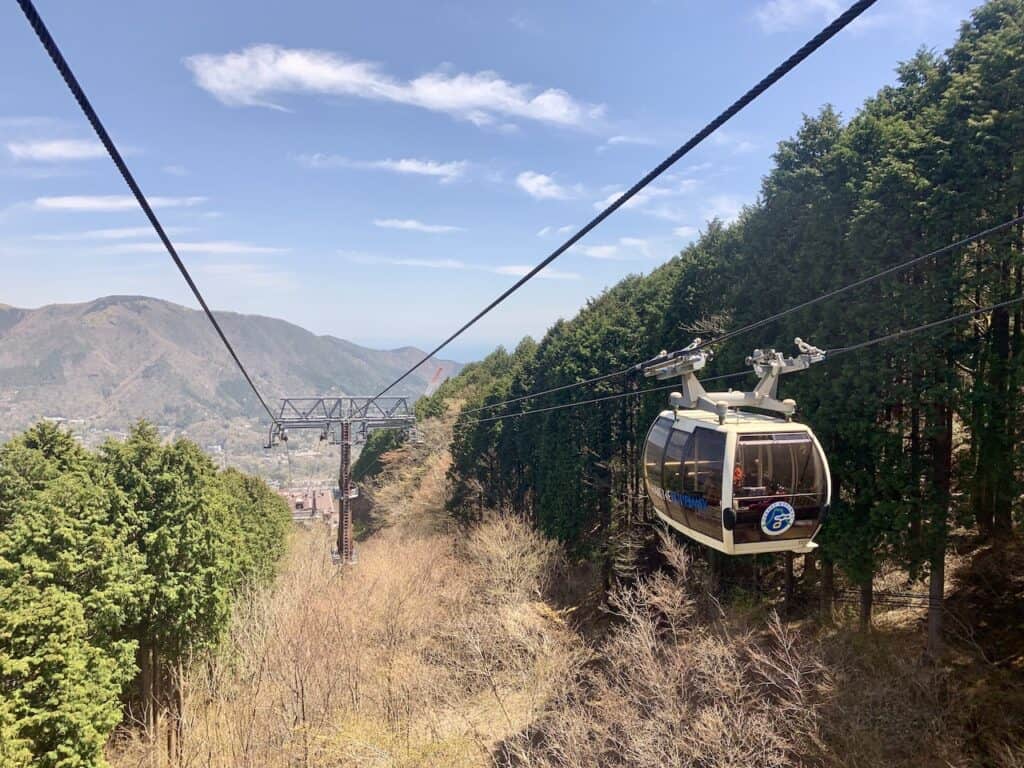
4) Hakone Overnight or Pit Stop
If you ARE NOT going back to Tokyo at the end of the day, you may need to re-think your options. Instead of going for the round trip, you can also continue on to your next destination or stay overnight in Hakone.
Below are some options to consider (many of which are similar to above). You will just need to add 5,000 JPY (for the Freepass) to the train cost.
With the JR Pass : simply take the 35 minute fast train from Tokyo Station to Odawara.
Without the JR Pass : If you do not have the JR Pass you can choose from the following options –
- Shinjuku to Odawara (Odakyu Line) : One way ticket from Shinjuku Station on the local Odakyu line to Odawara for 910 JPY one way (90 minutes)
- Shinjuku to Hakone-Yumoto (Odakyu Line) + Romancecar : Option to upgrade to the Romancecar straight from Shinjuku to Hakone-Yumoto, for a +1,150 JPY surcharge (2,060 JPY total)
- JR Train : JR fast train from Tokyo Station to Odawara for 3,810 JPY (35 minutes)
Once you arrive in Odawara you can then purchase the Hakone Freepass (5,000 JPY). If taking the Romancecar, you should buy the Freepass at the same time of the Romancecar purchase .
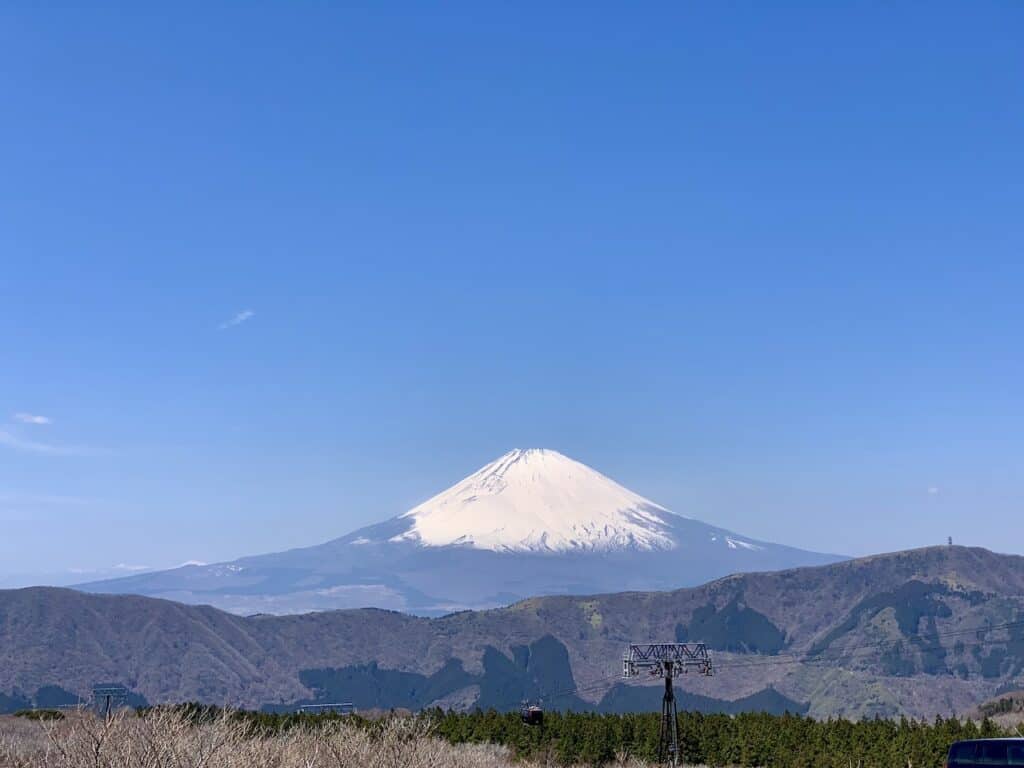
5) Where to Stay in Tokyo / Hakone
There are many different areas to choose from when deciding where to stay in Tokyo. I would recommend staying in or near Shinjuku, which is a great place for nightlife, restaurants, transportation and more!
- Hotel Gracery Shinjuku
- Citadines Central Shinjuku
- Hyatt Regency Tokyo
If you are staying the night near Hakone, here are a few highly rated accommodation options to choose from.
- Laforet Club Hakone Gora Yunosumika
- Yutorelo-an
- Hakone Yutowa
- Hakone Ashinoko Hanaori
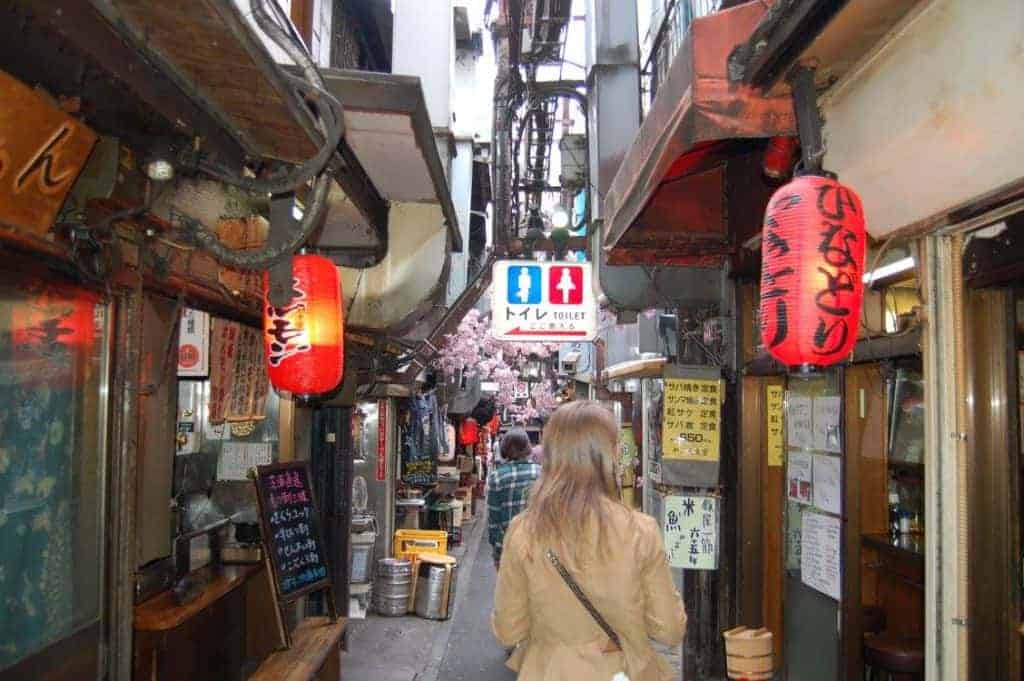
6) Hakone Day Trip Map
See below for a map of the round course with the color coded modes of transportation. These will make up the main route as you go about your Hakone day trip:
- (1) Hakone Tozan Railway from Odawara/Hakone Yumoto to Gora
- (2) Hakone Tozan Cablecar from Gora to Sounzan
- (3) Hakone Ropeway from Sounzan to Togendai (w/ a stop in Owakudani)
- (4) Hakone Boat Tour from Togendai to Hakone-machi or Moto-Hakone
- (5) Hakone Tozan Bus back to Hakone Yumoto or Odawara (if going back to Tokyo) or Gora (if staying overnight)
Note : if staying overnight in Gora, check into your hotel and drop your stuff off before getting on the cable car (2).
7) Hakone Day Trip Tours
While doing the Hakone Round Course on your own is certainly possible, taking part of a tour is another way to go about the day. Now, these tours may not follow the exact circuit as they can leverage their own private transport along the way to save some time.
However, joining a tour can remove any logistical issues and take care of you from beginning to end. Here are some potential options to consider when it comes to Hakone tours:
- Mount Fuji Full-Day Tour and Hakone Cruise
- Mt. Fuji, Hakone, Lake Ashi Cruise and Bullet Train
- Guided Day Trip to Hakone, Owakudani & Mt. Fuji
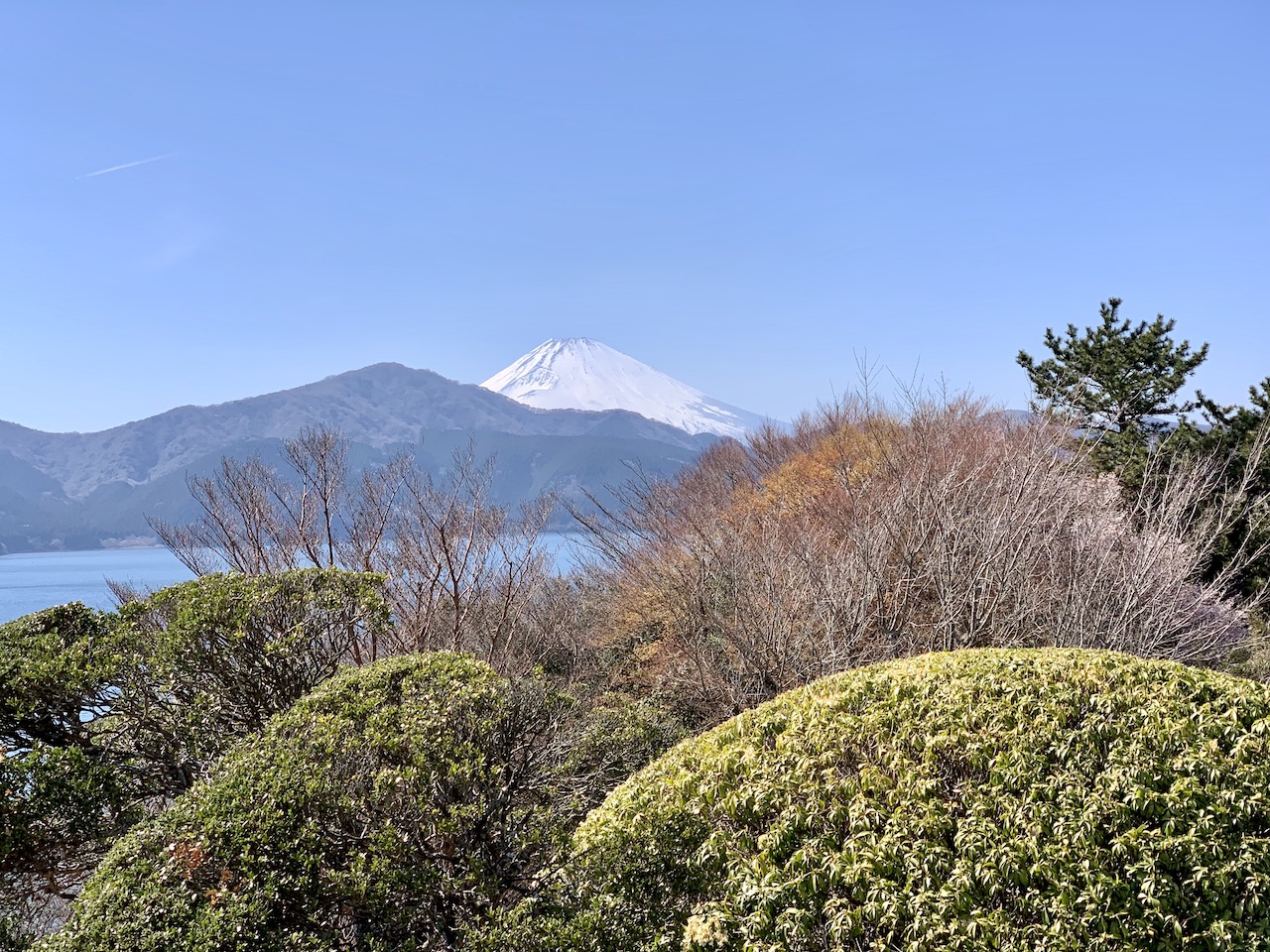
8) Hakone Round Course Loop
I will now walk you through each mode of transportation used and what to expect as you make your way around the area. For the most part everything is pretty simple to follow and you should not have much trouble getting from one place to the next.
The whole loop starting and ending in Odawara should take anywhere from 6-8 hours depending on how long you plan on staying in each place. It could take even shorter but at that point you may feel too rushed.
(A) Hakone Tozan Railway from Odawara/Hakone Yumoto to Gora
If you did not opt for the Romancecar, your journey will begin in Odawara.
Once you arrive in Odawara and purchase the Freepass (if you have not done so already), you will hop on the quick 15 minute train ride to Hakone Yumoto. Once in Hakone Yumoto you will need to get on another train that takes you up to Gora.
This section will take about 40 minutes as the train zig zags its way up the mountain.
Since it is quite an incline for a train, there will be a few switchbacks, where the train will switch directions – as in the front of the train will become the back of the train and vice versa.
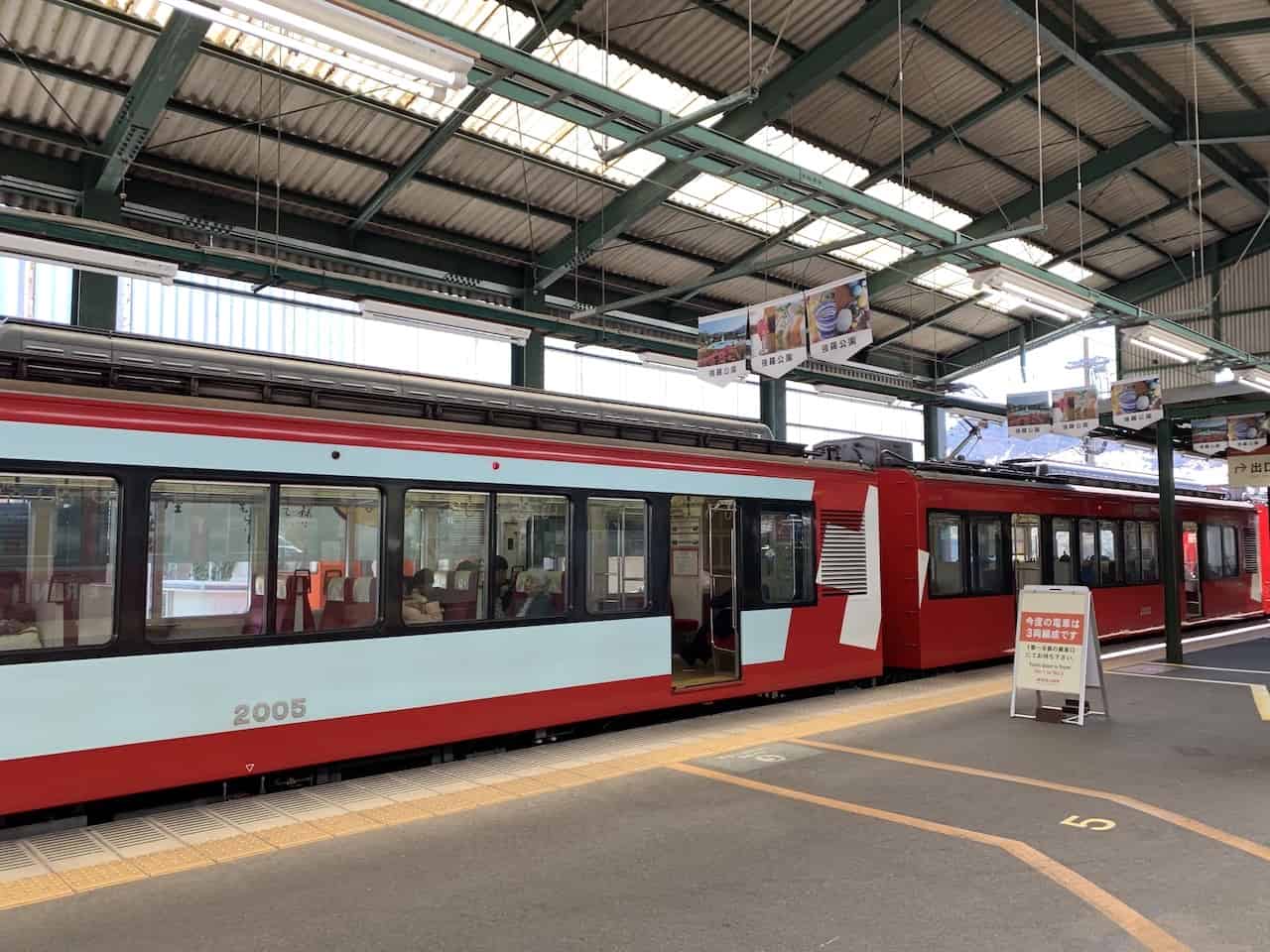
Once the 40 minute journey is complete you will arrive in the town of Gora. If staying the night in Hakone, Gora is one of the more popular options to choose from and you will have plenty of onsens in the area to decide between.
You can drop your luggage at your hotel before continuing on with your day.
Even if you are not staying overnight I would still advise to take a walk around town and head to Gora Park . If you are there during cherry blossom time you will have some great flower photos to take!
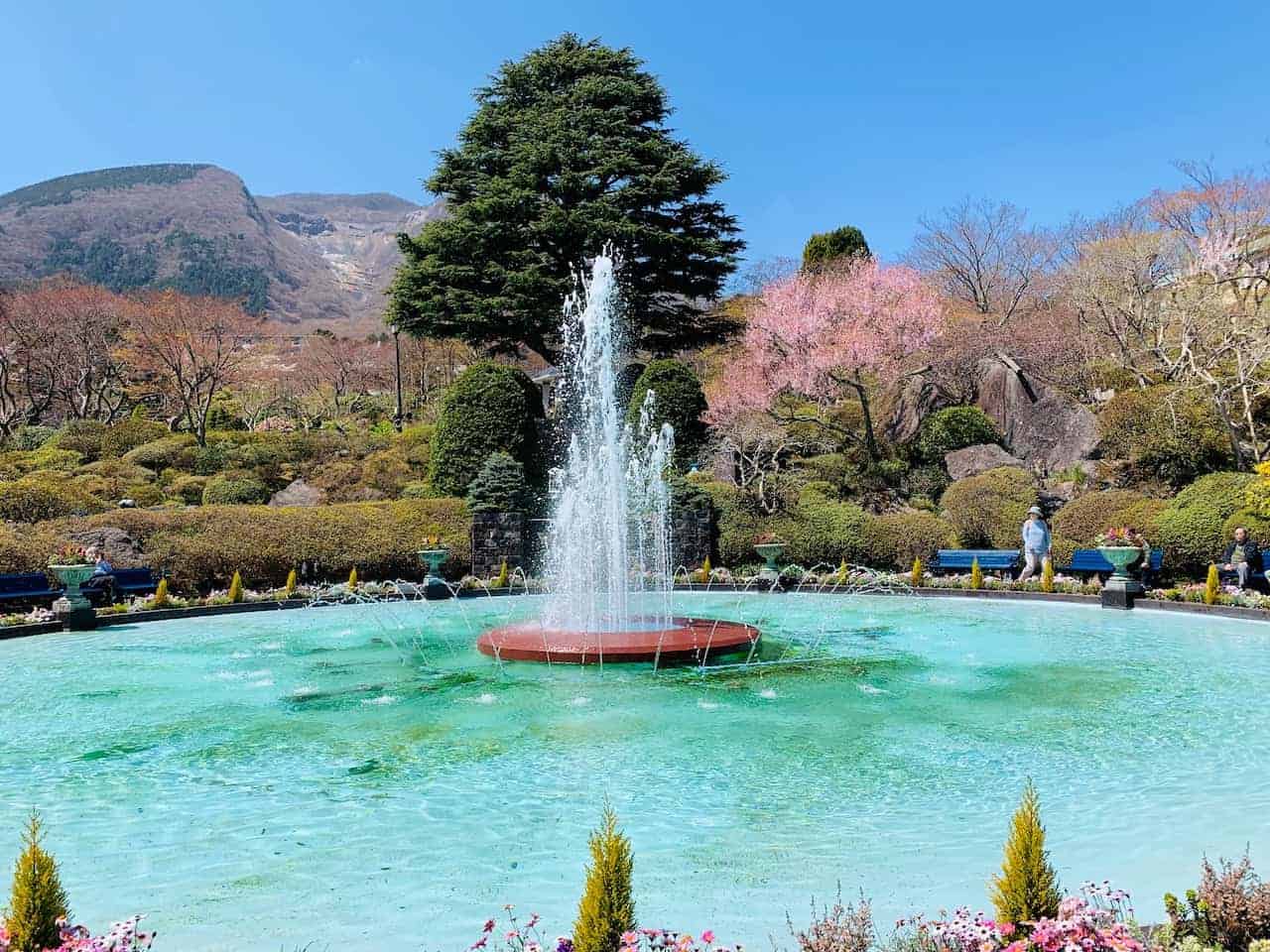
(B) Hakone Tozan Cable Car from Gora to Sounzan
Next up on the round course loop is the quick cable car from Gora to Sounzan .
The cable car is about 10 minutes long and it will make a few stops before arriving at the final destination of Sounzan.
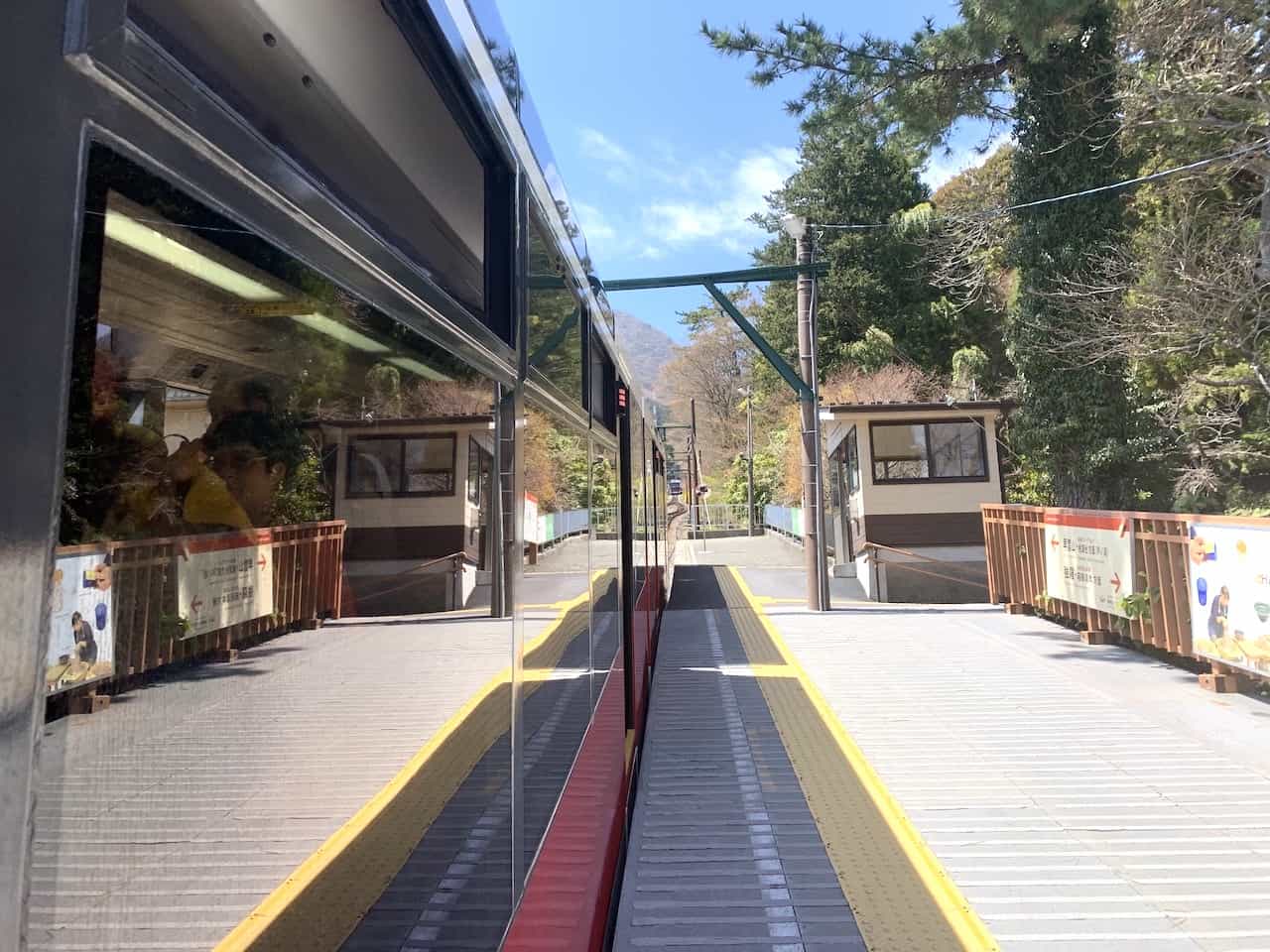
(C) Hakone Ropeway from Sounzan to Togendai (w/ a stop in Owakudani)
After getting off the cable car it is time to hop on the Hakone Ropeway.
The ropeway is made up of two parts – one from Sounzan to Owakudani and the next from Owakudani to Togendai .
Note that you must get off the cable car and switch in Owakudani. Both of these portions should take about 10 minutes each.
The ropeway is much more than a simple ropeway though. About half way up to Owakudani, you will be welcomed to the one and only Mount Fuji out in the near distance. And believe me, it is quite the site seeing Fuji appear so close for the first time.
Soon enough you will also be hovering over the geothermal area of Owakudani with plenty of sulfur gasses coming out from the ground.
The ropeway coupled with Mount Fuji and the geothermal area is one of the most unique experiences I had during my time in Japan.
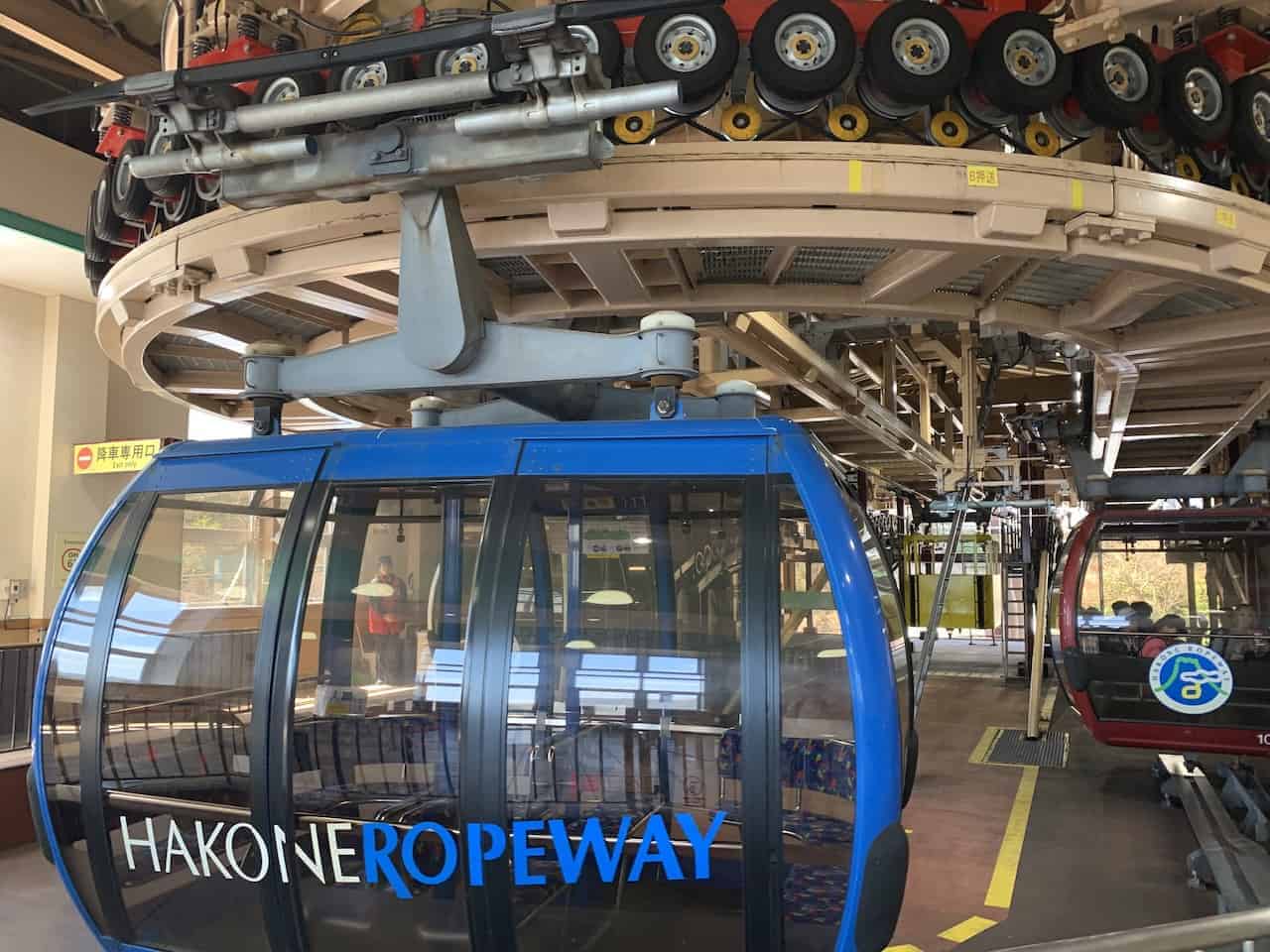
After the 10 minute cable car and taking in some views from above you will arrive in Owakudani. This is the perfect spot to get all sorts of pictures of Mount Fuji (this will be the closest you get during the round course loop) and the geothermal area down below.
On top of those views I would also recommend getting some lunch here as there are a couple restaurant options.
And finally don’t forget to buy some of those famous black eggs that are boiled in the nearby water – legend has it that eating these eggs can add 5+ years to your lifespan, so why not give one of them a try.
Don’t worry though, the eggs themselves don’t taste any different from regular eggs, just the shell is black. A pack of 5 costs 500 JPY at the nearby stand.
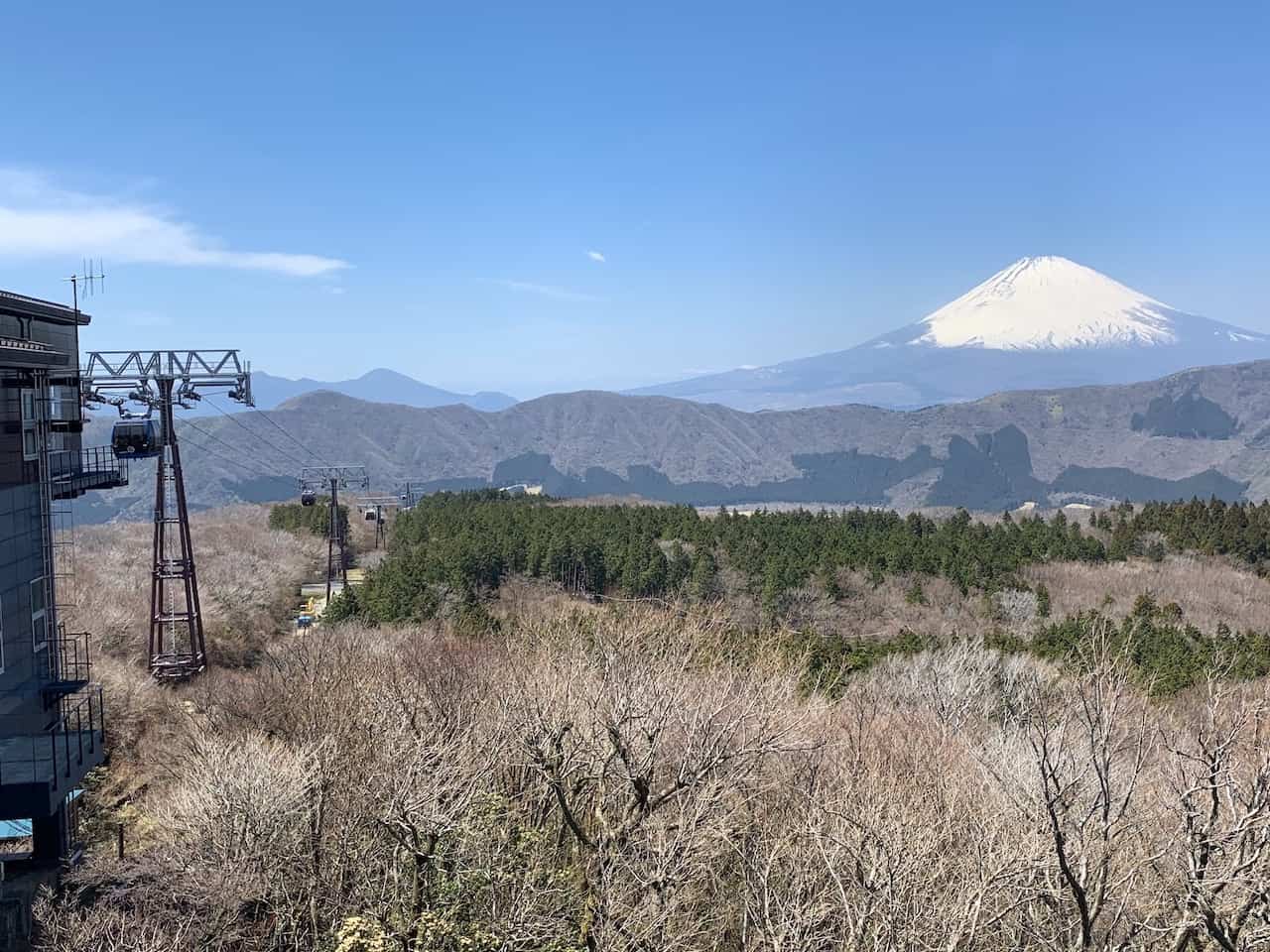
After taking some pics of Mount Fuji and the geothermal area, having some lunch, and trying those black eggs, it is time to hop back on the cable car and down to Togendai.
During this portion of the ropeway you should be able to see Mount Fuji for the majority of the ride – sit on the front right side of the ropeway for the best pics! You have the option to get off at Ubako or just continue along to Togendai.
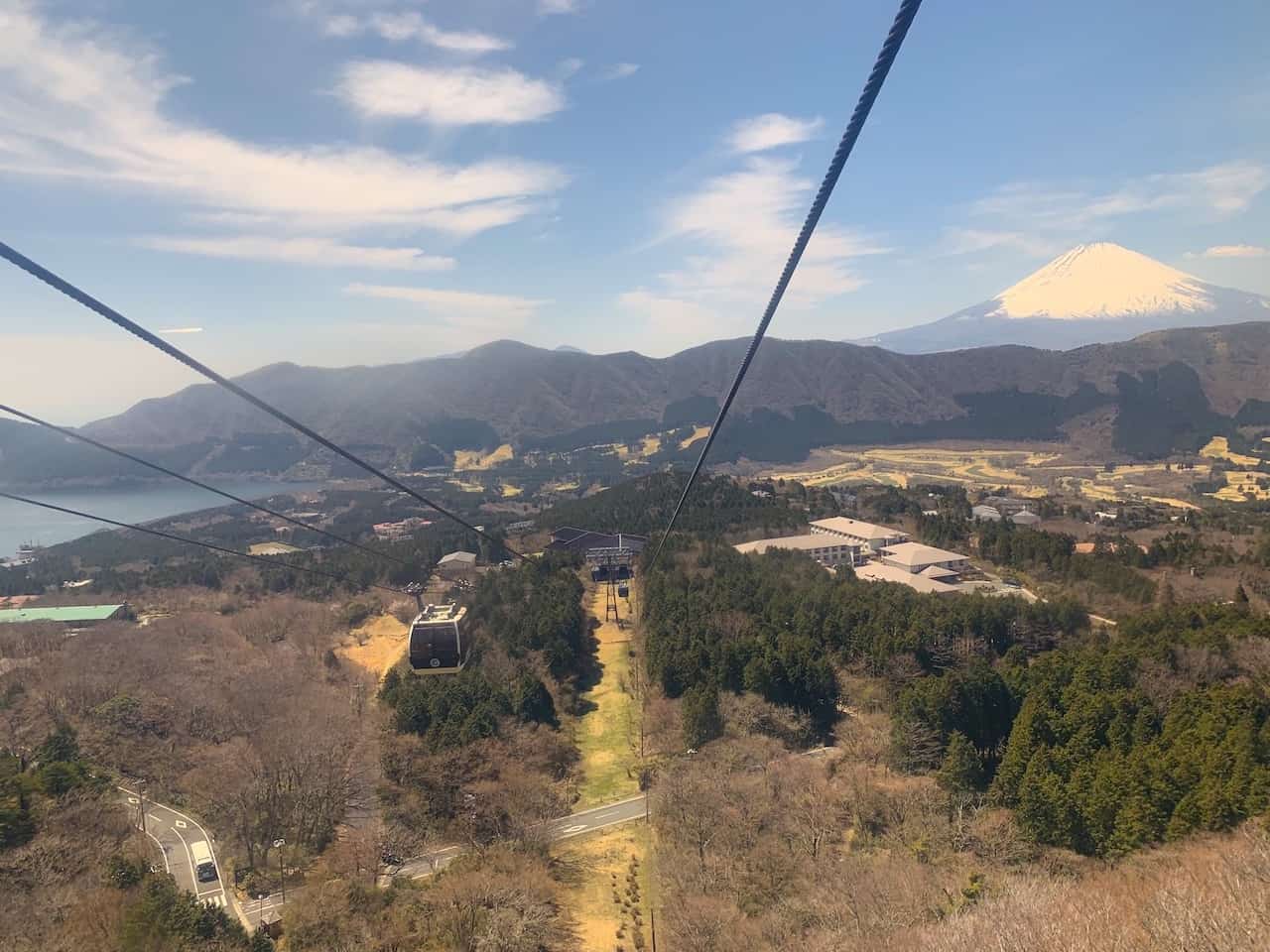
(D) Lake Ashi Boat from Togendai to Hakone-Machi or Moto-Hakone
Lake Ashi will be your next stop on the Hakone round course loop as you board a “pirate ship” at Togendai to the opposite side of the lake to Hakone-machi or Moto-Hakone.
This 40 minute ride will take you through Lake Ashi’s waters and as you get further along the route, Mount Fuji will come back into view – this time a bit further away but just as beautiful.
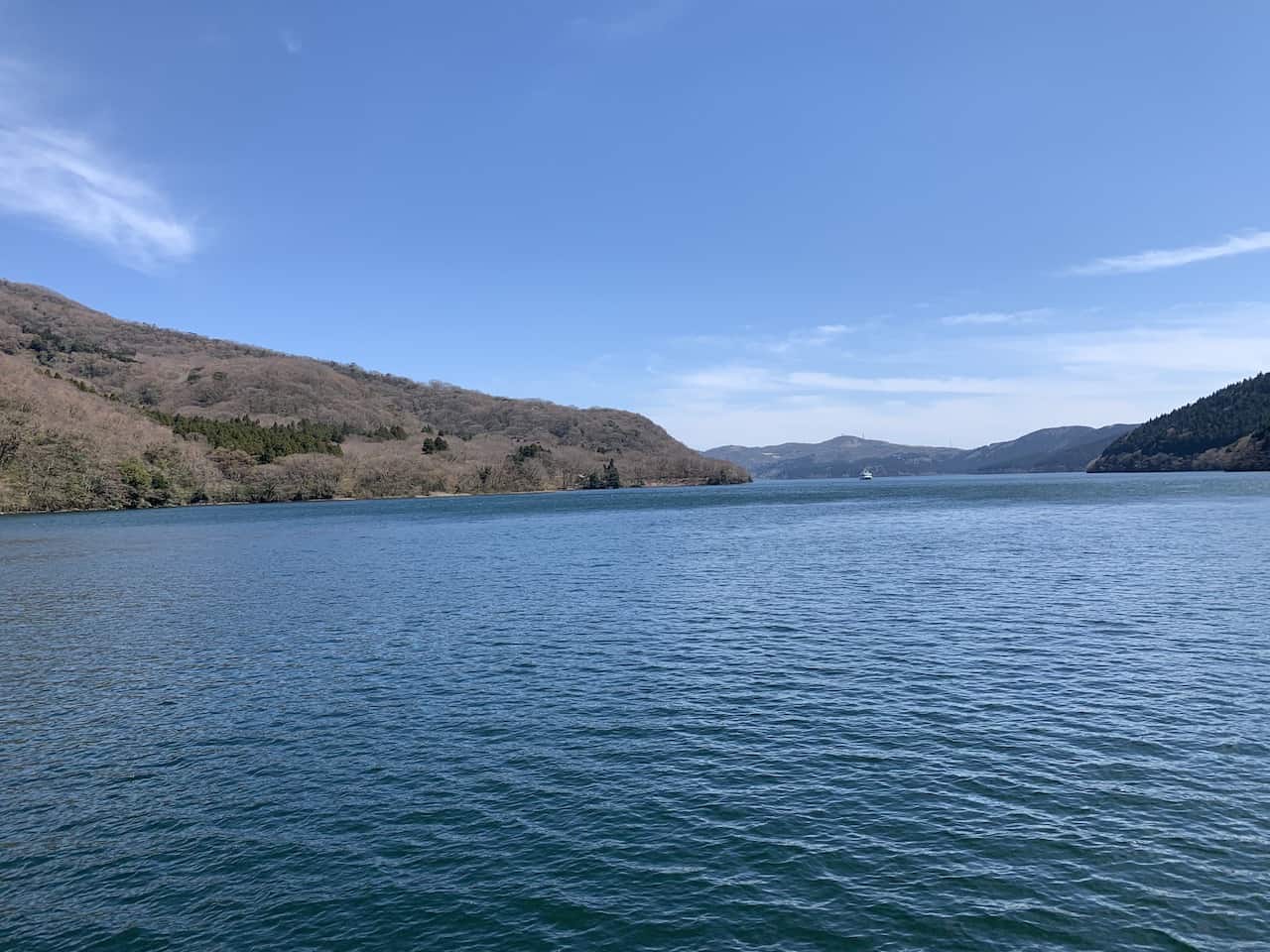
You have two options to choose from when it comes to getting off the boat – either Hakone-machi or Moto-Hakone.
Hakone-machi Port
If you get off at the first stop Hakone-machi, you can make the nice walk towards Onshi Hakone Koen Park. From the park you can get some great views of Mount Fuji at a higher vantage point.
You can then continue the walk out of the park and along the water, passing the Moto-Hakone port area (where you can get some great shots of Fuji and the Hakone Shrine Torii gate) and on to the Hakone Shrine itself, before returning to Moto-Hakone to catch the bus back.
Moto-Hakone Port
There are a couple reasons I see to get off at the second port (Moto-Hakone).
If you want to capture the shot of the Mount Fuji with the Hakone Shrine Torii gate from the boat, you can only take that picture if you get off at Moto-Hakone. You can however, capture a very similar picture by the shore near Moto-Hakone.
A second reason to get off here is if you have no interest in heading to the Onshi Hakone Koen Park. The second port is closer to the Hakone Shrine area, so you will basically skip the park and just make the short walk over to the shrine before heading back to the port bus stop.
If you zoom into the map I inputted earlier on in the article, you can see where the ports, the park, and the shrine are located.
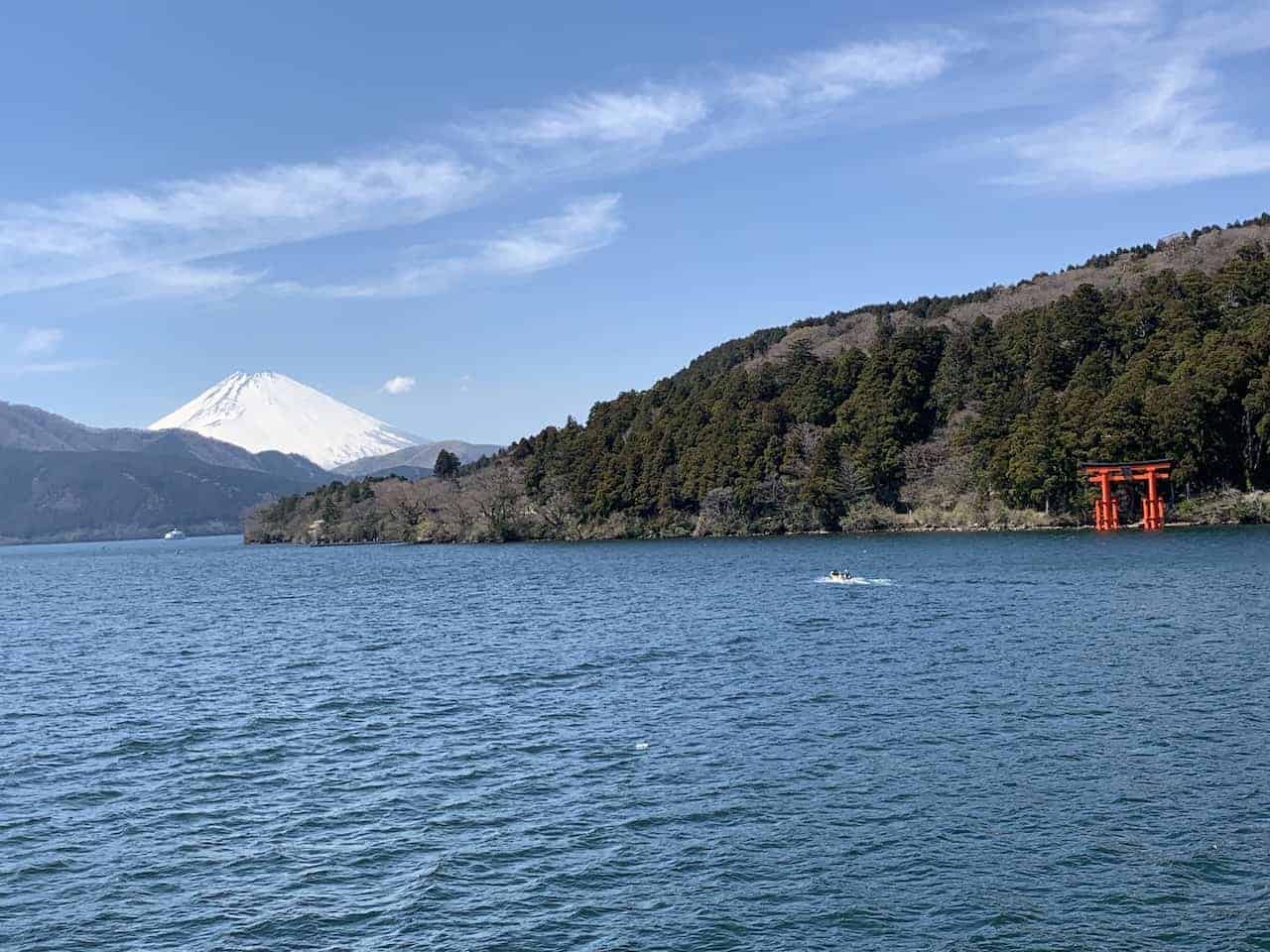
(E) Onshi Hakone Koen Park
As just mentioned, once you get off the boat you have the chance to head up to Onshi Hakone Koen Park .
It is basically right in the middle of the two ports and it gives some great vantage points of Lake Ashi and Mount Fuji from above. There are a few steps to get up there just a heads up!
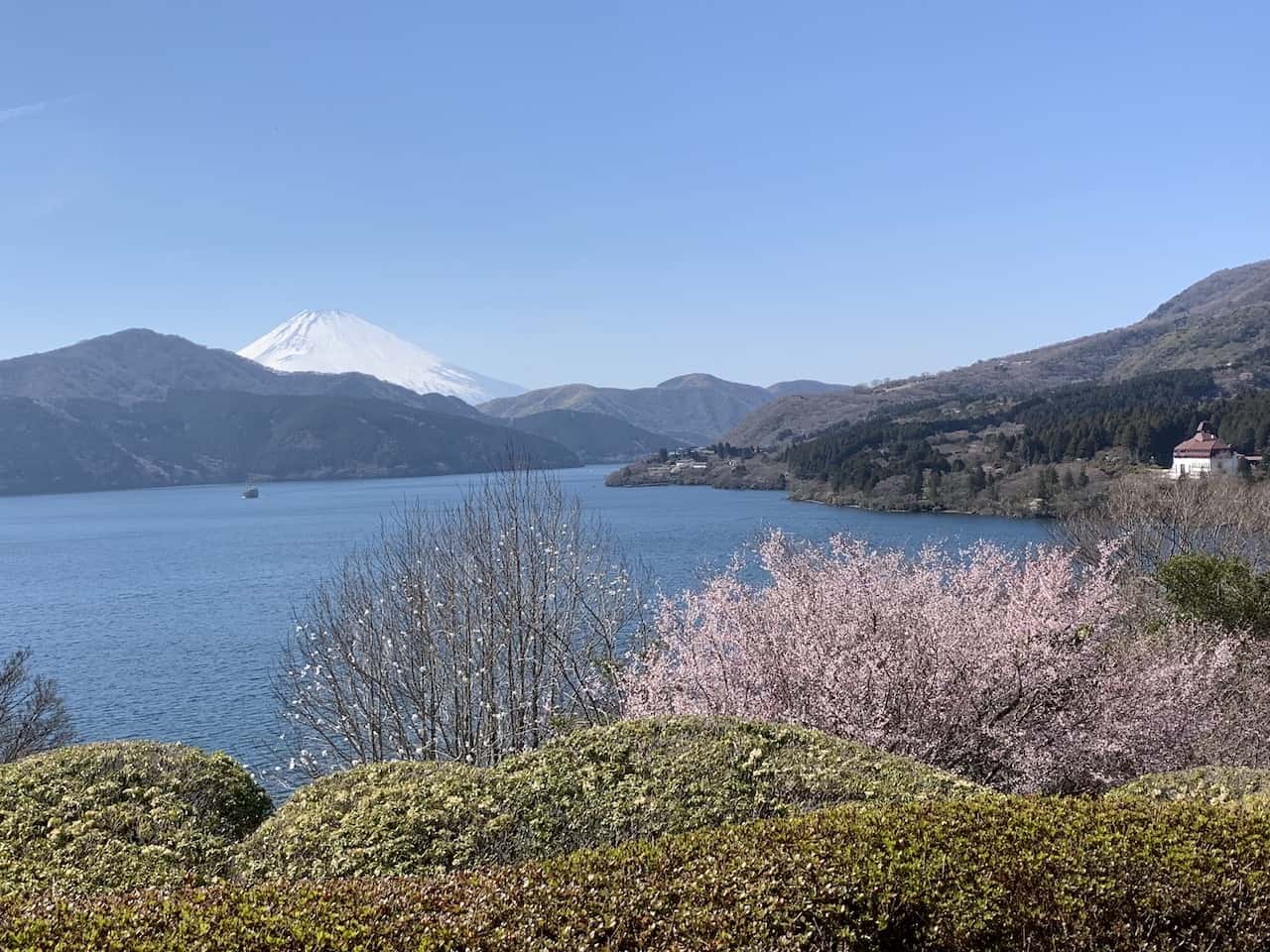
(F) Hakone Shrine
After finishing up with the park if you decided to do so, you can then make the nice walk alongside the water ending up at the Hakone Shrine .
You will be able to get up close and personal to the famous Torii gate and get a nice photo op in. Do note though that there most likely will be a line of folks trying to get that same picture too! When I was there, the line was about 20 minutes long!
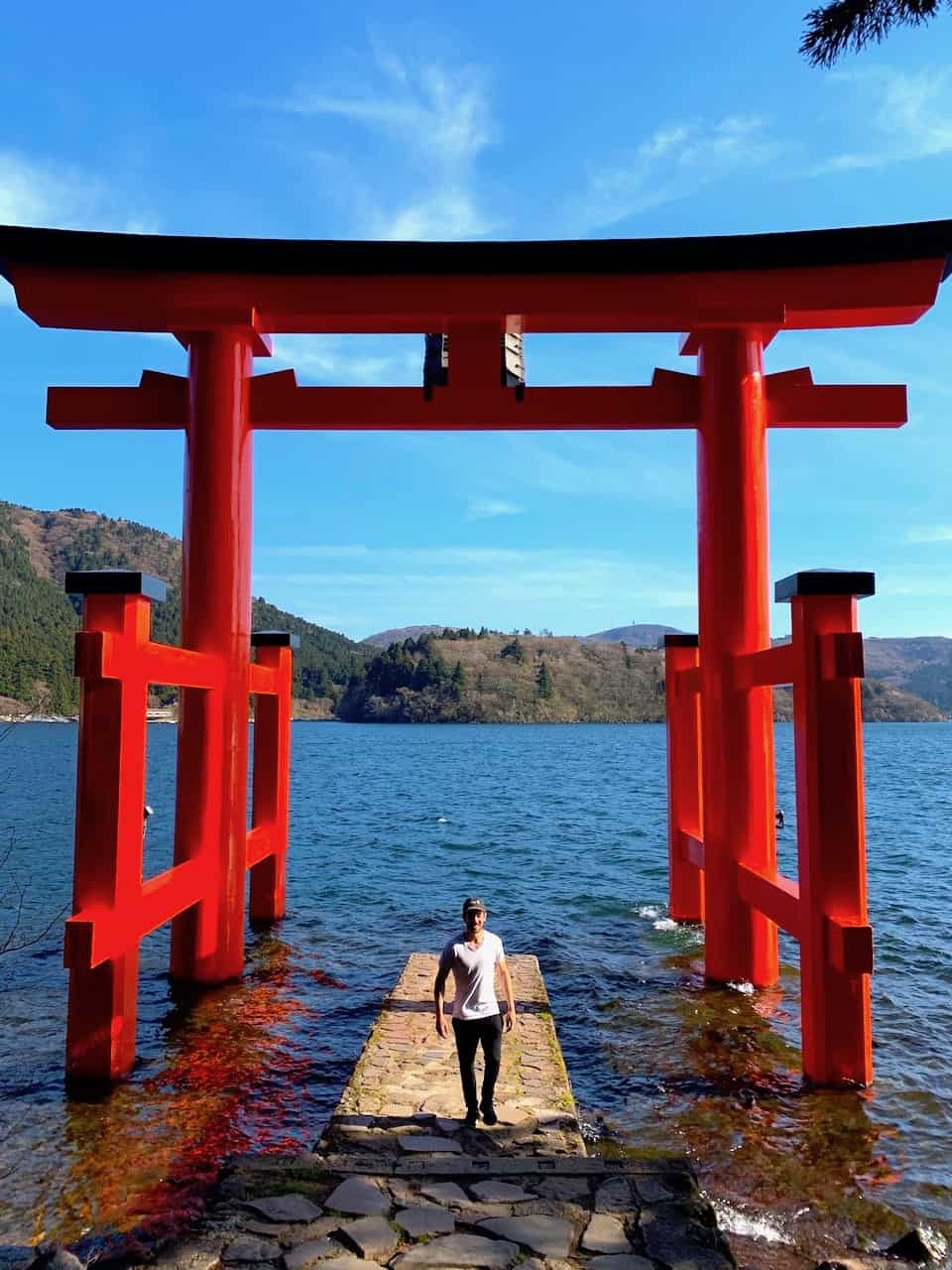
(G) Hakone Tozan Bus
After a full day of exploring the Hakone area, taking various modes of transportation, seeing Mount Fuji, and plenty more, it is time to hop onto the Hakone Tozan Bus and back to either Odawara (back to Tokyo or your next destination), Hakone-Yumoto (Romancecar back to Tokyo), or Gora (if staying overnight) depending on your plans.
There are bus stations right outside the port area and there should be busses every 20-30 minutes or so. Just make sure you get on the right one!
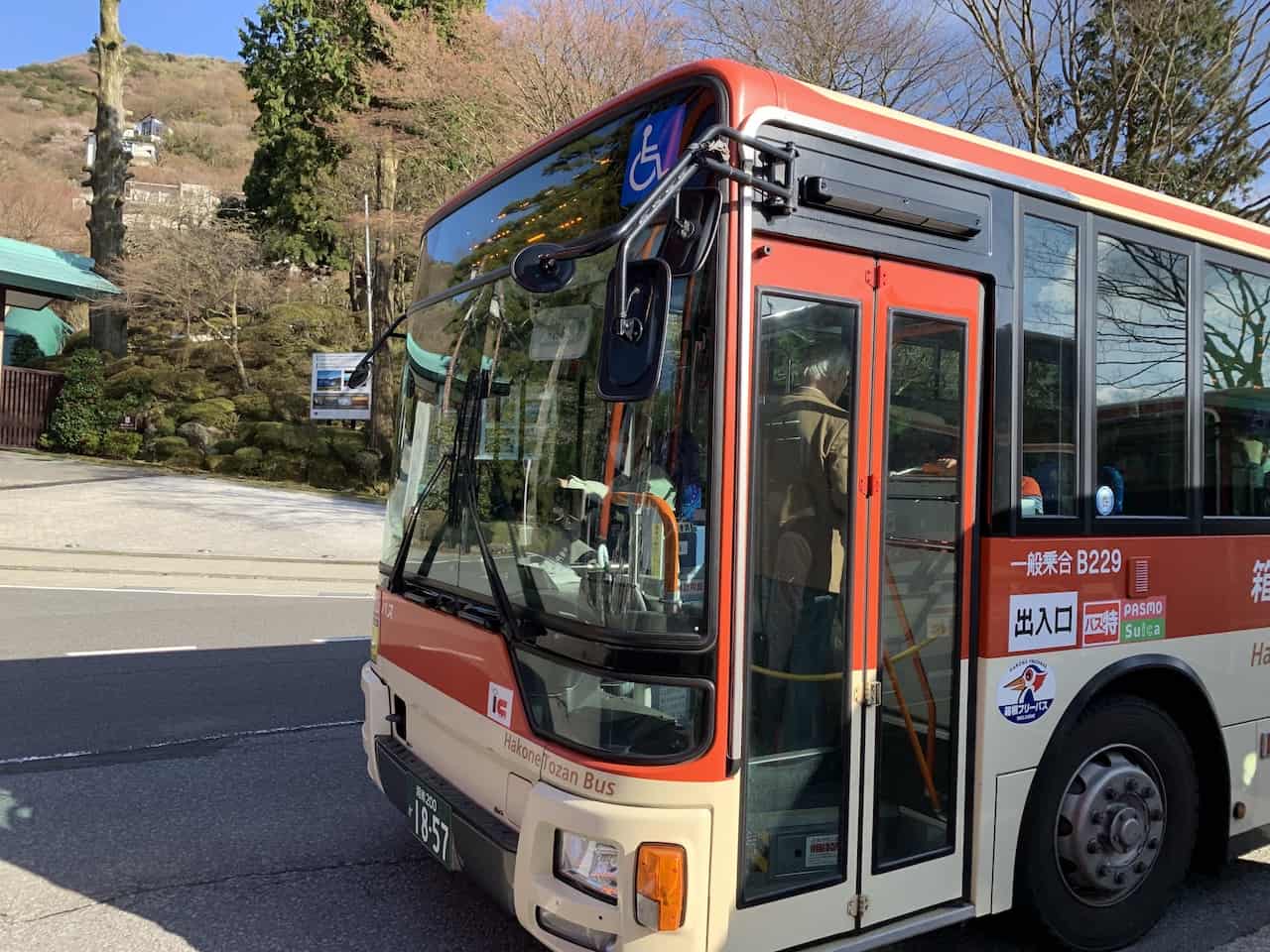
9) Hakone Weather
One of the biggest concerns I had when planning my trip to Hakone was whether or not the weather would hold up. Unlike the cities of Japan, where you do not necessarily need clear days to enjoy your time, Hakone is a bit different.
If you want to enjoy Hakone with those Mount Fuji views then you need clear weather both in Hakone and around Mount Fuji itself.
If it is a cloudy day between the two, you are at risk of not being able to see Mount Fuji at all. And believe me you do not want that to happen!
So, my advice when planning a Tokyo to Hakone day trip is to BE FLEXIBLE. If you are in Tokyo for four days, you do not need to pick one exact day to visit Hakone. You should take a look at the weather forecasts and choose which day out of the four is best for the day trip.
Now if you are planning an overnight to Hakone as you make your way across the country, then it would be a bit harder to navigate the weather as you will be more on a schedule. In that case you just need to hope that the weather is looking good!
10) Quick Luggage Tips
A) If you are using Hakone as a pit stop between two cities (Tokyo and Kyoto for example) and are not staying overnight in the Hakone area, there are luggage storage options in Odawara and Hakone-Yumoto .
Once you arrive at either of these stations you can store your luggage before doing the loop and then pick it back up at the end of the day before heading out.
B) You also have the option to use the Takuhaibin luggage forwarding service if you do not want to deal with your bags at all. For around $20 per bag you can send your luggage to your next destination or you can send your bag to your hotel in Hakone if staying the night there.
That way you will not need to worry about putting your bags in lockers or dropping them off at your hotel and simply start your day right away.
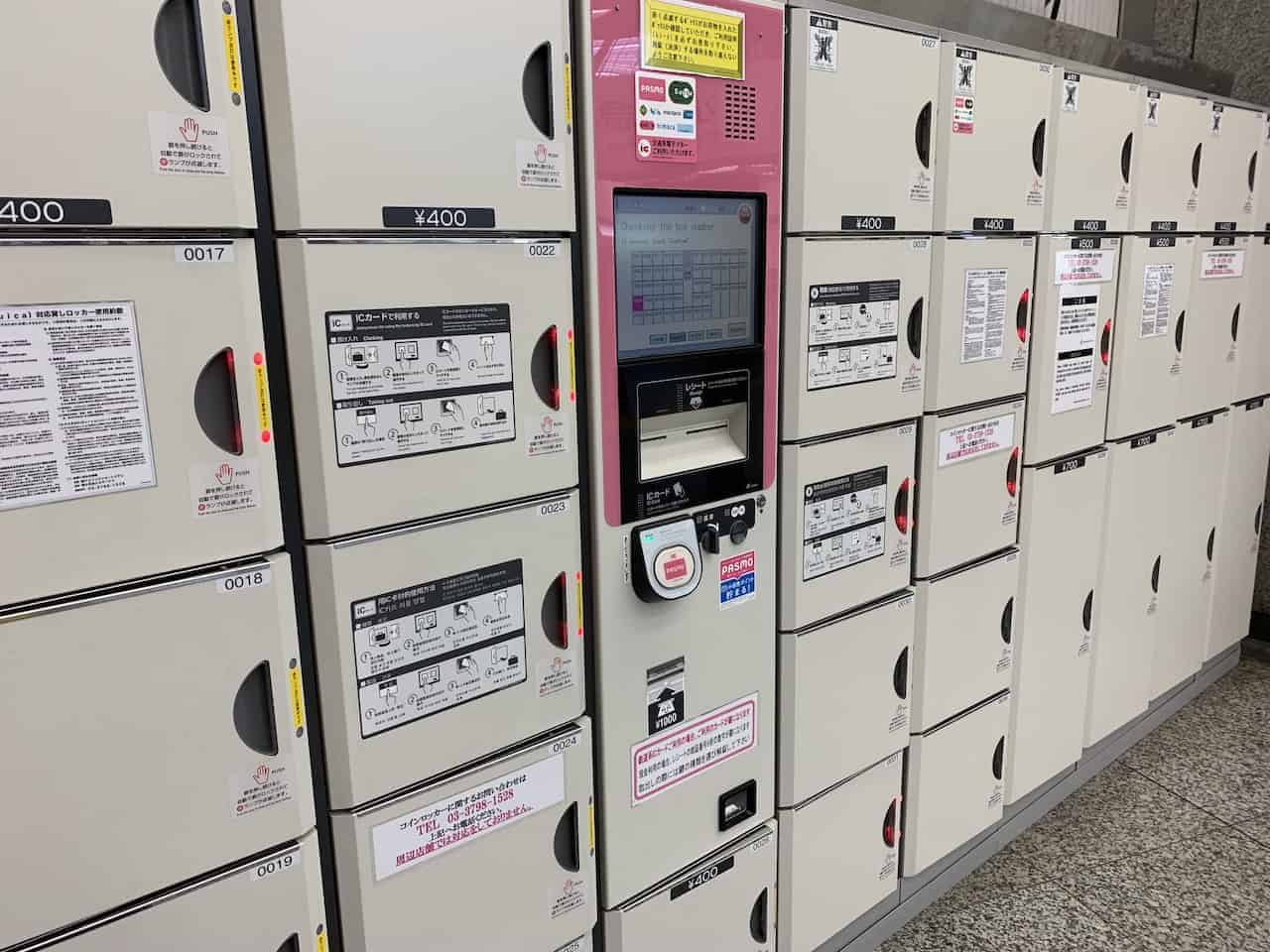
11) Is Hakone Worth It?
With all of that said, you may be wondering if Hakone is worth it. And without a doubt, I can say that Hakone is well worth the day trip.
While there are many logistical parts of a Hakone day trip, there are such a variety of highlights all along the way. Getting to see those views of Mount Fuji consistently throughout the Round Course just makes it that much better.
I will say though that if you have less than ideal weather conditions with no views of Mount Fuji, then I would not have the same answer. A day trip to Hakone is going to feel so much more worth it if you can actually see Mount Fuji.
The great thing about opting for the day trip, is that you can pick and choose which day to head out based on the weather. Keep an eye out when you are there, and select the most weather optimal day for your trip.
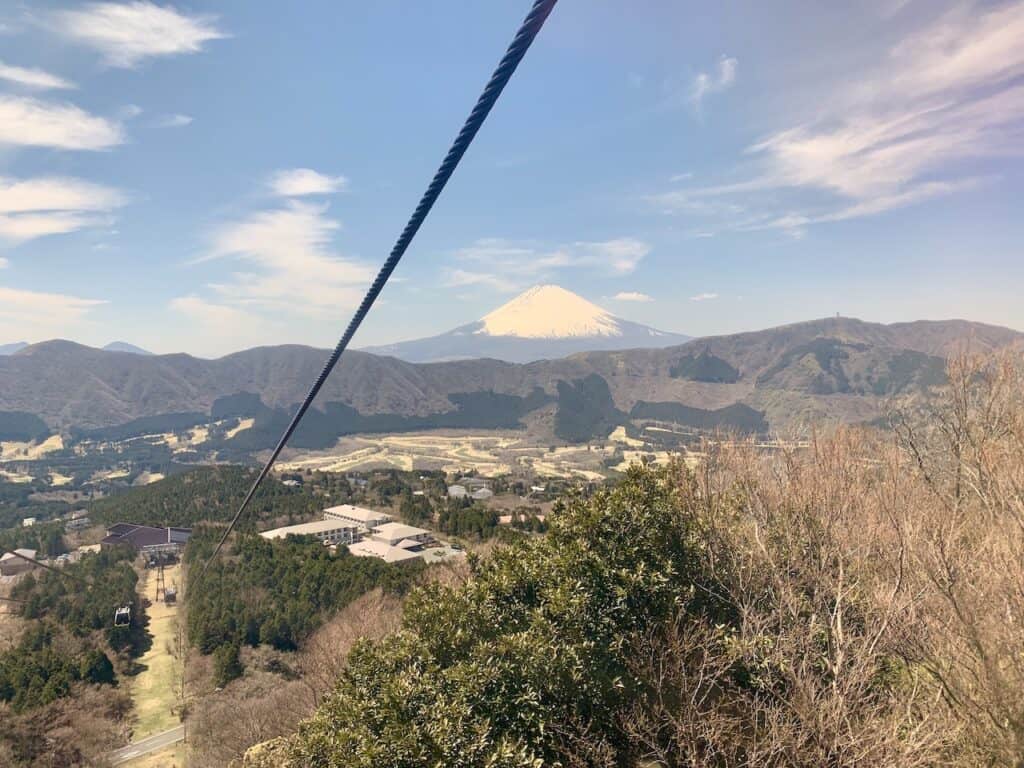
That about wraps up the guide to a Tokyo to Hakone Day Trip. Take a look at the other Japan itineraries and guides to help out with any other trip planning.
If you have any questions about the trip please feel free to comment below!
Some other top guides on the site include:
- 5 Day Tokyo Itinerary
- 3 Day Kyoto Itinerary
- Tokyo to Kamakura Day Trip
- Nara Day Trip from Kyoto
- What To Do in Takayama
- and Plenty More!
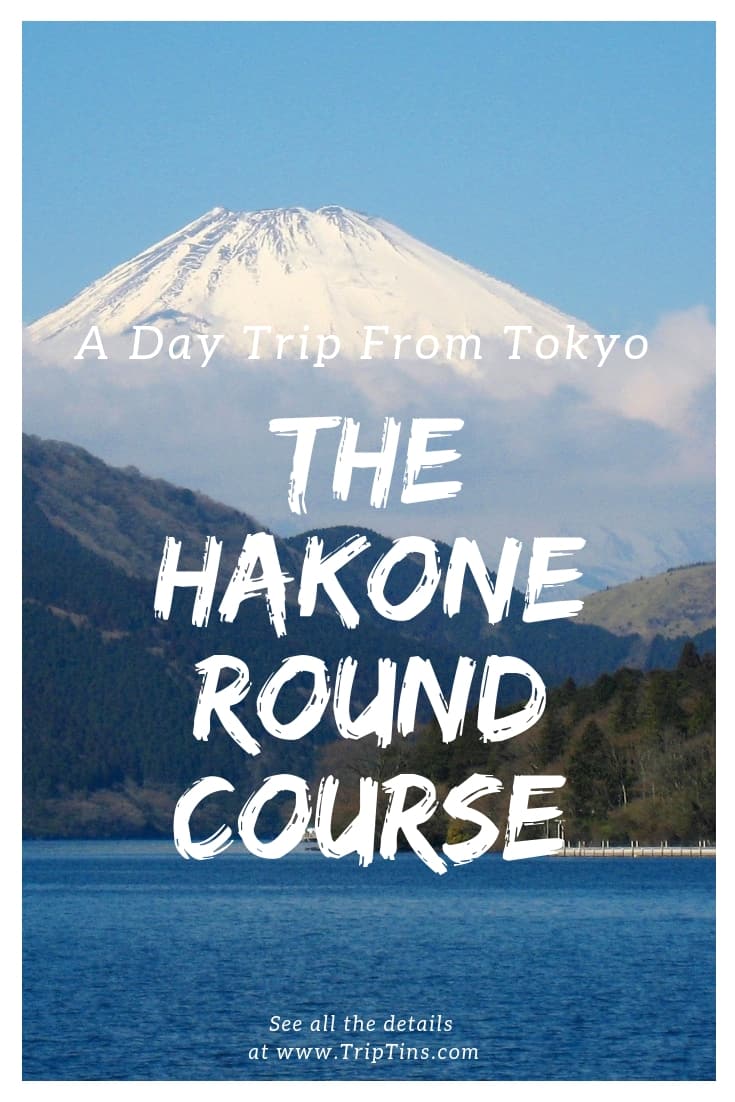
Related posts:
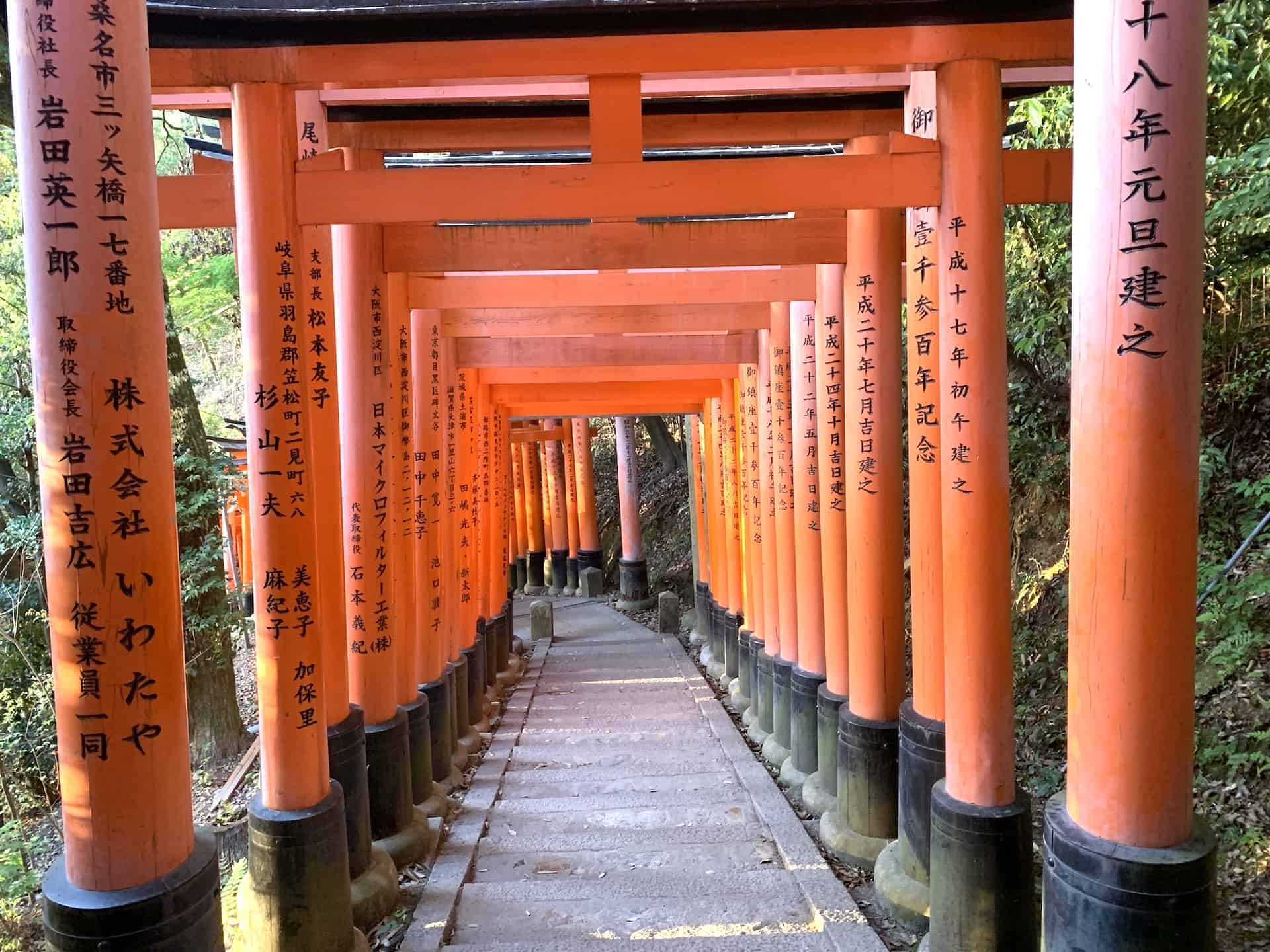
Sharing is caring!
Tuesday 21st of November 2023
Thank you for putting together this information! It was very helpful 😊 I am going to be in Japan for 5 days in March and have one question for you. My plan is to take a one-day trip to Hakone on a weekday, but if the weather forecast is better during the weekend, would you rather go there then, even if it will be more crowded there?
Wednesday 29th of November 2023
@Charles, Hi Charles, seeing Mt Fuji is important to me, so I will keep the weather in mind. Thank you for the advice:)
Sunday 26th of November 2023
Hi Morten - I would recommend basing your decision on the weather if seeing Mt Fuji is a priority. While I am sure the weekends can get more crowded, getting the full experience with nice weather and views is worth it in my opinion. Enjoy!
Monday 13th of March 2023
Thank you for this beautifully written guide, I will be using it when visiting Hakone in may this year! Can't wait :) I was just wondering about one thing - I am staying at a Ryokan in the vicinity of Hakone-Yumoto. I need to check in at about 5.30 pm latest and I really want to see Owakudani and the Shrine. Can I make the trip in the morning or would you suggest to take it easy and rather do it the day after relaxing at the hotel? Thanks!
Tuesday 21st of March 2023
@Charles, thank you for the estimate!! I will think about it but looking at the pictures I really don't want to rush the trip and beauty and maybe take my time with it if the weather allows it :)
Thursday 16th of March 2023
Hi Laura - you are welcome! You will have a great time. If you arrive early enough in the day, then you can certainly do the round trip and make it back to Hakone-Yumoto by 5:30. The round course should take about 6-8 hours. It just depends on your overall schedule/itinerary. If you start the day too late, then you risk the possibility of not making it in time. Any other questions, let me know!
Sunday 5th of February 2023
Thank you for the very detailed itinerary! Question. In April, we will be staying in Mishima near Mishima Station. Can we purchase our Hakone Free Pass at Mishima Station and take the JR Tokai Bus to Hakone Machi-Ko where we will start by getting on the Pirate Ship? I also read somewhere that the Ropeway was closed for a good part of the day. I assume because this is during Winter months. Will it be open with better access in April? Thank you for your insights!
Tuesday 7th of February 2023
Hi Rick - yes, you can purchase the pass in Mishima as it is part of the "free area". And yes, from my understanding the ropeway may have been closed in the winter for a couple of months, but I believe it is now up and running again. Hope you enjoy your trip!
Tuesday 20th of December 2022
Thank you for this blog! Its so helpful! I almost wanted to book a day trip to Hakone. After reading i decided to do it free and easy on our own! I wonder if this itinerary works during Winter period in January?
Thursday 22nd of December 2022
Hi Ann - from my understanding it is possible to take part year round. However, I would double check once you arrive in Tokyo just to be certain. Hope you enjoy the trip!
Friday 10th of January 2020
Hi Charles, Thanks for this blog, very helpful. I'm planning on going to Hakone and doing your 1 day round trip. I'll go either Thursday 2nd April or Friday 3rd April, I understand it gets pretty crowded around that time, so would Thursday be better than Friday - less people? Also the Hakone Tozan bus from Moto-Hakone back to Odawara, is that one bus or two - the map shows 2, and how long does it take? Thanks for your help David
Saturday 11th of January 2020
Hey David - no problem! Glad you have found it useful. As for Thursday vs Friday, I do not think there would be too much of a difference. The weekends would be the most crowded though.
The bus from Moto-Hakone back to Odawara was just one bus for me that took around 40 minutes or so. There is a conductor at the station who will help you out get on the correct bus.
Hope that helps! Feel free to let me know if you have any other questions.
Hakone loop itinerary: the best Hakone day trip
If you’re thinking of doing a one-day trip to Hakone, this Fuji Hakone pass itinerary – also known as the Hakone circuit or Hakone loop – is exactly what you’re looking for.
We have made – and actually done – this Hakone loop itinerary. It covers most of the must-see spots in Hakone and can easily be done in a day. Although we do not recommend only a day for it – read on to see why.
It’s a really fun way to explore the area, basically circling around Hakone. And you use five different means of transport to do it!
Do you know the reason why it’s called – among other things – a Hakone Free Pass itinerary? For enjoying these locations and activities, the Hakone Freepass is quite a must – it makes the whole trip cheaper and more convenient.
Anyway, our guide here covers information on what and where is Hakone, how can you visit it, where to stay if you’d like to, and the itinerary itself, as well as additional activities to do in the area. Enjoy!
This post might contain affiliate links, which means that if you purchase anything via them, we might earn a small commission – at no extra cost to you. Check our affiliate disclaimer for more information. As an Amazon Associate we earn from qualifying purchases .
Our 1 day Hakone Loop itinerary
A perfect way to enjoy Hakone is to follow a round course itinerary. It encompasses all the main places of interest and uses all the five means of transportation. Actually, six – your feet as well 😊
You can start this 1 day Hakone itinerary at any of the local villages, returning to the same one – it’s a circuit. Altogether, it would take around 8 hours to complete, however, that depends on how fast or slow you prefer to enjoy the various places.
It would be doable as a 1-day round trip from Tokyo as well, even though that would make for a really long day.
That’s why we recommend staying in one of the many ryokan Hakone offers to savour this amazing place at a slower pace.
Cablecar from Gora to Sounzan and Hakone ropeway from Sounzan to Owakudani
If starting in Gora, hop on the cable car for a 10-minute ride to Sounzan. In Sounzan change for the ropeway and get off at Owakudani .
Owakudani is an active volcanic area – in fact, it is a crater that was created some 3000 years ago during an eruption of Mt. Hakone. Numerous steaming vents spewing sulfurous fumes and bubbling hot pools are found here. Owakudani is also the source of water for many of the onsen in the Hakone area. Mt. Fuji is visible from here on clear days as well.
A peculiar experience not to be missed is the local black eggs (kurotamago). They are boiled in sulfurous water that dyes the shell black and supposedly have more umami flavour than normal hardboiled eggs.
A legend has it that each black egg that you eat adds seven years to your life. While the extra umami flavour has actually been scientifically confirmed, the latter hasn’t 😊.
The eggs are sold only here in Owakudani and make for a perfect snack, so why not try them? And as a dessert, try a black bamboo charcoal ice cream (yup, a typical Owakudani snack is black 😊).
Note: A walking trail among the steam vents and bubbling pools in Owakudani is open from 9am to 5pm and requires advance reservation. Allow 30-60 minutes for visiting. If you have respiratory problems, consider skipping the area as the sulfuric gases might make your condition worse. The area occasionally gets a bit too steamy and gets temporarily shut down by the authorities – either whole or some parts of it.
Hakone ropeway from Owakudani to Togendai and the Pirate cruise ship!
From Owakudani, hop on the ropeway again and continue down to Togendai, enjoying the views of majestic Mt. Fuji on the way (if the weather cooperates, that is 😊).
Togendai sits on the northern shore of the picturesque Laki Ashi and offers several restaurants. By the way, just like Owakudani, Laki Ashiniko also owes its creation to the last eruption of Mt. Hakone 3000 years ago.
When ready, board a pirate ship here and savour the scenic half-an-hour cruise to Moto-Hakone. There are beautiful views from the open upper deck, including Her Majesty Mt. Fuji from the southern part of the lake.
Next up – Moto-Hakone or Hakone-machi
Get off the Hakone sightseeing cruise boat at Moto-Hakone or Hakone-machi .
Both Hakone-machi and Moto-Hakone are situated at the southern tip of the lake and are about a 20-minute walk apart. They boast several interesting places to visit and also offer several good options for lunch.
We definitely recommend visiting Hakone Shrine . It’s a breathtakingly beautiful shinto shrine located about 5-minute walk from Moto-Hakone. The shrine buildings are hidden among tall trees; however, your first clue will be the vermilion torii gates. There are three of them that lead to the shrine, the first one actually standing in the lake itself. From there, follow the steps up into the dense forest to experience the magical atmosphere of the shrine. We were lucky to catch a glimpse of a traditional Japanese wedding here, perhaps you’ll be as well.
The southern shore of the lake is another great spot for admiring views of Mt. Fuji. Our 1-day Hakone itinerary offers several opportunities to enjoy the magnificent vistas of Japan’s tallest mountain. And it’s good to bear in mind that even if Mt. Fuji is often hidden in the veil of clouds, they usually come and go during the day, so if even you didn’t spot Mt. Fuji an hour ago at Owakudani, you might spot it an hour later from Moto-Hakone. A great place for this is Onshi-Hakone Park which lies between Moto-Hakone and Hakone-machi.
Hakone Checkpoint
Hakone used to be an important checkpoint on the ancient Tokaido road, linking Kyoto and Tokyo (then called Edo) many moons ago. The historical checkpoint, along with part of the ancient highway, was reconstructed in 2007 and can be visited.
It’s located between Hakone-machi and Moto-Hakone, right next to Onshi-Hakone Park. Even better, you can walk a part of the old Tokaido route – from Moto-Hakone to Amasake Chaya. It’s about a half-an-hour nature walk, partly on cobbles, that will take you to over 400-year-old teahouse Amasake Chaya.
Note: If you have walking difficulties, or if the cobbles seem too slippery after rain, you might consider skipping this. You can instead take a bus (line K from Moto-Hakone bound for Hakone-Yumoto).
Amasake Chaya teahouse
Amasake Chaya has been welcoming visitors – travellers on the old Tokaido road since the 1600s. Its recipe for amasake – a non-alcoholic sweet rice drink – has been unchanged ever since it opened. Enjoy it cold if it’s hot outside, or warm if it’s cold outside, accompanied by mochi – traditional Japanese rice cakes that are handmade here every morning. This is a perfect stop for your afternoon snack.
Bus for Hakone-Yumoto and Hakone Tozan train
From here, hop on the bus (line K) bound for Hakone-Yumoto. The bus stop is right in front of the teahouse.
The bus will take you to Hakone-Yumoto , a lively resort town with many hotels and ryokan, numerous public onsen as well as a plethora of restaurants and shops. You might stroll around, perhaps get a souvenir, and then get on the scenic Hakone Tozan train that will take you back to Gora.
It is Japan’s oldest mountain train, winding its way from Hakone-Yumoto to Gora through a densely wooded valley over bridges and tunnels and changing its direction three times at switchbacks. It’s an utterly scenic 40-minute ride. And here we are, back to Gora, where we started in the morning.
Note: This Hakone circuit can be started at any of the local villages – Hakone-Yumoto, Gora, Togendai, or Moto-Hakone. You’ll simply return in the evening to the same spot. Likewise, you might prefer to do the whole circuit clockwise or anti-clockwise – it works both ways.
Where is Hakone?
Hakone is a part of Fuji-Hakone-Izu National Park. It is the most visited national park in Japan and for a good reason.
It is an area of outstanding natural beauty, easily reachable from Tokyo and offering a superb mix of some of the quintessential Japanese experiences. There are many onsen (natural hot baths) to enjoy and plenty of great ryokan (traditional Japanese inns) to stay at. And, as the name of the national park suggests – there is the iconic Mt. Fuji dominating the skyline.
While the whole national park is rather big, the Hakone area itself is rather compact. It offers a lot of sights and experiences in a relatively small area which makes it very suitable for visiting, especially for first-time visitors to Japan.
In fact, it is possible to visit it on a day trip from Tokyo, however, we would recommend staying for a night or two.
Like this, the whole experience will be more relaxed. We stayed two nights in Gora, a mountain village in the heart of the Hakone area.
We thoroughly enjoyed our stay in a ryokan, relaxed in its in-house onsen, feasted on incredible kaiseki (Japanese haute cuisine) meals and explored the beauty of the whole place on a 1-day Hakone itinerary using no less than five different means of transportation.
It was our favourite part of the whole 10-day Japan itinerary and also its most relaxing part.
Why should you visit Hakone?
To slow down. To unwind. To immerse yourself in the beauty of Japanese nature. To experience Japanese hospitality and cuisine in a luxurious ryokan. To dip in the healing waters of natural hot springs which are abundant in this area. To admire the majestic Mt. Fuji.
Sounds tempting?
Not only tempting! I dare to say this is the hottest and steamiest place we visited in Japan.
No pun intended – part of Hakone is a live volcanic area 😊
What is a Hakone Freepass?
Hakone Freepass allows unlimited travel within the Hakone area. It is a convenient single ticket that also saves you money – if you’re following our 1-day Hakone pass itinerary, it definitely is a good value.
It’s available either as a 2-day or a 3-day pass and may cover only the Hakone area or a round-trip between Tokyo Shinjuku and Hakone (for a surcharge). It also allows discounts at numerous tourist spots in the area.
You can get it online or in one of the Odakyu sightseeing service offices located at the train stations in Shinjuku (Tokyo), Odawara and Hakone-Yumoto. But we strongly suggest that you get it online. First of all, it’s actually cheaper than getting it at the Odakyu sightseeing offices. And second, it’s less hassle than purchasing it at the station – you just need to exchange your voucher for the pass.
If you get your pass online , be aware that it can take even 5 working days for it to arrive. If you need to get it sooner, you can contact the seller, they say they might be able to work something out.
How to get to Hakone?
The most convenient way to get to Hakone is by train. There is a direct train from Tokyo Shinjuku station to Hakone-Yumoto operated by Odakyu and is covered by Hakone Freepass (for a surcharge).
This is a convenient option if you’re visiting from Tokyo and also returning to Tokyo. The train journey from Tokyo to Hakone-Yumoto lasts approximately 80 minutes.
However, if you already have a valid JR pass , or if you’re coming from (or continuing to) Kyoto instead, we recommend using the JR trains to travel to Odawara (Shinkansen trains from Tokyo and Kyoto stop here). At Odawara station you may get your Hakone Freepass (the cheaper one only for the Hakone area) and hop on the local Hakone Tozan train to Hakone-Yumoto and further on to Gora (or wherever you’re headed to in the area). This is the best option if you’re following our 10-day Japan itinerary.
How to get around Hakone?
The great news is that getting around Hakone is not only super easy but also super fun. The area boasts no less than five different means of transportation – a really scenic train, a cable car (sort of a funicular, if you will), a ropeway (a gondola), a sightseeing boat and a bus.
Hakone Tozan train
The Hakone Tozan train connects Hakone Yumoto and Gora. This journey takes about 40 minutes and is incredibly scenic. The train gains more than 400 m on this journey, winding its way through a narrow valley. There are several switchbacks where it changes direction – an interesting engineering idea that was needed to help the train overcome the steep terrain. It also connects Hakone Yumoto to Odawara, where one can change for a Shinkansen to Tokyo or Kyoto.
Cable car – Hakone ropeway
The cable car connects Gora to Sounzan where one can change for the ropeway (gondolas) operating between Sounzan and Togendai. The ropeway has several stops on its way including the active volcanic area of Owakudani. The part between Owakudani and Ubako offers breathtaking views of Mt. Fuji.
Hakone sightseeing boats
The sightseeing boats connect Togendai on the north of Lake Ashinoko with Moto-Hakone and Hakone-machi on its southern shore. Several companies operate the boats, please note that Hakone Freepass is valid only on Hakone Sightseeing boats. Cruising on these boats that resemble ancient pirate ships is a very pleasant experience. Beautiful views open up from the upper deck – including those of Mt. Fuji from the southern part of the lake. The cruise takes about 30 minutes.
Several local buses operate in the area.
Can you visit Hakone in winter?
Yes, you can. Actually, we kind of accidentally did it.
If you’ve seen our Japan photo diary , you might know that we visited Japan in November.
Well, just when we were going to Hakone, it snowed in the area. And it was the first time in 40 years that the snow came in November (at least that’s what we were told).
All of the transportation up to Gora just… stopped, as the buses or cars (taxis) didn’t have chains on yet, and the trains… even the trains didn’t run. We were planning to enjoy the romantic Hakone Tozan train, and that didn’t work out for us.
We were delayed from arriving at our hotel for the whole afternoon, just trying to figure out how to get there.
But on the other hand, the trip the next day – the Hakone loop – was more interesting because of the snow. Albeit a bit colder than Kyoto the previous days.
Anyway, the answer, again, is yes, you can visit Hakone in winter. Just make sure to pack accordingly so that you’re not cold.
Can you do a day trip to Hakone?
As I’ve mentioned already in this article, yes, it’s quite possible to do a Hakone day trip from Tokyo .
You don’t even have to wake up at dawn – but don’t sleep in, either. The best time to leave Tokyo is around 7am. It takes just under 2 hours to get from Tokyo to Hakone, thus giving you basically a full one day there.
If you take the Odakyu limited Express romancecar , the journey takes approximately 80 minutes but is a tad bit more expensive. Although it does give you better views – there’s a huge panoramic window.
Take the express train from the Shinjuku station to the Odawara station (it’s the Odakyu Line), then change to the Hakone-Tozan Line to go to the Hakone-Yumoto station.
But we do really recommend that you spend a night or two in the Hakone area so that you can have one full day in Hakone. And so that you get to enjoy a ryokan, as Hakone is one of the best places in Japan to enjoy a ryokan with an onsen .
Should you do a Hakone day trip or overnight?
In case you’re still wondering if you should do a Hakone day trip or overnight there, then again, we definitely recommend a stay in Hakone .
That way, you don’t have to worry about catching a train back to Tokyo and can enjoy everything at a more leisurely pace.
Plus, this gives you time to enjoy more of Hakone than a day trip would allow!
Where to stay while visiting Hakone?
If you do decide to stay a night or two in Hakone there are several mountain villages in the area. Each offers a choice of hotels and ryokan, as well as restaurants, cafes and other tourist attractions. And they are all very well interconnected by the local transportation.
Hakone-Yumoto
Hakone-Yumoto is the gateway to the whole area, with a direct train to Tokyo. It has a wide selection of hotels and ryokan, stores and restaurants. You’ll also find numerous public onsen here – the largest choice in the whole area. Other attractions include a golf course and a Forest Adventure Park.
Gora is a picturesque mountain resort and offers the largest choice of hotels, especially ryokan, ranging from budget to luxury. It is easily reachable by the local Hakone Tozan train and boasts nice mountain views (not of Mt. Fuji, though). This is a great base for exploring the Hakone area. There’s also a Western-style park and a splendid Open-Air Museum.
Did you know it has one of the world’s largest collections of Picasso’s work?
Gora is where we stayed when we visited Japan. We stayed in the Tensui Saryo ryokan in Gora and enjoyed our stay, so can recommend it to you, too.
Moto-Hakone or Togendai
Moto-Hakone and Togendai are two mountain villages right by the lake Ashinoko. The village of Moto-Hakone offers amazing views of Mt. Fuji and is also home to Hakone Shrine, with one of its torii gates being in the lake itself. The choice of accommodation is a bit smaller compared to Gora and Hakone-Yumoto.
Here are some of the best Ryokans to stay in the Hakone area.
If you’d like to create a hakone 2 day itinerary….
There are loads of things to do in the Hakone area, so if you’d like to create a Hakone 2 day itinerary, it’s easy!
Different – many different – museums in Hakone.
The most prominent things to do that we didn’t really include in our 1 day Hakone itinerary are visiting different kinds of museums, of which there are really many in Hakone. Let me mention just a few of them.
Hakone GeoMuseum
If you’d like to learn more about the Owakudani volcano, make sure to visit the Hakone GeoMuseum. It’s located right at the Owakudani station, so this museum might be a perfect addition to your Hakone itinerary. And it’s especially good if you’re visiting Hakone in winter, as it’s a good way to warm up a bit.
And if you’re worried about costs, know that there’s a free exhibition in the museum – we actually went to that one.
Hakone Open Air Museum – discounted entry with the Hakone freepass !
As we already mentioned, the Hakone Open Air Museum is located in Gora. It’s full of artwork and sculptures, including 300 hundred pieces by Picasso that are housed in the aptly named Picasso Pavilion. This museum is the first one in Japan where you can enjoy artwork against the backdrop of nature.
Hakone open-air museum is good for families with children, too. Kids can enjoy attractions like Soap Bubble Castle or Net Forest.
Narukawa Art Museum
The Narukawa Art Museum was opened in 1988 to show entrepreneur Minoru Narukawa’s collection of Japanese-style paintings (Nihonga) from the mid-1950s onward. It’s located on the hill overlooking Lake Ashi, the bright orange floating torii gate of the Hakone Shrine, as well as, of course, mount Fuji. There’s a permanent exhibition of the hidden treasures of China in the Narukawa Art Museum, as well as significant masterworks by contemporary Nihonga paintings.
Hakone Botanical Gardens of Wetlands
Unless you visit Hakone in winter, consider going to the Botanical Gardens of Wetlands. Yes, wetlands, plural, as in this garden, you get to see different types of marshlands – bogs, fens, swamp forests, and others. And there are some 1200 different types of plants that you get to enjoy, both Japanese and from different other countries and areas.
Note: If you’d like to visit several different museums in the Hakone area (including the Botanical Gardens), consider getting a combination ticket – that way, you’ll be able to save some money. The admission prices add up, and even with the Hakone freepass, the discount is smaller than getting a combination ticket. You do have to get a ticket at the museum to combine it with others.
Hiking Lake Ashi
Yes, it’s possible!
There’s a trail by Lake Ashi called Ashinoko Loop Hiking Trail. Although I don’t know why it’s called “loop” everywhere, though, as it’s basically just on the West bank of the lake.
Anyways, it’s an easy-to-moderate and long trail through forests. You can see most of the attractions mentioned here in the itinerary, as well as enjoy beautiful views of the lake.
You can go point-to-point and just take the Sightseeing cruise to get back.
Hiking the Hakone caldera
If you’re in great physical shape, why not spend a day hiking around the Hakone caldera? The caldera traversing takes approximately 4-5 hours and the trail is approximately 9km long. The ascent has a 500m altitude change, and it takes approximately 90 minutes.
During this hike, you get to see Mount Fuji (if it’s not hiding behind the clouds, of course), as well as a bamboo field, Sakura in the spring or autumn foliage in, well, autumn.
Have lunch in a local Japanese restaurant and at the end of the tour, relax in an onsen. Both included!
Book your tour here.
Hakone forest adventure.
If you crave a bit of adventure, there’s an obstacle course available up in the trees! Traverse from tree to tree on moving swings, nets, and ziplines. According to the website, there are no age limits (although they state them on some tracks).
Tours to Hakone
If you’d like to visit Hakone, but even after this article feel like you’d rather have someone else take you there, why not go on a tour?
There are many different ones available.
For example, have a guide that helps you create a full 8 hour private tour of Hakone . Or just have a private pre-made tour , if you really don’t want to think too much about anything.
Both of these tours start and end in Hakone, though.
If you’re in Tokyo and would like to have a day trip, check out this one which uses public transport. Or there’s even one which uses private transportation .
For a multi-day tour, you can have a look at the Hakone discovery . It lasts 3 days/2 nights and covers the Hakone area, as well as includes accommodation and food among other things.
In conclusion about the Hakone one day itinerary
There are lots of things to do in Hakone that offer both some interesting experiences as well as the ultimate relaxation. Whether you do a day trip to Hakone from Tokyo or decide to spend a few nights there, it’s definitely worth a visit.
FAQ: Hakone Loop and Hakone itself
The Hakone free pass itinerary; Hakone round course;
You can easily do the Hakone Loop in a day, as you see from this itinerary. Even in the winter, if you start early enough.
The Hakone round course, of course!
We recommend staying at least 2 nights. That way, you have a full day to do the Hakone Loop and enjoy being pampered for a couple of nights in a good ryokan .
Honestly, whichever way you’d like. Some sources say clockwise, some – counterclockwise. We have it written out counterclockwise, though, as that’s what the Japenese suggest.
Did you enjoy this post? Make sure to share it!
Photographer & Local Expert
Michal Nizky is the main photographer and planner of Wanderlust Designers. He's visited over 300 places in 60 countries and is the expert on planning trips, all while working a full-time job. He knows he can teach others all about planning and travelling while still working full-time.
Similar Posts
Japan in november: 10-day itinerary in pictures.
Visiting Japan is like hopping on a rollercoaster of amazing and unique experiences. It doesn’t matter if you visit Japan in November during the height of Autumn foliage, or in April when the sakura blooms – the Cherry Blossom season. From admiring the beauty and tranquillity of Buddhist temples and gardens to enjoying exquisite Japanese…
Famous dishes in Japan: 9 best foods for your bucket list
Food alone is an excellent reason to visit Japan. All those mouth-watering teppanyaki, sukiyaki, okonomiyaki and other yaki, as well as ramen, sushi, and so on… There are so many famous dishes in Japan! Famous and fabulous, Japanese food will tickle your taste buds and make them scream with happiness. Yup, Japan is a gastronomic…
Hakone in winter: is it worth it? YES!
If you’re thinking about going to Hakone in winter, I say go for it! We accidentally got to enjoy winter in Hakone during our visit to Japan in November – unexpectedly, it snowed there quite heavily. And you know what, when Japanese say it was unexpected, I believe it. Still, it’s very easy to enjoy…
First time in Japan: Japan for Beginners tips
If it’s going to be your first time in Japan, get ready for quite the culture shock. Japan – a place of immense beauty and incredible culture. Where the newest advancements in technology meet centuries-old traditions. It’s so different from the rest of the world! That’s why we’ve put together a sort of “Japan for…
Ryokan experience in Japan: why you need it and what you should know
Ever wondered what a Ryokan experience is like? Or a Japanese onsen experience? Let’s start by saying that time spent in a ryokan or an onsen is time well spent! It’s a time to enjoy a peaceful atmosphere.Time to be surrounded by beauty.Time to indulge in a relaxing hot bath.Time to let your taste buds…
Hakone Lake Ashi Cruise: your guide for the perfect trip
The Hakone Lake Ashi Cruise is one of the best ways to enjoy Lake Ashi and its surrounding beauty. That beauty, of course, includes Mount Fuji! It’s part of the Hakone Loop – which covers most of the must-see spots in the Fuji-Hakone National Park and uses no less than five different types of transportation….
Leave a Reply Cancel reply
Your email address will not be published. Required fields are marked *
Save my name, email, and website in this browser for the next time I comment.
This site uses Akismet to reduce spam. Learn how your comment data is processed .
- Destinations
Tokyo to Hakone Day Trip (7 Fun Things You Can’t Miss)
This site uses affiliate links, meaning that if you make a purchase through our links, we may earn an affiliate commission.
Hakone is well known for its many hot springs and stunning viewpoints of Mt Fuji (when the weather cooperates). Its sightseeing highlights include pristine Lake Ashi, Owakudani (Hell Valley) with plumes of sulfurous steam gushing upward, several fascinating museums, and many other attractions.
Located roughly 60 miles west of Tokyo, Hakone is a perfect day trip destination.
Get the most out of your Tokyo to Hakone day trip and follow this one-day handpicked Hakone itinerary. Here are 7 fun things you can’t miss!
For a complete list of things to do in Hakone, make sure to check out: 19 Amazing THINGS to DO in HAKONE (Useful Maps+Photos+Practical Tips)
You might also like:
HAKONE FREE PASS – Is It Worth Buying?
14 Exceptional Must-See Things at HAKONE OPEN AIR MUSEUM
Find Out More About Japan:
Ultimate 16-DAY JAPAN ITINERARY for Marvelous Culture, History, and Nature
First Visit to Kyoto – How to Visit and What to See (11 Things You Can’t Miss)
7 Fun and Easy DAY TRIPS from KYOTO (Useful Maps+Photos+Tips)
Perfect ONE DAY in OSAKA Itinerary (6 Best Things to Do)
You Might Also Like:
275 Best QUOTES About JAPAN (JAPANESE Culture, Nature, Food, Anime, Proverbs)
165 Beautiful CHERRY BLOSSOM QUOTES and CAPTIONS
- 1. How to Get from Tokyo to Hakone
- 2. Should you Get Hakone Free Pass
- 3. Do the Hakone Loop Counterclockwise
- 4. Tokyo to Hakone Day Trip - 7 Fun Things to Do
- 4.1. Visit Stunning Odawara Castle
- 4.2. Explore Hakone Open-Air Museum
- 4.3. Take the Ropeway to Owakudani (Hell Valley)
- 4.4. Go on Hakone Sightseeing Cruise on Lake Ashi
- 4.5. Learn About Hakone's History at Famous Hakone Checkpoint
- 4.6. Take a Leisurely Stroll on Ancient Cedar Avenue
- 4.7. Visit Spectacular Hakone-jinja Shrine
- 5. Intrepid Scout's Tips for Tokyo to Hakone Day Trip
How to Get from Tokyo to Hakone
From Tokyo Station in Tokyo take either JR East Tokaido Line or JR Central Tokaido-Sanyo Shinkansen Westbound to Odawara Station in Odawara .
If you have JR Pass , then your trip on either JR East Tokaido Line or JR Central Tokaido-Sanyo Shinkansen Westbound will be covered by the pass.
If you decide to take JR East Tokaido Line , then you will be able to reserve your seats online and pick them up at several convenient locations. The travel time on JR East Tokaido Line from Tokyo Station to Odawara Station is about 1 hour.
If you decide to take JR Central Tokaido-Sanyo Shinkansen Westbound , then you will not be able to reserve your tickets online, however, you can make reservations at any JR Central office locations. Traveling on JR Central Tokaido-Sanyo Central Shinkansen is comfortable and fast. It will get you to Odawara in only 35 minutes.
Once you arrive at Odawara, take the West Exit and proceed to board the Odakyu Line Train .
Odakyu Line Train will take you to Hakone-Yumoto Station. The journey time is about 18 minutes. The trains leave pretty much every 20 minutes, so if you miss one train, there will be another one arriving in a few minutes.
The second option for getting from Tokyo to Hakone is to take the Odakyu Line LTD. Express Romancecar from Shinjuku Station in Tokyo. It will take you directly to Hakone-Yumoto Station. Travel time is 1 hour and 15 minutes. Reservations are required and can be made at Odakyu Sightseeing Service Center at Shinjuku Station in Tokyo.
The Romancecar is not covered by JR Pass.
Romancecar is called ‘Romancecar’ for nothing. It is one of the most luxurious trains in Japan. It has fully reclining seats, panoramic windows, and full onboard service. In addition, it travels through some most spectacular areas with views of Mt Fuji in the distance.
Should you Get Hakone Free Pass
Should you get Hakone Free Pass ? Absolutely, it is worth buying! It will help you save money on your trip to Hakone.
It includes round-trip travel on the Odakyu Line and unlimited use of eight Hakone-area transportation modes. Plus, you will get discounts on entrance tickets to all major attractions in Hakone.
Make sure to read my helpful post: Hakone Free Pass – Is It Worth Buying? and find out:
- which pass to buy (different options are available)
- how much does Hakone Free Pass cost (it is called ‘Free Pass’, however, it is not ‘Free’)
- where can you buy the pass
- what is included in Hakone Free Pass
- how much will you save if you buy the pass
Intrepid’s Tip:
Read: Hakone Free Pass – Is It Worth Buying?
Do the Hakone Loop Counterclockwise
The best way to explore Hakone is by circling the region by going either clockwise or counterclockwise. It is known as ‘ Hakone Loop ‘.
My preferred method is to go counterclockwise.

Hakone Map / Photo Credit: Hakone Free Pass / Tokyo to Hakone Day Trip
To Print the Map of Hakone
Click: HERE
Tokyo to Hakone Day Trip - 7 Fun Things to Do
Visit stunning odawara castle.
If you are traveling on JR East or JR Central, then Odawara Station will be your first stop and it is a perfect opportunity to visit Odawara Castle. From Odawara Station take the East Exit and follow the signs.
Odawara Castle is no more than a 10-minute walk from Odawara Station. You will see Odawara Castle Donjon (a massive tower) from the distance.
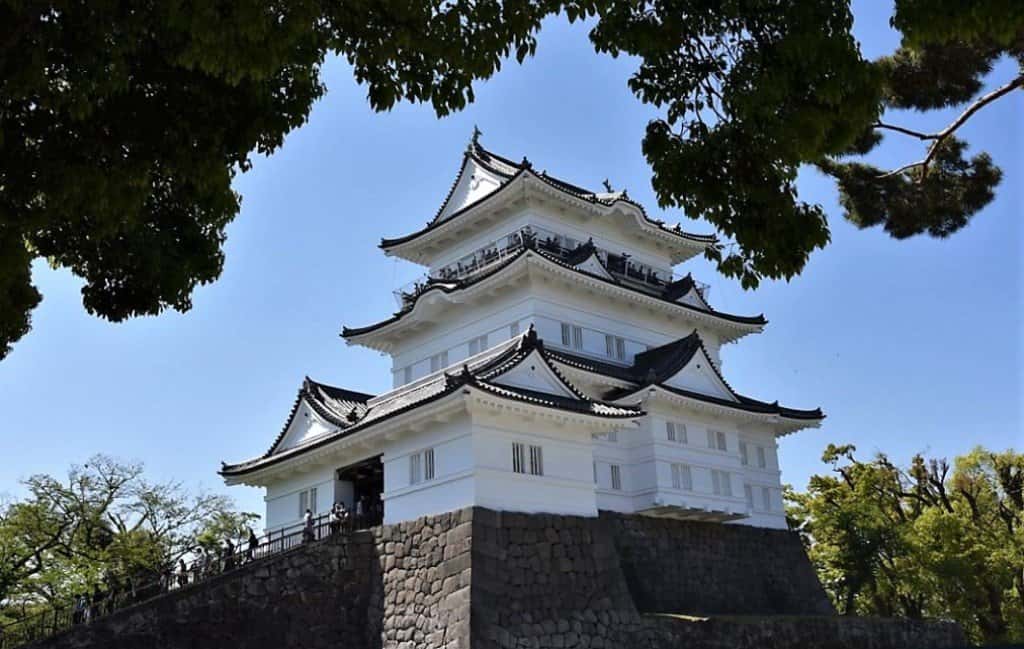
Odawara Castle / Tokyo to Hakone Day Trip
Odawara Castle was an impregnable castle owned by the fifth daimyo of the Hojo clan , the samurai family that governed Kanto area for about a century from the end of the 15th century. It functioned as a cornerstone of defense for Hakone.
The current castle tower was rebuilt in 1960.
This three-layered, four-story castle tower has a tsuke-yagura (connecting tower) and watari-yagura (hall turrets) on the top. Make sure to go to the top floor of the tower and enjoy a full view of Sagami Bay.
In addition, don’t miss Tokiwagi Gate Samurai museum. The exhibition truly captures the artistry of the samurai armor and the spirit of the samurai.
I would recommend getting a 3-Hall Common Ticket that covers the Castle Tower, Tokiwagi Gate, and Odawara Castle Historical Observations Hall. However, if you are limited on time, then make sure to at least visit the Castle Tower.
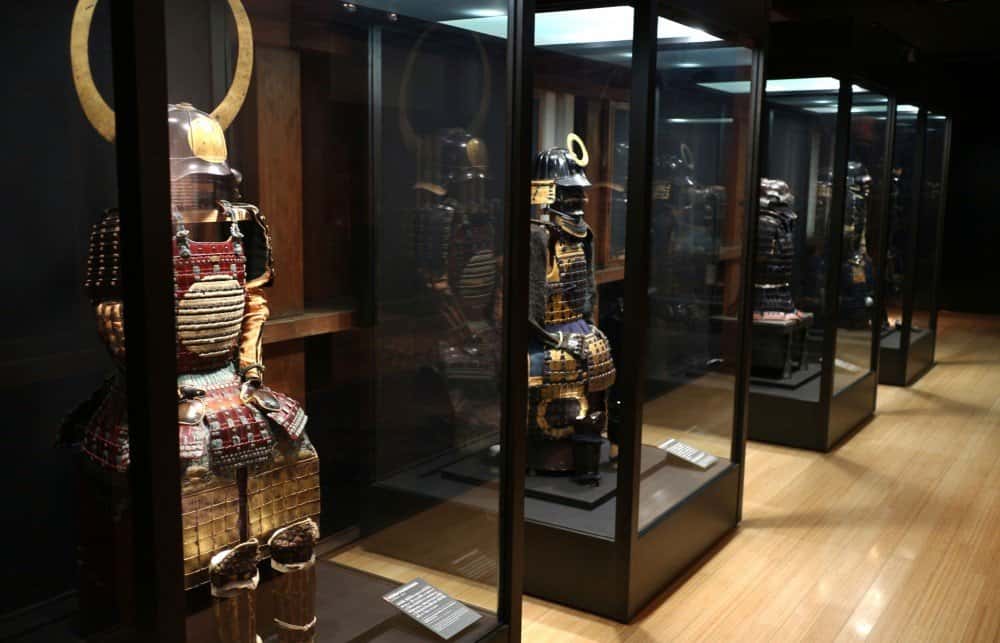
Tokiwagi Gate Samurai Museum / Tokyo to Hakone Day Trip
Once you are done exploring Odawara Castle head back to Odawara Station. Next, take Odakyu Line Train to Hakone-Yumoto Station.
Finally, from Hakone-Yumoto Station take Hakone Tozan Train and get off at Stop OH56 – Chokoku-no-mori Station. It takes about 30 minutes to get to Chokoku-no-mori Station. Your next stop will be Hakone Open-Air Museum!
However, what you need to know is that a ride on Hakone Tozan Train , Japan’s oldest mountain railway, is a treat for more than just railway fans!
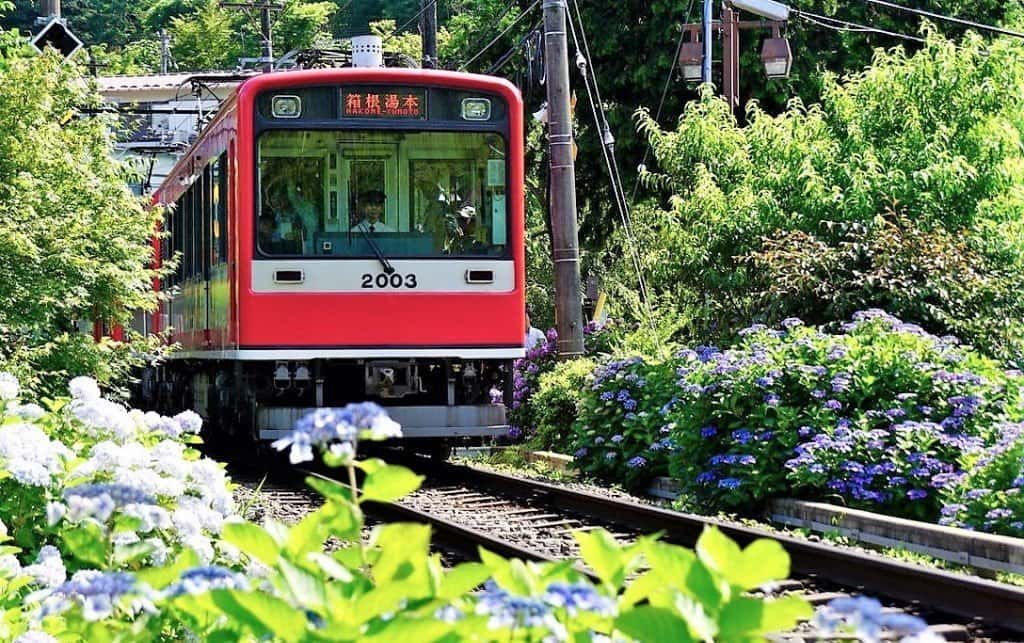
Hakone Tozan Train / Tokyo to Hakone Day Trip
The Hakone Tozan Train is built to climb steep mountain slopes. It winds through narrow, densely wooded valleys, over many bridges and tunnels, stopping at small stations along the way and changing directions at three switchbacks.
The ride on the Hakone Tozan Train is especially beautiful in June and July when thousands of hydrangea are in bloom along the tracks.
Special trains run from mid-June through mid-July between Hakone-Yumoto and Gora Stations for the viewing of the illuminated flowers. They depart in the evenings, twice in each direction, and require seat reservations.
My favorite moment on the train is when it passes over the 43-meter-high Deyama Bridge . If you happen to be visiting in the fall, you will be amazed by the scenery!
Explore Hakone Open-Air Museum
Once you get to Chokoku-no-mori Station follow the signs for Hakone Open-Air Museum . It is no more than a 10-minute walk from the station.
Hakone Open Air Museum is a world-class open-air gallery and you should not miss it on this day trip to Hakone! It covers an area of 70,000 square meters of beautiful lawns and gardens surrounded by forested hills.
Its collections include some of the world’s most significant sculptures and works of art of the late 19th and 20th centuries by Western and Japanese artists.
However, many pieces of art at designed for kids to climb and explore , so the day trip to Hakone and the visit to Hakone Open Air Museum could be a lot of fun for the entire family. In addition, Hakone Open Air Museum has an outdoor foot bath . How cool is that!
The most notable of the indoor exhibits is a collection of Pablo Picasso’s creations. It includes more than 300 of Picasso’s works, comprising oil paintings, prints, sculptures, ceramics, and gold objects.
One of the most popular pieces at Hakone Open Air Museum is the Symphonic Sculpture by Gabriel Loire.
Symphonic Sculpture is a tower enclosed by colorful stained glass. Furthermore, inside the stain-glass tower is an 18-meter tall circular staircase that you can ascend all the way up to the viewing platform.
Sphere Within Sphere by Arnaldo Pomodoro is one of the more famous designs at Hakone Open Air Museum.
Actually, there are other spheres made by Arnaldo Pomodoro. They are located all over the world.
The surface of the sphere is brightly polished and can be spotted from a far distance gleaming in the sun. As you come closer, you notice that there is a tear in the perfect orb. It looks like a part of it was either ripped out or torn away. The tear exposes the interior with another sphere inside.
The opening hours are 9 am to 5 pm. Moreover, the last admission is at 4:30 pm.
The entrance ticket costs 1,600 yen, however, if you have the Hakone Free Pass , then you can purchase a discounted ticket for 1,400 yen.
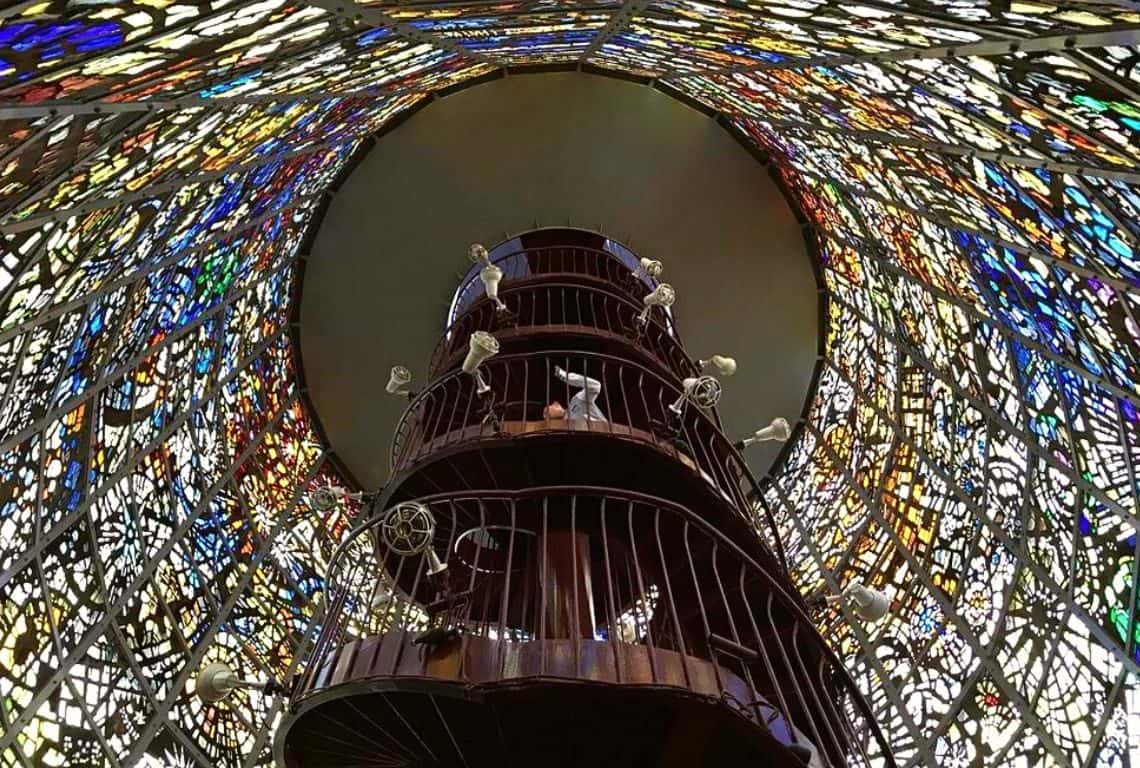
Hakone Open-Air Museum / Tokyo to Hakone Day Trip
Continuing on, jump back on Hakone Tozan Train and get off at Gora Station . It will be no more than a 10-minute ride. Next, from Gora hop on Hakone Tozan Cablecar and get off at Sounzan . It will take you about 10-15 minutes to get there.
And finally, from Sounzan take Hakone Tozan Ropeway and get off at Owakudani . It is no more than a 10-15 minute ride.
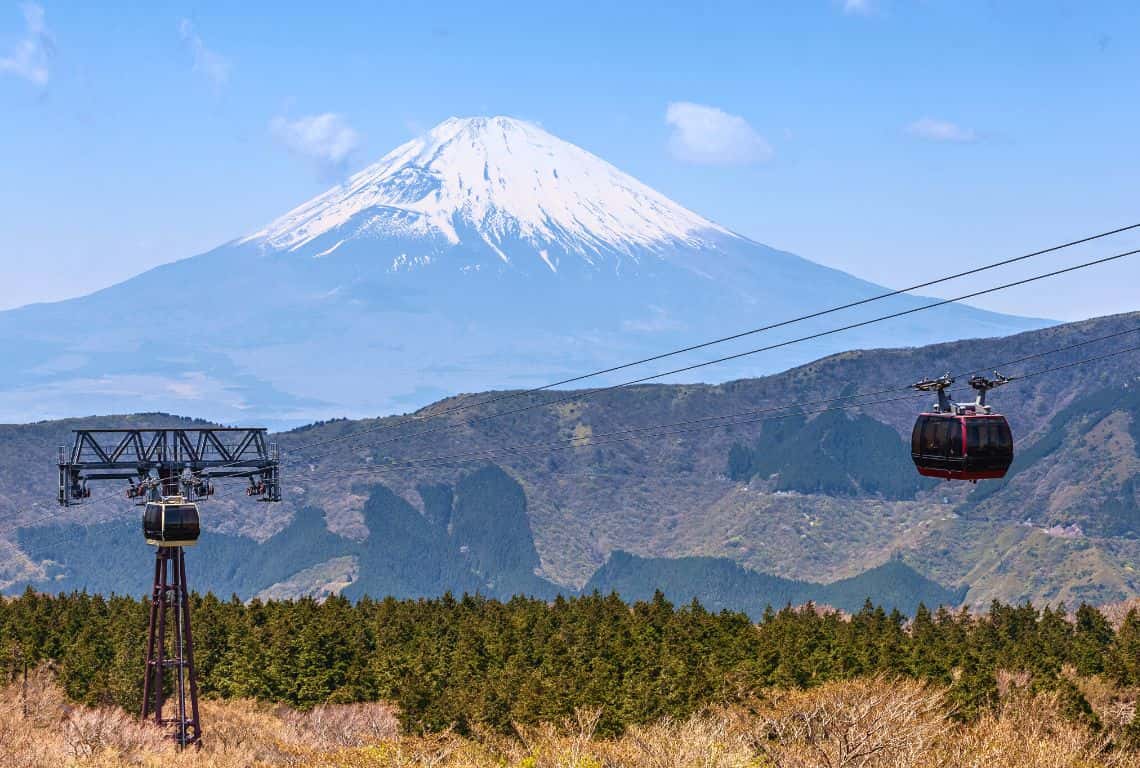
Hakone Ropeway / Tokyo to Hakone Day Trip
Take the Ropeway to Owakudani (Hell Valley)
Owakudani is known as ‘the Great Boiling Valley’ or ‘Hell Valley’. Specifically, it is a large volcanic crater formed 3,000 years ago following an eruption of Mount Hakone.
Owakudani still remains an active volcanic region. It has hot springs, boiling pools of water, and huge vents spewing hot steam and fumes. You will be able to smell the volcanic fumes of sulfur from far away. The fumes have an unmistakable scent of rotten eggs.
Owakudani Valley in Hakone / Tokyo to Hakone Day Trip
Interestingly enough, tourists flock to this area seeking the f amous Owakudani black eggs or ‘kuro-tamago’.
Owakudani black eggs or “Kuro-tamago” are basically hard boiled chicken eggs in the Owakudani’s hot water pools.
The sulfur in the water turns the eggshell black, however, the inside still looks like a normal hard-boiled egg.
Legend has it that eating just one egg will extend your life by 7 years. Incidentally, there is an addendum to the legend that says that you should not eat more than two of these eggs. So, there is no chance here of becoming immortal.
But, If you are looking for original souvenirs , I think that getting some eggs as a gift with a promise of life extension might be pretty sleek.
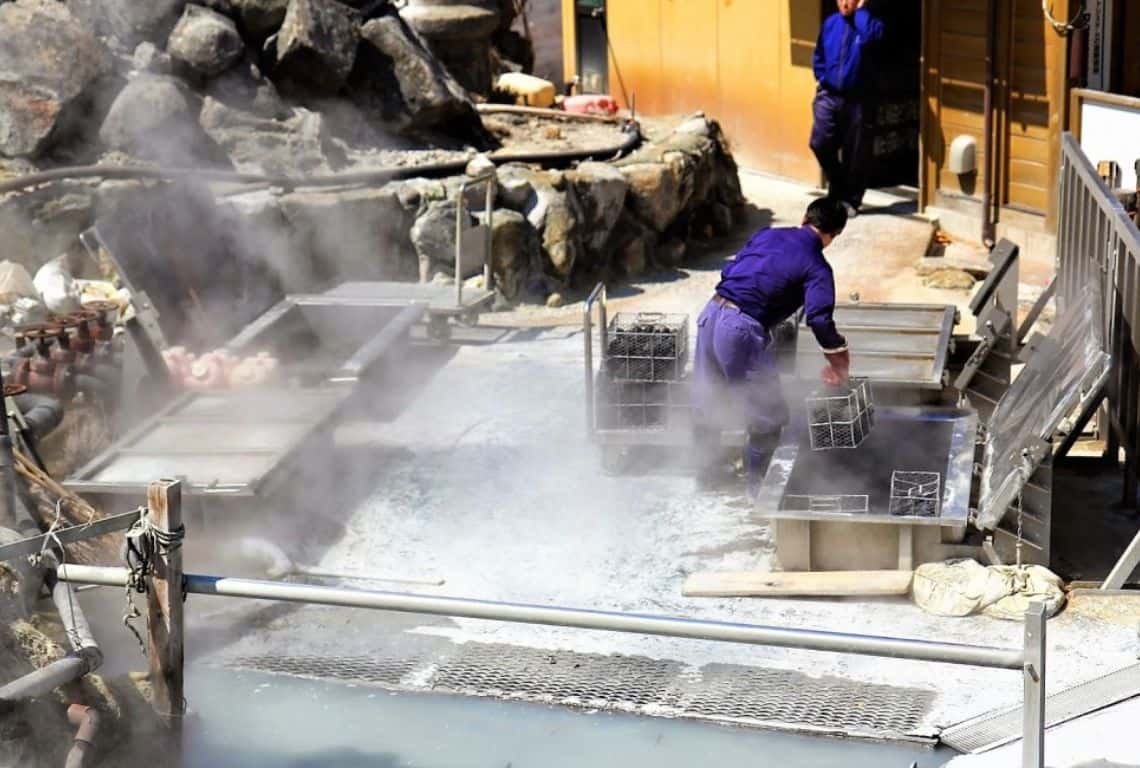
Owakudani BLack Eggs / Tokyo to Hakone Day Trip
After you are done exploring Owakudani hop back on Hakone Tozan Ropeway and get off at Togendai-ko . Be on the lookout for Mt Fuji and make sure to take one final glance at Owakudani.
By the way, if you have Hakone Free Pass, then the cost of the Hakone Tozan ropeway will be covered by the pass.
Once you reach Togendai-ko, follow the signs for Hakone Sightseeing Cruise on Lake Ashi.
Go on Hakone Sightseeing Cruise on Lake Ashi
The Sightseeing Cruises leave every 20 minutes from Togendai-ko and last about 30-40 minutes.
To be honest, the cruise on Lake Ashi is my favorite part of the day trip to Hakone. The scenery is breathtaking no matter what time of the year you visit.
In addition, Lake Ashi is really well known for the inverted reflection of Mt. Fuji. And, here, hopefully, you will get another chance to catch a glimpse of Mt Fuji.
Did you know that Lake Ashi is a crater lake created by a phreatic (stem and minerals) eruption 3000 years ago? It sits at 725 meters (2,378 feet) above sea level. Lake Ashi has a circumference of 21 km (11 miles). It abounds in black bass and trout.
The sightseeing cruise stops at two ports. The first port is Hakone Machi-ko and the second port is Moto-Hakone-ko. Make sure to get off at the first stop which is Hakone Machi-ko . Next, follow the signs for Hakone Checkpoint .
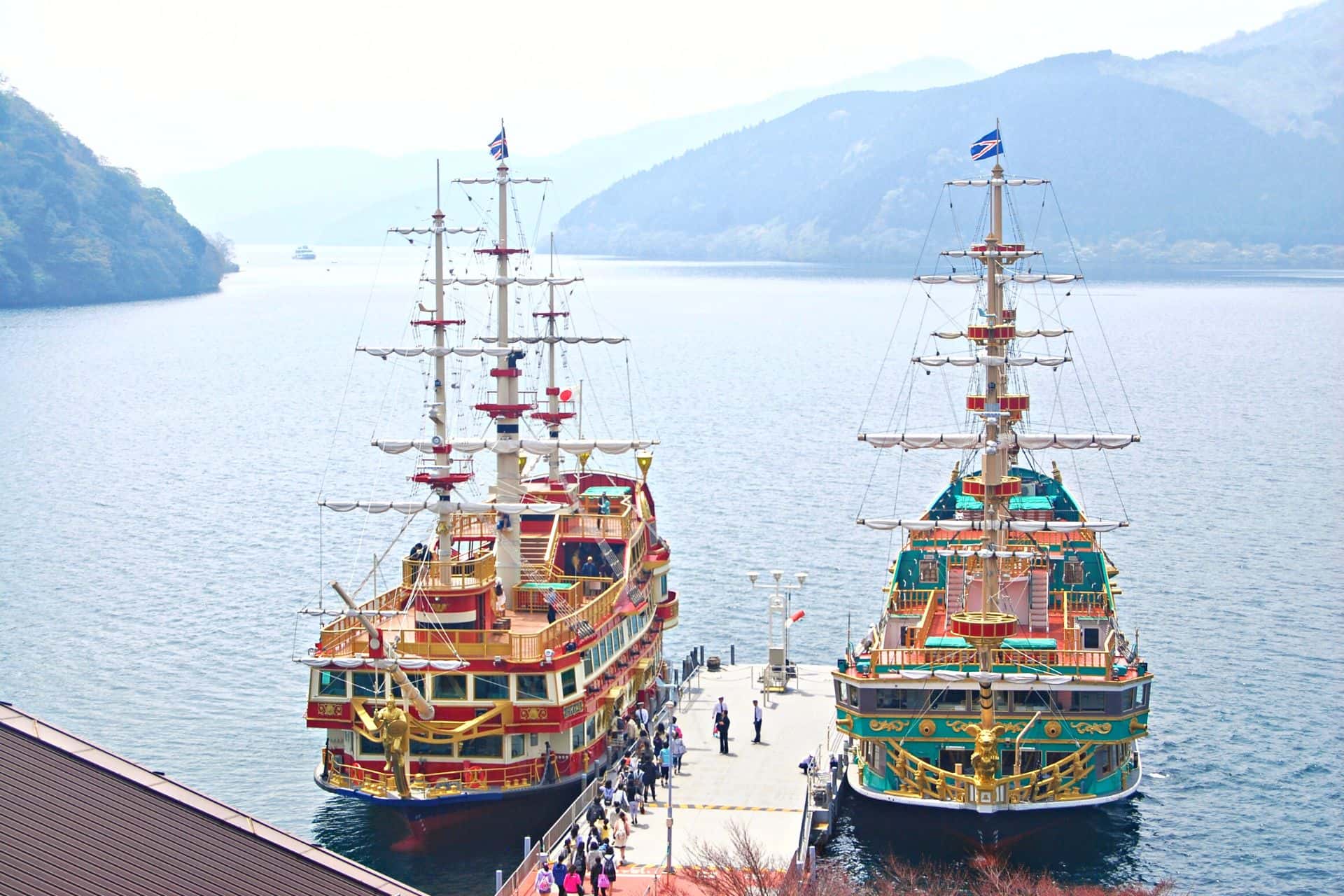
Hakone Sightseeing Cruise on Lake Ashi / Tokyo to Hakone Day Trip
Learn About Hakone's History at Famous Hakone Checkpoint
Hakone Checkpoint and Hakone Sekisho Exhibition Hall are about a 10-minute walk from Hakone Machi-ko port.
I find this part of a day trip to Hakone the most interesting. I love history and this area has so many stories to tell.
During the Edo period, a nationwide road network was developed in Japan. Along with the development of roads came many ‘sekisho’, which are checkpoints. The purpose of the checkpoints was to inspect the travelers and their loads .
Hakone Sekisho was one of the most important checkpoints that safeguarded the security of Edo (now Tokyo) as the seat of the Shogunate.
Once you reach Hakone Checkpoint, you will be able to see a historically accurate restoration of the original checkpoint.
Do not miss Hakone Sekisho Exhibition Hall . It displays many artifacts of the Edo period, such as travel certificates, officials’ diaries, and samurai weaponry.
The opening hours are 9 am to 5 pm and the last entry is at 4:30 pm. Moreover, the entrance fee is 500 yen, however, if you have the Hakone Free Pass, then you can purchase a discounted ticket for 450 yen.
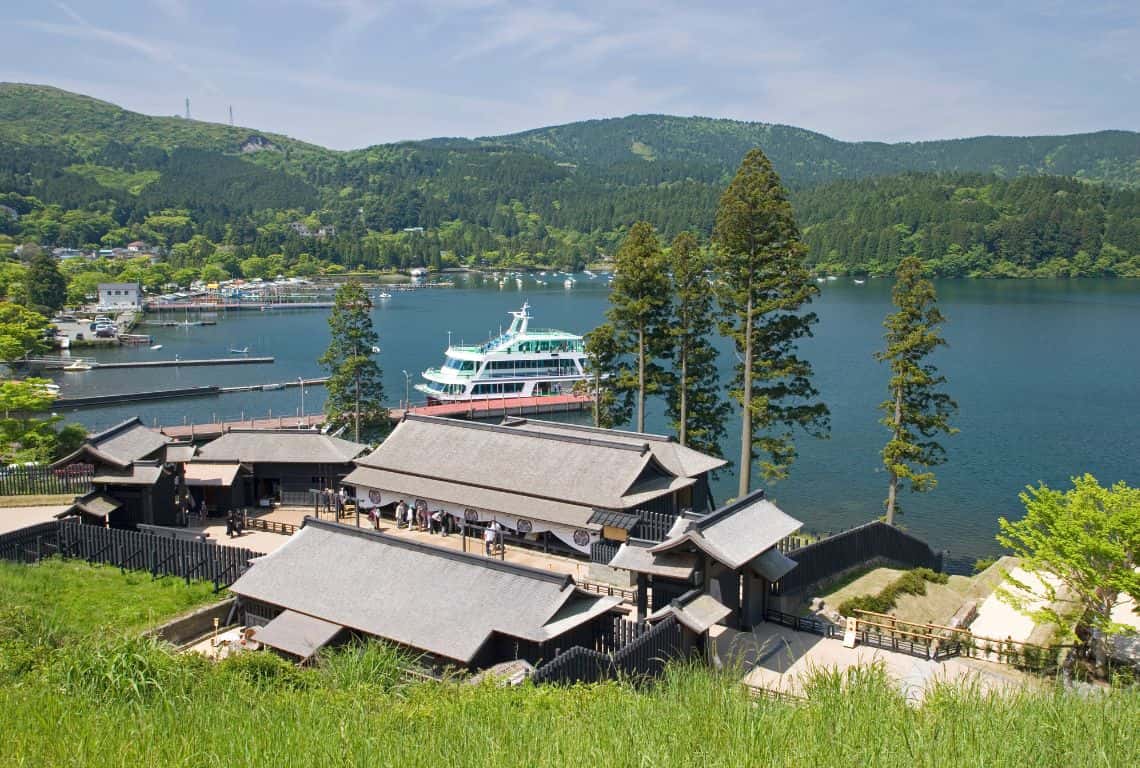
Hakone Checkpoint and Hakone Sekisho Exhibition Hall / Tokyo to Hakone Day Trip
Take a Leisurely Stroll on Ancient Cedar Avenue
I have to honestly say that Ancient Cedar Avenue is my second favorite part of the day trip to Hakone (right after the cruise on lake Ashi).
Ancient Cedar Avenue stretches for about two kilometers. It is an absolute delight to walk under the cedars planted over 400 years ago and enjoy the shade they give travelers.
Here you can get great views of Lake Ashi and Mt Fuji as well.
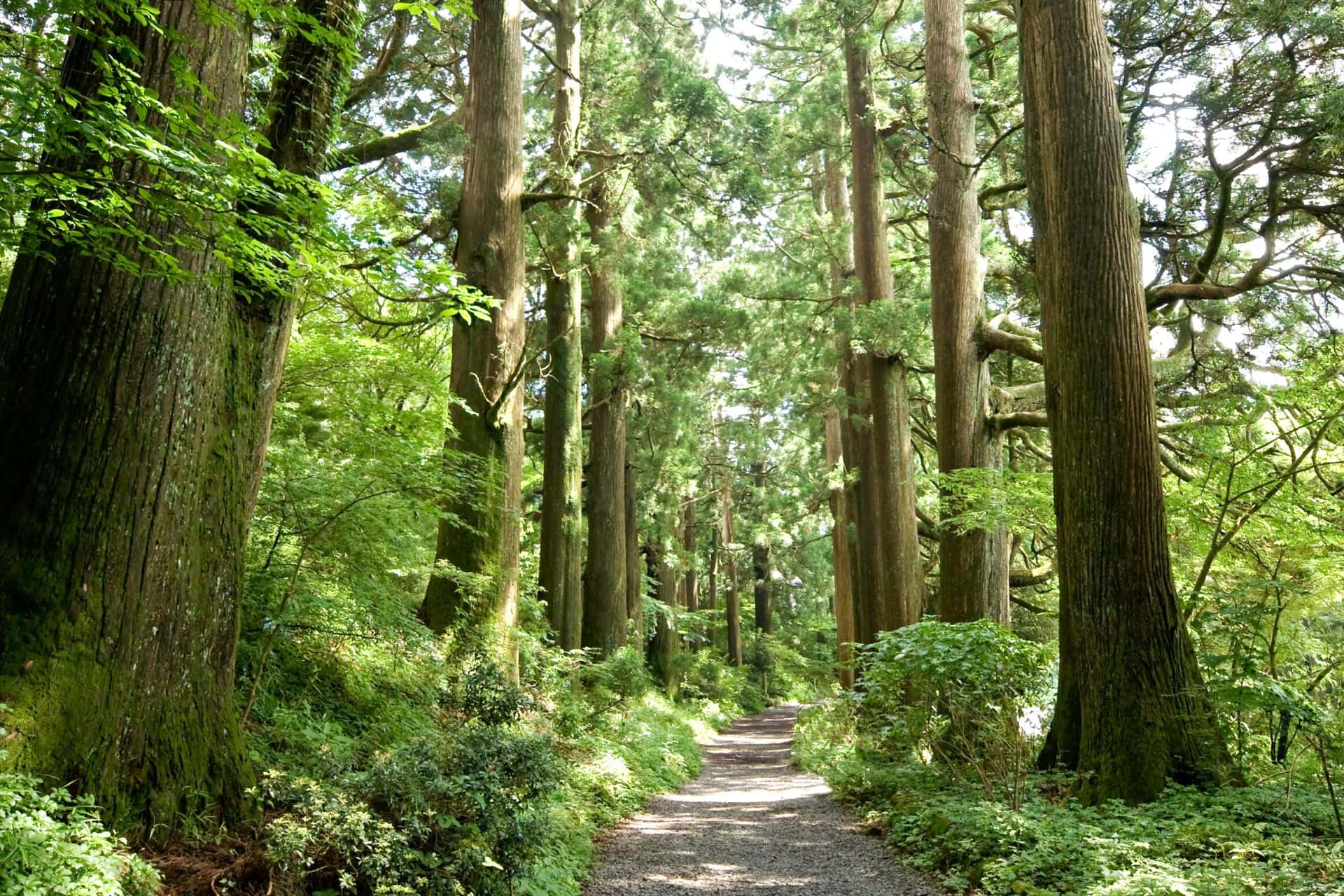
Ancient Cedar Avenue in Hakone / Tokyo to Hakone Day Trip
Visit Spectacular Hakone-jinja Shrine
Next, continue your stroll and follow the signs for Hakone-jinja Shrine .
The shrine was founded in 757 and it was where Tokugawa and other samurai families worshiped.
I have to say that of all the shrines I visited in Japan, this shrine is situated in the most visually captivating setting I have ever been to.
The road leading to it will give you many opportunities to capture some breathtaking pictures.
However, the main tourist attraction here is the vermilion-colored torii . Here, tourists line up to take some great pictures of lake Ashi framed by torii.
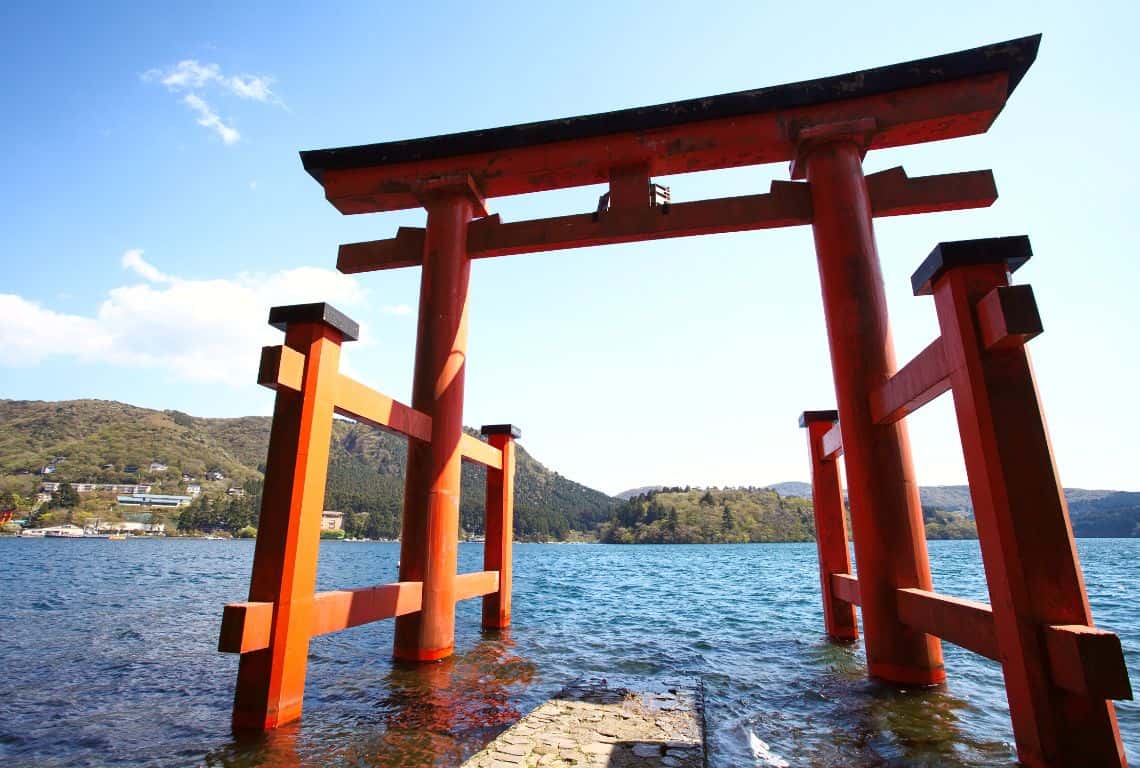
This is the end of the sightseeing loop and now it is time to get back to Tokyo.
The first step is to take Bus K–Hakone Tozan Bus from Moto Hakone-ko to Hakone-Yumoto . Or, you can take bus R which operates Saturdays, Sundays, and public holidays only. The bus ride is about one hour.
Once you get to Hakone-Yumoto , then you need either catch the Romancecar directly to Shinjuku Station in Tokyo or take the Odakyu Line to Odawara and then continue from Odawara to Tokyo Station .
Intrepid Scout's Tips for Tokyo to Hakone Day Trip
This is quite a list, right? What if you had time to do just a couple of things? Ok, no problem. Here are my recommendations of the absolute top things to do in Hakone:
- Take the ropeway – you will love it! The views of the Owakudani Valley are awesome and I do hope that you get to see Mt Fuji.
- Do not miss the cruise on Lake Ashi – the scenery is stunning no matter when you are visiting!
More Information About Japan:
Amazing 3 DAYS in TOKYO (Thrilling Itinerary with 21 Stops)
14 Amazing Things to Do in Arashiyama (Map+Useful Tips)
Amazing Fushimi Inari Taisha in Kyoto (8 Things to Know Before You Visit)
Perfect Day Trip to Miyajima from Kyoto, Osaka, or Hiroshima
10 Amazing Things to Do in Hiroshima You Can’t Miss of Your Visit
Perfect One Day in Kanazawa – 7 Things to Do (Great Day Trip from Tokyo, Kyoto, or Osaka)
Read All the Posts About Japan in:
Japan Travel Guide

Did You Find Tokyo to Hakone Day Trip Useful?
Why not save it to your pinterest board.
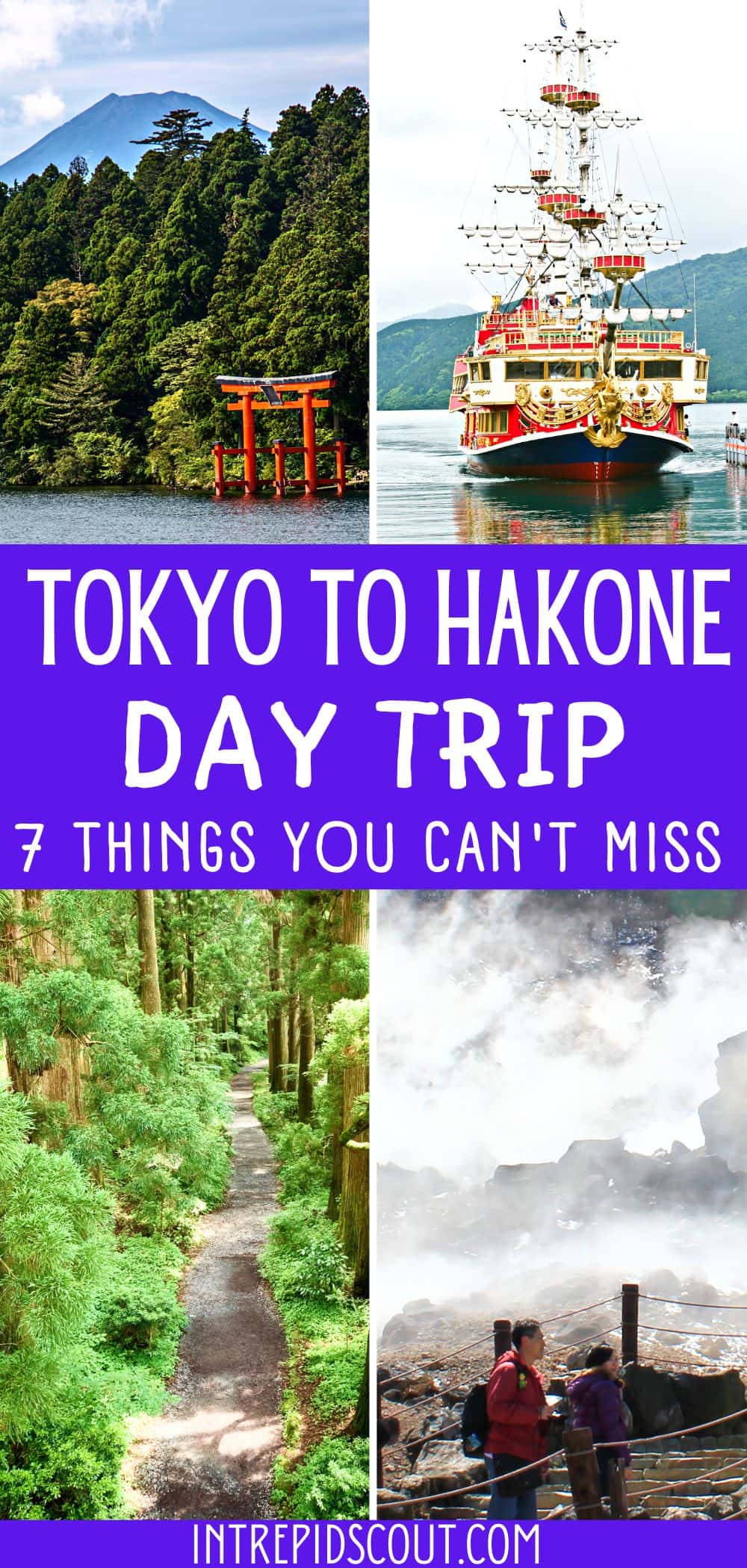
Now, It Is Your Turn, I Would Like to Hear Back from You!
Are you planning your trip to Hakone?
Please let me know! Drop me a quick comment right below!
Click on any of the images below to get inspired and to help you with the planning process for your trip to Japan!
- alert('URL copied to clipboard.')).catch(err => console.error('Unable to copy to clipboard.', err))">
Share via Email
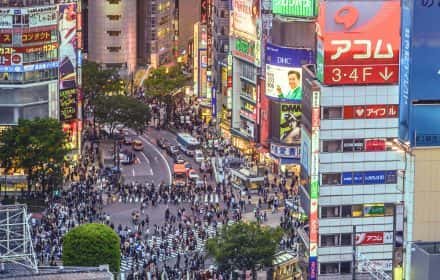
Easy DIY Shibuya and Harajuku Walking Tour (11 Best Stops+Maps+Tips)
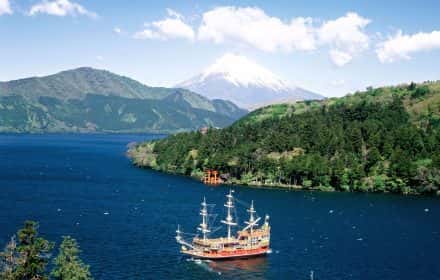
19 Amazing THINGS to DO in HAKONE (Useful Maps+Photos+Practical Tips)
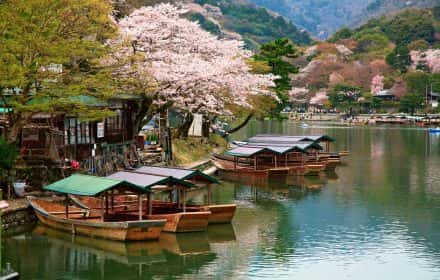
7 Fun and Easy Trips from Kyoto (Maps+Useful Tips)
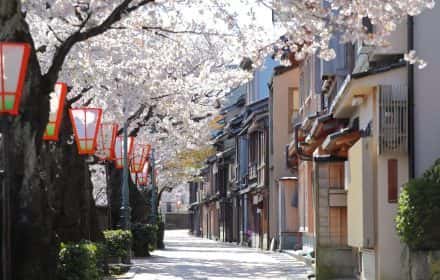
Perfect ONE DAY in KANAZAWA - 7 Things to Do (BEST TRIP from Tokyo, Kyoto, or Osaka)
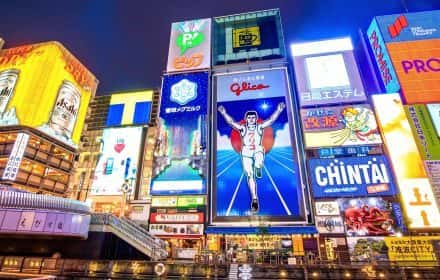
Perfect ONE DAY in NARA - 6 Things You Can't Miss (Maps+Useful Tips)
@intrepid.scout
10 thoughts on “ Tokyo to Hakone Day Trip (7 Fun Things You Can’t Miss) ”
Hi Anna, Thank you so much for this, we will be going to Japan next year and it is difficult to find posts with such detail with regards to sightseeing. We will be staying one night in Hakone then on to Takayama.
Hi Phil, Thank you for your kind comment. I am so glad you found my article useful. If this is your first visit to Hakone, then you will find the entire area very charming and abundant with variety of things to do for every taste. I hope you had a chance to review my other post on Hakone, where I listed 19 Unmissable Things to Do in Hakone. It goes over everything there is to do and see. It might give you a couple more ideas to add to your itinerary.
Thanks for sharing. Japan is amazing place for a great vacation with the kids.
Hi, Thank you so much for your comment! Are you traveling to Japan soon? Or, have you just visited?
I love this this great article! We are in Tokyo and have been looking for good instructions to make the trip to Hakone. I visited the open air museum in 1972 when I was 9 and have always hoped to go back. With your helpful information we are making arrangements! Thank you so much!!
Hi Peggy, I am beyond happy that you find my article useful! Have a great time in Hakone and let me know if I can be of further assistance! Anna
Thanks so much for laying this all out so well. Have been going back and forth on doing this day trip in April, but definitely adding it to our list now! About what time do you think you’d head back to Tokyo following this method? Also any recommendations for where/when on this itinerary to eat?
Hi Emily, Going to Hakone takes an entire day. Go as early as possible and plan on staying as long as you can, meaning, if it starting getting dark, then it is time to head back. Wherever I go, I start as early as possible, and I stay as long as I can. You are going in April, so the days will start getting longer. As far as lunch, there is always some options for a quick bite. Again, I am a type of a traveler that has a few protein bars in the backpack also a cup of tea and or coffee would carry me on as well. The entire Hakone area is so beautiful. April will be just lovely! Enjoy!
Realmente interessante. Adorei o post e veio em otima hora pois estou preparando minha viagem para outubro. Tinhamos tudo reservado para abril mas a pandemia mudou todos os planos. Vou seguir tuas recomendações a risca. Muito lindo brigada pelas dicas.
Thank you so much for your kind comment! I hope your trip works out in October. I had to change many of my plans as well. By the way, I used google translate and it detected Portuguese. Are you from Portugal? If yes, then I just want to say that I went to Portugal many years ago and I truly loved this beautiful country.
Leave an answer Cancel reply
Your email address will not be published. Required fields are marked *
The company processes your data to facilitate the publication and management of comments. You can exercise your rights of access, rectification, deletion and objection, among others, according to our Privacy policy .
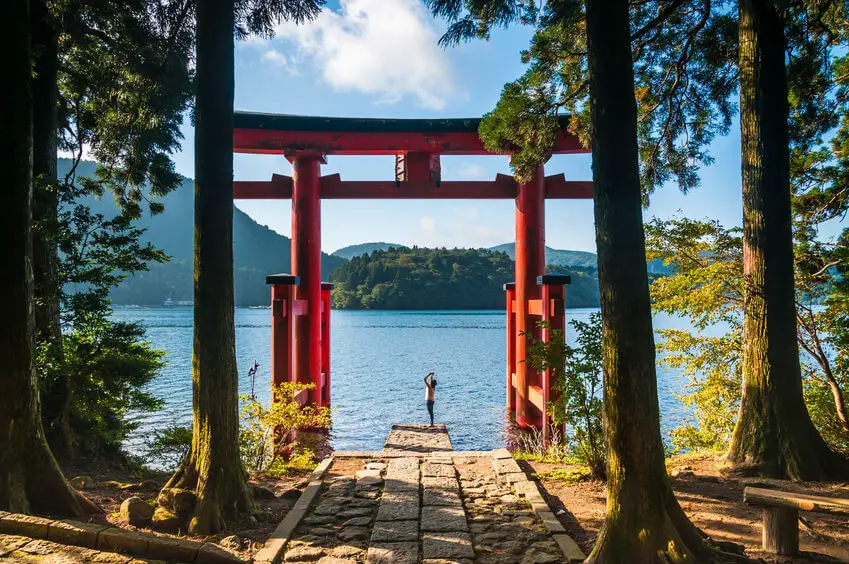
The ultimate Tokyo Day Trip to Hakone – Travel Guide and Detailed Itinerary
If you have a couple of spare days left in your itinerary and aren’t quite ready to leave Tokyo just yet, then we would suggest that you take a daytrip to Hakone.
We love a day trip, it’s like a miniature holiday during a holiday. And there so many areas near Tokyo that are worth an excursion. You could get a close-up view of Mount Fuji from the Five Lakes area. You could get to know one of Japan ’s most loved TV characters in Shibamata. Or you could take a trip back in time to Kawagoe. But as a first-time Tokyo visitor, we highly recommend you spend your day outside of Tokyo immersed in nature in iconic Hakone.
Hakone (箱根) located 100 kilometres North of Tokyo, is part of the Fuji-Hakone-Izu National Park. It is particularly famous for its hot springs, natural beauty, staggering amount of onsen day spas and the potential to catch a glimpse of nearby Mount Fuji.
OUR SUGGESTED ITINERARY FOR THE PERFECT TOKYO DAY TRIP TO HAKONE
Below is the itinerary we roughly followed when we visited Hakone during our first trip to Japan . It pretty much follows the Hakone Loop in a clockwise direction. This worked well for us. But feel free to flip the itinerary on its head and add or subtract places as you like.
The itinerary heavily relies on Hakone’s public transport and assumes that you did purchase a Hakone Pass. Make sure to check the status of all Hakone Transport before your trip. Due to the volcanic nature of the area, it can happen that certain routes are temporarily closed. So, you need to remain flexible.
Also make sure to pop on some comfortable shoes, there will be some hiking involved.
7:38AM – TRAVEL FROM SHINJUKU TO HAKONE-YUMOTO STATION
Start your day bright and early at Shinjuku Station. We recommend you take one of the earliest trains departing from Shinjuku and aim to arrive in Hakone-Yumoto no later than 10.30am. This way you will have ample time to explore Hakone at your own pace.
If you haven’t done so already, pick-up your Hakone Pass, then find the Odakyu Line or the Romance Car. Make sure to tap out your SUICA / IC card and get your Hakone Pass stamped at the manned gantries.
If you have an active JR Pass take the Shinkansen train to Odawara instead. You can then use your Hakone Free Pass for the rest of your journey.
The journey from Shinjuku Station to Odawara Station should take about 89 minutes.
In Odawara Station board the Hakonetozan Line train and travel to Hakone Yumoto Station. This should take another 17 minutes, after which you have finally arrived.
If you can, choose a seat on the right side of the train, to catch a glimpse of Mount Fuji!
9.30AM – ARRIVE AT HAKONE YAMOTE STATION
Most daytrips to Hakone start in the rural town Hakone Yamote. Your train should arrive here around 10.20am. Head towards the exit and explore the town. You can either start your day here or end it here with a relaxing soak and dinner like we did.
Hakone Yamote has one main street that runs past the station and is lined with old buildings, restaurants and shops. If you haven’t had breakfast yet, this is a good place to grab something.
A river runs parallel to it. You can follow it, to the Tamadare waterfall and Shogenji Temple
10.00AM – TAKE THE BUS FROM HAKONE YAMOTE TO MOTOHAKONE-KO
Just opposite to the train station is the bus station. Hakone has an extensive bus network and most busses that run in the Hakone area stop here. In fact, you might find a large crowd of people waiting here for their bus. The staff manning the bus stops don’t typically speak English, but should at least be able to direct you to the correct bus line nonetheless.
Get on the bus heading to Hakone-jinja-iriguchi, or Motohakone-ko. When we visited Hakone buses for those destinations were located at Stop 4. Buses leave frequently. Try to grab a seat if you can, the journey to Lake Ashinoko from Hakone-Yumoto take about 35 minutes.
Note that in Japan you board the bus from the back. We would also advise you find your day pass or money whilst you are waiting in line. Bus drivers need to ensure everything runs on time and will therefore have little patience for you if you are fumbling around in your pockets.
ITINERARY TIP
You can board a bus to Hakone Machi instead, then follow the next part of the itinerary in reverse order – visit Hakone Checkpoint, then walk along Tokaido Highway to Hakone Jinja Shrine and board a sightseeing cruise in Moto-Hakone. It is your choice.
10.35 AM – EXPLORE LAKE ASHINOKO
Disembark your bus in Moto-Hakone. The bus should stop near the ferry terminal, right on the shore of Lake Ashinoko (芦ノ湖). Lake Ashinoko is the heart of Hakone and one of the five famous lakes in the Fuji-izu region. The lake was formed in the caldera of Mount Hakone after the volcano’s last eruption over 3000 years ago.
Hakone has gained a reputation for its views of Mount Fuji and Moto-Hakone has some of the best views in the area, especially on cloudless days. In fact, the symbol of Hakone is Lake Ashinoko with Mount Fuji in the background. So if you are lucky you might catch a glimpse of the tip of Mount Fuji as you walk around the lake. Visibility tends to be best early in the morning or late in the afternoon during the colder seasons.
But there are plenty of other activities and attractions around Lake Ashi. For one there is the famous Hakone Shrine to which you will be heading next. A little further along is Hakone Check point. And another great place to visit near the lake is Onshi Hakone Park.
Lake Ashi is also a great place to go hiking, with plenty of path that run along its shores. In fact, if you love hiking and are staying in Hakone for a few days, you could actually follow the trail all the way from Hakone-Yumoto to Moto-Hakone, instead of taking the bus. The route takes about 1.5 hours to complete and passes by the 350-year-old teahouse Amazake-chaya, whose family have been serving travellers since the Edo period.
We wouldn’t suggest you take a day trip from Tokyo to Hakone if your main reason is to see Mount Fuji. There are better locations to see the famous volcano up close in the Fuji Five Lake area. Furthermore, the likelihood of you actually spotting the summit of Mt. Fuji is highly dependent on the weather.
10.55 AM – VISIT HAKONE JINJA SHRINE
5 minutes walk from previous location
Whilst you are in Moto-Hakone, you simply must visit Hakone Jinja Shrine (箱根神社), a famous Asian temple that sits at the foot of Mount Hakone, along the shores of Lake Ashinoko. It’s only a 5-minute walk from where you got off the bus.
Cross the road at the bus stop then start walking anti-clockwise around the Lake towards the mountains (with the shore on your left).
Although the shrine is hidden in the dense forest, its location is marked by a Huge Torii Gate that stands proudly in the Lake. A path leads from the Torii gate up a series of steps, flanked by beautiful lanterns that light the way and huge cedar trees. The cedar trees are more than 800 years old and create an atmosphere of wonder and beauty.
Explore the over 1200 year old shrine. Hakone Jinja is a Japanese Shinto shrine that was founded in 757 during the reign of Emperor Kōshō and worshipped by the Tokugawa Family. The original Hakone Shrine actually sat at the summit of Komagatake, one of Mount Hakone’s multiple peaks. It was then relocated in its current location and form in 1667. Hakone Jinja Shrine is particularly popular among Japanese women, as visiting it is said to bless your marriage. The shrine features a cedar tree decorate with sacred straw ropes, is said to be a symbol for an easy delivery when giving birth. There is also a small museum where five items regarded as national Important Cultural Property are displayed. Admission to this museum is discounted with the Hakone Freepass.
Once you are done exploring the shrine, head back down the steps towards the lake and the floating Peace Shrine Gate. This must be one of the most iconic sights in Hakone and there is usually a line of people around it waiting to take a selfie. In fact, it’s probably more famous than the shrine itself. This Torii gate is pretty much a smaller version of the one on Miyajima Island.
Hakone Jinja has to be one of the most atmospheric shrines we visited in our two weeks in Japan. It is a beautiful shrine at any time of the year, but especially in the rain or when shrouded in mist.
OPENING TIMES: 8.00am to 5.00 pm (March-September) 8.00am to 4.30 pm (October to February)
CLOSED ON: Open all year round
ENTRANCE FEE: free
Before entering a Shinto Shrine it is customary to purify yourself at the water fountain. Fill the ladle with water and pour it over your left hand, then wash your right hand and final rinse your mouth. Place the ladle back and you have completed the Temizu Ritual.
To pay your respect at a Shinto Shrine, start by bowing, gently toss in a coin, ring the bell twice, bow twice, followed by two claps with the left hand slightly in front, make a prayer, then end with a final bow.
11.25PM – HEAD DOWN TOKAIDO HIGHWAY CEDAR AVENUE
30 minutes walk from previous location
From Hakone Shrine head back to Moto-Hakone and then down the path in the opposite direction towards Hakone-Machi. This time Lake Ashi should be on your right-hand side. This will lead you to the Tokaido Highway, or what is left of it.
During the Edo period, Hakone was located on one of the five main highways that connected Tokyo to Kyoto. Not much of the original highway remains these days, but you can walk along an original section of it on the way to your next destination.
Known as Tokaido Highway Cedar Avenue, the 500-meter-long path runs along the shore of Lake Ashi and is flanked by century old cedars. These were planted along the old Takaido road to protect travellers from the weather. Some of the trees are up to 3 meter high with a diameter of over 4 meters. This section of the highway still has its original stone pavement.
It will only take 3 minutes from the boat pier of Moto-Hakone to reach the start of Cedar Avenue. Once you spot a parking lot to your right, you have reached the end of the original Tokaido Highway.
At this point, you could explore Onshi Hakone Park or visit Sekisho Exhibition Hall, just factor this into the timing of the itinerary. The way to the barrier checkpoint and the small museum are clearly signposted.
11.55PM – GO BACK IN HISTORY AT HAKONE CHECKPOINT
30 minutes walk from Moto-Hakone
Continue skirting along the lake until you get to your next destination, Hakone Checkpoint. The walk here from Moto-Hakone, should take about 30 minutes, if you don’t stop en-route.
During the Edo period, Hakone checkpoint was an important stop on the Tokaido Highway. It was one of the largest and most important checkpoints at its time and controlled traffic between Tokyo to Kyoto. Among other functions, it ensured that weapons weren’t brought into Kyoto and prevented the wives of Lords from escaping Tokyo.
The current building is a replica of the original Hakone Checkpoint, but its location and style are pretty accurate to the one that existed during the Edo Period. Renovation works in 2007, restored the structure to be consistent with the original, including the gates, fencing, lookout point, housing for the foot soldiers and the prison.
You can pass through the checkpoint without going inside the building and this won’t cost you anything. But those interested in Japanese history, should definitely consider visiting the building and its exhibition hall. It is pretty fascinating to explore a Japanese checkpoint of the feudal period and you can even climb all the way up to the look-out tower.
OPENING TIMES: 9.00am to 5.00 pm (March-November) 9.00am to 4.30 pm (December to February)
ENTRANCE FEE: 500 yen (400 yen for Hakone Freepass Holders)
Judge whether you have enough time to visit Hakone Checkpoint, based on how late you are running in the morning and which other attractions you might want to see. You could for instance skip a visit to Hakone Open Air Museum in favour of Hakone Checkpoint. Or you could decide not to head into Moto-Hakone to see the Jinja Shrine
12.30PM – HAVE LUNCH IN HAKONE-MACHI
After a busy morning hiking, you might be getting hungry. So we suggest you refuel at this point. There are a decent number of restaurants in Hakone-Machi serving anything from ramen, to udon noodles, katsu curry, soba noodles and seafood rice bowls. Furthermore, there are far less options on the other side of the lake at Togendai.
We would suggest however that you check the timetable of the ferries and grab your ticket before you find a place to eat. That way you will know how much time you have and won’t be rushing your meal to catch the next ferry.
Consider having lunch at Daimasa, located merely 3 minutes away from Hakone Checkpoint. The restaurant specialises in sashimi sets and has an English menu. Plus the portions are very generous. To get here cross the main road and walk down the hill. Daimasa is on the left hand side.
If you are running late in the morning, you might want to consider taking a bus straight from Hakone Yumoto to Hakone Machi. This does however mean that you won’t be able to visit Hakone Shrine. You will need to satisfy yourself with seeing the famous Torii gate from afar from the deck of your sightseeing boat.
1.10PM – CRUISE ON A PIRATE SHIP FROM HAKONE MACHI TO TOGENDAI
Once you have had your fill of the south side of Lake Ashi, board a Hakone Sightseeing Boat to cross the lake to Togendai.
There are two different ferry lines on Lake Ashinoko. Whilst you were walking along the shore, you probably spotted three colourful “pirate ships” sailing across the lake. They are pretty hard to miss! Well, these are operated by the Hakone Sightseeing Boat company and accept the Hakone Free Pass. In fact, sailing on one of these slightly cheesy boats is completely free with the pass. The white passenger ships, on the other hand, are operated by Izuhakone Sightseeing Boats, and the Hakone Free Pass isn’t valid on them. It is far more fun to sail on a pirate ship anyway.
You can get on a Hakone Sightseeing Cruise from three locations. Either on the northern side at Togendai-ko or on the southern shore at Hakonemachi-ko or Motohakone-ko. The pirate ships leave one or twice an hour, so aim to get on the ship departing at 2.10pm. Be aware though that boarding starts ten minutes before and that Japanese don’t like to run late.
The “pirate ships” are actually meant to resemble English battleships. All three ships have a similar layout. If you easily get sea sick or refer to sit down, stay below deck. The best views of Lake Ashinoko however can be enjoyed from the open air-deck. If you are willing to pay an extra 500 yen, you can get tickets for the first-class area. First class passengers get their own open air deck at the front of the boat and plush couches indoors below deck. We would only recommend paying for first class tickets though, if you are visiting Hakone on a particularly busy day.
The boat ride from Hakone Machi to Togendai will take about 25 to 35 minutes, so there is plenty of time to get some beautiful pictures. Sailing across Lake Ashi on a clear day is one of the best ways to get a view of Mount Fuji from Hakone. But there are plenty of other great photo opportunities in this scenic location. Make sure to get a pretty shot of the iconic red floating Torii gate of Hakone Shrine.
OPENING TIMES: First ship departs at 9.30am, last ship departs at 4.20pm
CLOSED ON: The cruise will be cancelled in bad weather conditions
ENTRANCE FEE: 1000 yen for one way, 1500 yen for one way in first class, 1840 yen for a return ticket, 2610 yen for a first class return ticket (free unlimited journeys for Hakone Freepass Holders)
Departure times can vary depending on the season, so definitely check the timetable to ensure you don’t have to wait too long.
1.45PM – TAKE THE HAKONE ROPEWAY FROM TOGENDAI STATION TO SOUNZAN STATION
Once you have arrived in Togendai-Ko, immediately make your way to the Hakone Ropeway. There really isn’t much to see in Togendai, apart from the ferry terminal. You might spot a long queue at the ticket counter, but if you have a Hakone Pass, you can skip this and go straight to the boarding area.
The Hakone Cable Car runs between Togendai Station and Sōunzan Station and the entire journey takes about 30 minutes. Gondola’s depart every minute and can fit about ten people each. The carriages have huge windows, so this is a great way to get a birds-eye-view of the valley, Lake Ashi and the mountains that surround it. Take a good look at the geothermal landscape that surrounds you!
Because the ropeway runs through an active volcanic zone, you might be given a wet towel to cover your face and block out the sulphurous fumes. Don’t worry though, the fumes aren’t dangerous, they just have a slightly unpleasant smell of rotten eggs.
Note that the Hakone Ropeway actually has three separate sections. The first sections takes you from Togendai Station up to Ubako Station. The second section takes you from Ubako Station up to Owakudani Station. And the third section runs between Owakudani Station and Sōunzan Station. A transfer is only required at Owakudani Station. Depending on volcanic activity, you will want to get off in the middle anyway to explore Owakudani, before heading on to Sōunzan.
OPENING TIMES: 9.00am to 5.00pm (March to November), 9.00am to 4.30pm (December to February)
CLOSED ON: during bad weather and on days with strong volcanic activity
ENTRANCE FEE: 1480 yen one way (free with the Hakone Freepass)
If there is an increase in volcanic activity in the area, use of the cable car might get suspended. The entire area might even get shut down. This was the case when we visited Hakone. However, there is usually a replacement shuttle bus that you can take from Togendai station to Sōunzan Station, which is the most efficient way to get across the mountains in this scenario. Simply follow the signs for the shuttle bus and expect the ride to take about 10 minutes. This thus however sadly means, that you won’t be able to explore the next attraction – Owakudani. So make sure to check before your trip to Hakone.
2PM – EAT BLACK EGGS IN OWAKUDANI – THE VALLEY OF HELL
Since Hakone is famous for its hot springs, the Great Boiling Valley is definitely a must-visits on any Hakone tour. In fact, this next part of the itinerary will probably be a highlight of your Hakone itinerary. So, don’t skip it unless you are forced to by volcanic activity (like we were) or you have a respiratory condition.
Disembark your cable car at Owakudani (大涌谷), also known by locals as “Hell Valley”. The valley was created 3000 years ago, when the Hakone volcano exploded. It is still an active volcanic zone where you can peer down into a smoking abyss, where yellow sulfur is exposed above ground and experience the sulphurous fumes, hot springs and hot rivers of Mount Hakone.
It is also particularly popular with tourists because of its scenic views. On a clear day you will get an amazing scenic view of Mount Fuji. On an overcast day however, Fuji-san will be hiding in the clouds and you’ll never know it’s there. Don’t despair, the thick mist on such days give Owakudani a particularly dreamy atmosphere.
A ten-minute walking trail leads from the ropeway station to a number of steam vents and bubbling pools. At the start of this path you will spot the small buddhist Enmei Jizouson Temple. It marks the spot where Buddhist monk Kobo Daishi (who founded the Shingon sect in Japan) visited Owakudani over 1000 years ago, to pray for those suffering in the hell realms and placed a statue of the Bodhisattva Jizo.
Follow the path that leads to the peak of Mount Kamiyama until you reach the hot springs. Here you can watch eggs being cooked in batches in the steaming mineral-laden water. Known as Kuro-Tamago, the shell of the eggs turns black because of the reaction with the sulfur in the water. They are a local speciality and completely safe to consume. In fact, they are supposedly lucky and said to add 7 years to your lifespan. But apparently eating more than two is unlucky, so it’s not a great way to gain immortality. The eggs are sold in the souvenir shop. A set of five will set you back around 500 yen. Once you have peeled off the shell, the eggs look normal, and they taste like a standard hard-boiled eggs too. Another cheap snack you can buy in the souvenir shops are salty rice crackers roasted over a coal fire. If you have a sweet tooth you might want to try the black coloured vanilla ice-cream or the yellow eggnog flavoured ice-cream sold at the peak. There are also several Japanese restaurants in this area, in case you haven’t had lunch yet.
If you are feeling adventurous, you can follow one of the various side trails and hiking trails around Owakudani. The trail to the peak of Mount Kamiyama will take about two hours to complete.
OPENING TIMES: 9.00am to 4.00pm (determined by the operation hours of the Hakone Ropeway)
CLOSED ON: days with strong volcanic activity
ENTRANCE FEE: 500 yen for a set of five Kuro-Tamago
Access to some of the side trails and hiking trails is sometimes restricted because of noxious volcanic gases and volcanic activity. Sometimes the entire area around Owakudani is off-limits, even though the ropeway continues to run. So check the status of the area before you visit Hakone, if you have your heart set on seeing Owakudani.
2.45PM – RIDE ON THE TOZAN CABLECAR FROM SOUNZAN STATION TO GORA STATION
Once you have seen, smelled and tasted everything in Owakudani board the ropeway and head on to Sōunzan Station. Enjoy the scenic views then climb aboard the Tozan Cable Car and ride it down towards Gora Station.
The funicular is only a few carriages long and stepped on the inside to match the slope of the tracks. Although the Tozan Cable Car looks like a tram, it is in fact pulled up and lowered by a cable. The overall distance travelled from Sounzan to Gora is relatively short, the ride itself however is slow and takes about ten minutes in total.
It is a very pleasant way to travel between both locations, especially if you manage to get a seat near a window. The track is surrounded by greenery on either side and the views along it are stunning. In summer you will notice plenty of hydrangeas blossoming near the tracks and in autumn the foliage turns a fiery red.
The Hakone Cable Car makes several stops between Sounzan and Gora stations. If you wish to go to the Hakone Art Museum then you will need to get off at Koen-kami Station. If you want to see the Hakone Photography Museum then Koen-Shimo is the station you are looking for. Otherwise wait until you reach Gora Station before you alight.
OPENING TIMES: 8.25am to 6.20pm
ENTRANCE FEE: 430 yen one way (free unlimited rides for Hakone Freepass Holders)
Make sure to exit the Tozan Cable Car in the right direction. Not all stations offer an opportunity to cross to the other side. If you got out on the wrong side, you will need to wait for the cable car to stop at the station to be able to walk through it.
3.45PM – SPEND SOME TIME IN GORA
Return to the Tozan Cable Car or walk down the hill to Gora.
Gora is a small village and hillside hot spring resort in the mountains of Hakone. It is actually one of the more recently developed areas of Hakone and previously was nothing more than a barren wasteland of rocks. In fact, the name of the village comes from these rocks, that are said to resemble tortoise shells.
In the 1900s a hot spring was discovered in the area and several resorts were developed around it. The construction of the Tozan Railway line made it particularly popular with tourists. Gora has earned the nickname “the hot spring with five pastel shades” as it produces spring waters with different colours and alleged effects.
But there is more to Gora, than hot springs. You will find several attractions in this area, including the Hakone Museum of Art, Gora Park, and a ninja cafe.
If you have decided to stay in Hakone for more than one day, you might end up booking a hotel in this area. There are many inns located around the slopes of the cable car routes. We would suggest you choose one with onsen facilities. In this case you won’t have to follow this one day Hakone itinerary past Hakone Open Air Museum
STROLL THROUGH GORA PARK (OPTIONAL)
8 minutes walk from Gora Station
Gora Park (強羅公園) is a western style landscape park built into the steep slope of Gora. It is the perfect place to relax, unwind and enjoy the magnificent misty views across Hakone.
Inspired by French landscape gardens, Gora Park features a large fountain, rose garden and two Greenhouses. One of the greenhouses is filled with tropical flowers while the other contains the flower garden.
There is also a traditional Japanese Teahouse and a crafthouse where visitors can learn to blow glass, sandblast, make dried flower arrangements or create some pottery. Note that these activities will set you back an additional 1000 to 5000 yen.
Explore the park in a clockwise direction. We really enjoyed the tranquility of Gyoen Park. It isn’t as popular with tourists, so it almost felt like we had the entire park to ourselves. It is best to visit the park between mid and late November, when the autumns foliage reaches its peak.
OPENING TIMES: 9.00am to 5.00pm
ENTRANCE FEE: 550 yen, free for children under 12 years old (free with the Hakone Free Pass)
We believe you need at the very least half an hour to do this attraction justice. We therefore only included Hakone Gora Park as an optional stop in this Tokyo Itinerary. Feel free to add it to your own itinerary, if you started the day on an earlier train or find yourself with spare time, because the Hakone Ropeway has been closed due to bad weather. You could also skip having lunch in Hakone-Machi, in order to fit the attraction in. After all, there are plenty of opportunities to snack all around Hakone
4.00PM – GET ARTSY AT THE HAKONE OPEN AIR MUSEUM
15 minutes walk from Gora Station
There are over a dozen of museums in Hakone, which is one of the many reasons that the area is such a great place for a weekend trip from Tokyo. But if you only have time to visit one museum, then make it the Hakone Open Air Museum. In fact, this expansive outdoor sculpture museum is worth a day-trip to Hakone on its own, as there simply isn’t anything like it in Tokyo.
Hakone Open Air Museum was Japan’s first outdoor sculpture park, when it opened in 1969. The 70000 acres featuring 120 sculptures by the likes of Henry Moore, Barbara Hepworth, Kyoko Asakura, Taro Okamoto and several other notable artists.
A few noteworthy sculptures, from slightly lesser known artists, include La Pleureuse by Francois-Xavier – a sculpture of a women’s head shedding tears into the water below her, the interactive Curved Space – Diamond Structure by Peter Pearce and the Horiuchi MacAdam’s Knitted Wonder Space 2 – a colourful structure created from 650kg of braided nylon.
There is also an entire indoor pavilion dedicated to the work of the Spanish painter Pablo Picasso, four further indoor exhibitions, a hot spring to dip your feet in and an all-you-can-eat café. You could therefore easily spend two or three hours, if not the entire day at the Hakone Open air Museum.
OPENING TIMES: 9.00am to 5.00pm (last entry 4.30pm)
ENTRANCE FEE: 1600yen for adults / 1200yen for university and high school students/ 900yen for middle and elementary school students (1400 yen with the Hakone Freepass)
5.10PM – HEAD BACK TO HAKONE-YUMOTE ON THE HAKONE TOZAN RAILWAY
3 minutes walk from Hakone Open Air Museum
When you are done at the Open Air Museum, head back to Hakone-Yumoto on the Hakone Tozan Railway (箱根登山電車). Simply walk to Chokoku-No-Mori Station.
Hakone Tozan Railway is Japan’s oldest mountain railway. The 35-minute journey winds itself through a narrow and densely wooded valley, over the 43 meter high Deyama Bridge and through tunnels, stopping at several stations on the way. In fact, it has to take a couple of switchbacks in order to overcome the 400 meter height difference between Gora and Hakone Yumoto.
The interior of the train is dated but very clean and comfortanle, as is often the case in Japan. There are plenty of windows and we recommend that you sit on the left-hand-side.
This train ride is particularly beautiful in June and July when the tracks are lined with beautifully blooming Hydrangeas or in autumn when the forest sparkles in orange and red.
The Hakone Tozan Railway was temporarily closed between Gora Station and Hakone-Yumoto station, after it was damaged by typhoon Hagibis in 2019. At the time a replacemen
PLANNING A TRIP TO JAPAN?
HERE ARE SOME OTHER POSTS YOU MIGHT FIND INTERESTING.
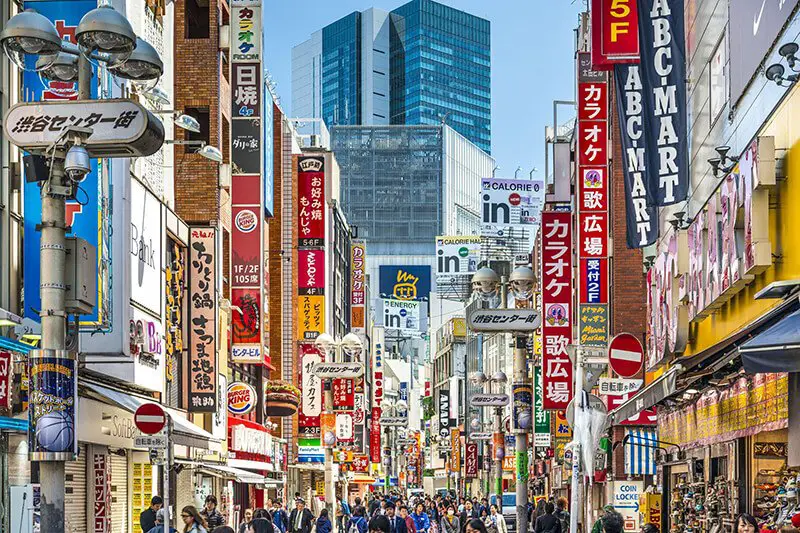
BOOK YOUR TRIP TO JAPAN
BOOK YOUR FLIGHTS
Book your flight now through one of our favourite search engines. We love all three of these because they search the entire web for the best prices and deals. Alternatively, book your flight and hotel in a package directly with Expedia, this could be the cheapest option.
BOOK YOUR ACCOMMODATION
Check out the latest hotel prices in Germany right now. Our personal favourite hotel booking website for Europe, is Booking.com, since they consistently return the cheapest rate for hotels and guesthouses. Expedia is another good option if you are planning to book your hotel in a package with your flight and car.
BOOK YOUR ACTIVITIES AND TOURS
We like to use GetYourGuide to book our activities and tours, ahead of arrival at a destination. This means that we can skip the queue and save time at our destination.
DON'T TAKE OUR WORD FOR IT!
We like to read the reviews before booking a hotel or including a restaurant or attraction in our itinerary. And in our opinion the best place to find independent reviews is:
PLEASE NOTE: This post contains affiliate links, which means that if you click on some of the links in this post and purchase something, we might receive a commission. This is a good thing! There is no additional cost to you and we make a tiny bit of money to help fund this website!

ABOUT KATHARINA
Katharina is the founder, editor, photographer and the main travel writer at A Life Beautifully Travelled. She created this British family travel blog in 2017 to document her adventures around the globe with her husband. Born in Munich, Germany she has since lived in Dusseldorf, Paris, Glasgow, and London. She currently resides in Yorkshire with her family.
Katharina started travelling in her early teens and has explored over 4 continents, 16 countries, and 87 cities. Growing up trilingual and having graduated from an international school, she has a strong interest in other cultures. When she isn’t gallivanting around the globe or busy in her 9-to-5 job as an architect, she can be found exploring the UK (the country she currently calls home). There isn’t much Katharina, her husband and their son Finn love more than a fun family weekend getaway.
DESTIN ATIONS > ASIA > JAPAN

Ripley Castle – An exciting Day-Out with our Newborn Son
PACKING FOR A DAY HIKE – ITEMS YOU SHOULD TAKE AND WEAR TO GO HIKING IN THE UK
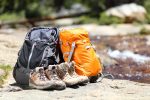
Leave a comment Cancel reply
This site uses Akismet to reduce spam. Learn how your comment data is processed .
A day trip to Hakone from Tokyo: What to see and do
Located in Kanagawa prefecture, Hakone is a volcanic and mountainous area, part of Fuji-Hakone-Izu National Park. It’s famous for its onsens (hot springs) and known for the stunning views of Mt Fuji (on clear days). Filled with hot springs, pirate ships, old trains and volcanic valleys, it’s a perfect day trip from Tokyo.
Table of Contents
Visiting Hakone using the Hakone FreePass
Hakone FreePass is a ticket that’s great to cover all your transport to all the key sights in Hakone, also providing discounts to attractions and museums. Despite being called ‘free’, it is a discount pass for either a 2-day pass for ¥5140 and 3-days for ¥5640. The Hakone FreePass covers unlimited rides on all the different types of transport within the Hakone area, including train, cable car, ropeway, boat and bus.
We picked up our pass at the Odakyu Sightseeing Service Centres , which is one of Japan National Tourism Organization-authorized information centres. It is located in Shinjuku West Station, South Exit location . The process was easy, we spoke to an English representative at the counter to purchase our tickets. Since the information centre is only open between 08:00-19:00, we picked up our Hakone FreePass the day before because we were planning to catch the train before 8 am. Alternatively, you can buy the Hakone FreePass online and then pick it up at the information centre.
Note: this information centre is open from 08:00 to 19:00 and they also have representatives that speak in different languages, including Chinese, Thai-, Russian- and Hindi.
Other information centres where you can pick up a free pass includes:
- Odakyu Sightseeing Service Center, Shinjuku South
- Odakyu Sightseeing Service Center, Odawara
- Hakone-Yumoto Tourist Information Center
*All prices are correct at time of post. Please check before going.
Follow our day trip adventures below:
How to get to Hakone from Tokyo
One of the best ways to get to Hakone from Tokyo is to take the Romancecar (Odakyu Limited Express). With the Hakone FreePass , the Romance train costs an additional ¥1090 (one-way).
Tokyo to Hakone by train
→ A) Hakone via Romancecar – Odakyu Limited Express (direct train )
Shinjuku station → Hakone-Yumoto station
Subway takes approx 80 mins Take the Romancar express train with reserved seating only. Cost: additional ¥1090 (one-way) on top of the Hakone Free Pass
→ B) Hakone via subway on the Odakyu Line
Shinjuku station → Odawara station → Hakone Tozan train → Hakone Yumoto station
Subway takes approx 115 mins Take the Odakyu Line Express (100mins) then change to Hakone Tozan Line (15mins). Cost: included with the Hakone FreePass
→ C) Hakone via JR trains
If you have a JR Pass, you can take the train to Odawara Station on the Tokaido Shinkansen line . From Odawara, take the Hakone Tozan Line mountain train to Hakone.
Get to Hakone by Bus
Take the direct Odakyu Hakone highway bus from Shinjuku station to Laki Ashi takes around 2 hours. A single trip ticket costs around ¥2000.
Getting around Hakone
The Hakone FreePass includes all transport networks in Hakone:
Hakone Tozan Train
- Hakone Ropeway
- Hakone Tozan Bus
- Tokai Bus Orange Shuttle
- Hakone Tozan Cable Car
- Hakone Sightseeing Cruise
- Odakyu Hakone Highway Bus
- Hakone Tozan Bus/Kanko Shisetsu-Meguri Bus
Is the Hakone FreePass worth it?
We got great value from the 2-day Hakone FreePass even though we were only there for a day. We were able to use it for unlimited rides, which was convenient and saved time rather than buying tickets for each transport. It covered the round trip ticket for the Odakyu Line, which was a bonus (additional cost for the Romancecar).
Now that we know how to get to Hakone, let the adventure begin!
→ More: Kinosaki Onsen: A glimpse into an Onsen town
Things to do in Hakone: One Day Itinerary (Hakone loop)
The most common way to travel around Hakone is by circling around in a counterclockwise direction. We wanted to see the grand Hakone Torii gate before the afternoon crowds. So we decided to loop around Hakone in a clockwise direction. It’s possible to circle around either direction in a day.
If you are staying overnight, you may start and end at a different spot depending on your accommodation.
Hakone shrine & Torii gate
Our first stop was the iconic Hakone grand Torii gate. I always thought the floating Torii gate was only on Miyajima and was excited to find out there was one here too! Once we arrived, there were already some people there taking photos and after a while, a queue formed. Best to hit this spot early!
To get here, take the Hakone Tozan Bus (30 mins) from Hakone-Yumoto station to Moto-Hakone Bus stop (元箱根) then take a short 10 minute walk to the Torii gate.
If you explore more within the forest, you’ll find the Hakone Shrine.
Sail across Lake Ashi in a pirate ship
At the heart of Hakone is Lake Ashinoki (芦ノ湖) , one of the 5 famous lakes in the Fuji-izu region. It was formed after the last volcanic eruption 3000 years ago. The best way to enjoy the lake views is by taking the sightseeing cruises for 30 mins. There are 3 routes departing from Motohakone-ko, Hakonemachi-ko and Togendai-ko.
We boarded the pirate ship and headed up to the windy upper deck. The calm waters presented stunning views, even though it was cloudy. As we cruised along the lake, we spotted the floating Tori gate of the Hakone Shrine, from where we were just taking photos. On clearer days you can spot Mount Fuji.
Important note: May 19, 2019 Due to an increased possibility of a volcanic eruption, a no-entry zone is currently maintained around the Owakudani area. As a result, the Hakone Ropeway is out of service, and the Owakudani area cannot be visited. Substitute buses operate between Sounzan and Togendai. The other areas of Hakone are not affected.
Owakudani (大湧谷) — Valley of Hell
After the cruise across Lake Ashinoko, we took the cable car to the top of the mountain to Owakudani. The natural beauty of Owakudani is the volcanic valley, known as the ‘Valley of Hell’, which formed during the last volcanic eruption which was about 3000 years ago. It’s an active volcanic valley with rising volcanic gases and active sulphur vents.
→ More: Overnight temple stay at Mt Koyasa n
Hakone Ropeway How to get there: Togendai-ko → Owakudani or Souzan station Opening hours: 9am – 4pm (hours of operation may vary) Cost: Included with the Hakone FreePass Time: approx 30 mins
Black eggs of Owakudani
At the top of Owakudani, we tried the local specialty of black eggs called the Kuro-Tamago . These eggs have been boiled in the hot spring pond in Owakudani. It’s cooked in natural spring water for 60 minutes at a high temperature of 80 degrees. The eggs are then steamed for 15 minutes at 100 degrees in steel baskets. The shell turns black from the reaction with hydrogen sulphide in the water and iron particles adhering to the eggshell. Despite having a black eggshell, it tastes like a boiled egg. It is believed to add years to your life – legend has it, eating one will add 7 years to your life.
A bag of 5 Kuro-Tamago black eggs costs ¥500.
Next, we travelled on the Hakone Tozan Railway to Gora. We visited Japan’s oldest formal French garden that has been opened for over 100 years. It’s apparently lovely during all seasons with various types of flowers blossoming and light displays during summer and Christmas. Entrance to Hakone Gora park is included with the Hakone FreePass.
Hakone Tozan Cablecar How to get there: Sounzan to Gora Cost: Included with Hakone FreePass Time: 10 minutes, departures every 20 minutes
Art in Hakone
Closeby, we tried to visit the Hakone Open Air Museum in Gora. We made it before if the last entrance (4:30pm) but that meant there was only left 30 minutes before it closed. There was only so much we could fit in one day, so we decided to skip it. I’ll definitely be visiting next time.
Hakone Open Air Museum is Japan’s first open-air museum with both indoors and outdoors sculptures. I was very interested to see the Picasso Pavilion exhibit. It exhibitions the world’s best collection of Picasso’s works. Other artworks in pieces by Picasso, Henry Moore, Taro Okamoto, Yasuo Mizui, and more.
Hakone Open Air Museum Where: 1121 Ninotaira, Hakone-machi, Ashigarashimo-gun 250-0493, Kanagawa Prefecture Open: 9am to 5pm (last entrance 4:30 pm) Cost: 1600 yen (1400 with Hakone FreePass )
Hakone is home to many kinds of art, includes:
- Pola Museum of Art
- Lalique Museum, Hakone
- Hakone Venetian Glass Museum
- The Hakone Open Air Museum
- Museum of the Little Prince and Saint-Exupery
- Narukawa Art Museum
*Some provide a discount with the Hakone FreePass
From Gora, we needed to head back the Hakone-Yumto Station for our onsen booking. The Hakone Tozan Train zigzags through the mountain and takes around 40 mins to Hakone-Yumto Station. During the ride, there are switchbacks when the driver and conductor change shifts. This means the train the reverses and switches directions.
Hakone Tozan Train How to get there: Gora to Hakone-Yumoto Station Cost: Included with the Hakone FreePass Time: 35 minutes, departures every 10-20 minutes
Hakone Onsen
Hakone is a popular place for onsens, so we couldn’t leave without trying one, of course! After a full day of exploring Hakone, it was finally time to relax.
We booked a private Onsen at Hakone Yuryo . To get there we took the free shuttle bus from Hakone-Yumto Station. It runs every 15 minutes from 9am to 80pm on weekdays and is a short 3 minute ride to Hakone Yuryo. There are large communal baths called ‘Honden Yurakuan Oyu’, costs ¥1,500 for Adults. It also offers 19 private open-air onsen baths called ‘Hanare Yuya Kaden’. It costs ¥3,900-¥56300 per hour for a private onsen.
Surrounded by the open-air views of the green forest, we relaxed in one of the private onsens. It was a well decorated room with a table and chairs to relax. The alkaline mineral-rich hot spring water smoothes the skin.
Make sure to book in advance if you can!
You may also enjoy:
Interesting places to visit in amritsar part ii, discover the best things to do in trat, …, interesting places to visit in amritsar part i, one day in rome: full of epic …, leave a reply cancel reply.
Your email address will not be published. Required fields are marked *
Website URL
Latest posts
A day trip from seoul: exploring nami island and the best …, best places to visit in bangkok, thailand.
It’s the paths we take, the journeys we make, that leads us to great adventures ~ onebluehat
Stay updated
Hakone Day Trip from Tokyo: 1 Day Itinerary with Must-See Attractions
快速導覽
How to plan a day trip to Hakone?
If you only have one day to visit Hakone, how would you plan this one-day trip to Hakone?
I believe that for many people, if they want to travel to Hakone, they must stay in a local hot spring hotel, enjoy the hot spring slowly, and the cuisine provided by the hot spring hotel. Probably only such a Hakone itinerary plan can be considered a complete Hakone travel itinerary.
But also because not everyone has enough time to arrange a two-day one-night, three-day two-night trip to Hakone. Therefore, if you want to visit Hakone within the limited travel time, you can only arrange a one-day trip to Hakone, and try to grasp the limited travel time to experience Hakone's attractions, food, and hot springs.
There are many attractions and hot springs in Hakone, so in today’s article, I will share with you different types of Hakone day trip plans.
For example, from the itinerary of visiting different scenic spots, the itinerary of experiencing the natural environment of Hakone, the itinerary of enjoying Hakone hot springs, etc., you can choose the most interesting itinerary to experience the characteristics of Hakone. In addition, we will recommend some Hakone one-day tour guide groups, ticket discounts, and accommodation discounts for you, so that you can plan a unique Hakone one-day tour.
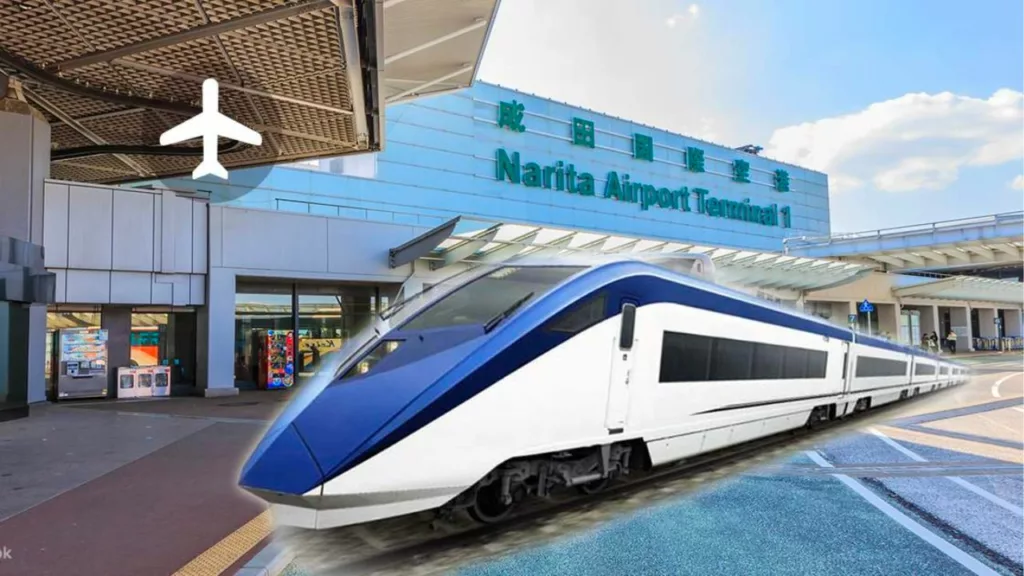
How to get from Narita Airport to Tokyo? [Most convenient] Skyliner Keisei Electric Railway limited express train 41 minutes connecting Narita Airport and Tokyo!
Hakone Day Trip with Hakone's Unique Transport
If you can only arrange a one-day trip to visit the entire Hakone area, the best itinerary to experience the characteristics of Hakone must be to take different Hakone-style transportation and enjoy the scenery of Mount Fuji and Hakone natural hot springs on the way.
morning itinerary
First depart from Hakone-Yumoto Station at 09:00 in the morning, and arrive at Moto-Hakone Port before taking the Hakone Tozan Bus. First go to the Hakone Shrine to worship, and then take the Hakone Pirate Sightseeing Boat to enjoy the natural scenery of the Hakone area and the scenery of Mount Fuji on Lake Ashi.
noon itinerary
After arriving at Togendai Station, transfer to the Hakone Ropeway to visit the natural hot spring scenery of Owakudani and experience the unique black hot spring eggs in Hakone. After staying in Owakudani for about 30 minutes, you can take the Hakone Ropeway to Sounzan Station, and then transfer to the Hakone Tozan Cable Car to Gora Station.
At Gora Station, you can find a large number of Hakone-style restaurants, such as Tamura Ginkatsutei, which specializes in fried pork chops and tofu dishes, or Gora Silver Tofu, which are some very popular restaurants at Gora Station.
afternoon itinerary
After lunch, at about 14:00 in the afternoon, you can take the Hakone Tozan Railway from Gora Station and return to Hakone Yumoto Station. while in Hakone Yumoto Here, you can find many shops specializing in Hakone specialties, which are very suitable for buying some Hakone specialties to take home and give to friends.
After spending about an hour shopping in Hakone Yumoto’s Box Store Street, you can take the Odakyu Electric Railway back to Tokyo around 18:00 in the afternoon, just in time for the dinner peak time of Tokyo restaurants, and you won’t return to Tokyo because it’s too late. And when all the restaurants are closed.
Recommended discounted transportation packages in the Hakone area: Hakone Freepass
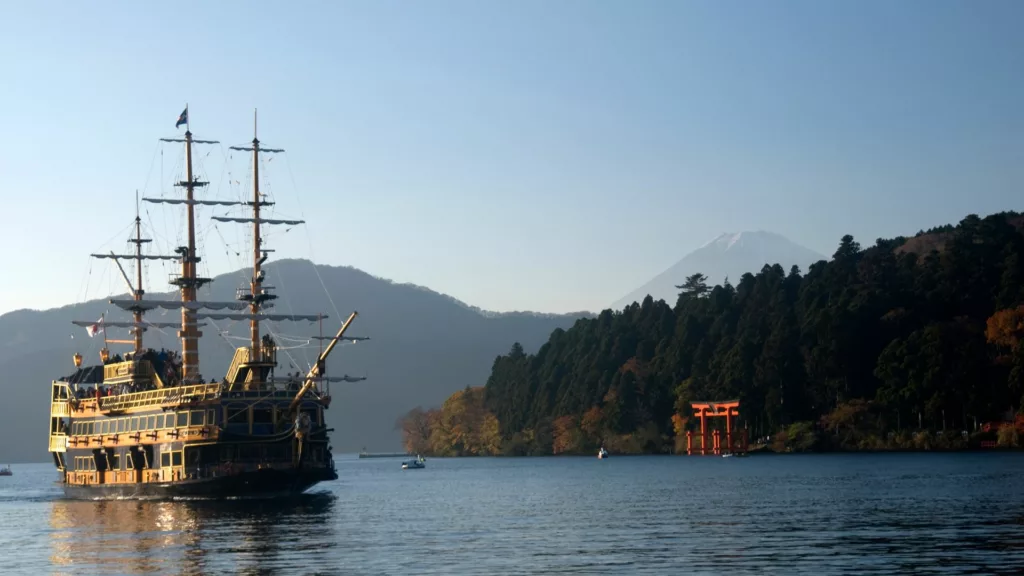
Of course, you can choose to go to different scenic spots in Hakone from another direction. For example, starting from Hakone Yumoto, first go to Gora and Owakudani to visit, then take the Hakone Pirate Sightseeing Boat from Taoyuantai to Motohakone Port, and finally take Hakone Mountaineering Wansora returned to Hakone-Yumoto from Moto-Hakone Port. However, you must pay attention to the frequency and timetable of the Hakone Pirate Sightseeing Boat before departure. Because the Hakone Pirate Sightseeing Boat only leaves once an hour on average, and usually stops sailing at 15:30 in the afternoon.
Therefore, by arranging the itinerary of the Hakone Pirate Sightseeing Boat to depart from Moto-Hakone Port in the morning, you can ensure that you can arrive at Togendai Station on time, and it will not affect the subsequent itinerary.
Hakone Day Trip Focused on Visiting Art Museums
In addition to the Hakone one-day tour itinerary with different means of transportation, you can choose to focus on visiting Hakone art galleries and gardens during the Hakone one-day tour itinerary, giving you the opportunity to take a few more commemorative photos and participate in some hand-made experiences class.
For example, it is very famous in Hakone Gora Park , Hakone Glass Forest Museum , Hakone Sculpture Museum , are some scenic spots that gather garden attractions and art exhibitions. If you spend 2 hours visiting each art gallery, Gora Park, Hakone Glass Mori Art Museum, and Hakone Sculpture Mori Art Museum, these 3 attractions just fill up the whole day's itinerary.
Another advantage of this one-day trip to Hakone is that the distance between these art galleries is not very far. So you can save a little more traffic time, and then after visiting these art galleries, you can go shopping in the shopping street of Hakone Yumoto.
One device, shared by multiple people! [New] NTT Docomo Unlimited Mobile Data Sharer Service Plan Faster and more convenient to receive!
Hakone day trip to enjoy hot springs and shopping
If the goal of your itinerary this time is to shop and experience the hot springs in Hakone, basically in the entire Hakone day trip itinerary, you only need to arrange departure to Gora Station and Hakone Yumoto Station.
Because near Gora Station there is a Hakone Kowakien Hot Spring Theme Park It is a place that combines hot springs and water parks. You can experience different types of hot springs in a whole day for only about ¥3,500 yen. Moreover, the characteristics of Hakone Kowakien Hot Spring Theme Park are You can wear a swimsuit and enjoy the hot springs , for some travelers who are used to being naked in front of the public, this is a rare opportunity to experience hot springs in Hakone.
If you like to experience hot springs in Hakone Kowakien Hot Spring Theme Park, you can also stay until 18:00 in the afternoon until the official closing. Otherwise, you can also choose to spend about 3 hours in the morning Hakone Kowakien Hot Spring Theme Park , and then have lunch near Gora Station at noon.
For the afternoon itinerary, you can choose to arrange shopping in Hakone Yumoto's shopping street, or start to visit Gora Park.
And as long as you buy Hakone Freepass If you don’t, you don’t need to worry about how much you will spend on transportation throughout the day, and you can get discounts on additional special admission fees when you visit Gora Park or other specific Hakone attractions.

Hakone Day Trip Combined with Mount Fuji Sightseeing Itinerary
As long as you set off to Motohakone Port and take the Hakone Pirate Sightseeing Boat to Togendai Station, you can enjoy the scenery of Lake Ashi and Mount Fuji on the boat.
But how can there be only one way to appreciate Mount Fuji? If you have an extra day of travel time, you can arrange a itinerary that combines Hakone and Mount Fuji, so that you have the opportunity to enjoy the view of Mount Fuji from different angles.
Itinerary for the Hakone area
For example, departing from Hakone Yumoto Station at 09:00 in the morning, first take the Hakone Tozan Bus to Motohakone Port. Take the Hakone Pirate Sightseeing Boat in Hakone Town to Togendai Station, and enjoy the view of Mount Fuji on the way.
Around 11:00 in the morning, you can arrive at Taoyuantai Station. First take the bus to Gotemba Station, and then transfer to the Kawaguchiko Bus Line to Kawaguchiko Station. It takes about 2.5 hours, that is, you can depart from Togendai Station to Kawaguchiko Station at around 14:30 in the afternoon.
Itinerary for Kawaguchiko area
When you arrive at Kawaguchi Station, you can first enjoy the view of Mount Fuji near Kawaguchiko Station, or stay in a hotel next to Kawaguchiko, and quietly enjoy the sunset scenery of Mount Fuji and Kawaguchiko in the hotel room, as well as the view of Mount Fuji at night .
choose to stay Hotels near Lake Kawaguchi , because you will not miss the opportunity to enjoy the sunrise view of Mount Fuji in the room, and you can also enjoy the reflection of Mount Fuji in Lake Kawaguchi. And these unique accommodation experiences can only be experienced in hotels in Kawaguchiko. If you like Mount Fuji, you must not miss it!
Recommended discounted transportation packages in the Mt. Fuji area: Mt. Fuji – Hakone Area 3-Day Tour Pass
Further reading: Kawaguchiko hot spring accommodation recommended! A hot spring hotel and private bath where you can see the reflection of Mt. Fuji from the room!
Choice of Hakone one-day guided tour
Perhaps for some people, the itinerary of a one-day trip to Hakone is to visit Hakone with a professional tour guide. At the same time, you don’t need to spend time understanding the different transportation methods in Hakone. You only need to know the departure time of the tour group in Tokyo and the tour guide It will be enough time for the tour group to return to Tokyo.
If you all have the same idea, you can consider some travel options from Tokyo to Hakone One-day guided tour , let the company hosting the tour guide solve the itinerary planning and transportation arrangements for the whole day for you. You only need to arrive at the meeting point in Tokyo on time, and the guides of the guided tour will take you to visit the main attractions in different areas of Hakone and Mt.
If you need to travel to Hakone with your elders this time, and you find it difficult to plan your itinerary, you may choose some Hakone Day Tour will be your best choice.
The most convenient way to visit Hakone! [Professional tour guide] Hakone one-day tour guide group The most convenient way to appreciate Mt. Fuji itinerary!
Transportation and itinerary planning for a one-day trip to Hakone
If you start from Shinjuku Station in Tokyo, you can take the Odakyu Electric Railway to Hakone Yumoto Station to start a full-day Hakone day trip.
Under normal circumstances, because it takes 2 hours to take the Odakyu Electric Railway train from Shinjuku Station to Hakone Yumoto Station, it is highly recommended to depart from Shinjuku Station in Tokyo at 07:00 in the morning, so that you can arrive at 09:00 in the morning Hakone Yumoto Station.
To put it simply, because there is only about 9 hours of sightseeing time, among the several itineraries with different themes just now, you can actually only choose one of them as a one-day trip plan for Hakone. For example, you can choose to take different means of transportation in Hakone, and go to Lake Ashinoko to enjoy the scenery of Mount Fuji, and to enjoy the scenery of hot springs in Owakudani. They are all trips that mainly start to some natural attractions in Hakone.
However, if you want to go around Hakone for sightseeing and experience in the same day Hakone Kowakien Hot Spring Theme Park , and visit Hakone Glass Forest Art Museum If you don't, you may miss the last train of the Hakone Ropeway. So if you want to visit several different attractions in Hakone, it would be better to arrange a two-day tour itinerary.
Recommended accommodation in Hakone, Kawaguchiko and Tokyo
Although during the one-day tour of Hakone, there will be no time to stay in a hot spring hotel in Hakone, but if you change your mind, or if you can arrange an extra day in the itinerary, you can consider the following in Hakone and Lake Kawaguchi , and accommodation recommendations in the Tokyo area:
Recommended places to stay in the Hakone area: Hakone Lake Ashino Hanori , Hakone Ki no Yu Setsugekka Onsen , Ten Yu Inn Hakone Kowakien , Hotel Indigo Hakone Gora , are some very popular accommodation options in the Hakone area.
Recommended accommodation in the Kawaguchiko area: Wind Terrace KUKUNA , Lake Kawaguchi Shuhokaku Lake Moon , Fujikawaguchiko Onsen New Century Hotel , are some accommodation options that have a view of Mt. Fuji from the room.
Recommended accommodation in the Tokyo area: APA Hotel – Shinjuku Kabukicho , Hotel Gracery Shinjuku , Tokyu Stay Shinjuku , are some accommodation options that are very convenient to Hakone near Shinjuku Station.
If you are planning to go to Hakone for sightseeing for the first time, and you don’t have much time to spend in Hakone, a one-day trip to Hakone will probably be the most suitable itinerary for you.
However, if you want to choose the most worthwhile experience in Hakone, you must stay in different hot spring hotels and try some high-end meals in traditional hot spring hotels. Therefore, in order to truly experience the characteristics of Hakone, it is inevitable to arrange a two-day tour or a three-day tour.
No matter what, Hakone is also a place worth visiting again and again. If you can’t go this year, you can arrange to go next year or the next year. If you want to know more travel information about the Hakone area, Mt. article sharing. In addition, in the category of Tokyo travel information, various practical travel information in the Tokyo area are also sorted out for you. If you will arrange departures to these places, I believe that the articles in it can bring you a unique itinerary experience!
More Mt. Fuji and Hakone travel information
Mount Fuji area
Mount Fuji hot spring hotel recommendation: Hotel Room with Hot Spring, Private Bath and Exclusive View on Mount Fuji! Bus Route Guide to Mount Fuji Kawaguchiko Station! JR train from Shinjuku to Kawaguchiko Station? The first choice for railway fans Fuji-Hakone Pass purchase discounts, itinerary planning sharing How to plan the itinerary of Lake Kawaguchi? Attractions, Transportation, Food and Overview The Flower Sea in front of Mt. Fuji Lake Kawaguchi》Annual Lavender Festival ⋯⋯ and MORE
Hakone area
Recommended Hakone Onsen Hotels》A list of high-end hot spring hotels with private baths! How to plan your trip to Hakone? Hakone Attraction Transportation Itinerary Sharing! Fuji-Hakone Pass purchase discounts, itinerary planning sharing Hakone Yumoto Attractions, hot spring hotel selection near the station ⋯⋯ and MORE
More Japan Travel Information: Tokyo | Kyoto | Hokkaido | Climbing Mt.Fuji | Hakone | Lake Kawaguchi Tips for Traveling in Japan | Japan Hotel Deals | Klook Latest Promo Code
Ryu_C@RakuRakuJP
RakuRaku, which is 楽々 in Japanese. This site is committed to providing the most authentic travel information in Japan, bringing you a different Japan travel experience!
Hakone Kamakura Pass: Latest Discount and Reservation Guide
Tokyo to kawaguchiko station: complete guide for fuji bus, trains and buying tickets, more different travel information, hakone freepass: 3 days itinerary planning & latest ticket discount, hakone ashinoko hanaori hotel: private onsen with best package in hakone, hotel indigo hakone gora: an ihg hotel with private onsen in hakone, hoshino resorts kai hakone: the best traditional onsen ryokan you must try, hakone yumoto station: onsen, shopping street and things to do, 11 best ryokan in hakone with private onsen, hakone trip planning》hakone one-day tour/two-day tour itinerary & hakone transportation and accommodation recommendations, hakone open air museum, 하코네 베네치아 유리 박물관(유리의 숲), hakone gora park: best japanese garden near hakone onsen area.
RakuRakuJP , is a website dedicated to sharing articles about in-depth travel experiences in Japan.
I believe that before you travel to Japan every time, you will hope to get the most comprehensive travel information, and then be able to successfully complete the entire travel itinerary.
And our goal is to gather all practical itinerary information, discounted accommodation, and tickets, so that you can plan the entire Japan travel itinerary in the most convenient way.
useful link
- About RakuRakuJP
- RakuRakuJP All Articles
- Privacy Policy
- Website Terms of Use
- Agoda booking offers
- Klook Booking Offer
Editor's Picks
Latest useful travel articles.
©2017- 2024 RakuRakuJP. All Right Reserved.
- Contact us to advertise
Would you eat a black egg? Visiting Hakone’s Boiling Valley.
- By Sarah Steiner
- Updated On March 22, 2024
Visiting Hakone on a day trip from Tokyo is one of the most popular day-trips in Japan. It’s relatively easy to make the trip independently (once you have grasped the Tokyo rail systems at least somewhat) and is an interesting adventure for a day in Japan.
The Hakone area is famed for its abundant nature and hot-springs, and thus its popularity extends to both Japanese and international tourists. And plus, its only two hours from Tokyo.
On our first visit to Tokyo we only had a few days to spare, so a day trip to Hakone was perfect for our schedule. Here’s everything you need to know to make for a smooth day trip in Japan.

The Great Boiling Valley in Hakone
The whole region of Hakone is a hot spring hotspot; hence the attraction for tourists to the many onsen and hot spring baths in the area. However, the must-see attraction in the Hakone area is a visit to Owakudani (the Great Boiling Valley).
Owakudani is a volcanic valley formed over 3000 years ago. It is a famous sightseeing spot in Japan where you can see geothermal and thermal volcanic activity from a safe distance. And from a gondola that goes right up the side of the mountain!
Most of the hot springs in Hakone actually receive their thermal spring water from Owakaduni. So it is an interesting and important sight for this region of Japan.

The Valley Gondola
The Hakone Ropeway is a sightseeing gondola in Hakone. The ropeway is split into three sections, starting from Sounzan Station (which connects with the main train from Odawara via a few stops and changes).
The most popular route on the gondola runs between Sounzan Station and Owakudani. But it is possible to take the ropeway further; changing cars at Owakudani.
A trip on the gondola between the four stations does not take long:
- Sounzan Sta. – Owakudani Sta. – 8 minutes
- Owakudani Sta. – Ubako Sta. – 8 minutes
- Ubako Sta. – Togendai Sta. – 8 minutes
But the main site to see in the Great Boiling Valley is the first gondola stop at Owakudani.

Note: It’s specified on the Hakone Ropeway website and at the gondola station, that making the journey up the Great Boiling Valley is not recommended for certain people. Due to the influence of the volcanic gases, the ropeway is not recommended for persons with allergic asthma, bronchial disease and others in poor physical condition.
Check the finer details for health specifications here .
Hakone Black Eggs
Once you reach the top of Owakudani and alight at the station, there are several café options for lunch and refreshments. However, the most important thing to try about visiting Hakone is the areas signature black eggs. These eggs have been cooked in the steaming mineral-laden water from the thermal hot springs.
And apparently, these thermal black eggs can add years to your life by eating them.
The eggs are in fact ordinary chicken eggs (nothing more sinister, I’m fairly sure) but the shells turn black due to being boiled in the sulfuric springs. Signposts confirm the local traditions that depict for each egg eaten, seven years is added to your life…
The eggs are for sale at Kurotamogo House overlooking the valley. Five black eggs cost 500 JPY including tax.

Hakone Geo Museum
Right next to the Owakudani Station is the Hakone Geo Museum, split in to two main areas. There is a free information zone and a Geo Hall of exhibits. Entrance to the Geo Hall costs 100 JPY including tax.
We found the free information zone interesting for a wander around. Signs and information at the museum is largely documented in English and Japanese.
How to get to Hakone on a day-trip from Tokyo
This, is the fun part! In all seriousness, it can be overwhelming contemplating how to change from subways and over rails in Tokyo, to bullet trains and gondolas out in rural Japan. But don’t worry; we’ve got you covered. (Remember, we’re from New Zealand where we don’t have many trains and certainly non that travel at the speed of a bullet; or underground!).
The end goal of the trip to ride the gondola up to Owadakuni. And the journey to get there is best broken down into steps.
The following is the easiest (and least stressful) method that we found.
- All tickets for these trains can be purchased at the station on the day of visiting.
(If you are planning ahead and want to pre-book, there is a direct train from Shinjuku Station to Hakone called the Romancecar . Details can be found on the Hakone website).
The first step is to get from Tokyo to Odawara. And in order to do that, you need to get to Tokyo’s Shinjuku Station.
Metro: To Shinjuku Station
Take the Tokyo Metro to Shinjuku Station. Shinjuku Station is Tokyo’s busiest station, and actually the busiest station in the world! (An extra cool reason to visit and start your trip from here).
Purchase a ticket at Shinjuku for the Odakyu Line to Odawara.
Train: Shinjuku Station to Odawara
Odawara is located at the east of Hakone Region, and is known as the gateway for guests coming from Tokyo to Hakone. Odawara station is directly accessible from Shinjuku in Tokyo.
Take the Odakyu line from Shinjuku Station. The Rapid Express takes between 90 – 100 minutes.

Train: Odawara to Hakone-Yumoto and Gora
The Hakone Tozan Railway that runs between Odawara and Gora is Japan’s oldest mountain railway. Small trains wind through narrow, densely wooded valleys and over many bridges and tunnels. The train stops at small stations along the way, and changes directions at three major switchbacks.
Transfer at Odawara Station onto the Hakone-Tozan line.
This section of the journey is also split into two parts:
- Odawara to Hakone-Yumoto: This section is served by Odakyu trains and only takes about 15 minutes.
- Hakone-Yumoto to Gora: This is the most beautiful track of the journey. Part of the track is especially beautiful (and popular) in June and July when thousands of hydrangea flowers bloom. Trains run every 10 to 20 minutes between Hakone-Yumoto and Gora and the ride takes 35 minutes. A one-way fare is 410 JPY (or covered by the Hakone Free Pass if you are traveling on that).
Cable Car: Gora to Sounzan
This is the last piece of the journey to reach the Great Boiling Valley and your gondola ride. Sounzan Station (the start of the gondola) at the ropeway’s eastern end can be reached in a short cable-car ride from Gora.
Gondola: Sounzan to Owakudani
And this is the final leg by gondola up over the incredible Boiling Valley to Owakudani. There is the option to go further from Owakudani onwards by gondola, and you can purchase tickets from Sounzan Station. However, we found the Boiling Valley interesting (and the journey to get there sufficient!) and were well satisfied with a couple of black eggs and the chance to relax and take it all in. (Along with adding those seven years to our lives in doing so!).

The verdict?
It is a big day out; but I would do it all again. Making a day trip to Hakone is a cool adventure from Tokyo. And, as complicated as it looks with multiple stops and different modes of transport – gondola, metro, over-rail train and cable car – it is well signposted, and the stations are set up for easy transfers.
So go eat some black eggs! And – don’t forget to stop by and let us know how many extra years you managed to add to your life… 🙂
More useful links for your travels in East Asia and beyond…
These are the companies we use while traveling fulltime as a family and that we would recommend to anyone planning and booking travel.
- Booking.com – The best all-around accommodation booking site that constantly provides the cheapest and lowest rates. They have the widest selection of budget accommodation and it’s easy to filter and sort into price and availability with all the extras you are looking for personally.
- Hostelworld – The largest inventory of hostel accommodation in the world.
- Skyscanner – This is by far our favourite flight search engine. They are able to search small websites and budget airlines that larger search sites often miss. We book all our flights through Skyscanner.
- GetYourGuide – Get Your Guide is a huge online marketplace for tours and excursions offered all around the world including everything from walking tours, to street-food tours, cooking classes, desert safari’s and more!
- SafetyWing – A global travel insurance that covers people from all over the world while outside their home country. You can buy it short or longterm; and even if you are out of the country.
- World Nomads – Travel insurance tailored for longterm travel and nomads (including those who have already left home).
Read more about travel in East Asia
- The ultimate travel guide for Japan with kids.
- Fushimi Inari Shrine: Walking up Mount Inari.
- Taiwan with kids: A complete Travel Guide.
- Visiting Taroko Gorge, Taiwan.
- Taiwanese food: The real deal traveling in Taiwan.
- Visiting Busan’s Jagalchi Market, South Korea.
- Hong Kong: Mount Davis (accidentally) and the Monster Building.
Wondering about itineraries? Questions about schooling? See our Family Travel Guides and FAQ here .
Top Destinations
- Cook Islands
- New Zealand
Latest Posts
Choosing the best moroccan hammam in rabat: what to expect., visiting hassan ii mosque casablanca: everything you need to know., hassan ii mosque hammam in casablanca: the best hammam in morocco , ramadan in morocco: should you reconsider travel to morocco during ramadan, chez lamine marrakech: eat lamb where gordon ramsay ate , jardin majorelle in marrakech (ysl garden): is it truly worth the visit.

We are the Steiners: Sarah, Gavin, Harry and Oscar – a family from New Zealand with a love of travel and adventure together… Especially where it takes us off the beaten track!

Away with the Steiners uses affiliate links. That means that if you buy something through these links, we may earn a commission at no extra cost to you.
2 thoughts on “Would you eat a black egg? Visiting Hakone’s Boiling Valley.”
Thank you very much for the useful information, I was confused according to Google, but now I believe that I will reach the destination and finally see The Great Boiling Valley in Hakone 🙂
Hi Monika that’s great. Have a fantastic time in Japan!
Leave a Comment Cancel Reply
Your email address will not be published. Required fields are marked *
Save my name, email, and website in this browser for the next time I comment.
Notify me of new posts by email.
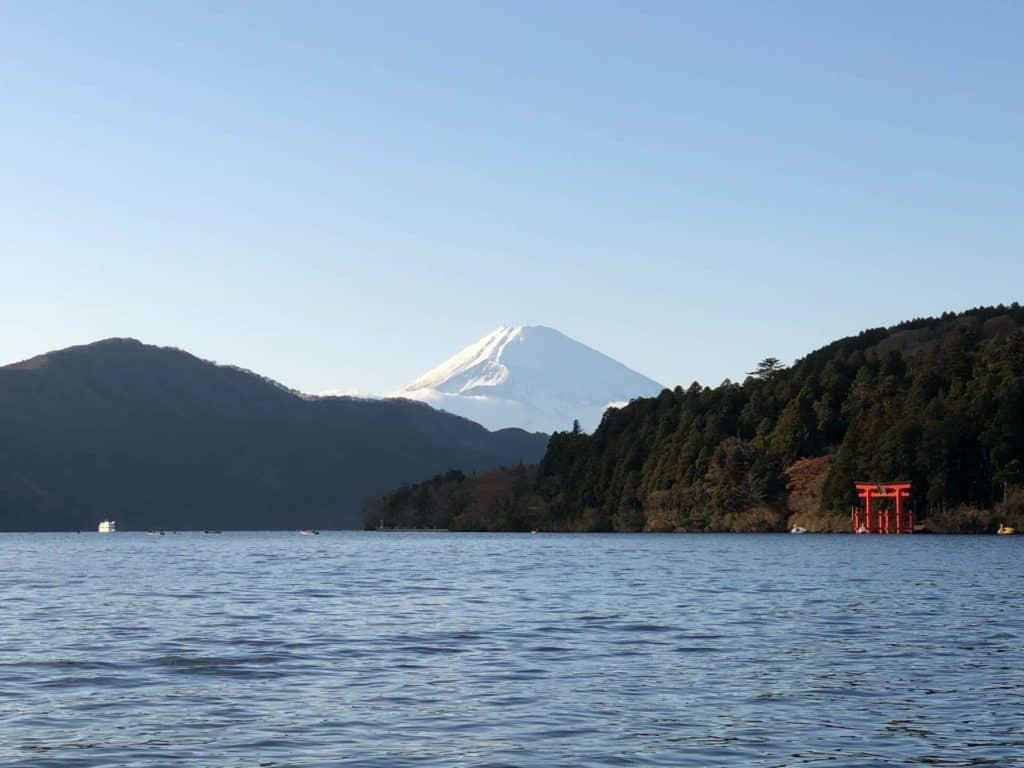
Perfect Day Trip To Hakone From Tokyo (2024 Guide)
A day trip to Hakone from Tokyo is among the top day trip options done by both locals and international travellers.
Thanks to the town’s proximity and transportation advancement in Japan, Hakone is easily reachable by public transportation from Tokyo.
These make Hakone an ideal location to wind down and have a short getaway from the bustling metropolis.
Besides, Hakone is known for many stunning attractions too.
From numerous natural hot springs to scenic walking trails and fascinating art museums, you are bound to have a pleasant time in this lovely mountainous town.
So to make your travel planning easier, I have written a detailed article on wonderful things to do in Hakone, how to get there, utilising Hakone Free Pass, must-try local food, useful travel tips, and others.
Let’s dive right in!
Related Articles:
- Best 17 Ryokan With Private Onsen In Hakone (2023)
- Best 13 Onsen Ryokan In Kanazawa (For All Traveller Types!)
- Japan Ski Packing List: What To Pack & Useful Tips
- Best 4 Days Tokyo Itinerary: How To Spend 4 Days In Tokyo
- Off The Beaten Path Japan—Top 18 Places That You Need To Discover
- First Time To Japan: 45 Useful Travel Tips For First Time Traveler
- What Japan Is Known For: 33 Famous Things To Discover
- 19 Best Things To Do In Osaka At Night
- Day Trip To Nara—The Ultimate Nara Itinerary One Day
Disclaimer: This page may contain affiliate links and I may get a small commission if you decide to make a purchase through my links, at no additional cost to you. Thank you.
What Is There To Do In Hakone For A Day Trip
- Visit Hakone Shrine
- Have An Instagrammable Shot At Hakone Cedar Avenue
- Explore Hakone Checkpoint
- Enjoy Scenic View of Lake Ashi At Onshi Hakone Park
- Get On The Hakone Sightseeing Cruise
- Admire Mount Fuji View On The Hakone Ropeway
- Enjoy Eating Black Eggs At Owakudani
- Experience The Zen Vibe At Choanji Temple
- Visit Hakone Open-Air Museum
- Admire The Stunning Artwork At Pola Museum of Art
- Explore Lalique Museum
- Create Your Own Arts At Gora Park
- Shop At Gotemba Premium Outlets
- Have A Stroll Along Mishima Skywalk
- Visit Odawara Castle
- Get Souvenirs At Hakone-Yumoto Shotengai
- Have A Dip At Local Onsen
Hakone Travel: USEFUL PRE-TRAVEL TIPS AND LINKS
Here are the shortcuts to the links of useful resources for your Hakone trip:
- Buy JR pass to travel around Japan and explore its beautiful cities, including Hakone.
- Book Hakone Free Pass online for convenient, queue-free, and fuss-free travel experience.
- Get a Japan local sim card or portable WIFI router for 24/7 internet connection while exploring Hakone.
- Book your Hakone accommodation using Booking.com .
- Make sure you are fully insured before flying into Japan. You can get your travel insurance at World Nomads .
Disclaimer: World Nomads provides travel insurance for travelers in over 100 countries. As an affiliate, we receive a fee when you get a quote from World Nomads using this link . We do not represent World Nomads. This is information only and not a recommendation to buy travel insurance.
Unmissable Things To Do At Hakone
1. visit hakone shrine.
The first stop to visit during your day trip Tokyo to Hakone is Hakone Shrine .
Located at the base of Mount Hakone, this beautiful shrine has a history dating back to more than 1200 years ago.
Hakone Shrine is highly visited by the travellers to pray for overall better luck or a safe trip.
One of the main highlights of the Hakone Shrine is its bright red torii gate standing tall in Lake Ashi.
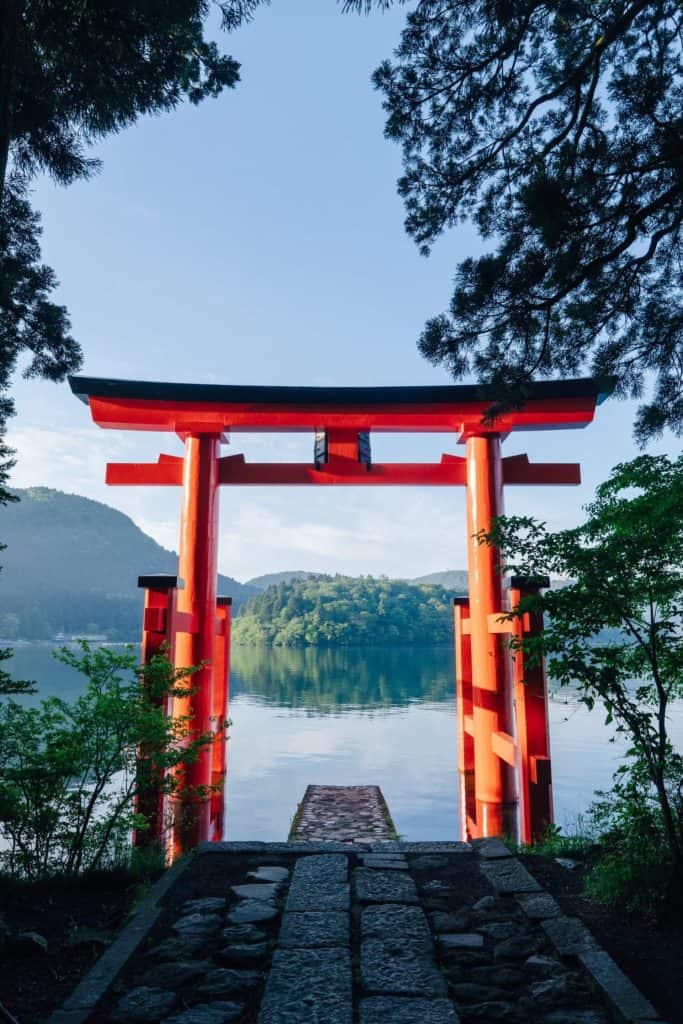
With the total package of Instagrammable spot criteria consisting of the torii gate, blue lake water, and tranquil mountains as the backdrop, many visitors storm to this highlight first upon reaching the shrine ground.
The main shrine entrance also makes a great photo spot with tall cedar trees in the background.
Nevertheless, there are plenty of things to admire in the Hakone Shrine.
These include the shrine’s traditional architecture and nicely-preserved artefacts in its treasure museum.
Address: 80-1, Motohakone, Hakone-machi, Ashigarashimo-gun, Kanagawa, 250-0522
Visiting Hours: Always open
Entrance Fee: Free
How To Get To Hakone Shrine
Take bus line H of Hakone Tozan Bus from Hakone-Yumoto Station to reach Moto-Hakone boat pier. This bus journey will take about 35 minutes. Then walk for 5 minutes from the boat pier to reach Hakone Shrine.
Hakone Free Pass: Covered
2. Have An Instagrammable Shot At Hakone Cedar Avenue
Hakone Cedar Avenue is a beautifully-preserved spot that will leave you in awe.
This 500-metre long avenue was part of the bustling path (Tokaido highway) used by foot-walking travellers back in the Edo Period linking Kyoto to Tokyo.
Travel tip: These tall cedar trees are believed to have been planted in 1618 and thus they are at least 400 years old!
You can wander around this avenue for free and admire its tranquillity while reminiscing about its important transportation role several centuries ago.
And before you leave, make sure to spend some time taking several Instagrammable shots at Hakone Cedar Avenue.
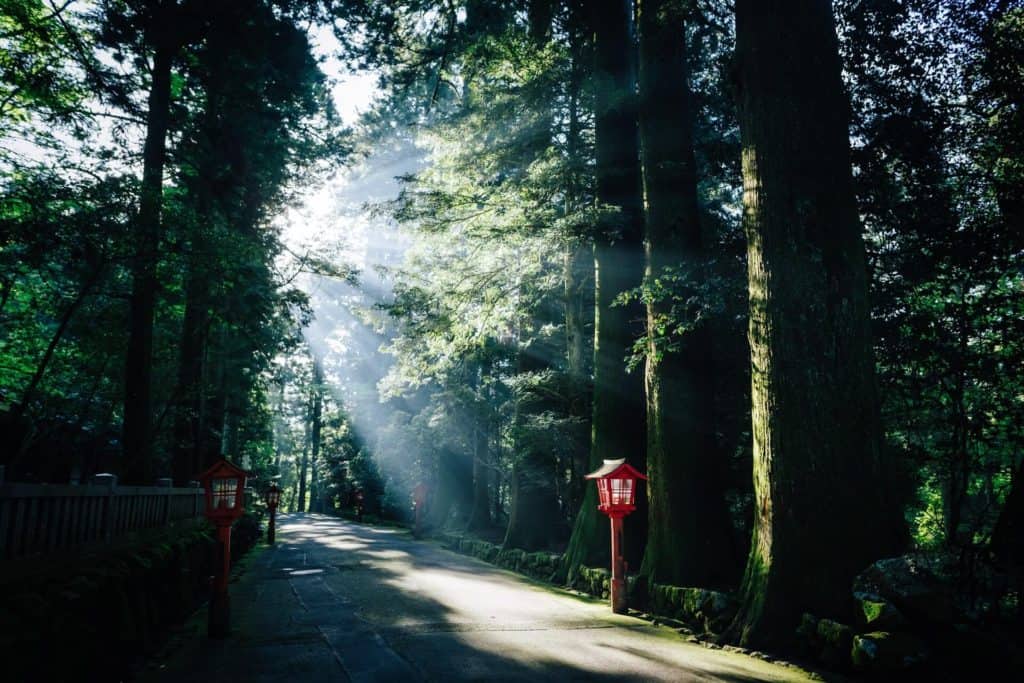
Address: Kanagawa, Ashigarashimo, Hakone
How To Get To Hakone Cedar Avenue
From Hakone-Yumoto Station, take the Hakone Tozan Bus (Line H) to Hakone Port. Alight at Hakone-Shishomae. This takes about 35 minutes.
3. Explore Hakone Checkpoint
If you walk down south of Hakone Cedar Avenue, there lies Hakone Checkpoint .
During the Edo Period, Hakone was the main checkpoint for travellers travelling between Kyoto and Tokyo.
To restore its former condition and offer a chance to visitors to learn more about pre-modern Japanese checkpoints, Hakone Checkpoint was reconstructed in 2007.
The technique and tools from the Edo Period were used during the reconstruction process so that the buildings’ authenticity is still retained at the highest possible level.
You can expect to see tall gates, fences, housing quarters for soldiers and staff, prison, and a lookout tower within the Hakone Checkpoint.
You can also learn more about Hakone Checkpoint history at Hakone Sekisho Shiryokan during your day trip to Hakone from Tokyo..
This small museum located next to the checkpoint has a collection of old exhibits for visitors to admire.
Address: 1 Hakone, Ashigarashimo District, Kanagawa 250-0521, Japan
Visiting Hours: 9 am-5 pm (Until 4.30 pm from December to February)
Entrance Fee: US$5 (500 yen) or US$4 (400 yen) with Hakone Free Pass
How To Get To Hakone Checkpoint
You can reach Hakone Checkpoint at the other end of Hakone Cedar Avenue.
Alternatively, you can take a 40-minutes Hakone Tozan Bus ride (Line H) from Hakone-Yumoto Station to the Hakone-machi bus stop.
4. Enjoy Scenic View of Lake Ashi At Onshi Hakone Park
Onshi Hakone Park is where the former Japanese imperial palace was located.
Built in 1886, most buildings within the palace ground were destroyed by the major earthquakes in the 1920s and 1930s.
Nevertheless, you can still find a small part of the imperial palace standing tall in Onshi Hakone Park.
This last remaining palace building is known as the Lakeside Observation Building .
Documents about Hakone Palace history and construction are kept and exhibited here for visitors to learn more.
And once you are on its balcony of the second storey, you get to admire the scenic view of Lake Ashi with Mount Fuji as the backdrop.
This beautiful park also has several walking trails for visitors to wander around enjoying the scenery of pretty flowers and trimmed plants.
Onshi Hakone Park is best visited during spring and autumn too.
The park attracts a large tourist crowd to enjoy cherry blossoms and autumn foliage when the respective season commences.
Address: 171 Motohakone, Hakone, Ashigarashimo, Kanagawa, 250-0522, Japan
How To Get To Onshi Hakone Park
From Hakone Yumoto Station, take the Hakone Tozan bus (Line H) and alight at the Onshi-koen-mae bus stop. This takes about 45 minutes.
5. Get On The Pirate-Shaped Hakone Sightseeing Cruise
An iconic symbol of Hakone, Lake Ashi was formed 3000 years ago after Mount Hakone’s volcano eruption.
Apart from visiting Onshi Hakone Park to enjoy the lake scenery, visitors typically sign up for Hakone sightseeing cruises where they can admire Lake Ashi views as they are transported across to Togendai Station.
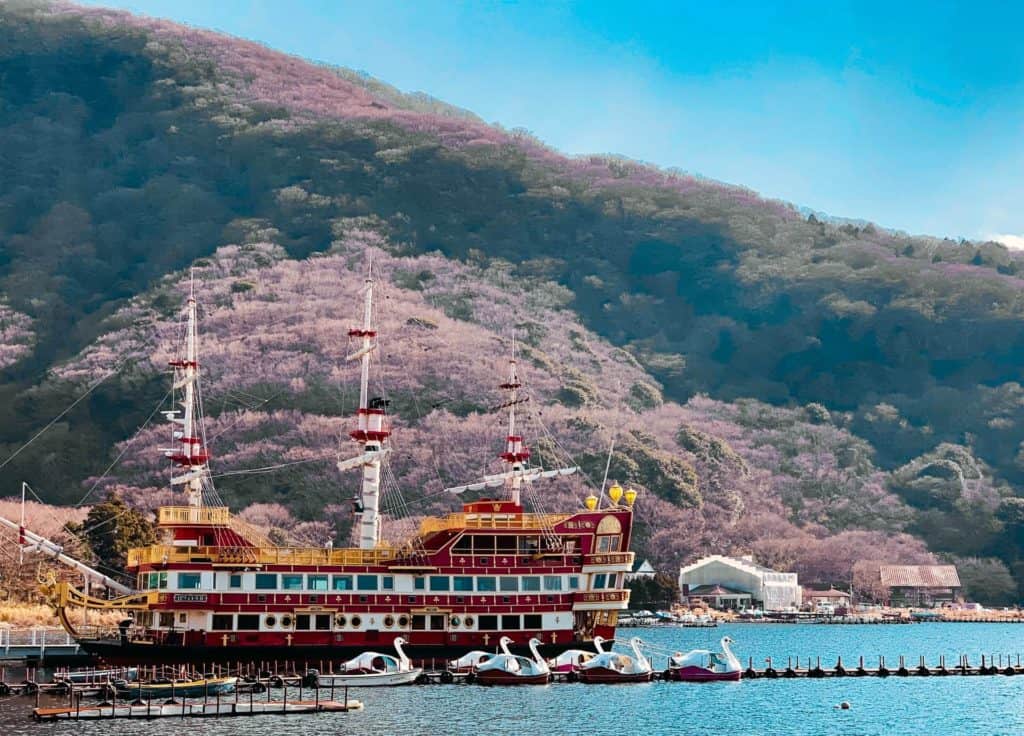
While you are on the cruise, you also have a chance to have a glimpse of the Hakone Shrine’s torii gate with Mount Fuji as the backdrop from afar.
The view is spectacularly stunning, especially on clear days where the majestic mountain is not blocked by the clouds.
Travel tip: It is not easy to have a clear view of Mount Fuji. The visibility of Mount Fuji is at its best during cold seasons either in the early morning or late afternoon.
There are two companies in Hakone offering such sightseeing cruises to travellers; Hakone Sightseeing Boats and Izu Hakone Sightseeing Boats .
The more popular option is the cruise trips offered by Hakone Sightseeing Boats. That’s because Hakone Free Pass holders can board for free!
Boarding Address: 6-40 Motohakone, Hakone, Ashigarashimo-gun, Kanagawa 250-0522, Japan
Cruise Price: Free for Hakone Free Pass holders or US$10 (1050 yen)
Cruise Duration: 30 minutes
Operating Hours : 10 am-5 pm (Might change depending on the weather and season)
How To Get To Moto-Hakone Pier
To board the Hakone sightseeing cruise, make your way to Moto-Hakone pier.
Take a 50-minute Tozan Bus (Line H) from Odawara to Moto-Hakone via Hakone-Yumoto.
6. Admire Mount Fuji View On The Hakone Ropeway
Riding on the Hakone Ropeway is another unmissable thing to do when visiting Hakone for a day.
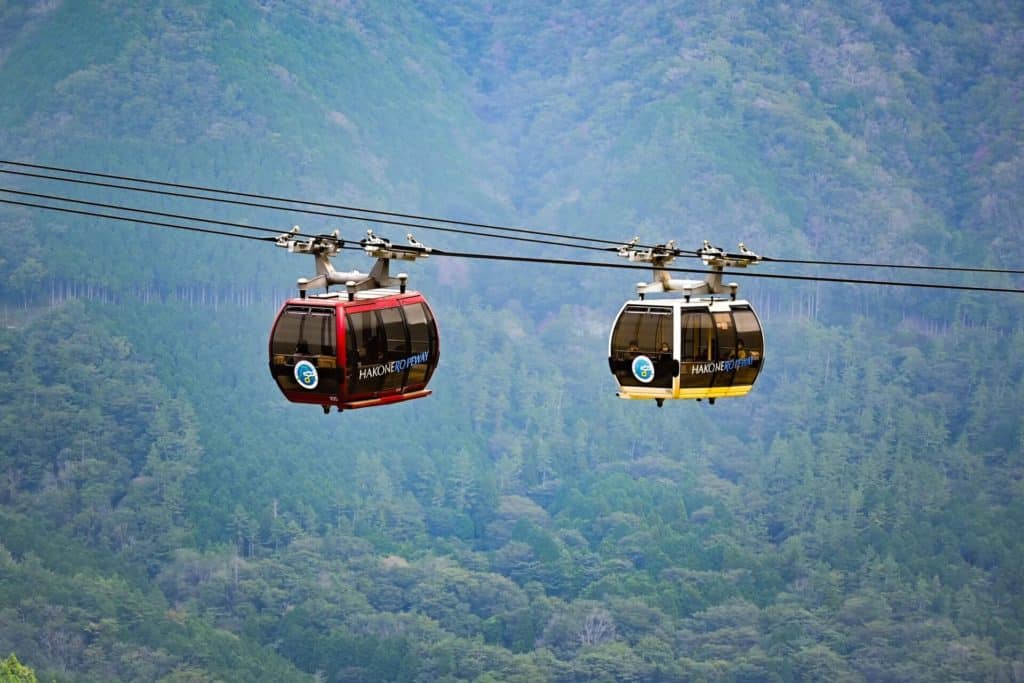
This cable-car-like system has 4 stations; Togendai, Owakudani, Ubako, and Souzan .
If you are getting on at Togendai Station, it takes about 25 minutes to reach the last station.
Hakone Ropeway offers visitors another breathtaking angle to admire Mount Fuji, Lake Ashi, and the surrounding lush green mountains at higher altitudes.
Address: 164 Moto-Hakone, Hakone-machi, Ashigarashimo-gun, Kanagawa-prefecture
Ticket Price: Free for Hakone Free Pass or US$7 one-way (740 yen)
Operating Hours: 9 am-5 pm (February to November) and 9 am-4.15 pm (December to January)
How To Get On Hakone Ropeway
You need to get to Togendai Station first. This station is located adjacent to the pier of the Hakone sightseeing cruise across Lake Ashi.
7. Enjoy Eating Black Eggs At Owakudani
Of course you can’t miss out on Owakudani from your day trip Hakone from Tokyo itinerary!
This sulphuric valley was created about 3000 years ago due to a volcanic eruption.
Thanks to this phenomenon, Owakudani offers a chance to visitors to experience the picturesque natural hot springs view and sulphurous fumes environment first-hand.
Eating black eggs in Owakudani is also one of the top things to do in this volcanic area.
These oddly coloured eggs are sold by the shop near Owakudani Station where the eggs are boiled in hot spring’s sulphuric water.
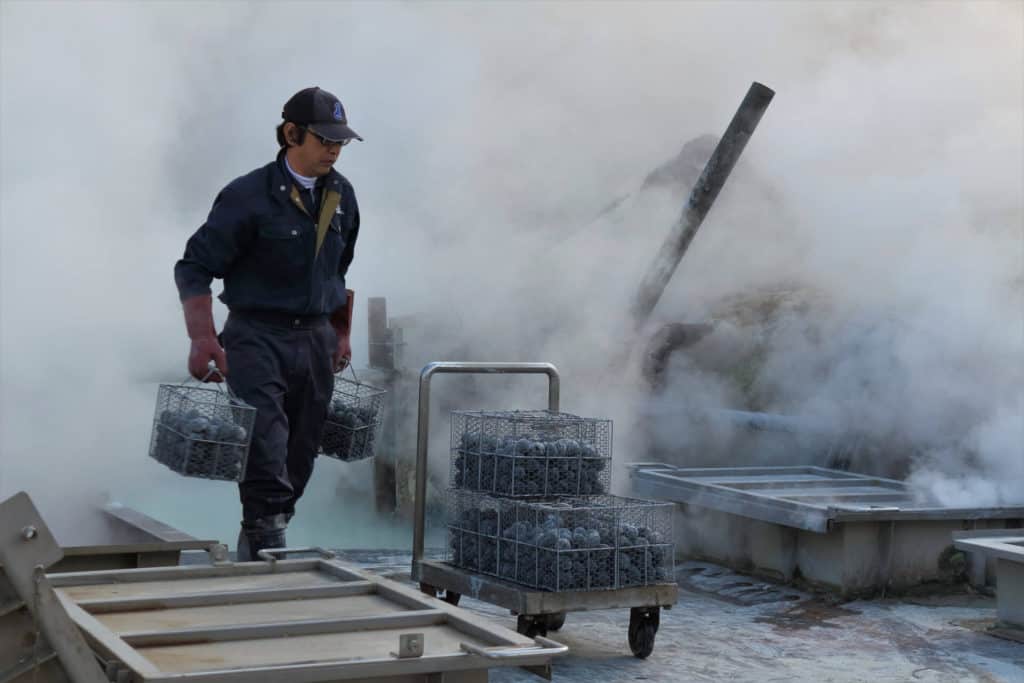
With a taste like a typical hard-boiled egg, this unique delicacy is rumoured to extend one’s lifespan by 7 years !
Address: 1251 Sengokuhara, Hakone, Ashigarashimo-gun, Kanagawa-prefecture
Visiting Hours: 9 am-5 pm (February to November) and 9 am-4.15 pm (December to January)
How To Get To Owakudani
The nearest station to Owakudani is Owakudani Station. Take the Hakone Ropeway from Togendai Station before alighting at the next stop (16 minutes).
You can also board the Hakone Ropeway from Souzan Station (8 minutes) if you are exploring the Hakone Loop in an anti-clockwise direction.
8. Experience The Zen Vibe At Choanji Temple
You can find beautifully-preserved temples in almost every part of Japan, and that includes Hakone too.
Though Choanji Temple is not as easily accessible as other highlights, this Buddhist temple makes a great stop for a short break from the bustling city life and to experience the zen vibes.
Built in 1365, you can find several scenic walking trails around Choanji Temple grounds.
Travel tip: The autumn foliage scenery in Choanji Temple is absolutely spectacular and attracts large visitor crowds during the season in November .
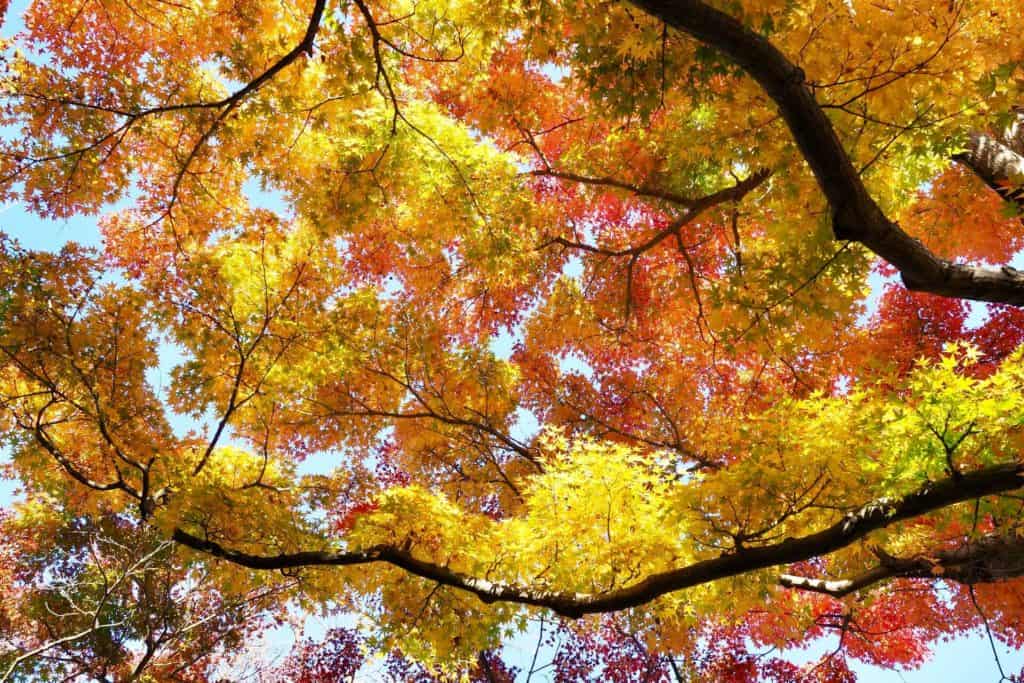
You can also expect to see over 200 Rakan (Buddhist disciples) statues with varying interesting expressions decorating the temple grounds.
Most visitors spend some time wandering around and searching for similar facial expressions on the statues to theirs for fun before moving on to the next highlight.
Address: 82 Sengokuhara, Hakone, Ashigarashimo District, Kanagawa 250-0631, Japan
How To Get To Choanji Temple
You can take Hakone Tozan Bus from Togendai and alight at the Sengoku bus stop. This takes 15 minutes. Then walk about 2 minutes before reaching the temple.
9. Visit Hakone Open-Air Museum
A day trip from Tokyo to Hakone will not be complete with a visit to Hakone Open-Air Museum .
This unique museum houses different types of indoor and outdoor art installations and sculptures.
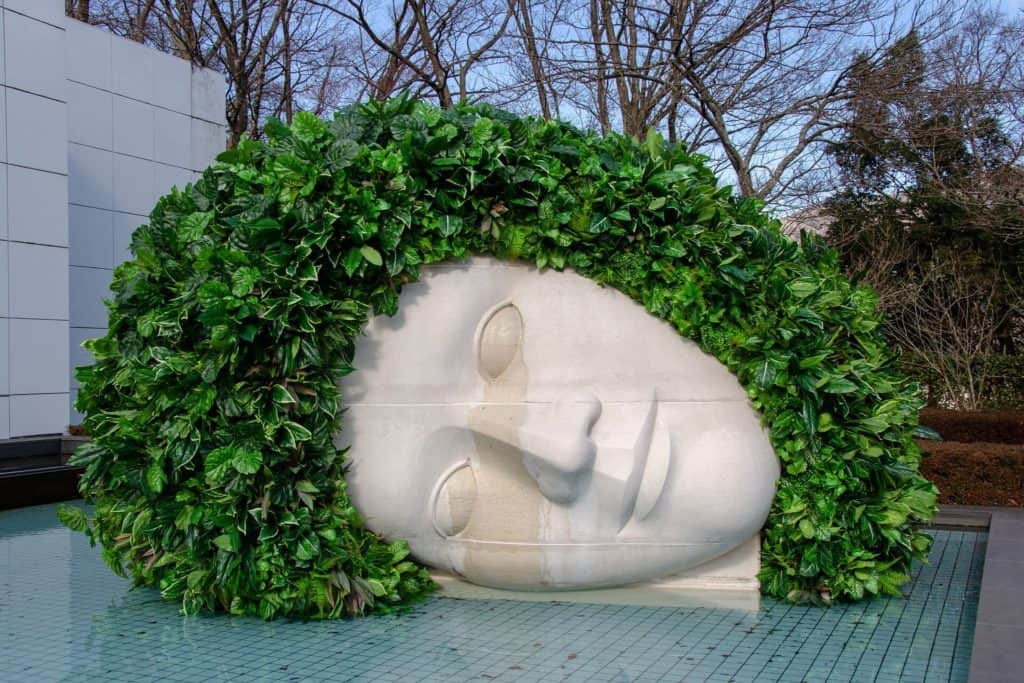
You can also find an exhibition hall dedicated to showing the artwork, sculptures, and ceramic works created by the renowned artist, Picasso .
Another beautiful sculpture-like tower that is worth admiring in the Hakone Open-Air Museum is the Symphonic Sculpture .
Visitors can walk up the spiral staircase of this symbolic sculpture to the viewing platform to enjoy the park scenery as well as the surrounding mountainous hills views.
Address: 1121 Ninotaira, Hakone-machi, Ashigarashimo-gun, Kanagawa-prefecture 250-0493
Visiting Hours: 9 am-5 pm
Entrance Fee: US$13 (1400 yen) for Hakone Pass Holder or US$14 (1600 yen)
How To Get To Hakone Open-Air Museum
You can walk from Gora for 15 minutes to reach the museum.
Alternatively, take Hakone Tozan Railway from Hakone-Yumoto to Chokoku No Mori Station (30-minute ride). Hakone Open-Air Museum is just next to this station.
10. Admire The Stunning Artwork At Pola Museum of Art
Another museum in Hakone that you can include in your Hakone day trip is the Pola Museum of Art .
This simplistic museum was opened by the famous cosmetic company, The Pola Group, to showcase the world-famous art exhibits collected by the former group owner, Suzuki Tsuneshi.
These famous art exhibits include Monet’s, Picasso’s, and Renoir’s.
Apart from these, you can also enjoy the lovely modern and contemporary sculptures, paintings, and ceramics works of Japanese and European artists in the Pola Museum of Art.
Some of the art sculptures can be admired along its outdoor nature trail.
Travel tip: The lush beech trees planted in front of the museum entrance are at least 300 years old.
Address: 1285 Kozukayama, Sengokuhara, Hakone-machi, Ashigarashimo-gun, Kanagawa, 250-0631 Japan
Entrance Fee: US$14 (1600 yen) for Hakone Free Pass holder or US$16 (1800 yen)
How To Get To Pola Museum of Art
Take a 15-minute Hakone Tozan Bus ride from Gora Station and alight at Pola Bijutsukan bus stop.
11. Explore Lalique Museum
If you can’t get enough of visiting museums, you can add Lalique Museum to your to-visit list.
This intriguing museum displays over 1500 glass objects and jewellery created by a famous French craftsman, René Lalique.

You can expect to find a French cuisine restaurant and a small garden within the museum grounds.
Visitors can also opt for a high tea session in the stunning Orient Express wagon for the luxurious ambience.
Address: 186-1 Sengokuhara, Hakonemachi,AshigaraShimo-gun, Kanagawa 250-0631, Japan
Visiting Hours: 9 am-4 pm
Entrance Fee: US$14 (1500 yen)
How To Get To Lalique Museum
From Hakone-Yumoto Station, take a 30-minute Hakone Tozan Bus ride towards Togendai and alight at Sengoku Annai-jo Mae.
12. Create Your Own Arts At Gora Park
If you are inspired by the numerous art exhibits in the art museums of Hakone, you can easily create yours in Gora Park .
This beautiful French-styled park is home to two lovely greenhouses, a fountain, a restaurant, a teahouse, and the Crafthouse.
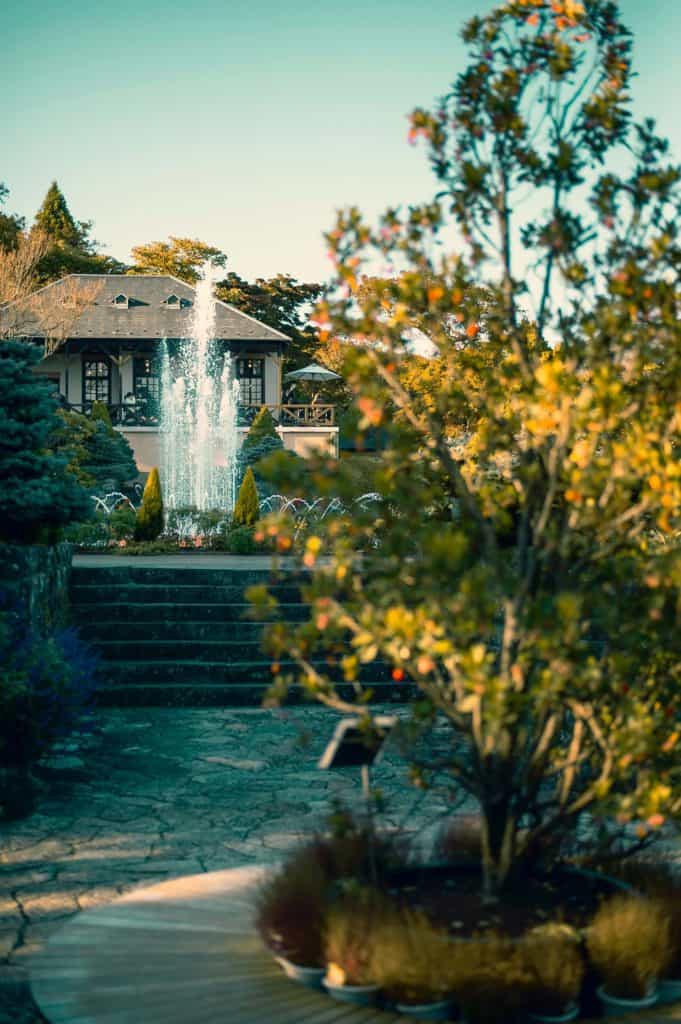
The Crafthouse offers several craft classes to visitors who are keen to learn new craft skills .
Some available craft workshops include glassblowing, pottery, and dried flower arrangement.
Even if these hands-on workshops are not your cup of tea, you can still have a stroll around Gora Park and enjoy its enchanting scenery.
Address: 1300 Gora, Hakone-machi, Ashigarashimo-gun, Kanagawa 250-0408, Japan
Entrance Fee: Free for Hakone Free Pass Holder or US$5 (550 yen)
Workshop Fee: US$9 to US$44 (1000 yen to 5000 yen)
How To Get To Gora Park
You can walk from Gora Station to Gora Park within 5 minutes.
13. Shop At Gotemba Premium Outlets
Want to have a shopping spree during your Tokyo to Hakone day trip? Make sure to head over to Gotemba Premium Outlets .
This popular mall houses many designer brands stores, restaurants, a hotel, a Ferris wheel, and a public onsen.
Over here, you can get cheaper priced luxury goods with a great view of Mount Fuji at the back.
Address: 1312, Fukasawa Gotemba-Shi, Shizuoka, 412-0023, Japan
Operating Hours: 10 am-7 pm (March to November) or until 8 pm (December to February)
How To Get To Gotemba Premium Outlets
Take the Hakone Tozan bus (Lines L, M, or S) from Gora Station to Gotemba Premium Outlets. It takes about 45 minutes to reach there.
14. Have A Stroll Along Mishima Skywalk
Mishima Skywalk is perhaps a lesser-shared place on the internet when it comes to the Tokyo to Hakone day trip itinerary.
Nevertheless, this suspension bridge has much to offer to visitors.
Also the country’s longest pedestrian suspension bridge , Mishima Skywalk is a great place to admire the picturesque view of Mount Fuji and Suruga Bay surrounded by lush greenery that extends to as far as the eyes can see.
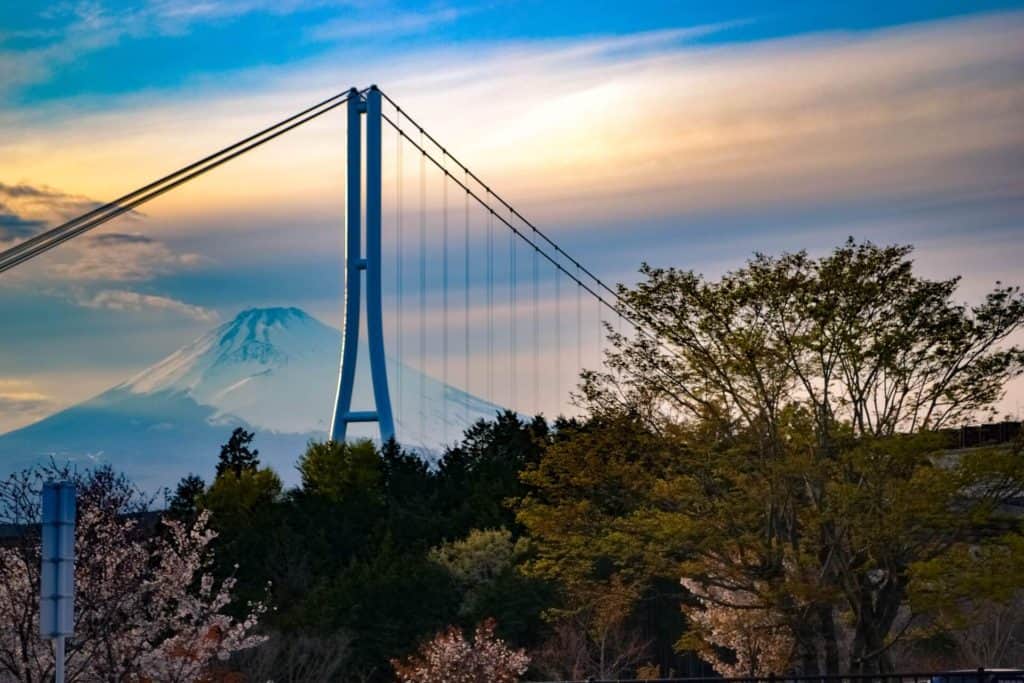
Travel tip: The best time to enjoy the beautiful scenery at Mishima Skywalk is early morning or during sunset.
Another thrilling way to admire the scenery is to sign up for its Long Zip Slide (glide for 300 metres suspended in the air) or other fun climbing activities.
You can also find a cafe serving food made from local produce located near the stunning bridge.
Some of the popular dishes to try are Mishima Curry and Mishima Croquette.
Address: 313 Sasahara Shinden, Mishima City, Shizuoka Prefecture
Visiting Hours: 9 am – 5 pm (Depending on the weather conditions)
Entrance Fee: Adult US$9 (1000 yen)/ Free to US$5 (500 yen) for child
How To Get To Mishima Skywalk
From JR Mishima Station, take the Tokai Orange Shuttle Bus to Motohakone Port and stop at Mishima Skywalk station. This takes about 20 minutes.
15. Visit Odawara Castle
If you are a fan of Japanese Castle, you will be glad to know that this lively town is home to Odawara Castle .
With a history dating back to the 15th century, the current castle was reconstructed several times over the years due to wars and natural disasters.
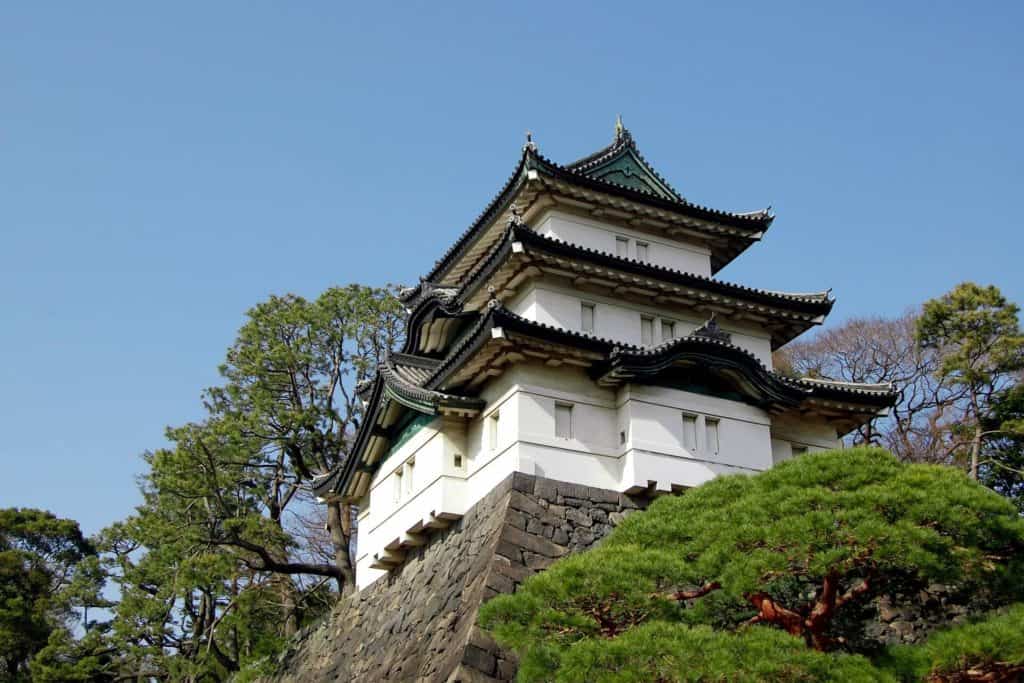
Nevertheless, the traditional castle architecture with a nostalgic vibe is still retained. The castle keep was rebuilt based on the Edo Period’s models.
You can see the old samurai artefacts such as swords at the Samurai Museum located within Odawara Castle grounds.
The castle also houses a Ninja Museum where visitors can join the ninja obstacle course and learn a thing or two about ninja culture.
Odawara Castle is a great spot for hanami (cherry blossoms) watching among the locals in spring.
So make sure not to miss out on Odawara Castle during your day trip in Hakone!
Address: Jonai, Odawara, Kanagawa 250-0014, Japan
Visiting Hours: 9 am – 5 pm
Entrance Fee: US$5 (510 yen)
How To Get To Odawara Castle
Take a 10-minute walk from Odawara Station through Ohoribata Street to Odawara Castle.
16. Get Souvenirs At Hakone-Yumoto Shotengai
In Hakone, the best place to get some cheap souvenirs during Hakone day trips is at Hakone Yumoto Shotengai .
Travel tip: Shotengai refers to the covered shopping arcade.
At Hakone Yumoto Shotengai, you can find many everyday items, souvenirs, Japanese snacks, restaurants, and cafes sold and operated by local vendors.
Some of the popular Hakone souvenirs to get are kamaboko (fish products) and Yosegi zaiku , a type of local woodcraft.
Address: Shiroishi-shimo, Yumoto, Hakone Town, Ashigarashimo District, Kanagawa
Operating Hours: Varies depending on stores (Typically from 8.45 am to 5.30 pm)
How To Get To Hakone-Yumoto Shotengai
Hakone-Yumoto Shotengai is a few minute-walk from Hakone-Yumoto Station.
17. Have A Dip At Local Onsen
If you are planning to overnight at Hakone, make sure to go for a dip at the local onsen before calling it a day.
Some of the onsens are infused with a variety of interesting items, such as red wine, green tea, Japanese sake, and so much more.
Here are some of the recommended onsens to get to in Hakone:
- Kohan-no-yu
This relaxing session comes in handy to wind down and rest after exploring this beautiful town during the day.
Travel tip: Make sure to check out the onsen’s policy on visitors’ tattoos before heading over. Some onsens deny entry to any inked visitor.
And that’s the wrap! I hope you will have a blast on your day trip to Hakone.
Getting From Tokyo To Hakone
There are several ways to get from Tokyo to Hakone, depending on whether you have the JR pass with you.
Regardless of which method you pick, the typical sequence is that you will have to travel from Tokyo to Odawara before getting to Hakone-Yumoto Station to kick start the Hakone Loop circuit.
With JR Pass
If you have already activated your JR pass, you can board the JR train from Tokyo Station to Odawara . This will only take about 35 to 40 minutes.
Upon reaching Odawara Station, you can get the Hakone Free Pass ticket for US$44 (5000 yen).
From there, you can board the Hakone Tozan Train to Hakone-Yumoto Station.
Note: This ticket does not include the round trip between Shinjuku and Odawara.
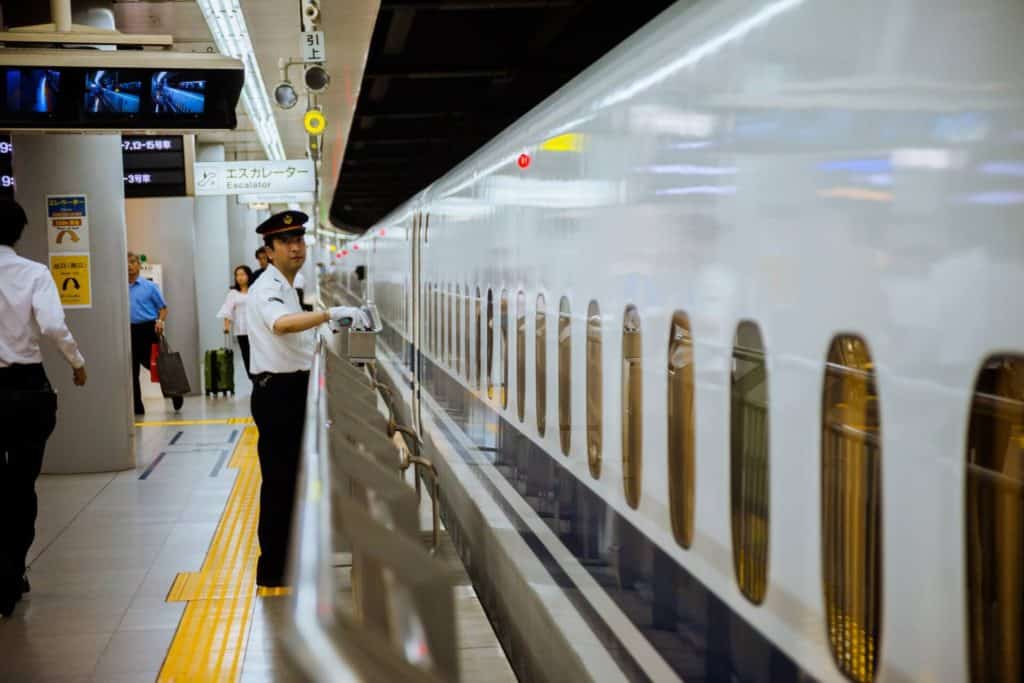
Planning to visit to several Japanese cities during your vacation? JR Pass is the most convenient, fast, and wallet-friendly way to do so.
Without JR Pass
Though utilising the JR Pass to get from Tokyo to Odawara is easier and time-saving, you can still get there without one.
Here are some other alternatives for day trip Hakone from Tokyo travel and respective tickets to get:
- Buy a Hakone Free Pass for US$54 (6100 yen) that includes a round trip from Tokyo’s Shinjuku Station to Odawara Station on the Odakyu Line. The duration is about 1.5 hours.
Note: The train on this line is the typical commuter train so it can be crowded at times with limited seats.
- If you want to travel comfortably and at a shorter time , you can consider getting on the Romancecar train .
The train will stop directly at Hakone-Yumoto Station and the whole journey takes about 75 minutes.
This Romancecar seat will cost an additional US$10 (1100 yen) one-way on top of the Hakone Free Pass ticket.
Note: You will need to make a reservation online for a Romancecar seat or get it at Shinjuku Station at Odakyu Railway.
For easy comparison, check out this pricing table on different travel methods from Tokyo to Hakone:
Note: The Hakone Free Pass pricing listed here is for a 2-Day pass only. The figure shown is a rough estimate only.
Getting Around Hakone
Hakone free pass.
Hakone Free Pass is a great way to explore around Hakone at a discounted price , especially for budget travellers.
This travel pass allows visitors to take unlimited rides on the 5 main transportation modes (buses, trains, ropeways, boats, and cable cars) in Hakone.
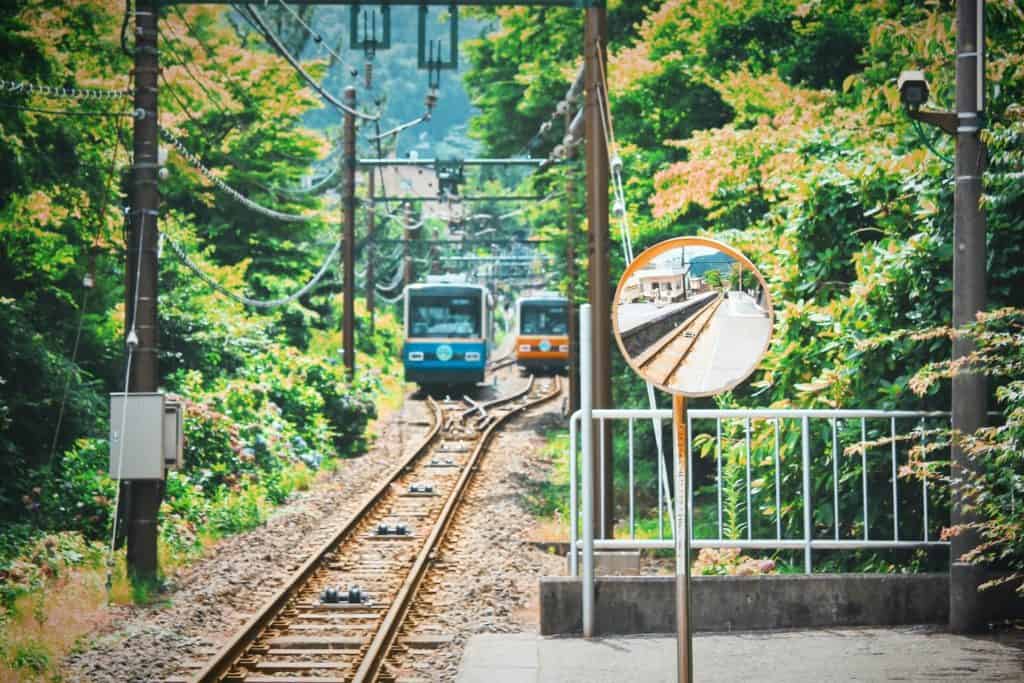
So instead of queuing to purchase different transportation tickets, you can just show the Hakone Free Pass to the drivers before alighting.
This makes travelling around Hakone so convenient and saves lots of time too!
About 50 attractions in Hakone can also be entered for free or at a discounted price for Hakone Free Pass holders.
Travel tip: You can always look for the sticker pasted on the buildings’ doors if they are the participants of this program.
Types Of Hakone Free Pass
There are 2 types of Hakone Free Pass to choose from; 2-Day and 3-Day.
There is no day trip Hakone Free Pass ticket available, so your best bet will be the 2-Day pass .
Where To Buy Hakone Free Pass
Unlike a train ticket, Hakone Free Pass is not easily obtainable from the typical ticketing machines in every train station.
You can only get the Hakone Free Pass at Odakyu Sightseeing Centres at:
- Shinjuku Station
- Odawara Station
- Hakone-Yumoto Station
Or the stations on the Odakyu Lines.
However, the queue at these counters can be long at times especially on weekends and peak seasons and ultimately greatly affects your Hakone arrival time.
To skip the queue, you can buy the Hakone Free Pass conveniently online at Klook . The online ticket price is also way cheaper than those at the ticketing counter.
Save time and money? That is so totally for me and I hope that is for you too!
After you have bought the Hakone Free Pass online, you can visit the Odakyu Sightseeing Centre to collect the ticket up to 7 days in advance. It is that convenient.
Get your Hakone Free Pass online at Klook at a cheaper price and queue-free!
Hakone Loop
Hakone Loop refers to the Hakone travel circuit where visitors can follow easily and visit most of the major highlights within 1 day.
There are 5 different transportation modes involved to make this day trip Hakone Loop a success one:
- train,
- boat,
- ropeway,
- and cable car.
This loop is typically done in an anti-clockwise direction where both the starting and ending point is Hakone-Yumoto Station.
Travel tip: Most visitors visit the attractions in the anti-clockwise direction and hence it can get touristy.
Below is the typical order of transportation used based on the anti-clockwise direction of Hakone Loop:
- Odawara to Hakone-Yumoto Station and to Gora (Hakone Tozan Train)
- Gora to Sounzan (Hakone Tozan Cable Car)
- Sounzan to Owakudani and to Togendai (Hakone Ropeway)
- Togendai to Hakone-machi or Moto-hakone (Hakone Boat across Lake Ashi)
- Hakone-Yumoto to Odawara (Hakone Tozan Bus)
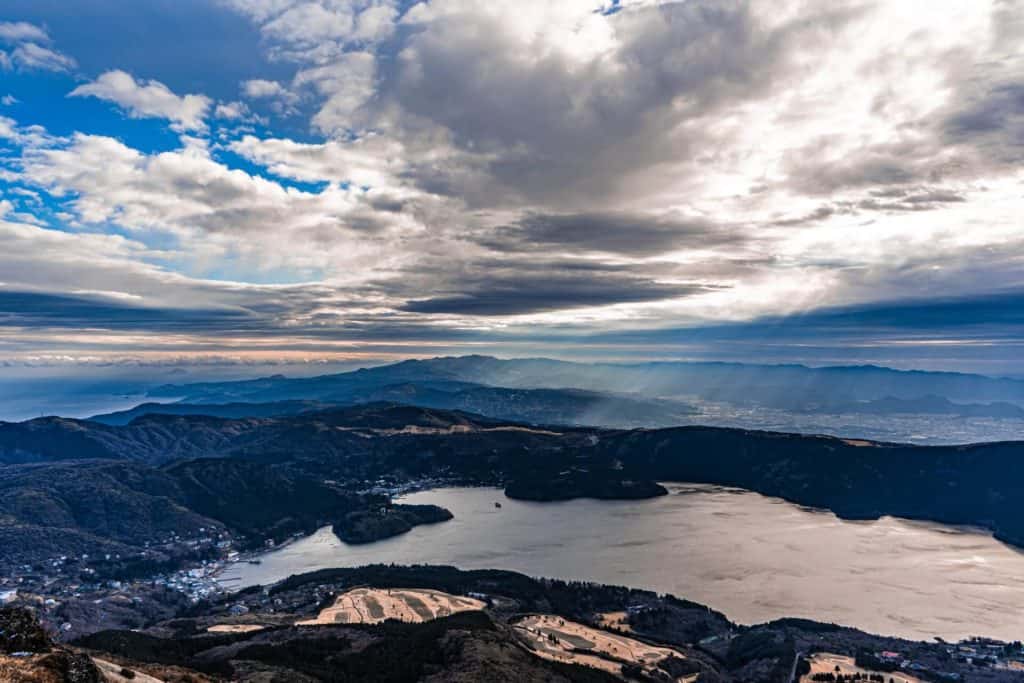
Nevertheless, you can choose to run the Hakone Loop in the clockwise direction or start from any point in Hakone.
And regardless of which route you take, you can expect to complete the round course within 8 hours and head back to Tokyo directly after the day trip Tokyo to Hakone concludes.
But if you have extra time and spend the night in Hakone, the best way to end the day is by pampering yourself for an onsen session!
Note: This article follows the clockwise direction of Hakone Loop.
Additional Places To Go In Hakone
Pampas grass field.
Pampas Grass Field covers the base of Mount Hakone for more than a hundred metres long.
Most visitors visit this beautiful grass field during autumn when the pampas grass turns a whitish golden colour offering stunning scenery.
Nevertheless, Pampas Grass Field is picturesque at any time of the year.
The field changes colour according to the season which is charming in its own way; bright green in early summer to yellowish-green in late summer and brown in winter.
There is a clear walking path for visitors to stroll along admiring the vast grass field from the entrance point to the other end.
So if you are looking for ample photo opportunities on your day trip to Hakone from Tokyo, make sure to head over to Pampas Grass Field!
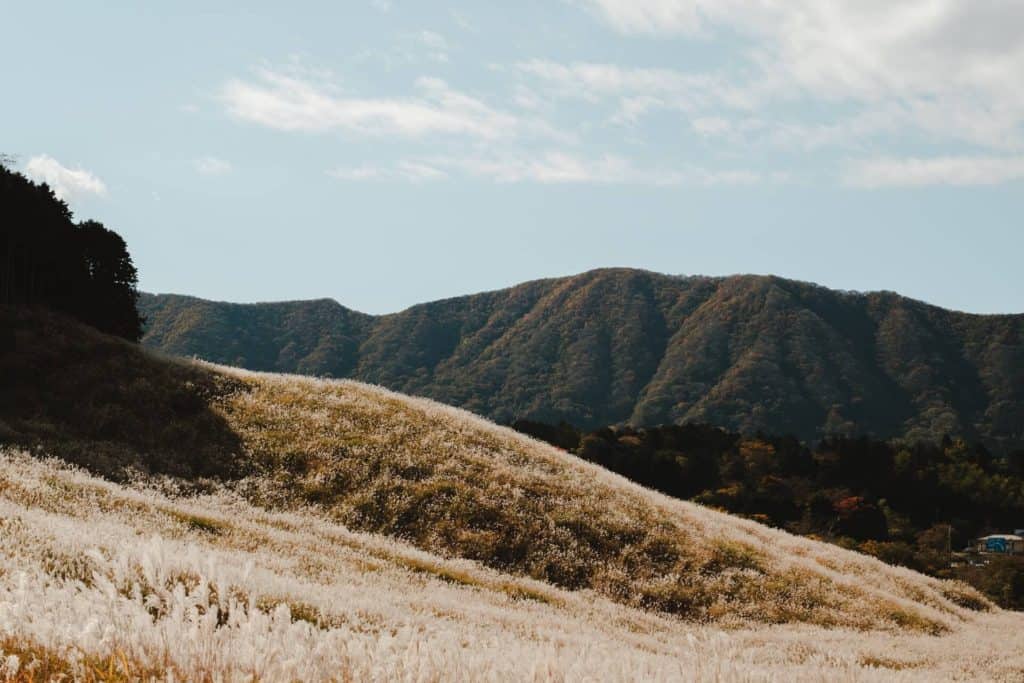
Travel tip: It is recommended to stay on the path and not to stray into the field for your safety.
Address: Sengokuhara, Hakone, Ashigarashimo District, Kanagawa 250-0631, Japan
How To Get To Pampas Grass Field
You can take Hakone Tozan Bus from Togendai Station and alight at the Sengoku Kogen bus stop. The duration is about 5 minutes.
Hakone Travel Pass: Covered
How Many Days Do You Need In Hakone
You can explore Hakone and visit all the main attractions by following the Hakone Loop circuit within a day .
But if you prefer to explore this lovely onsen town at your own pace or plan for a long hike, it is recommended to stay in Hakone for at least 2 days.
Where To Stay In Hakone
Depending on your budget, here are some recommended places to stay in Hakone if you decide to stay for the night:
- Budget: K’s House Hostels , Hakone Hostel 1914
- Mid-range: Rohen Resort & Lounge , Yumoto Station Hotel
- Luxury: Hakone Onsen Sanso Nakamura , Hakone Lake Hotel
- Ryokan: Hakone Kowakien Tenyu , Gyokutei
Travel tip: Fancy staying in a ryokan and enjoying the privacy soaking in your own onsen without sharing the bath with strangers? Oh yes I’m talking to you, anti-nudists!
Check out my detailed article on the best ryokan with private onsen in Hakone to book for your upcoming vacation!
What To Eat In Hakone
Here are Hakone’s specialities that you should not miss during your Hakone day trip:
Kuro-Tamago (Black eggs)
This unique delicacy is a must-get snack when you are at Owakudani .
Kuro-tamago is prepared by boiling the eggs in Owakudani’s hot spring at 2 varying temperatures and durations.
The black colour of the shells is owed to the chemical reaction between the minerals and water.
Kuro-tamago tastes just like a typical boiled egg and legend has it that consumption of an egg can help to extend one’s lifespan by 7 years!
Kamaboko is made of fresh fish paste and is usually eaten as snacks or with soup.
You can find many variations and colours of kamaboko in Hakone, where white and pink coloured are the most common ones.
Travel tip: These two colours are associated with good luck.
The best place to try and buy kamaboko is at Hakone-Yumoto Shotengai . Some vendors offer free samples to travellers so that they can try and buy as souvenirs for people back home.
Wakasagi (Pond smelt)
Wakasagi is found in Hakone’s Lake Ashi and it is a popular delicacy among the locals.
In Hakone, the most common method to cook wakasagi is by deep-frying and soft boiling.
This simple fish dish is best paired with white rice and sweet soy sauce.
You can indulge in wakasagi at the restaurants near Lake Ashi after the cruise and continue admiring the scenic lake view while eating.
Unique Tips When Visiting Hakone
Here are some helpful tips to know for a better travel experience to Hakone day trip from Tokyo:
Visit Hakone On Weekdays Or Off-Season
Hakone is highly visited by the Tokyo urbanites on weekends for a short getaway from the bustling metropolitan.
So the best time to visit Hakone without massive crowds is on weekdays or during off season.
Get To Hakone Early From Tokyo
Depending on which transportation mode you take to get to Hakone from Tokyo, it is always advisable to leave for this beautiful onsen resort early in the morning.
This is especially for Hakone day trip travellers who want to visit every major highlight of Hakone before the last train for Tokyo leaves.
Therefore, it is recommended to reach Hakone within 8.30 am to 9.30 am so that you can check out the places at your pace without rushing around too much.
Visit Hakone Shrine Early Morning Or Late Afternoon
Hakone Shrine is one of the main tourist attractions in Hakone thanks to its floating torii gate facing Lake Ashi.
If you are not a big fan of queuing for photoshoots, you can visit the shrine either in the early morning or late afternoon to skip the crowd.
Travel tip: You may need to wait in line for an hour just to take pictures of the torii gate with dazzling Lake Ashi and lush green mountains as the backdrop.
Wear Mask At Owakudani
Owakudani is an active volcano valley that emits sulphuric fumes constantly.
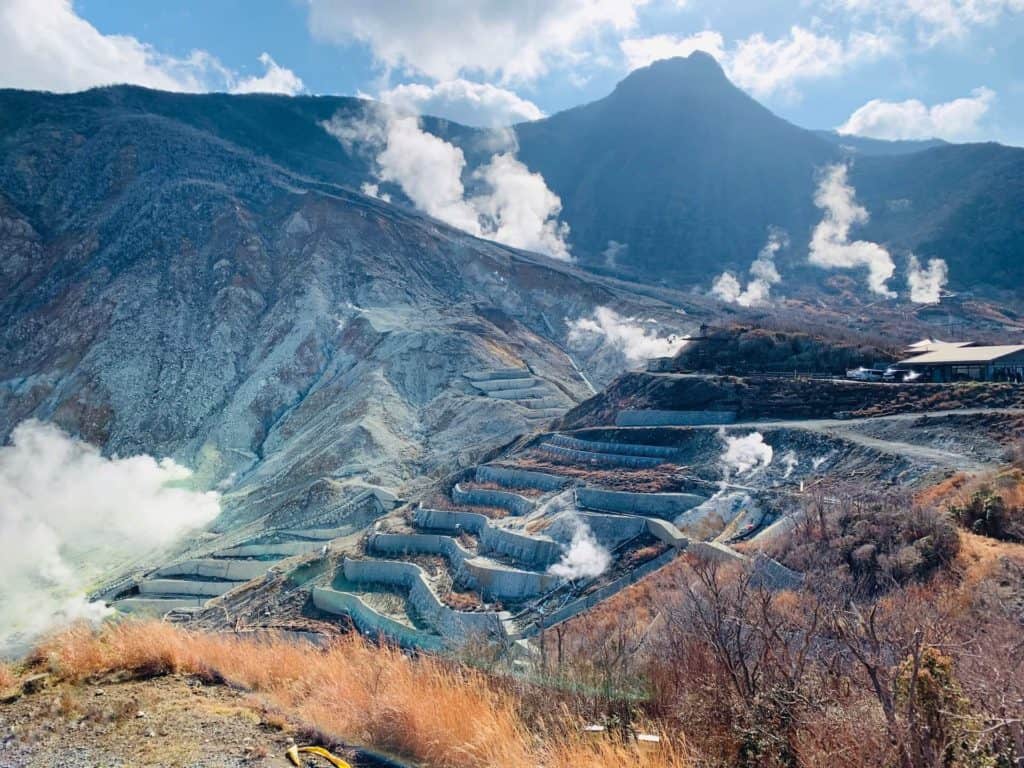
The acidic fumes might be too strong for some visitors so it is best to bring along a mask to cover your nose before visiting this picturesque valley.
Wear Comfortable Walking Shoes
Though you can easily get from one place to the other via the various transportation modes in Hakone, there is still some walking involved.
Hence, make sure you are in your comfortable walking shoes so that you have a pleasant and memorable day trip Hakone from Tokyo.
FAQ: Day Trip To Hakone From Tokyo
How long is the train ride from tokyo to hakone.
You can conveniently reach Hakone from Tokyo by train within 1.5 to 2 hours.
And hence, Hakone is typically popular among the urbanites for a short, relaxing getaway during the weekends.
Can you do a day trip to Hakone from Tokyo?
This is what this detailed article is about—a day trip from Tokyo to Hakone!
You can leave the metropolitan city in the early morning by train for a thrilling Hakone day trip.
Once you reach Hakone, you can expect to spend around 6 to 8 hours visiting its main attraction before boarding the last train back to Tokyo.
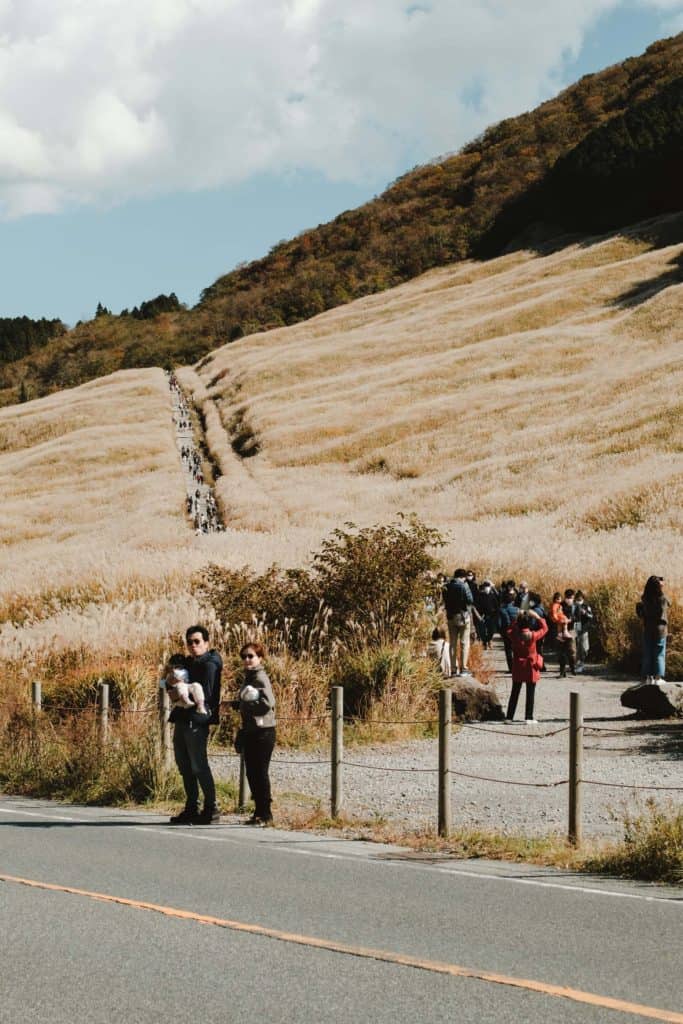
Should I stay overnight in Hakone?
A big yes for that—especially if you want to explore Hakone at a slower pace. You can end your first day in Hakone by having a relaxing dip in the onsen at night.
The next morning you can still visit other beautiful Hakone highlights before going back to Tokyo.
Day Trip To Hakone From Tokyo: Conclusion
So there you go—the many fun-filled things to do for a day trip to Hakone from Tokyo that you will not be disappointed with!
Generally, it is easy to get to the major highlights around Hakone thanks to its variety of public transportation systems. And you will never go wrong with a Hakone Free Pass.
Are there any other things to do in Hakone that I did not include in this article? Please share them with me—I would really love to hear from you.
Or if you are planning a Tokyo Hakone day trip, make sure to save this article for future easy reference and not to forget to share it with your travel buddies!
More Articles:
- Best 16 Kyoto Food Tours (For Delicious Feasts!)
- Best 12 Bike Tours In Kyoto In 2023 (+E-Bike Options!)
- Top 23 Snacks In Japan To Try (And Where To Get Them)
- Tokyo Treat Review In 2023: A Quick Read (100% Unbiased)
- Takayama in Winter: All You Need To Know (2023 Guide)
- Top 15 Instagrammable Places In Kyoto You Should Not Miss

Sam Lee, founder of Sam Lee Travel, is a seasoned traveler with over 10 years of experience exploring various Asian countries. Having lived in Singapore for almost a decade, Sam has developed a deep understanding of the culture, customs, and attractions in the region.
With a passion for outdoor travel adventures and water sports, Sam has helped over 25K readers per month plan their trips around Asia, including off-the-beaten-path destinations, offering helpful travel tips and unfiltered personal travel experience.
- Destinations
- Travel Tips
- Community Trips
- TTIFridays (Community Events)
- SG Travel Insider (Telegram Grp)

Hakone Guide — The Day Trip You Need in Your Tokyo Itinerary
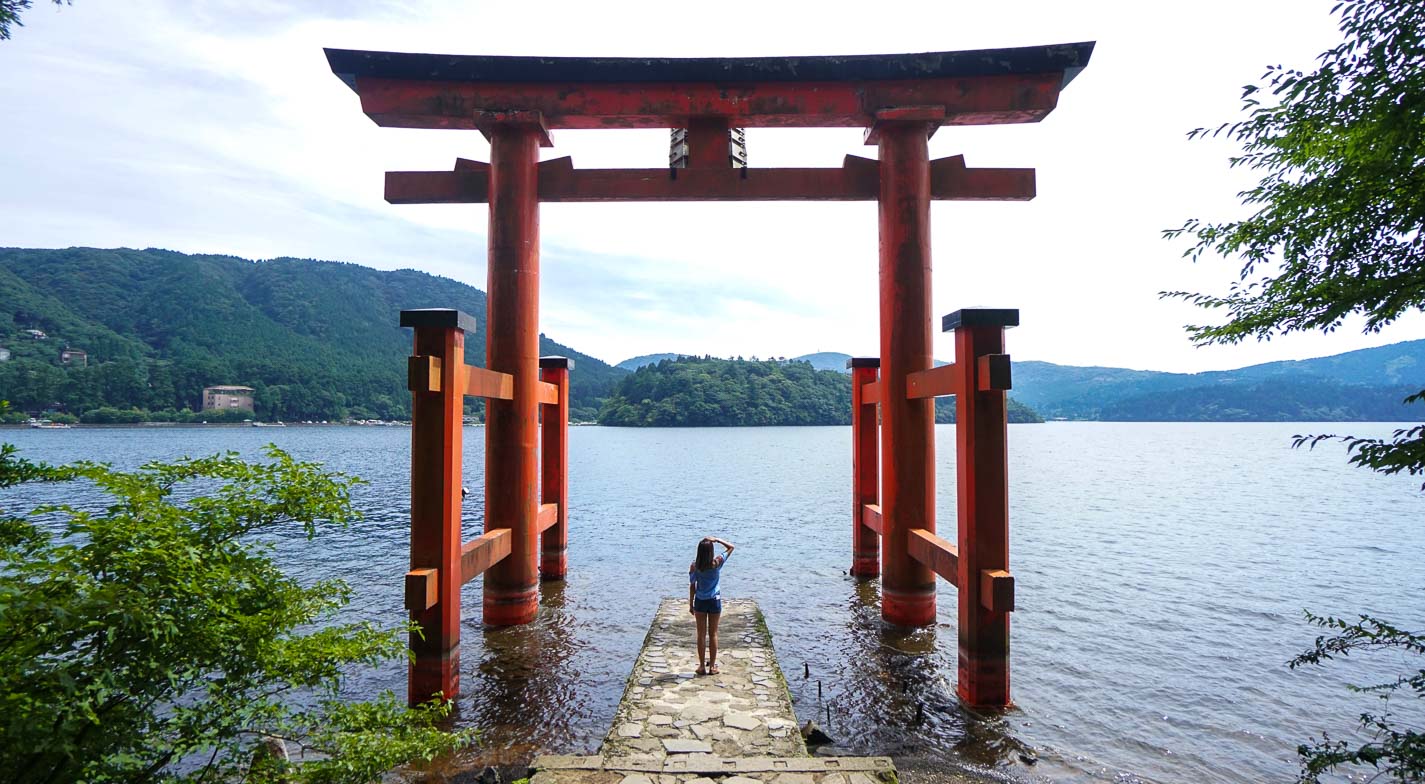
This Hakone guide will show you the best route to getting around Hakone — especially for those who only have a day to spare.
Hakone felt a lot like exploring Disneyland — think pirate ships, old trains that zig zag up the mountains and cable ropeways that hover over foggy volcanic valleys. After spending a few days in Tokyo , Hakone was truly a whole new world.
Throw in onsens and a view of Mount Fuji across the lake, it’s no wonder why locals from Tokyo love hopping by for the weekend.
Read also: 10 Day JR Pass itinerary from Tokyo to Osaka for under S$1.1k
Getting Around With A Hakone Free Pass
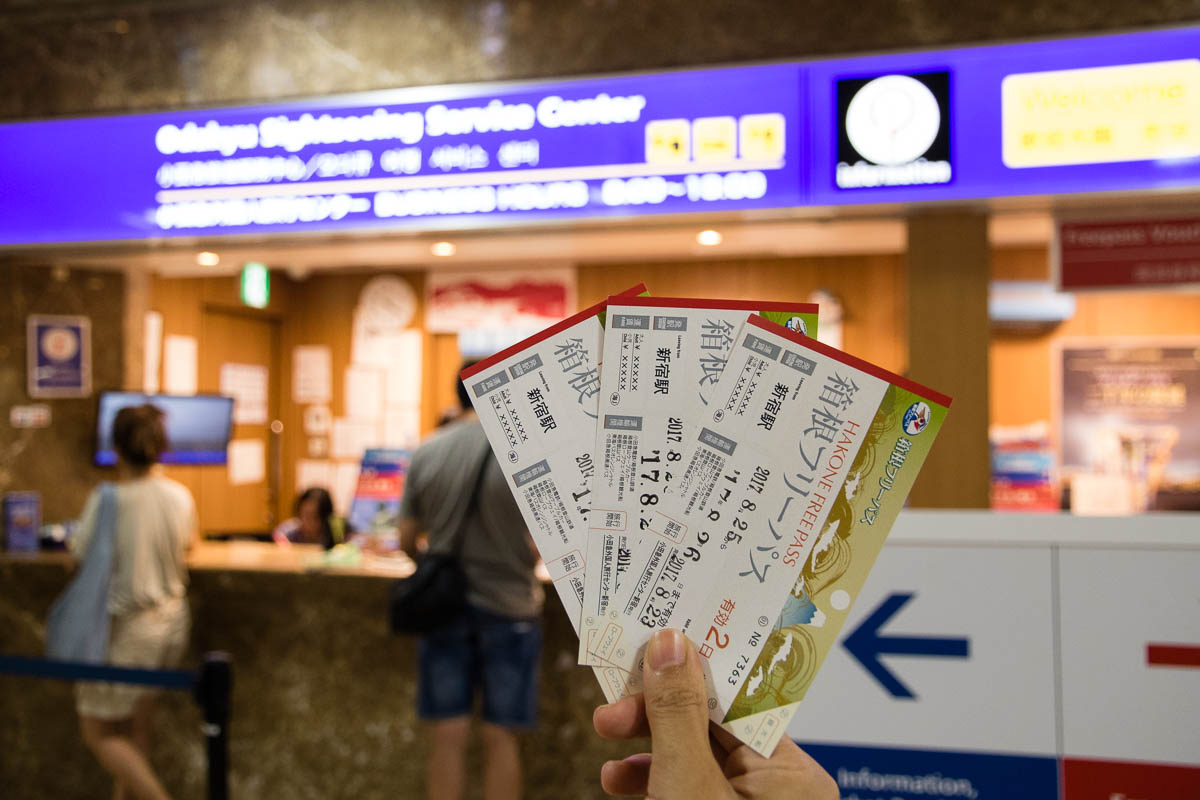
This is the only transport pass you’ll need to cover all the key sights in Hakone. It comes in a 2-day (¥5,700) and 3-day (¥6,100) option and includes all the different transport needed to reach the main attractions as well as discounts on certain vendors.
We got the 2-day Hakone Free Pass through Klook for ~S$62 and collected them at the Odakyu Sightseeing centre (Shinjuku Station). If you’re following this itinerary, we’d recommend collecting it the day before so you can catch the first train. The Odakyu counter only opens at 8AM.
*Jan 2020 Update: The 2-day pass now costs ~S$72 and the 3-day pass costs ~S$77
If you’re wondering whether the pass is worth its value since we’re only using it for a day, find out from our budget breakdown at the end of the post .
Getting from Tokyo to Hakone
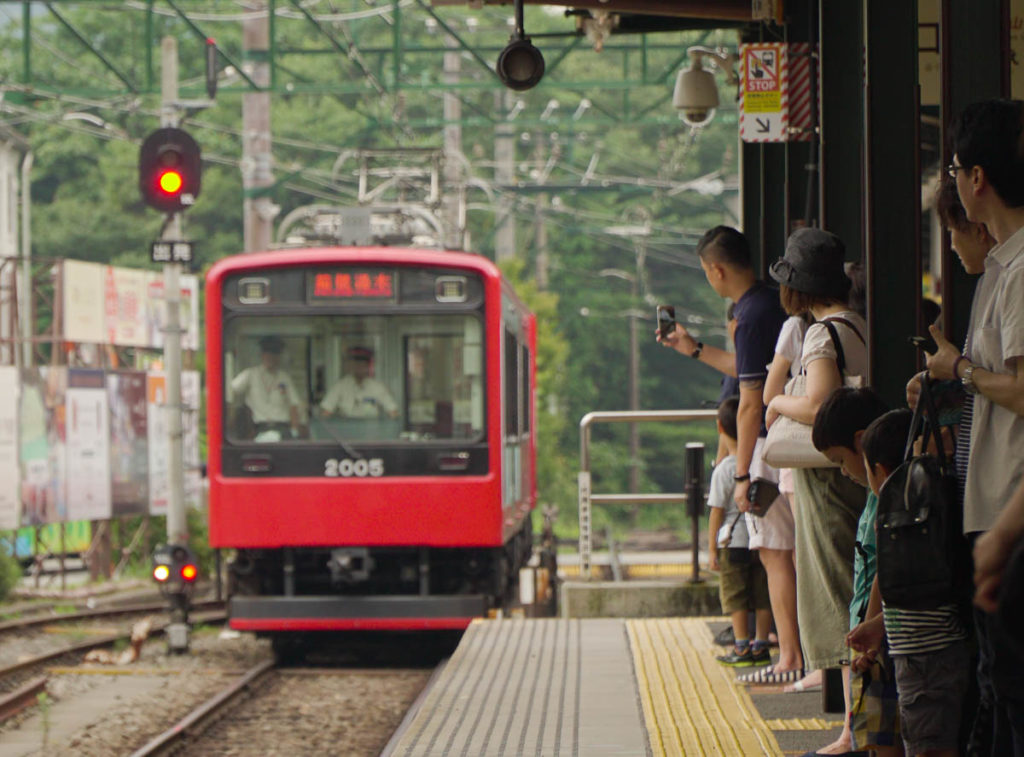
Budget Option via Odawara
Included in the Hakone Free Pass is the ride from Shinjuku to Odawara station (85mins) via the Odakyu Line. At Shinjuku station, show your Hakone Free Pass at the manned gantries to have it stamped.
From Odawara, transfer to the Hakone Yuzan train and get off at Hakone Yumoto Station; where your adventure begins!
Premium/Direct Option (Romance Car)
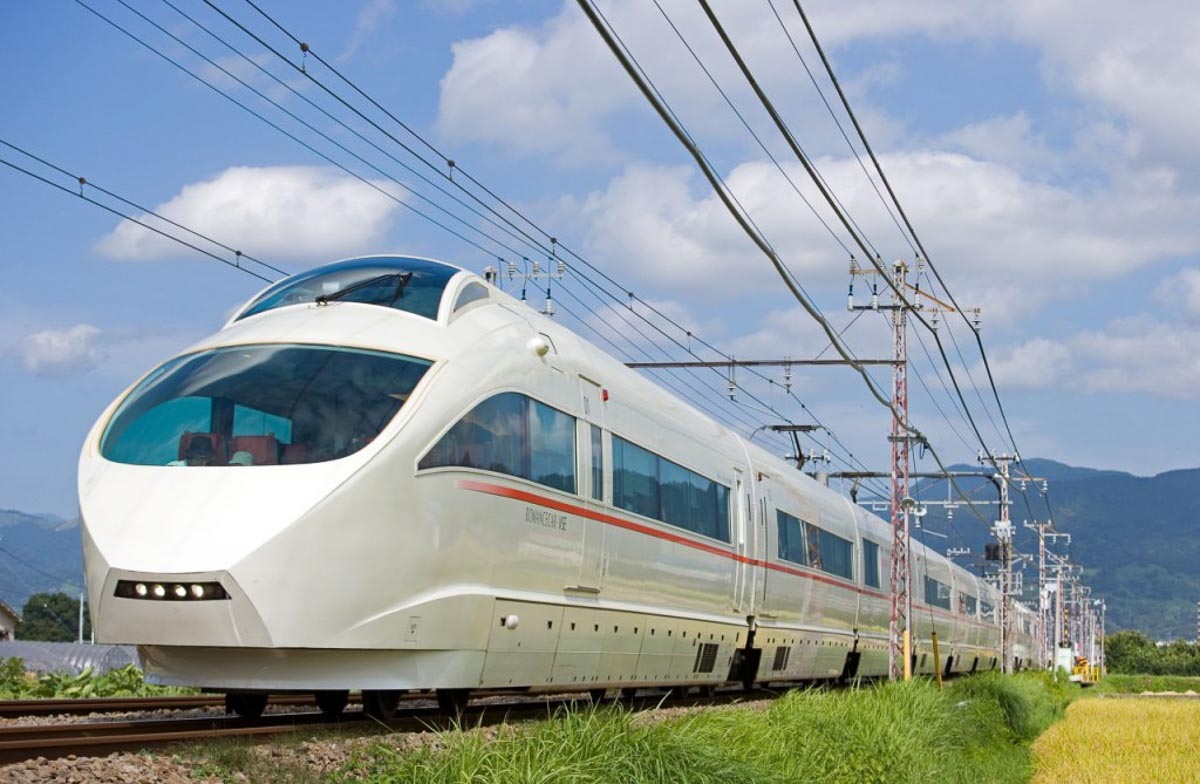
Photo credit: Odakyu Electric Railway
A more convenient route is via the Romance car . This requires a ¥890* top up on top of the Hakone Free Pass but you get to ride in the train with large panoramic windows. This train also travels direct from Shinjuku to Hakone Yumoto station so there’s no need to change trains at Odawara.
*Mar 2018 Update: Top up for the Romance Car now costs ¥1090 one-way (Shinjuku to Hakone-Yumoto station) instead of ¥890.
Hakone Day-Trip Itinerary (Clockwise Route)
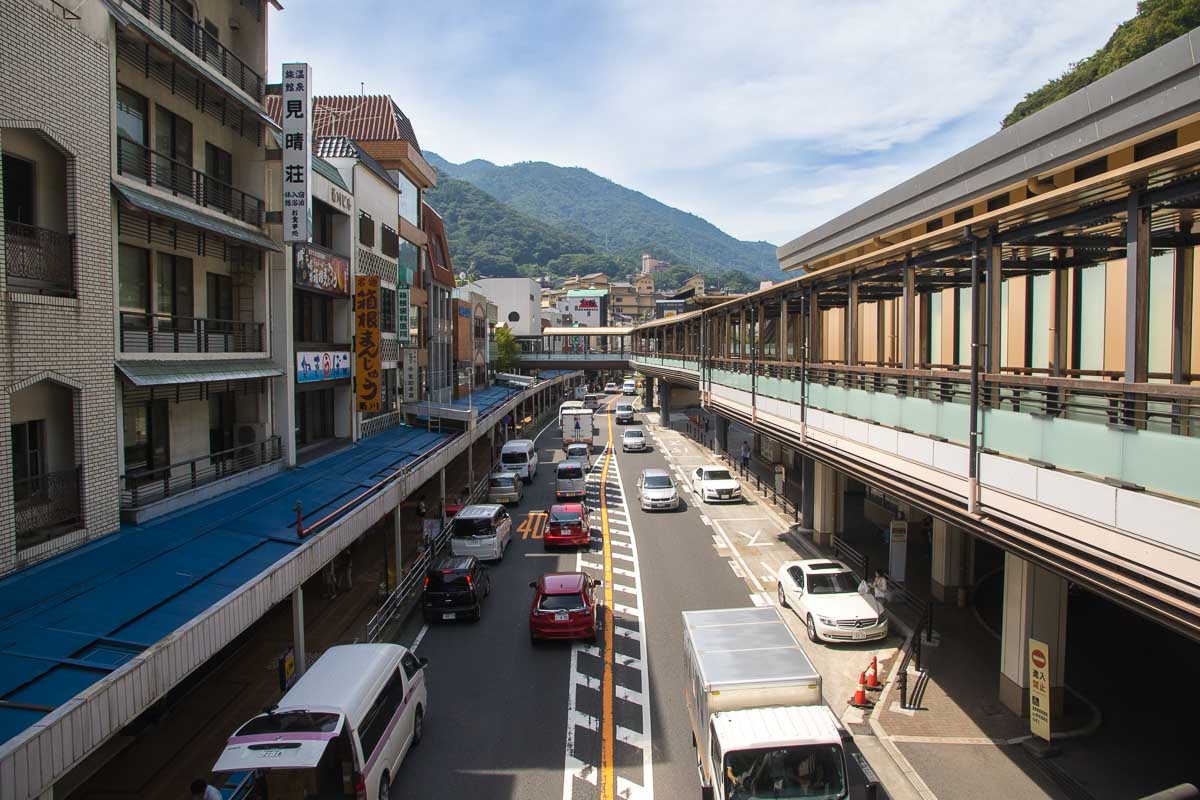
From Hakone-Yumoto station, all the main attractions can be covered in a circle around Hakone so there’s 2 ways around it. Most people take the anti-clockwise route starting from taking the Hakone Tozan train to Gora and ending at with a bus ride from Moto-Hakone. This route is ideal because the Hakone Ropeway that brings you to Owakudani closes at 4pm.
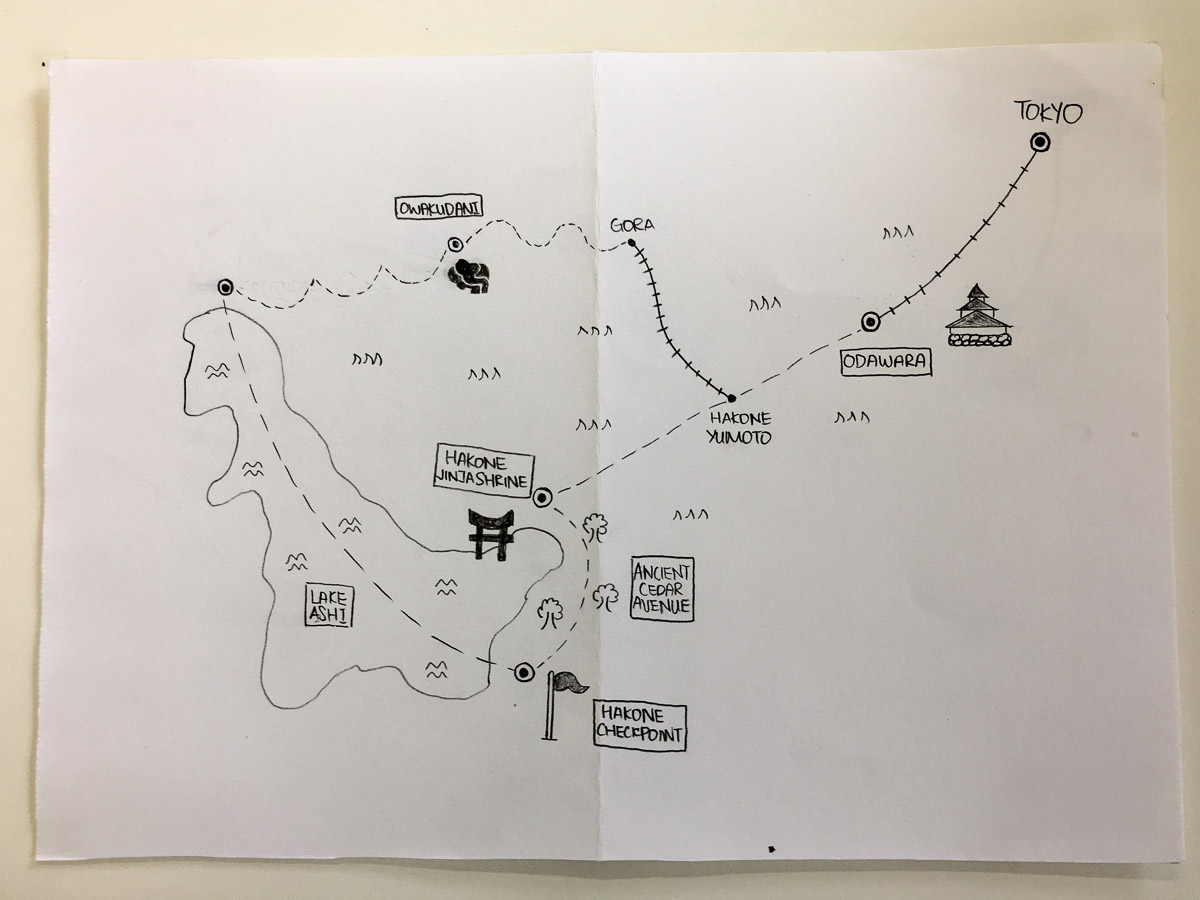
However if you’re looking to beat the crowds, you can try the clockwise route instead starting from the most iconic part of Hakone.
1) Hakone shrine & torii gate
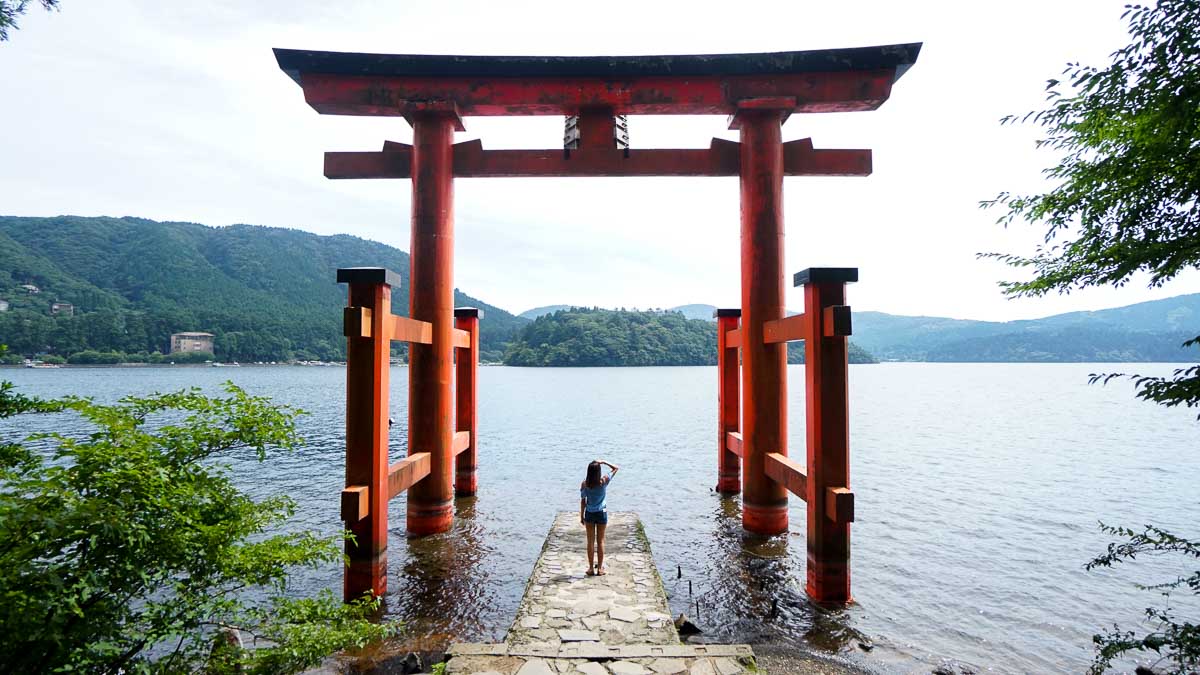
One of the most iconic symbols of Hakone is the grand Torii gate. In fact, it’s probably more famous than the shrine itself. Sitting on the edge of Lake Ashinoko, you’ll need to climb down a flight of stairs to get to this spot.
How to get there: From Hakone Yumoto, take the Hakone Tozan Bus to Moto-Hakone Boat Pier (35 minutes).
2) Ancient Cedar Avenue
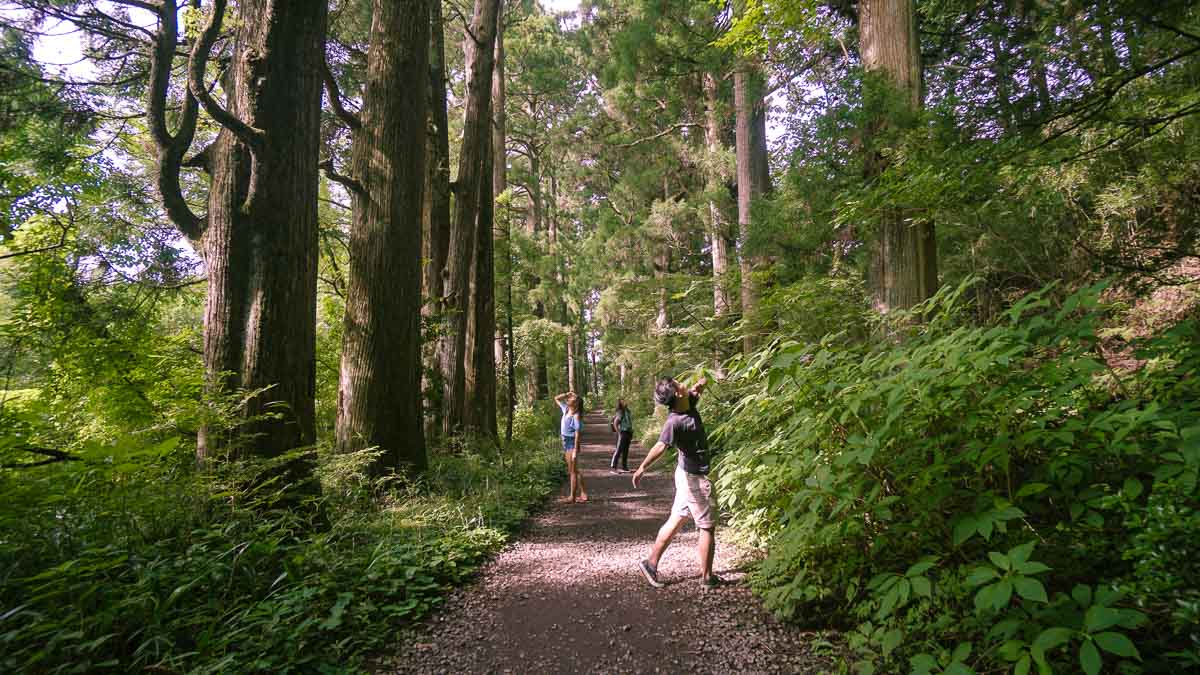
One of the best preserved parts of old Hakone is this 500m path lined with tall cedar trees. It was the original path used during the Edo period where travellers mainly walked on foot between Tokyo and Kyoto.
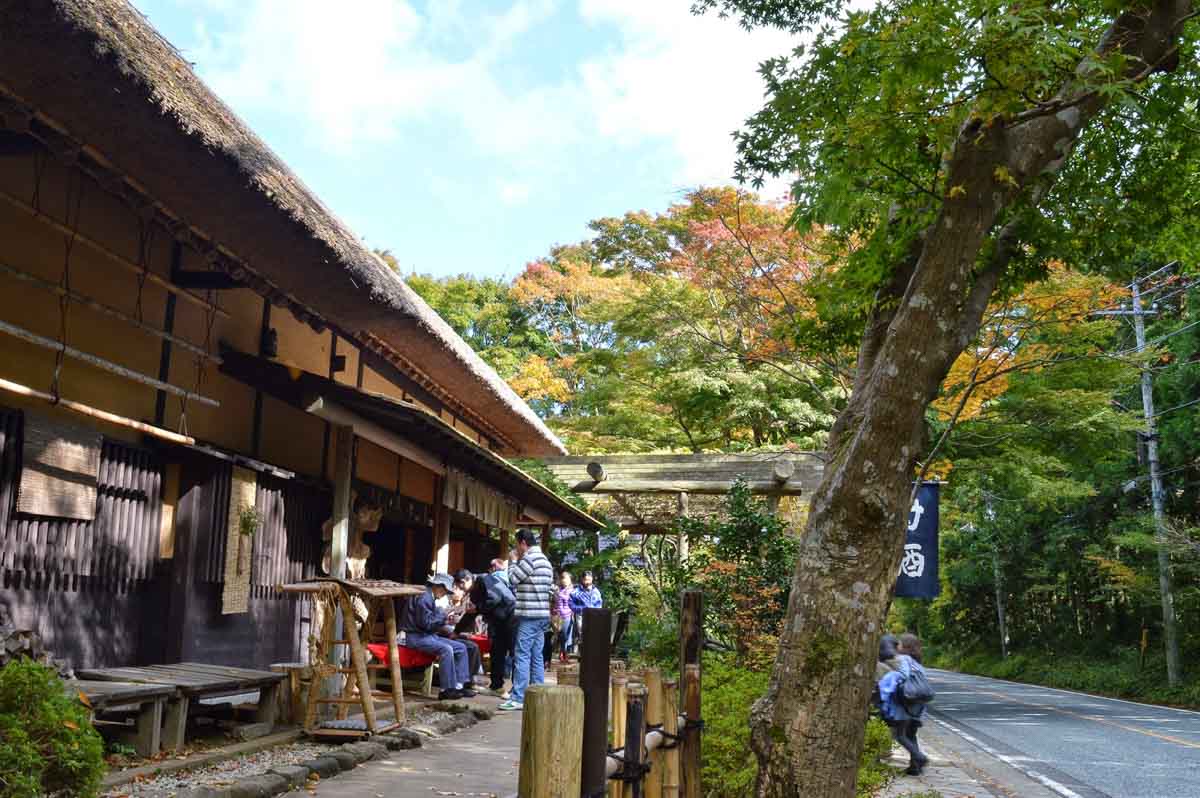
Photo credit: Cubie
If you love hiking, there’s a longer route (~1.5 hours) between Moto-Hakone and Hakone-Yumoto that passes by a 350 year old teahouse, Amazake-chaya whose family have been serving travellers since the Edo period.
How to get there: From Moto-Hakone Boat Pier, it’s a 3-minute walk. At the other end of the Cedar Avenue is the Old Tokaido Checkpoint.
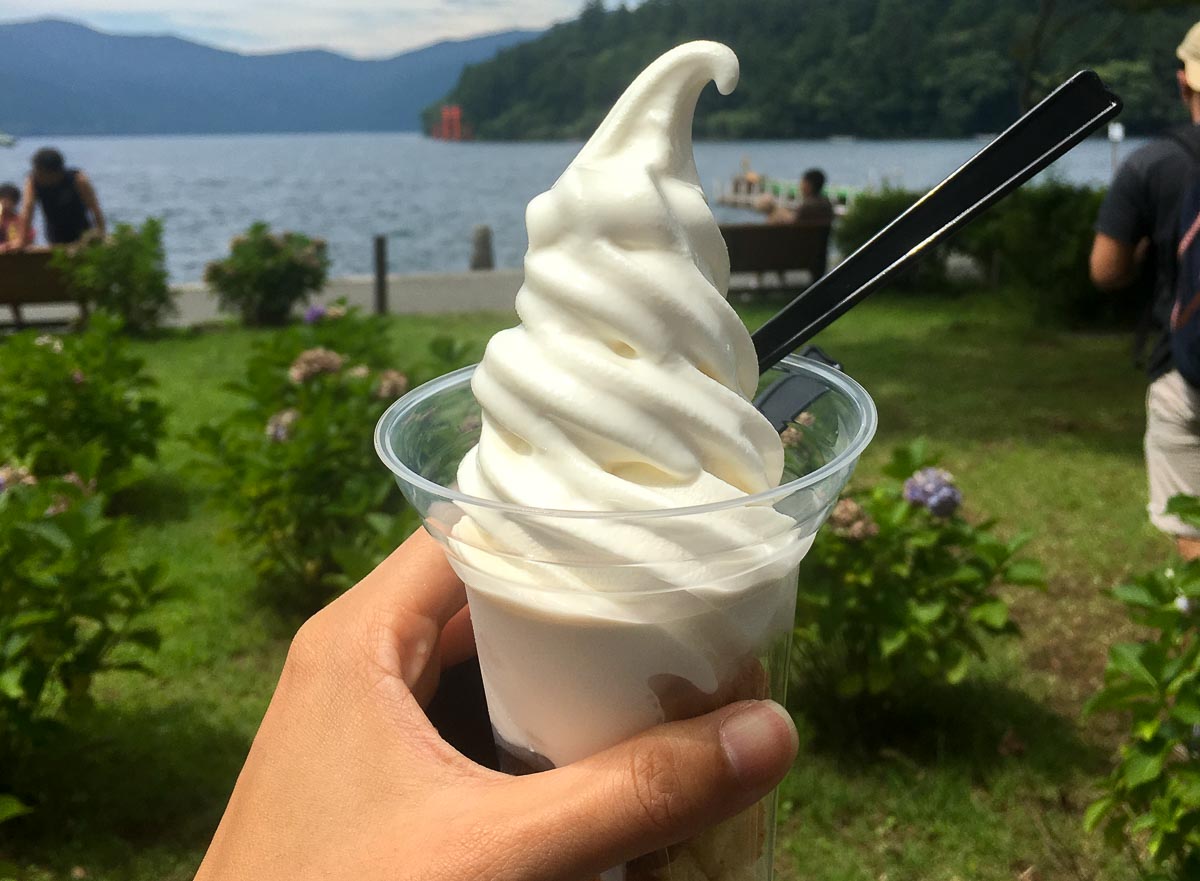
¥350 for Vanilla soft serve on rusk (toasted honey bread) from Bakery & Table cafe
3) Hakone Old Checkpoint Museum
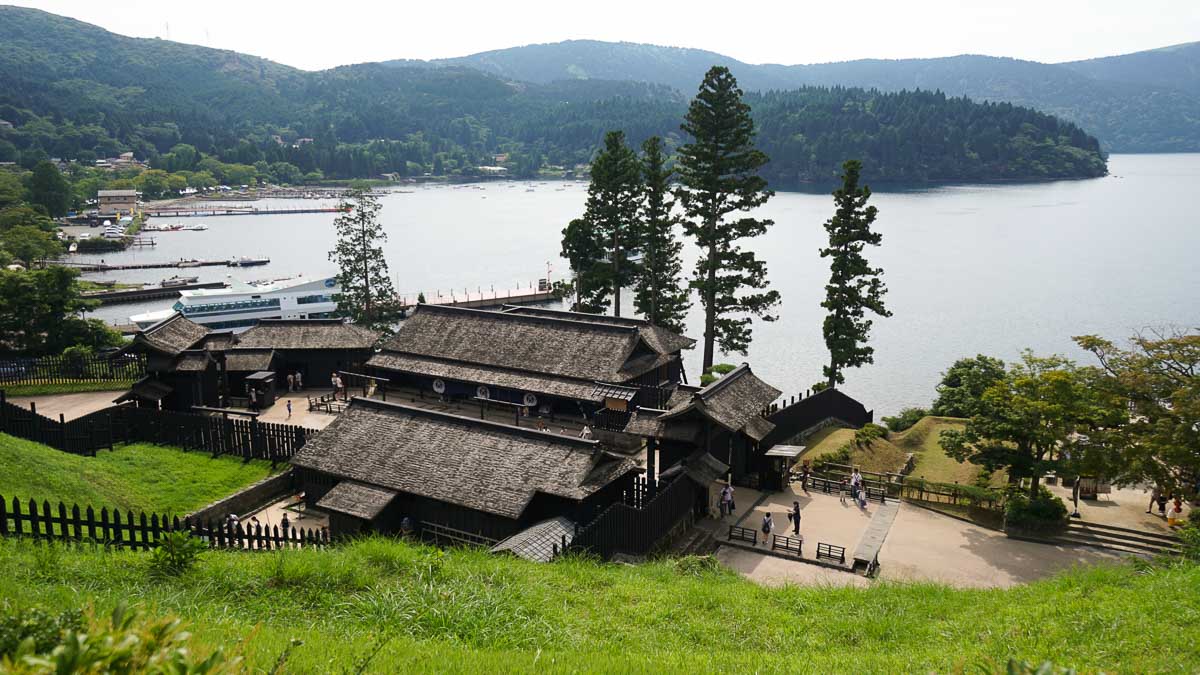
View from the Lookout Tower
Hakone used to be an important checkpoint along the Tokaido highway (connecting Kyoto and Tokyo). Although the structure is a reconstruction of the former Hakone Checkpoint, its location and style is a pretty accurate replica of the Edo period.
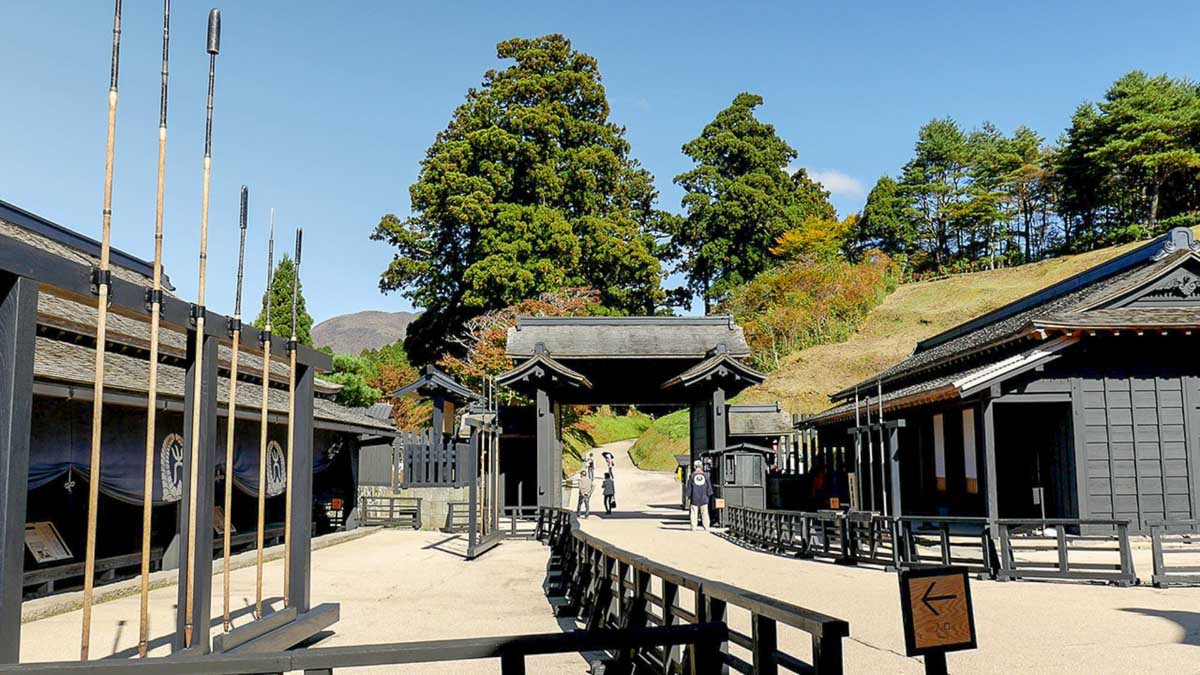
Photo credit: Gonzague Gay Bouchery
The checkpoint functions like an immigration point to control the access of 1) the wives of the lords from escaping Tokyo and 2) that weapons aren’t brought in from Kyoto.
Entrance Fees: ¥500 (¥400 for Hakone Free Pass Holders) Opening Hours: 9am – 5pm (Closes at 4:30pm from Dec – Feb)
4) Lake Ashinoko
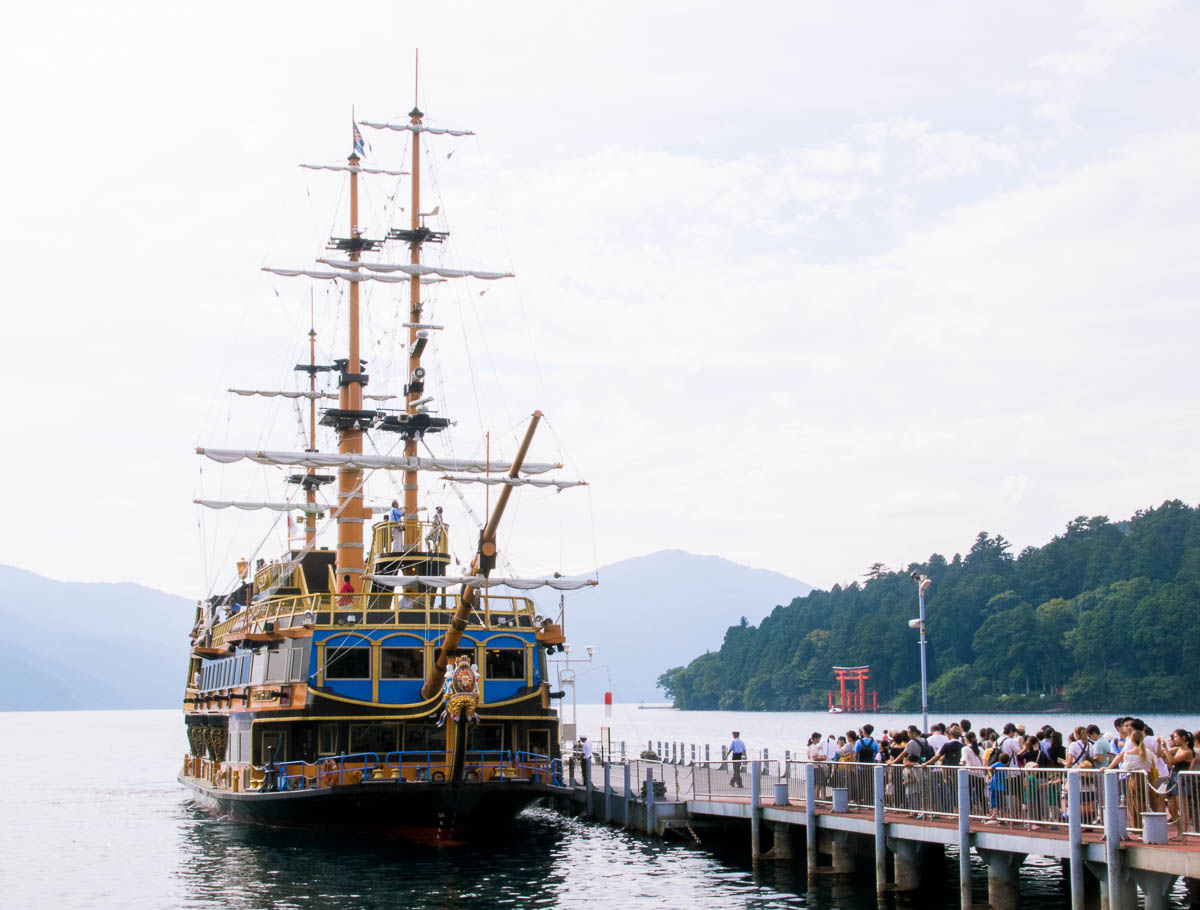
Lake Ashinoko is the heart of Hakone and one of the 5 famous lakes in the Fuji-izu region. The best way to cross this is via a sightseeing cruise that leaves Moto-Hakone Boat Pier and arrives at the Togendai-ko station. The boat leaves about 1–2 times an hour so check the boat schedule to plan your trip.
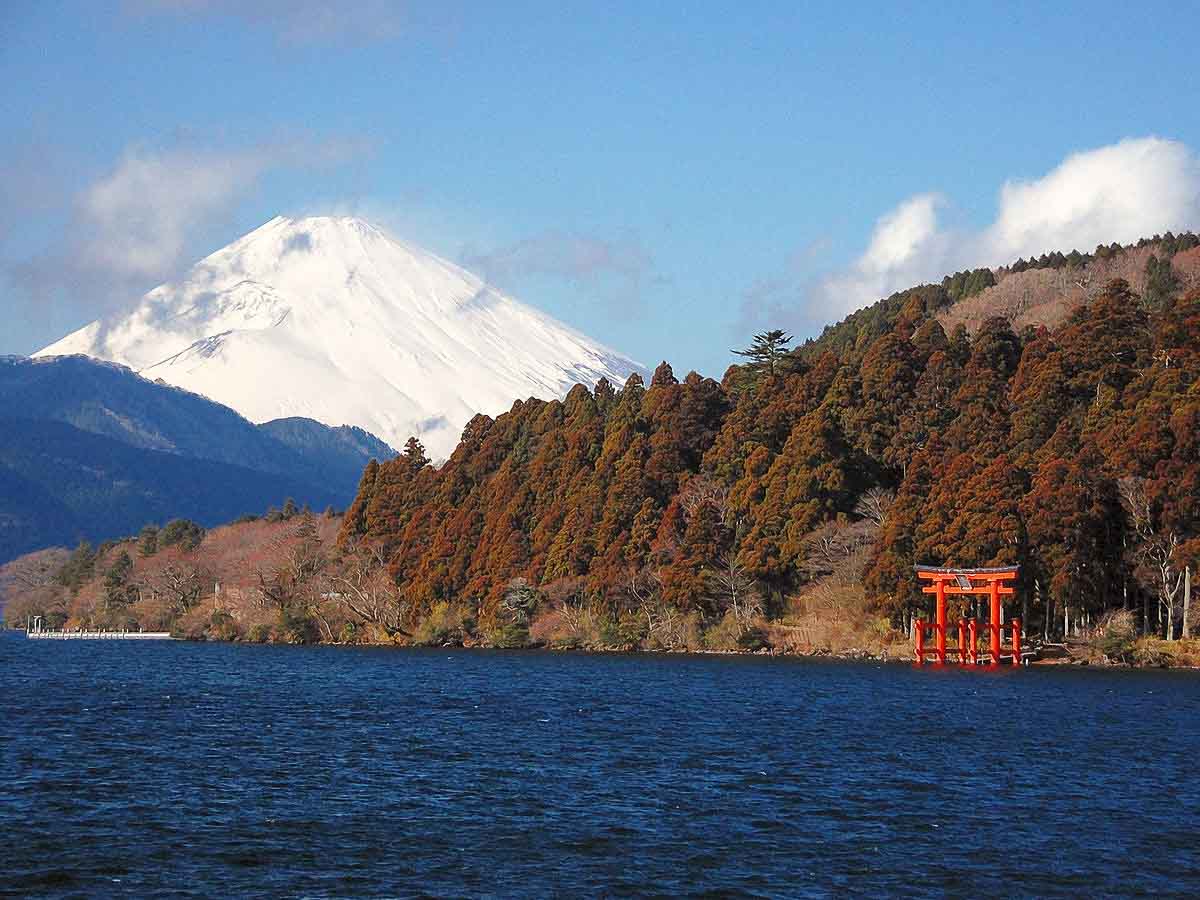
Photo credit: Kentagon
A famous sight on the cruise is the floating Tori gate of the Hakone shrine as well as Mount Fuji on days when the skies are clear.
Cost: ¥1000 (Free for Hakone Free Pass Holders)
5) Owakudani — Valley of Hell
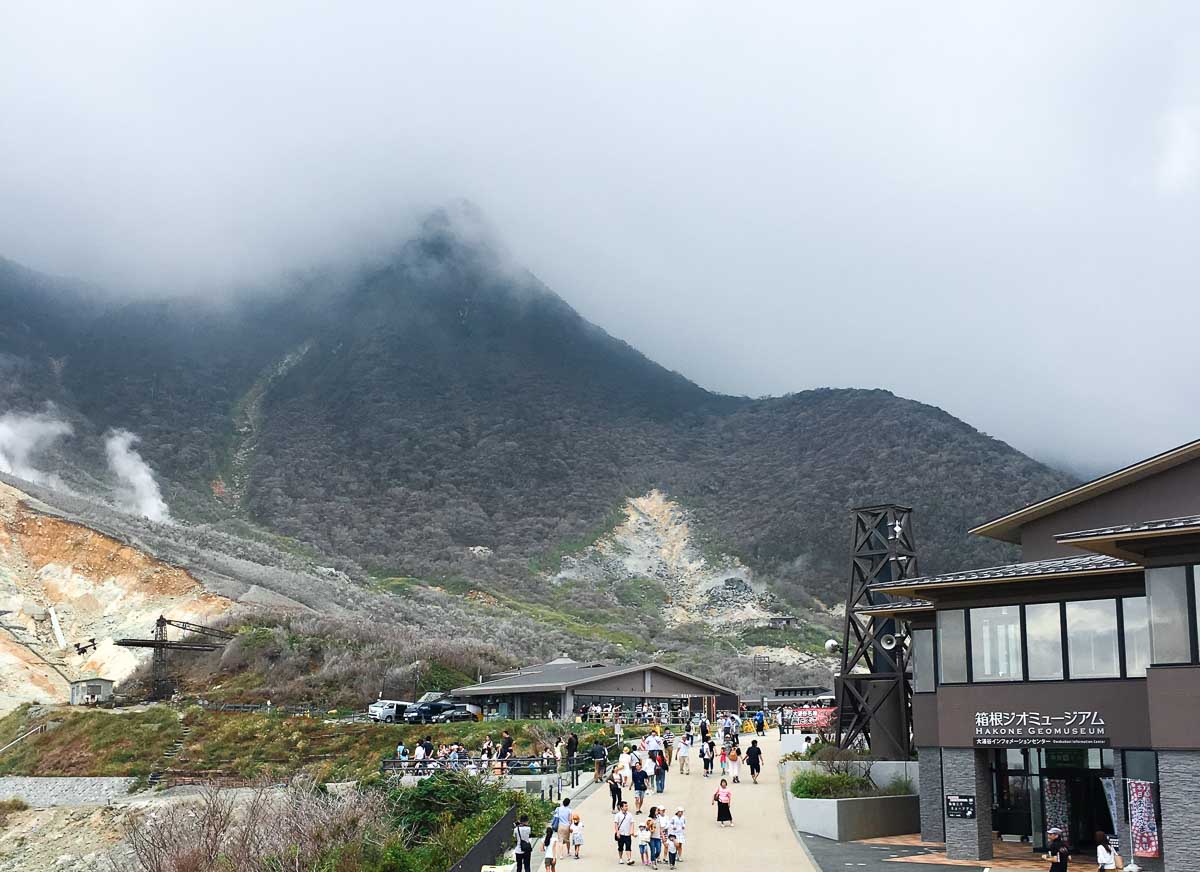
This was one of our favourite parts of Hakone. Although the weather was apparently at its worst while we were there, the thick mist and cool air here — despite being 34° in Tokyo —gave the place a serene and dreamy atmosphere.
On a clear day, you’ll be able to spot a scenic view of Mount Fuji.
There is a hiking path that leads to the peak of Mount Kamiyama but tends to close when there’s increased activity of volcanic gases.
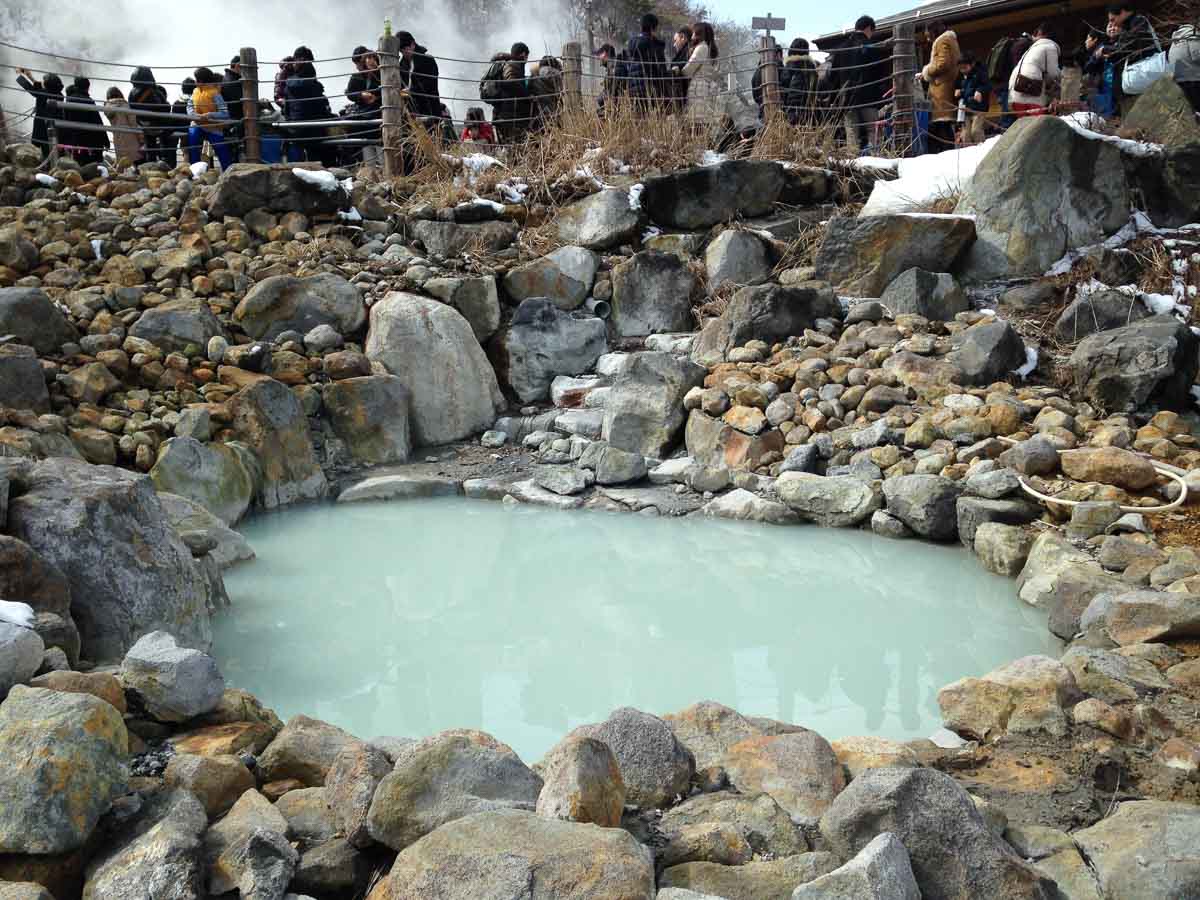
On that same path is also where you’ll spot hot spring pools where eggs are dipped in batches to cook. The shells turns black because of the reaction with sulphur in the water but rest assured they’re still safe to consume — in fact, eating the egg is believed to add 7 years to your life!
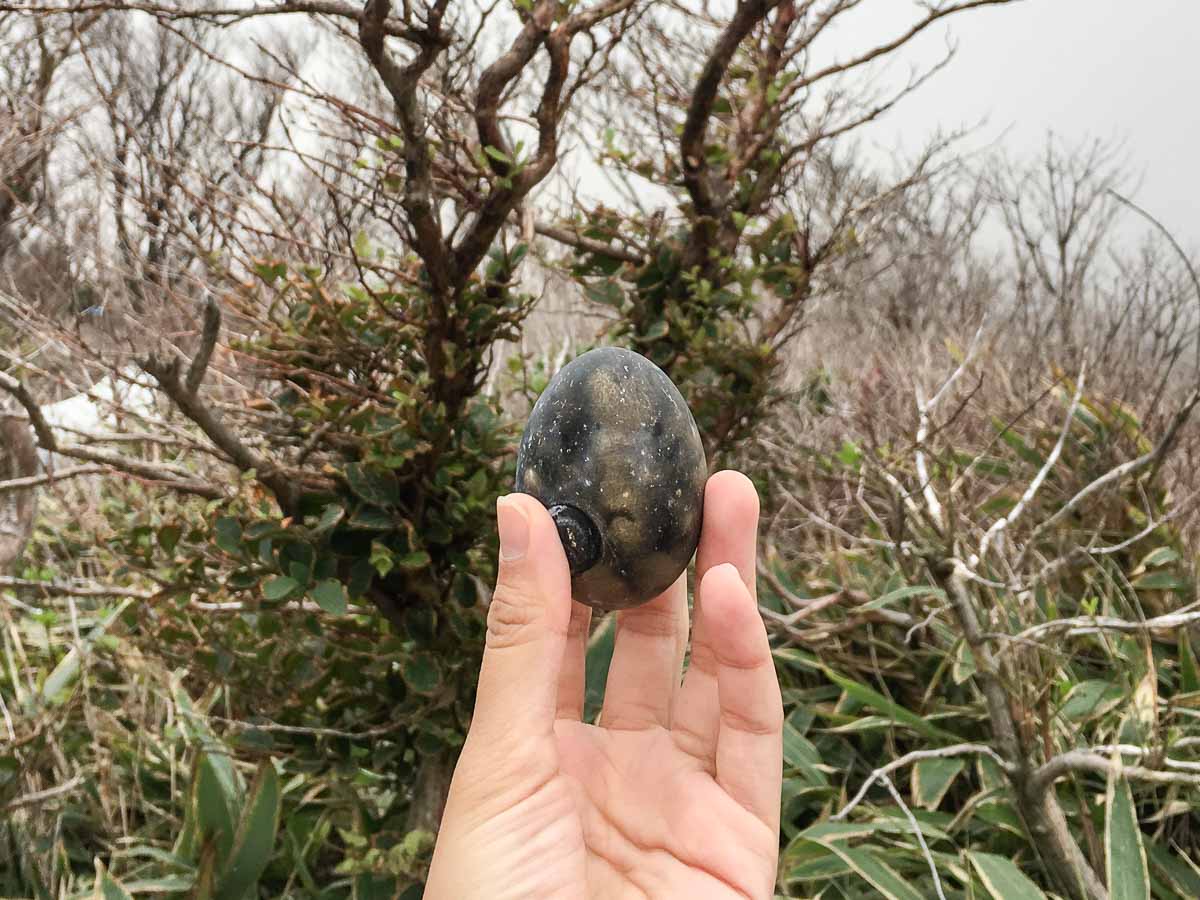
Honestly they don’t taste very different from regular eggs. A set of 5 kuro-tamago (black hard boiled eggs) cost ¥500.
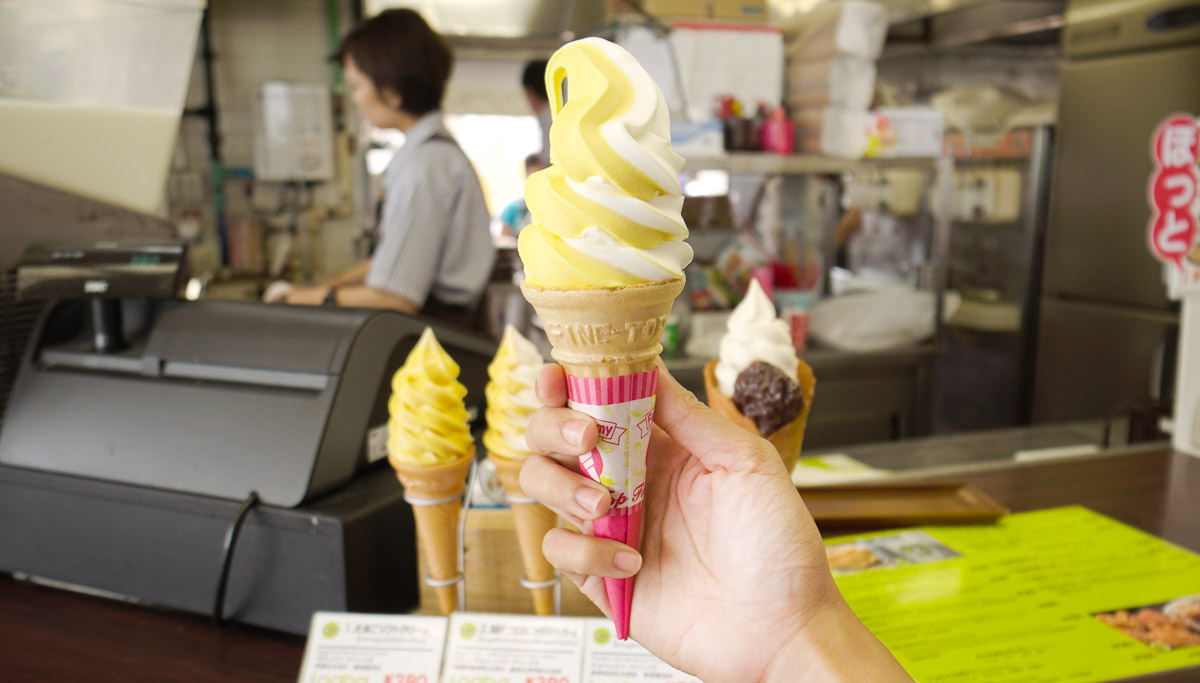
Tamago flavoured ice cream (¥350)
Opening hours: ~9am – 4pm (determined by the operation hours of the Hakone Ropeway) How to get there: From Togendai-ko, take the Hakone ropeway up to Owakudani station (16 minutes). If you’re coming the other way around it’d be from Sounzan station (8 minutes).
6) Odawara Castle
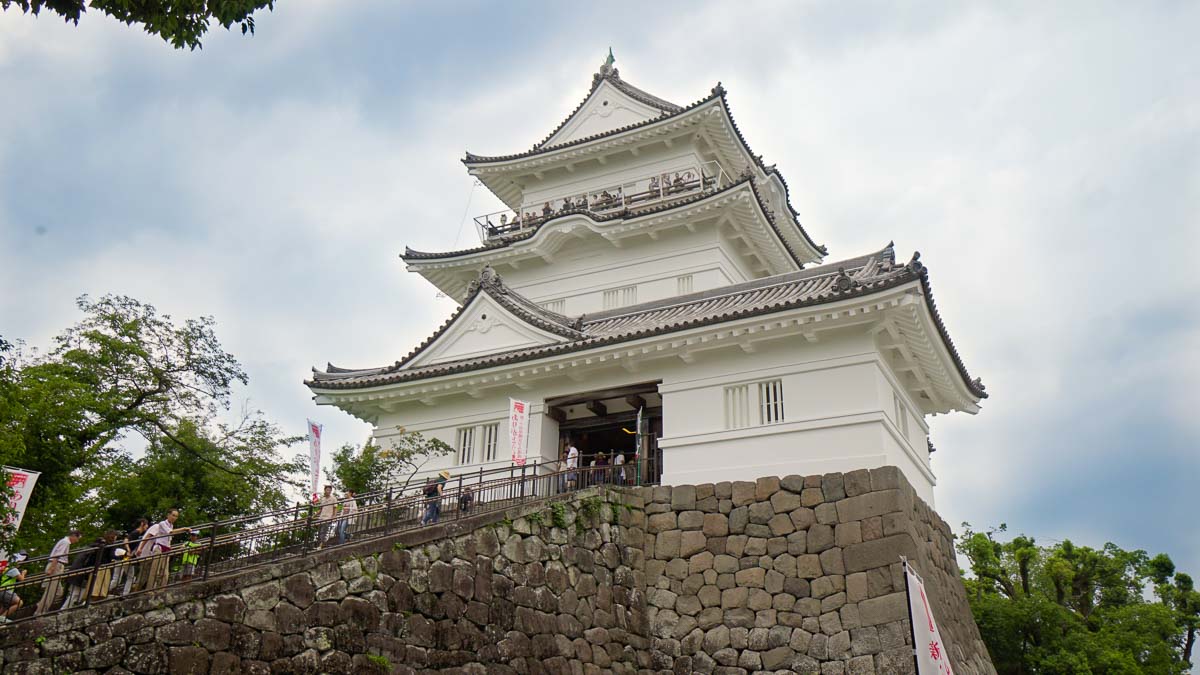
Before returning to Tokyo, make a quick stop at Odawara to check out the 15th century castle — a famous spot for its cherry blossoms in late March to April.
Odawara Chirashi (小田原鱼河岸でん)
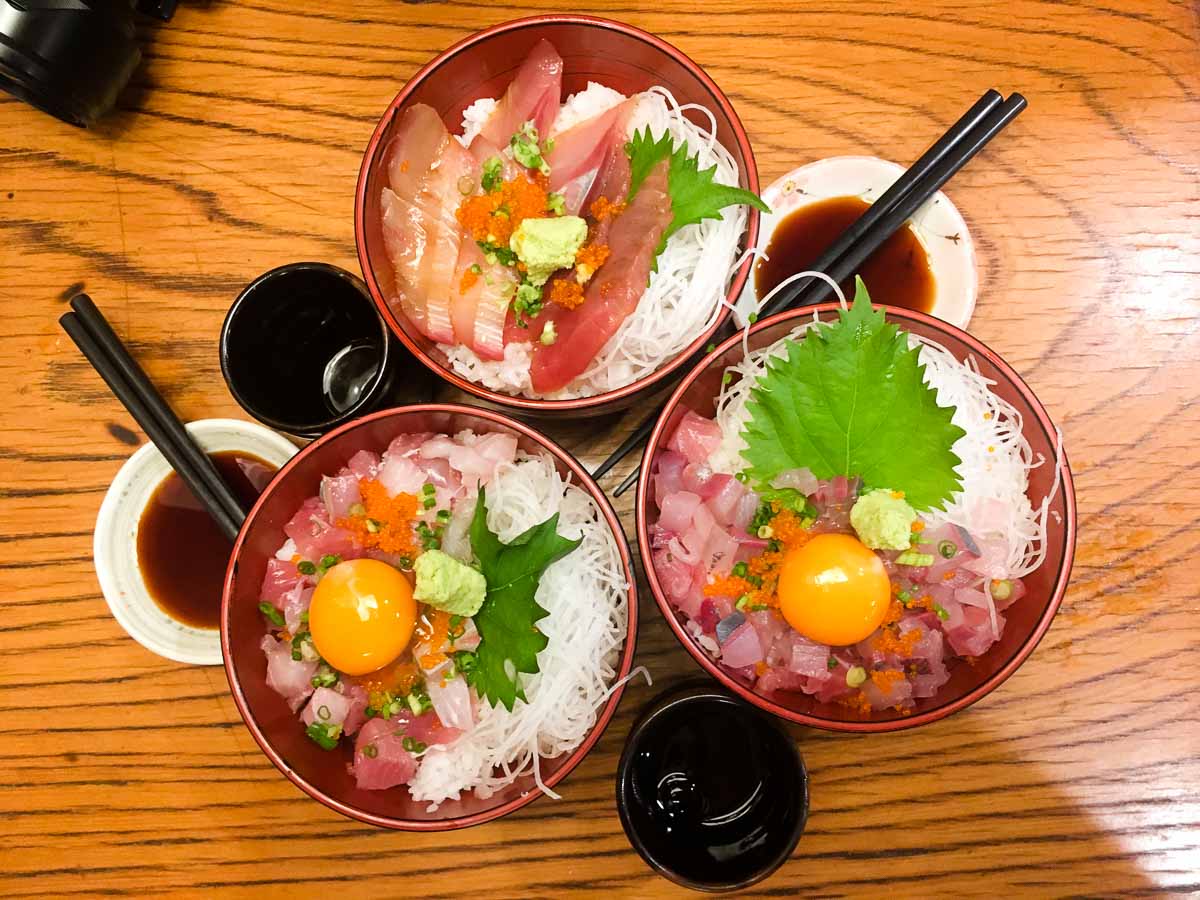
While you’re in Odawara, stop for dinner dinner at this Michelin Guide Chirashi place which serves fresh chirashi don bowls at reasonable prices.
*Pro-tip: Add a bowl of Miso soup for ¥100 — comes in a medium sized bowl with a piece of fish in each and a good dose of dashi.
Cost: ¥880 – ¥24800 (Our bowl of “local fish” cost ¥1280) Opening Hours: 11am – 10pm Address: Japan, 〒 250 – 0011 Kanagawa Prefecture, Odawara, Sakaecho, 2 Chome – 3 – 4, Miyuki Building
Is the Hakone Free Pass worth a day trip from Tokyo?
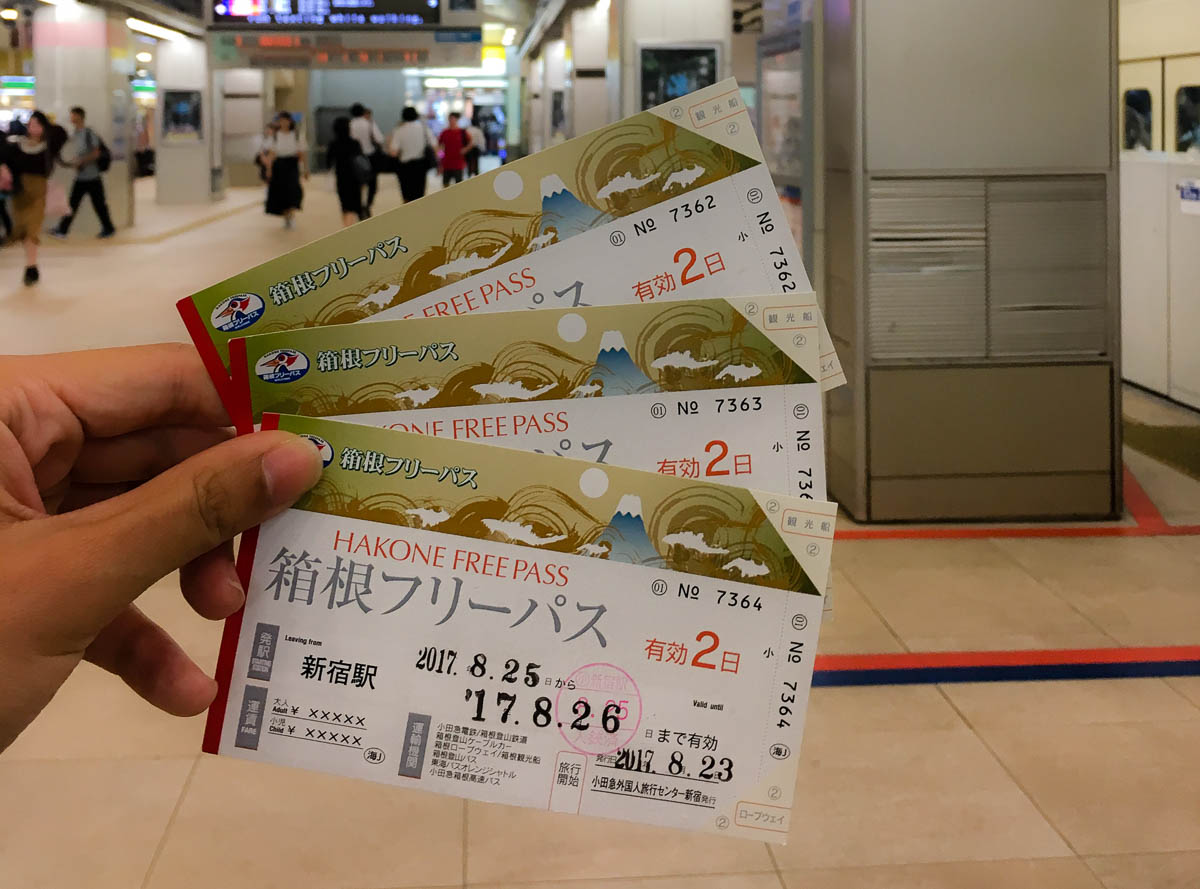
The short answer is yes.
The longer answer? Here’s the homework done for you 🙂
Getting around Japan via single tickets is generally a lot more expensive. Despite only using the 2-day Hakone Free Pass for a day trip, we saved a total of ¥2130 (~S$26.50) on top of saving the hassle of purchasing individual tickets. But if you have more time to spare, give yourself 2–3 days to soak up all the serenity of Hakone before picking up the pace again in Tokyo.
*The prices below have been updated as of Jan 2020
Hope you found this Hakone Travel Guide useful. Let us know if we missed anything out in the comments!
This post was brought to you by Klook .
RELATED ARTICLES MORE FROM AUTHOR
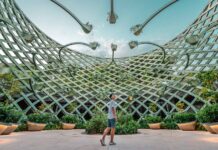
29 New Deals and Attractions in Singapore this April 2024
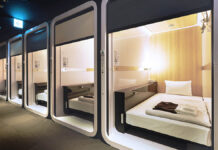
Top 11 Stunning Yet Budget-Friendly Tokyo Capsule Hotels (from ~S$40/night)
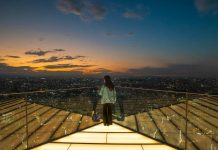
Tokyo Vs Osaka: Why Are These Two Popular Japanese Cities so Different — Cultures Explained
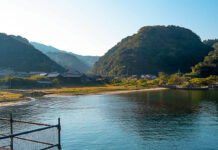
Hiroshima and San’in Guide — Going Beyond Tokyo/Osaka to Find Japan’s Best Hidden Gems
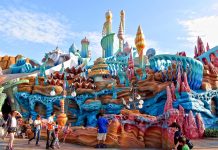
Tokyo Disneyland and DisneySea Guide (2024) — Maximise your Tokyo Disney Day with these 12 Tips and Tricks
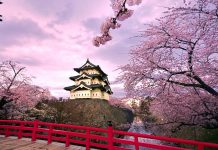
Ultimate 2024 Cherry Blossom Japan Guide — Everything You Need to Know
95 comments.
Thanks for the awesome guide! Can’t wait to go to Hakone soon.
Hello! I find your guide really useful! Thank you 🙂 Can I check if I purchase the free pass from Klook, how do I upgrade it to Romancecar?
Thanks for the kind words!
You can top-up for the romance car option at the Odakyu Sightseeing centre when you collect your pass 🙂
More info: http://www.odakyu.jp/english/romancecar/
hi, if i purchase whole JR pass, do i still need to buy the hakone pass? thanks
Yup you have to! JR Pass does not cover the internal transport within Hakone as there are a few areas.
How many hours did you take in all from item 1 to the end?
About 6-7 hours? But we took our time to take pictures and videos so I guess you can finish the route around 4-5 hours
Hello, I have a question. Does the Hakone Pass include roundtrip from Tokyo to Hakone and Hakone back to Tokyo or will I need to purchase separate fare?
Yup! It covers the trip from Shinjuku and back to Shinjuku station.
We have a 14 day JR pass. We will be starting from Tokyo for 5 nights. We have a place to stay in Hakone for 1 night before we start to go Kanazawa for 2 nights then to Kyoto/Osaka for 5 nights. So we are flying in from Los Angeles to Haneda and then flying out from Osaka back to Los Angeles. Do we still need to buy a pass for Hakone even if we are only there 1 day/night? How do we get from Hakone to Kanazawa?
Hi Vicky! The JR Pass doesn’t cover internal transport within Hakone. If you are only visiting 1 or 2 places within Hakone you probably don’t need the pass. But if you are travelling from Tokyo to Hakone and want to see many things within Hakone, getting the pass makes sense. It’ll also help when you are leaving Hakone on Day 2.
Hi, how do you get to Hakone-Yumoto from Sounzan? Can you go straight without passing Gora?
Hi Cara, yes there’s a bus from Hakone-Yumoto that goes to Sounzan in 20-30minutes but I’m not sure if the Hakone Free Pass covers that bus. Perhaps you could inquire again at the station.
Hi Cherie, thank you for your useful guide! We have a 7-day JR Pass. We’ll be in Tokyo first for 5-days and then we’ll make our way south, first stop being Hakone. We’re thinking of purchasing the Hakone Free Pass to travel from Shinjuku to Hakone and use the Hakone Free Pass during our time in Hakone. Then the following day, we’ll start using our JR Pass for the rest of our trip south. Do you know if it is possible for us to start using the JR Pass from Hakone? Thanks!
Yup! You can take the JR train from Odawara station onwards but remember to collect your pass before leaving Tokyo! You can ask for the pass to be activated on a later date when you collect it from the JR office
Great blog! I hope you don’t mind me asking. So I’ve managed to book my family, tickets to Hakone Yumoto. We’ll be arriving at 12:24. Now I have two sets of returning tickets. And this is where my dilemma is! Tickets A: leaves at 16:28 but they are front observation deck seats! Ticket B: leaves at 17:28 but they are rear observation decks. Can I do Hakone ( both trains in the mountains, ropeway, pirate ship and then the bus back( or taxi if it helps) all in 4 hours time? Or will we be scrambling? Of course, the usual me would say, take the safe route and go for the 17:28 return so we’re not stressed. But we managed to book front observation deck seats, which I’m hesitant to let go! My kids both love trains and this would be a once in a life time trip! What do you think?
Your post save me a hassle from planning from scratch! However i’m confused a little. With the Hakone Free Pass, does it include 2 ways transports back to Shinjuku via Romance car (top up of 890 per way)?
Hi Wendy, the Hakone Pass doesn’t include the Romance Car, but you can still top up to get it like you mentioned.
Hi, we just spent our weekend in Hakone and this entry served as our guide. Thank you so much!
PS. now we add ¥1090/one way if we want to ride the romance car. 🙂
Yay! Always happy to know the guides have served someone well 🙂
Oh man, that’s price jump.. but thanks for the update!
Hi Odi… Would you be able to share where you stayed in Hakone?
Does the Hokane pass covers departure from Tokyo Station to Hakone Yumoto Station (via Odawara station) or must be from Shinjuku Station? Can I collect Pass in Singapore instead of Odakyu Sightseeing centre ?
Yes, you will need to validate your Hakone pass at Shinjuku station.
Unfortunately, Odakyu is the only place you can collect the pass at the moment (even if you’re buying it direct).
Did you see many people use the clockwise route instead? Having read on tripadvisor, people seem to get caught up with all the queues for the ropeway. I take it if you end up circling the other way though, would you avoid a lot of the queues?
Thanks! Kevin
Do you mean they get caught up if they visited the ropeway early in the morning or towards the end of the day? We did the clockwise route and didn’t face a lot of crowds most of the way but felt it was a bit of a rush trying to reach Owakudani before it closes at 4PM. I guess there’s equal pros and cons to each. Perhaps the best way to avoid this would be aiming to visit Hakone during off peak seasons? 😛
Thanks Cherie. Understandable. We are thinking of getting into Hakone early in the morning. What time did you leave Tokyo/Shinjuku?
We are spending the night in Gora and have hotsprings to enjoy there. We will leave Hakone for Kyoto on the second morning.
How would you recommend how we best spend our time? Because of the “loop” we’re not sure how we should spend our time! We were thinking of doing the anti-clockwise loop to get access to the ropeway etc. and owakudani (most likely with everyone else!). If the ropeway or owakudani is closed though, we’ll go clockwise. We were thinking of using the second morning to quickly explore the Hakone-Yumoto STN and Odawara before leaving.
Cool! Really wished we stayed overnight for the onsens too.
Perhaps you could cover the sights clockwise until the end of the Lake Ashinoko cruise then take a bus from Togendai-ko station towards Gora to relax at your Ryokan. The next morning from Gora, take the anti-clockwise route towards Owakudani (try to arrive right when it first opens at 9AM). If you take it slow, you can probably spend around 2-3 hours here before returning to Tokyo in the afternoon.
Hi—Are there specific times to get all transportation with the pass or is it an open pass to get rides to Hakone and on the lake cruise and then back to Shinjuku? And even though it’s a 2-day pass, I can do this all in one day?? Thanks!
Not too sure if I understand your question but most of the transport in Hakone are quite regular, except for the cruise (every 30mins if I remember right!). And yes! It’s definitely possible to finish them in 1-day if you start early. But definitely more enjoyable if you spend a night to enjoy the onsens! 🙂
hi i can’t seem to find the hakone free pass on look anymore ..
Hey Asyaraf! Looks like they were out of stock a few days back due to increase interest but Klook has restocked it and the link works fine now 🙂
Hi what time did you guys arrive at hakone station to start the adventure? I plan on taking the route to the shrine first, then to checkpoint. how do I get from the check point to take the cruise near the shrine boat harbor?
We arrived around 9AM cus that’s when stuff generally opens although I think it wouldn’t hurt to have arrived a little earlier and have the famous torii gate all to ourselves for pictures 😛 There was already a queue when we got there around 9:30AM.
From the checkpoint, I think there’s a bus you can take for 1-2 stops but we decided to walk instead. It’s only slightly more than 1km to get to the MotoHakone pier and quite refreshing to walk through a portion of the Cedar forest 🙂
Hi Cherie, since the Odakyu Center opens at 8am, did you purchase your free pass in advance?
Yup! We collected the passes the day before since we were in the Shinjuku area
Hello! Thank you for this; I’m researching for my trip to Japan in June and found this helpful. May I know if Klook still sells the Hakone pass though? I clicked the link above but it did not direct me to the relevant website.
Also, we will be travelling to Hakone when we land at Narita airport in the morning, then staying at Hakone for 2 nights, before travelling to Shinjuku on our third day in Japan. Could you kindly advise if we should get the Hakone free pass from Shinjuku or Odawara? Which is more cost-efficient? Thank you (:
Sorry, not too sure about this. We travelled to and from Tokyo to Hakone so it definitely made sense for us to get the pass from Shinjuku. Perhaps you could compare the prices on Hyperdia.com?
If you’re getting the pass from Odawara, you could activate your JR Pass (if you have it) after Hakone since that will cover your ride from Odawara to Shinjuku.
Yes they do! The tickets were sold out when you checked but the link works fine now 🙂
Hi Cherie, i’ve read in the internet that the Odakyu Office in Shinjuku opens at 8 am only. Does this mean that we cannot leave early to Hakone? We plan of purchasing the Hakone free pass. Thank you
If you plan to leave early, it’d be better to collect the pass the day before!
Hi Cherie, We plan to go to Osaka and stay for 6 days /5 nights, then travel to Tokyo (on the 6th day )for 4 days/3 nights and return to Osaka (on the 9the day )for another 4 days /3 nights (and leave on the 12th day). During the first part of Osaka trip, we plan to travel to Kyoto for 4 days (taking day trips), and during the Tokyo trip, we plan to go on day trips to Hakone, etc. Upon returning to Osaka on the last leg of our trip, we plan to visit Nara and Kobe. I am planning to activate the JR pass from the day we travel from Osaka to Tokyo, use it in Tokyo, and back to Osaka and eventually using it for the airport ride to Osaka KIX. Do you think it’s a good idea? We can use the ICOCA during our first few days in Osaka (to Kyoto), correct? Thanks .
Hi Winnie, Wow! There’s a lot you can do in Japan for 12 days. Are you getting the 7 day or 14 day pass ? If it’s 7, just make sure you have enough time to take the long trip back from Tokyo to Osaka before it expires!
While Kyoto is only 30 minutes from Osaka, I think it’s worth staying a night or 2 in Kyoto instead of making 4 day trips. Have you read our Tokyo to Osaka Itinerary: https://thetravelintern.com/japan-budget-guide-jr-pass-tokyo-to-osaka/
With 12 days, you might even be able to fit in more stuff like the Rabbit Island or Art Island (Naoshima) in this itinerary: https://thetravelintern.com/jr-pass-japan-budget-itinerary-osaka-hiroshima-kyoto/
In Osaka, the ICOCA card works as a rechargeable card but if you’re looking for unlimited travel, the Osaka Amazing Pass is quite worth it. Hope this helps!
Will Hakone be luggage friendly? Not planning to go back to Tokyo but will proceed west wards after that. I suppose if I choose a hotel near the lake, I should go straight to the hotel first, then start the “loop” from there.
Hi Speck, it’s pretty luggage friendly. But if you do not want to carry your bags around, you can consider leaving them at the station lockers?
So you mean put main luggage in locker and check into my hotel with just a travel bag containing just essentials?
Hi! How did you get from Owakudani to Odawara castle?
Hi Anon, You can take the Hakone Ropeway from Owakudani to Souzan Station, and take a bus from there. It’s easier to ask them about the bus on the spot!
Hi, Where did you eat your lunch in Hakone? Any other restaurant recommendation near Odawara aside from Odawara Chirashi?
HI, any recommendations for a budget friendly ryokan with private onsen?
Unfortunately we didn’t get to experience one in Hakone 🙁
Anyone else with recommendations? Would love to hear of them!
I am travelling in end Nov to Japan for 10days. My itinerary is as follows: Day 1: Osaka Day 2: Osaka Day 3: USS Day 4: Nara day trip Day 5: kyoto day trip, then take night bus to lake Kawaguchi Day 6: Lake Kawaguchi Day 7: Hakone Day 8: Tokyo Day 9: Tokyo Day 10: Disneysea
How do you think of this? Should I get a JR pass?
You must really love theme parks! 😉 Are you planning to catch your flight back in Osaka? If you are then definitely get a JR pass! If not, a single ticket will be much cheaper for this itinerary.
Hi! We are planning to have a day tour from Tokyo to Hakone. Is it advisable to get the 2-day Hakone Pass? or there is also 1 day Hakone Pass?
2 days would be less of a rush! That’s why the pass only comes in the 2 day pass.
Hi there, Very informative guide. I’ll be travelling with me family to Tokyo in March 2019 (Cherry Blossoms yay) and this was real helpful in my research and plannings. This might be many months late but I noticed you have a miscalculation (on how much the free pass saved you) while I was doing mine. The hypothetical total for individual tickets should’ve been JPY7270 instead of JPY6960. So you actually saved JPY2130 :).
You are right! Thanks for spotting 🙂 For cherry blossom hunting in other parts of Japan you might find this useful too: https://thetravelintern.com/2018-cherry-blossom-japan-guide/
How can I go to Hakone Open Air Museum? TIA
Unfortunately we didn’t go there!
Hi Cherie, we will be in Tokyo on the 3rd week of March 2019. If we make a day trip to Hakone, will it be cloudy or is there a chance to see Mt. Fuji clearly?
Hi Jennifer. It really depends on the weather! There is a better chance in the colder months but it really depends on the weather on the day itself. Often it is clearest in the mornings so do wake up early!
Hi Cherie, I want to ask if you don’t mind. Can I buy the Hakone free pass in the vending ticket machine? And can I use it directly to go to Hakone and use all the covered transportation with that Free pass without changing it first? Thannk you.
hmm, not sure about buying through vending machines. It wasn’t available during my trip there in 2017. The e-ticket purchased from Klook is an exchange voucher so that alone will not give you access to the transport system. You’ll need to visit the Odakyu sightseeing centre at Shinjuku to collect the pass before leaving for Odawara.
Hi! Thank you for this lovely post! We are planning our trip to Japan at the moment at your post about the daytrip to Hakone inspires me!
Hello! Thank you for sharing! 🙂 You have inspired me to get this pass. But could you answer few questions for me? 🙂 How long does doing all of those things take? I was thinking of doing everything you posted about and also visiting an onsen for few hours. Do you think thats possible? You said the buses stop at 4pm? Does that mean you have to head home to Tokyo by 4 pm? I want to do a daytrip to Hakone and see everything PLUS go to an onsen. Is that possible you think? Does it all end by 4 pm? Or is it possible to take later trains to Tokyo? thank you!
you’re welcome 🙂 hmm, I’d high recommend staying a night to properly enjoy the onsen. If budget is important, you can stay in hostels around Odawara station and travel back to Hakone Yumoto the next day. The Hakone Pass is for 2 days anyway!
Hello, can i ask if i the hakone free pass bring us to the kawaguchi station straight from shinjuku station.
Hi Peter, nope it doesn’t. Kawaguchi Station is actually closer to Mount Fuji than Hakone.
Hello. Thanks for the suggested hakone itinerary. May I know after visiting the hakone shrine and torii gate, do we have to go back to Hakone Yumato to walk over to Ancient Cedar Avenue? From the map its seems walkable from one point to the other. And from the checkpoint museum, I understand from your earlier reply that its also walkable to the Moto Hakone Pier to catch the cruise to Togendai-ko station. Is my understanding correct? Appreciate your advice!
Hello Kaijun, you can definitely walk from the Hakone shrine to the Ancient Cedar Avenue and from the Checkpoint Museum to the Moto Hakone Pier but there’s no need to return to Hakone Yumoto as that’s in the opposite direction
Thanks for the suggestion. On point and with useful tips! May i know how long is the total itinerary? I want to leave Tokyo at 8.30-9.00 (not an early bird), but i don’t want to miss the 4pm ropeway.
Thank you! 🙂 We took the first train out but if you’re starting slightly later, you can cover the route anti-clockwise and start with the ropeway.
Is it possible to buy the Hakone Freepass anywhere else in Tokyo besides the Odakyu Sightseeing Service Center? I’m arriving in Tokyo around 4PM on a Thursday and I don’t think I’ll have enough time to go to the Odakyu Sightseeing Service Center before they close. I am planning on going to Hakone early Saturday morning but the Odakyu Sightseeing Service Center is kind of out of the way for my plans on Friday.
If it’s not sold anywhere else, I’ll have no choice but to purchase on Klook and pick it up sometime on Friday.
Thanks in advance!
We’re not too sure but this site says you can get it at the major railway stations like Shinjuku, Odawara and Central Tokyo Station. However, I’m not sure if they sell the actual pass or an exchange voucher. The latter will still require an exchange at the Okakyu Sightseeing Service centre. We got ours from Klook anyway because it’s cheaper than the ones from the stations!
Hi Cherie, thank you for sharing your itinerary with us!
I am planning to visit the Hakone shrine and Torii gate. Is the cost of the bus trip from Hakone-Yumoto to Moto-Hakone also included in the Hakone Free Pass?
Yep! You can take the Hakone Tozan Bus (Line H) for free with the Pass
Hi Cherie, We are group of 9 (6 adults & 3 teenage) plant to travel to Lake Kawaguchiko (stay for 4 days 3 night) next year 2nd week Apr ,as we are so many of us think of self drive to Lake Kawaguchiko & Hakone can save time in public bus in Lake Kawaguchiko. Beside that we would like to drive to Hakone for one day trip and buy the Hakone 2 days freepass (4600Yen this pass only travel inside Hakone).Reasons of buying the pass because we would like to try all the transport (in Hakone freepass).Is this looks ok ? By using individual tickets will be cost more. Due to stay in Hakone is very expensive we plan to travel round trip Lake Kawaguchiko. Knowing all the pass in Lake Kawaguchiko & Hakone is either 2 days or 3 days.Therefore if we buy the pass still have one day transport need to think of a way back to Shinjuku.
Hi SF, looks like you have thought this through pretty well! The plan sounds good. Now we need to hope for the weather to be good too!
Hi Cherie, this guide is really in time as I’m planning for my trip in Oct!
I just have a few question about the pass that I hope you can help. I am travelling from Tokyo to Kyoto then to Hakone.
Is there only 1 collection point? Is it possible to collect the pass on 25-Oct and start using it on 28-oct when I’m in Hakone?
Thanks so much for any information you can share 🙂
Hi Li, unfortunately not. If you click on the Klook link, they currently only distribute it from that point.
You can however collect it earlier before using it though! “Pick-up service is available from 7 days before the date you selected. The day pass is valid for 2 or 3 consecutive days from the date you selected.” This means when booking, “the date you select in the calendar upon booking should be the same as your day pass activation date”
Great post! So informative and full of useful details.
aww thanks Anna!
this guide was one of the best one I read. thanks for writing it!
Hi, Is there a way to add the Shinkansen to or from Hakone/Tokyo to this?
Hey Don! We would not recommend it as it’s more worth it to use the Hakone Free Pass!
great post! can you advice for the day-trip, what time did you started the journey and what is the return timing? Is it tiring to do this with a 2 year old kid?
We left Shinjuku at 7am and finished what we needed around 4-5pm. Many places close at 4pm so it’s best to head there as early as you can if you’re only planning for a day trip. It’s a great place for kids! We saw lots of families with young children there 🙂
Very good blog, thank you!
We are planning to have a day tour from Tokyo to Hakone. Is it advisable to get the 7-day Hakone Pass? or there is also 1 day Hakone Pass?
The minimum is a 2-day pass
Hi Cherie, we will be in Tokyo on the 3rd week of September 2022. If we make a day trip to Hakone, will it be cloudy or is there a chance to see Mt. Fuji clearly?
Hey, we just did a quick search on Google and found out that it’ll be typhoon season in September. Visibility may be low, but it really depends on the weather on the day itself. Accuweather is a pretty accurate forecasting site, you can check that nearer to date! Thanks.
Nice. Your post helps to clear alot of doubts for F&E travel in Japan. Can I also check, does the Hakone free pass covers bus service to Lake Kawaguchi?
My itinerary as follows:
Day 1-3: stay in & explore Tokyo Day 4-5: stay in Hakone with day 5 day trip to Lake Kawaguchi then train from Hakone to Kyoto in the evening Day 6-9: Kyoto with day 9 day trip to Nara and evening train to Osaka Day 10-11: Osaka with evening train back to Tokyo.
Does this itinerary look ok?
Thanks a mil!
Hello Dawne, glad the post helped! The Hakone Free Pass only covers Lake Ashinoko. To cover Lake Kawaguchi and the mt fuji area, you might want to consider topping up with a Mt Fuji Pass or get the Fuji Hakone Pass instead (valid for 3 days)
LEAVE A REPLY Cancel reply
Save my name, email, and website in this browser for the next time I comment.

Ultimate 6-Day Adelaide Itinerary — The Best of South Australia’s Underrated...

2D1N JB Itinerary — The Broke Friends Getaway

New Direct Flight to Broome — Idyllic Australian Beach Getaway Now...

Climbing Mount Kinabalu — A Beginner-Friendly Guide to Scaling One of...

- Terms Of Use
- Privacy Policy

How to Take a Hakone Day Trip from Tokyo
By: Author Zachary Friedman
Posted on Last updated: February 7, 2024
Categories Asia
Home » Asia » How to Take a Hakone Day Trip from Tokyo
Hakone makes for a great day trip or weekend getaway from Tokyo. There are plenty of things to do in this mountain town. You can relax in a hot springs, hike in the volcanic mountains, take a boat cruise in a pirate ship, walk around Lake Ashi, explore art museums, or enjoy the views of nearby Mount Fuji. There is no shortage of things to do, whether you’re spending the day, a weekend, or a whole week.
In this guide, I’ll explain how to take a Hakone day trip from Tokyo. I’ll explain how to travel to Hakone, how to get around Hakone, and outline 13 things to do. I’ll also outline the Hakone Freepass and the Hakone Loop (Round Course). In addition, I’ll cover onsens, restaurants, hotels, and more.
I took an overnight trip to Hakone over the summer. During my trip, I took the round course and visited all of the major attractions. In this guide, I’ll share my experience. Hopefully, this guide makes your trip to Hakone a little bit smoother and easier.
I’ve also made this YouTube video about my trip to Hakone.

Table of Contents
- How to travel from Tokyo to Hakone- Train options
- The Hakone Freepass- Cost, how to buy, and how it works
- The Hakone Round Course Loop
- Things to Do in Hakone
- Tips for Visiting Hakone
- My experience

A Bit of Info About Hakone
Location: Hakone is a mountain town located in the Kanagawa Prefecture of Japan, about 100 kilometers (62 miles) southwest of Tokyo.
How to get there: The trip from Tokyo to Hakone takes about 1.5-hours by train, making it perfect for those seeking an escape from the big city.
Things to do: Hakone offers beautiful scenery, rich history, spectacular views of Mount Fuji, and relaxing hot springs. Additionally, the centuries-old tradition of onsen (hot spring) bathing has deep roots here. Hakone’s geothermal activity has made it an excellent destination for relaxation and rejuvenation.
Cost to visit: The two day Hakone Freepass costs 6,100 yen or $41. A hostel dorm room costs about 4,500 yen or $30. A basic hotel room costs around 18,000 yen or $120. Food will cost you around 5,000-15,000 yen. A two day one night trip will cost you around 15,000-37,000 yen or $100-$250 depending on the type of hotel you stay in and the foods you eat.
- Best time to visit: Many consider the fall (October to November) as the prime time to visit. During this period, the changing colors of the leaves, combined with clear views of Mount Fuji, offer an unparalleled scenic experience. Springtime, from late March to early May, is another favorite, thanks to the cherry blossoms and vibrant azaleas.
- Weather and Climate: Hakone enjoys a temperate climate. Summers are mild and winters are chilly. Due to its high elevation, it’s often slightly cooler than Tokyo. It rains a bit more frequently in Hakone as well. Lush greenery in summer and brilliant autumn foliage make Hakone a beautiful destination all year round.

How to Travel From Tokyo to Hakone Yumoto Station
Traveling from Tokyo to Hakone is pretty straightforward. Most travelers start at Shinjuku Station. This is one of Tokyo’s main transport hubs. It’s easy to get there by subway from anywhere in the city.
From Shinjuku Station, you can catch an Odakyu Line train to Odawara Station. This trip takes about 1 hour and 20 minutes. Trains from Tokyo to Odawara leave frequently throughout the day. On average, they depart around once every 20 minutes. There are multiple per hour all day long. You can check the schedule here. This is just a regular commuter train. There are no assigned seats.

You don’t have to start at Shinjuku Station. You can catch the train at any of the stops on the Odakyu Line if that’s more convenient for you.
The one-way trip costs JPY1,190. You can also buy a Hakone Freepass that includes this ticket. I’ll talk more about the Hakone Freepass in the next section.
After you arrive at Odawara Station, you’ll need to transfer to the Hakone Tozan Train. This will take you to Hakone-Yumoto.
From there, you can transfer to another Hakone Tozan train or a Hakone Tozan bus. The train or bus can take you anywhere in Hakone.
Exactly where you’ll want to go in Hakone depends on what time you arrive and where you’re staying. You may want to go check into your hotel and drop off your luggage. Alternatively, you could store your luggage at Hakone-Yumoto station and start exploring.
Hakone isn’t really a single city. It’s a series of villages scattered around throughout the mountains. You’ll need to take the bus, train, or other method of transport between the different areas.
Taking the Limited Express Romancecar
To save a bit of time and enjoy some more comfort, you can take the Limited Express Romancecar. This train makes fewer stops along the way and travels directly to Hakone. You’ll also get a reserved seat.
The Romancecar is not included with the Hakone Freepass but you do get a discount. In order to ride the Romancecar, you’ll have to make an advance seat reservation. You can reserve a seat on the Romnacecar here.
It costs an additional 1150 yen to Hakone-Yumoto Station or 950 yen to Odawara Station. This is on top of the cost of the Freepass. You can book the romancecar at the Odakyu sightseeing service center.
Taking the Shinkansen (Bullet Train) to Hakone
It’s also possible to take the Shinkansen (bullet train) From Tokyo to Odawara. You can take the Shinkansen from Shinjuku Station or Shinagawa Station to Odawara. This will be the cheapest option if you have a Japan Rail Pass.
It’s important to note that not all Shinkansen trains stop at Odawara. You’ll need to take the Kodama Shinkansen. The ride takes only 34 minutes.
Once you reach Odawara, you can transfer to the Odakyu Line train to Hakone Yumoto Station. From there, you can transfer to the Hakone Tozan train or a Hakone Tozan bus, which can take you anywhere in Hakone.
If you don’t have a Japan Rail Pass, it’s probably not worth it to take the Shinkansen to Odawara simply because it’s so close. You could if you wanted to save a bit of time.
The Hakone Freepass
The Hakone Freepass is an all-inclusive ticket designed that gives you unlimited rides on the various modes of transportation within the Hakone region. This includes the trains, buses, cable car, ropeways, and even the sightseeing boat cruise on Lake Ashi. In addition, pass holders receive discounts on many attractions and services in Hakone including the museums and some onsens. In my opinion, the Hakone Freepass offers a good value.
Prices for the Hakone Freepass vary based on the duration of your trip and your starting point. There are 2 day and 3 day pass options. You can start your journey at Shinjuku Station, Hakone-Yumoto, or Odawara Station.
It’s important to note that the Hakone Freepass works on a calendar day basis. If you buy a 2 day pass, it is valid on the day you use it and the following day until midnight. It is not valid for 48 hours. For example, if you use the pass at 10 pm on day 1 that will count as one full day. The time starts when you first activate the pass. Not when you buy it. To get the most out of your pass, activate it in the morning of the day you plan to use it.
How Much Does the Hakone Freepass Cost?
From Shinjuku Station, the 2-day pass costs Approximately 6,100 yen ($41) for adults and 1,100 yen ($7.50) for children. This is the most popular option for most travelers.
Without transport from Shinjuku (starting at Hakone-Yumoto or Odawara), the 2 day pass costs 5,000 yen ($34) for adults and 1,000 yen ($6.80) for children.
From Shinjuku, the 3 day pass costs 6,500 yen ($44) for adults and 1,350 yen ($9.15) for children. Without transport from Shinjuku, the 3 day pass costs 5,400 yen ($36.60) for adults and 1,250 yen ($8.50) for children.
Prices may change over time, so it’s always recommended to check the official website or inquire at stations for the most current rates. You can check for the current rates here.
Where Can I Buy the Hakone Freepass?
You can purchase the Hakone Freepass ticket online through the official Odakyu website here. This method is particularly convenient for travelers who prefer having everything set before they arrive.
It’s important to note that you can only buy your ticket on a smartphone. You can’t buy it on a PC or tablet. You also need to have a smartphone to use the ticket.
If you prefer, you can also buy the Hakone Freepass at major stations, such as Shinjuku train Station. Head to the designated Odakyu Line counters, and the staff will assist you. The staff here speak English.
Is the Hakone Free Pass Worth it?
Yes. For most travelers, the Hakone Freepass is worth it, in my opinion. It offers a good value. If you travel from Shinjuku and do the loop tour in Hakone, you will end up saving money if you buy the Freepass. There are some other perks of using the Freepass such as discounts on entry to museums. If you take advantage of these discounts, you’ll save even more.
There are cases where the Hakone Freepass isn’t worth it. If you’re only going to Hakone to go for a hike or visit an onsen and you don’t plan to do the loop tour, you’re better off buying separate tickets. You may not get your money’s worth if you buy the Freepass.
It’s important to note that you will need to pay for a Hakone Freepass or buy tickets, even if you have the JR Japan Rail Pass. This is because the transportation in Hakone is run by a separate company. They are not part of JR. Your JR rail pass won’t cover you in Hakone. You can use your JR pass to get to Odawara. From there, you’ll have to buy tickets.
How to Use the Hakone Freepass
The Hakone Freepass is digital. It uses a QR code. You simply load the Freepass on your phone and show it to the driver or the person checking tickets. Sometimes, you’ll scan the QR code at a kiosk.
It’s important to note that you are supposed to show the live version of the ticket. In other words, you can’t use a screenshot or screen recording. This can be an issue if you don’t have a mobile data connection in Japan.
In most cases, a screen recording will work. There are a couple of places where you have to scan the QR code on the ticket. You’ll need to do this in Shinjuku train station to get on the Odawara line. You’ll also need to do this at the Hakone Ropeway. The website needs to be live for the QR code to scan. Luckily, there is free wifi in most stations.
A screenshot or screen recording won’t work in these cases because the QR code that the website generates is renewed every time. If you try to scan a screenshot, you’ll get an error. There is also an animation of a moving train on the screen when the ticket is live. If the animation is not moving, it means the ticket isn’t live and the conductor won’t accept your ticket.
You can take a screen recording. This will work in cases where the driver or ticket checker is simply looking at the ticket.
This is only an issue if you don’t have a data connection in Japan. If you have a Japanese SIM card, you don’t have to worry about this. You can load the ticket anywhere.
Personally, I think this system is kind of annoying. It complicates things for tourists who don’t have a data connection.

Luggage Storage and Delivery
If you’re staying the night in Hakone, chances are you’ll have some luggage. You can travel directly to your hotel and drop your luggage off. Alternatively, there are coin-operated luggage lockers at Hakone-Yumoto station. Lockers are available on both sides of the ticketing gates.
There is also a luggage delivery service available. You can have your luggage delivered to any hotel in the Hakone area. If you drop it off before 10:00 am, it will be at your hotel by 3:00 pm. This is the most common check-in time in Japan.
This is convenient because it allows you to start exploring without having to go to your hotel first to drop off your luggage first. It saves you time. If you have a Hakone Freepass, you’ll get a discount of 100 yen for this service.
If you prefer, you can drop your luggage off at your hotel. The hotels offer free luggage storage before check-in and after check-out.
The Hakone Round Course (Hakone Loop)

One of the best ways to visit Hakone is to take the Hakone Round Course. This is a loop tour that circles the region using five different modes of transportation. You’ll ride a train, cable car, ropeway, bus, and boat.
On average, the Hakone Round course takes 6-8 hours to complete. Exactly how long it will take you depends on how many stops you make along the way and how much time you spend at each stop.
There are lots of museums, hikes, restaurants, viewpoints, shops, etc. along the course. If you only stop briefly, you could complete the round course in just 3-4 hours. If you make lots of stops, it could take all day.
All of the different modes of transport are connected. When you get off one, you move right on to the next. It’s very convenient. Everything is close together.
All of the modes of transport are included with the Hakone Freepass. All you have to do is show your ticket on your phone.

Modes of Transport on the Hakone Round Course Include:
Hakone Tozan Train : This mountain railway, known for its switchbacks, takes you from Hakone-Yumoto to Gora. The ride takes about 40 minutes. The train takes you up into the mountains of Hakone. This train is known for using 3 switchbacks to navigate the steep terrain. Along this route, you’ll find a few different museums including the Hakone Open-Air Museum and the Hakone Museum of Art. The train also stops at various neighborhoods in Hakone, where you can find hotels, restaurants, onsens, etc.
Hakone Tozan Cable Car : From Gora, you transition to the cable car. The cable car climbs uphill to Sounzan station. It’s a short but steep ride. It takes about 15 minutes. There are a number of stops along the way where you can get off to go hiking.
Hakone Ropeway : This is arguably the star of the show. The Hakone Ropeway connects Sounzan to Togendai via Owakudani. The ropeway offers breathtaking views, especially of the volcanic valley with its sulfurous fumes and hot springs. There are two different cable cars. You’ll transfer to a different car in Owakudani. Here, you can stop and take in the views of the Sulfur mine. You can also try the famous black eggs, which are boiled in the geothermal waters. The Ropeway ends at Lake Ashi. The cable car rides each last about 20 minutes.
Hakone Sightseeing Cruise (Pirate Ship Cruise) : From Togendai, embark on a serene boat ride across Lake Ashi. On clear days, you’ll enjoy some spectacular views of Mount Fuji from the boat. The cruise ends at either Hakonemachi or Moto-Hakone, depending on your route. This cruise lasts about 40 minutes.
Hakone Tozan Bus : This completes the loop, taking you back to Hakone-Yumoto or onward to other destinations in Hakone. There are buses running all over Hakone. You can get pretty much anywhere by bus.

Should I Do the Hakone Loop Clockwise or Counterclockwise?
You can travel the Hakone Loop in either direction. Most tourists choose to start with the Hakone Tozan train and travel counterclockwise. This is what I did.
You can also travel counterclockwise. This may be a good decision if you’re traveling during peak season because it can help you avoid crowds. The experience is more or less the same in both directions.

13 Things To Do in Hakone
1. the hakone round course.
This loop tour allows you to visit Hakone through five distinct modes of transport. You’ll start with the mountain-climbing Hakone Tozan Train, then transition to the steep Hakone Cablecar, then travel across valleys with the Hakone Ropeway, then cruise on the Lake Ashi sightseeing cruise, and finally meander through picturesque neighborhoods via the Hakone Tozan Bus.
The round course takes 6-8 hours. There are lots of things you can do and see along the way including hikes, museums, art galleries, viewpoints, restaurants, onsens, etc. You can pick and choose what interests you along the way.
2. Visit an Onsen (Hotsprings)
One of the most popular things to do in Hakone is to visit an onsen. An onsen is a natural hot spring bath. These baths are popular for their relaxing properties and potential health benefits due to the mineral-rich waters. Onsens provide a break from the hustle and bustle of city life. A few of the more popular onsens in Hakone include:
Hakone Yuryo : This is a large onsen resort set in a beautiful landscape. Hakone Yuryo offers private and communal baths. There are both indoor and outdoor baths. Prices start at 1,600 yen for the communal bath. You receive a discount of 200-300 yen if you hold a Freepass. The private bath is quite a bit more expensive at 9,400 Yen for 2 hours. Discounts are also available for Freepass holders. This onsen is conveniently located just a 15 minute walk away from Hakone-Yumoto station. This onsen also offers a free shuttle bus from the Hakone-Yumoto station if you don’t want to walk.
Tenzan Onsen : This is a classic onsen with rock lined open air baths (called rotenburo). Known for its multiple outdoor pools and waterfall features, Tenzan lets you soak while being surrounded by nature. This onsen does accept guests with tattoos. Tenzan Onsen offers a free shuttle from Hakone-Yumoto Station if you have a Hakone Freepass. The shuttle bus costs 240 Yen without the Freepass. You can also access this onsen by taking the K-Line bus from Hakone-Yumoto Station to Okuyumoto-iriguchi bus stop. It’s a 2 minute walk from there. Entry to this onsen costs 1450 Yen.
Hakone Kowakien Yunessun (Yunessun Spa Resort) : For those seeking a unique experience, this resort blends traditional onsen baths with themed pools. It’s basically a hot springs theme park. This is a large resort with baths inside and outside. They also have some unique baths that you can’t find anywhere else. For example, there are different baths filled with coffee, wine, and herbs. There are also a couple of waterslides. This is a co-ed onsen where swimsuits are required. This makes it a great choice for those who aren’t comfortable bathing in the nude as well as families and friends. To get to Hakone Kowakien Yunessun from Hakone-Yumoto, take the H Line bus to Yunessun-mae (bus stop number 138). From there, it’s a 2 minute walk to the hot springs. Entry starts at 2100 Yen. There is a 500 Yen discount for Hakone Freepass holders.
There are dozens of onsens in the Hakone region. Every village has several. There are public and private onsens as well as both indoor and outdoor. I visited a small onsen next door to my hotel. It cost just 600 yen to enter.
It’s important to note that some onsens don’t accept people with tattoos. Some are only for men. Be sure to check the rules before you go.
3. Explore the Hakone Open Air Museum
The Hakone Open Air Museum is an outdoor sculpture museum. It is built in a beautiful setting on the side of a mountain. Here, you can view both modern and contemporary art with the natural beauty of Hakone’s vistas in the background. Some of the pieces are interactive. This museum is Japan’s first-ever open-air museum.
The museum is situated just a 2 minute walk away from Chokoku No Mori Station. Accessing the Hakone Open Air Museum is a breeze. You can take the Hakone Tozan Train there. This is a popular stop for anyone navigating the famed Hakone Round Course.
As for the entry fees, the normal ticket costs 1,600 Yen. The museum offers a 200 Yen discount for Hakone Freepass holders. You can check the museum’s official website or contact them directly for the most up-to-date pricing. You can visit the museum’s website here.
4. Visit Hakone Checkpoint
Located on the Old Tokaido Road, Hakone checkpoint, known locally as Hakone Sekisho, played an important role during the Edo Period (1603-1868). This checkpoint acted as a strategic boundary between Kyoto and Edo (modern-day Tokyo).
There were a number of checkpoints along the way. Hakone was one of the most important. Its primary purpose was to regulate the flow of people and goods into the capital. The checkpoint was used to ensure that potentially rebellious daimyo (regional lords) could not amass weapons and armies near Edo. It basically served as a customs and immigration checkpoint.
Today, Hakone Checkpoint is a museum. Here, you can view replicas of gates, fences, housing, and even inspection facilities, that are recreated based on archeological findings.
Hakone Checkpoint is easily accessible. After reaching Hakone-Yumoto Station, you can take the H Line Hakone Tozan bus and get off at Hakone-Sekisho-Ato (bus stop number 154). A 2 minute walk will take you to this historic site.
Entry to Hakone Checkpoint costs 500 Yen without a Freepass and 400 Yen with a Freepass.
5. Go for a Hike
Hakone is located in the mountains. The region offers an extensive network of trails, perfect for those looking for outdoor adventures. Hikers are rewarded with panoramic views of Lake Ashi, lush forests, and on clear days, the iconic Mount Fuji.
3 of the Best Hiking Trails in Hakone include :
Hakone Old Tokaido Road : This historic trail was once a major road during the Edo period. Starting from Hakone-Yumoto and ending in Moto-Hakone, this moderately challenging hike unravels dense forests and ancient stone-paved paths. You can also take a shorter version of this hike from Moto-Hakone to Hatajuku. This is the most scenic section. It takes about 75-120 minutes. You can read more about this hike here.
Mt. Kintoki : This is one of the most popular hikes in Hakone thanks to the spectacular views of Mount Fuji that it offers. The hike takes 3-4 hours. It is a distance of 6 km one way. You can access the trailhead from the Kintoki-Jinjya-Iriguchi Bus Stop. This is a moderately difficult hike. There are some steep and rocky sections that can get slippery after it rains. Wear good shoes. You can read more about this hike here.
Lake Ashi Circuit (Ashinoko Loop Hiking Trail) : A relatively leisurely hike, this trail circumnavigates the serene Lake Ashi, passing through well-maintained paths, picturesque shrines, and offering postcard-perfect views of Mount Fuji. You can hike the whole circuit or just hike half and take the sightseeing boat back to your starting point. The whole hike takes about 6 hours. You can read more about this hike here.
6. Visit Odawara Castle
Most likely, you will pass through Odawara Station during your trip to Hakone. Odawara Castle is located just a stone’s throw away from the station.
This castle was originally constructed in the 15th century, during the era of samurai and shoguns. Odawara Castle has witnessed pivotal events in Japanese history, and though rebuilt over the years, it retains its charm and grandeur.
Reaching Odawara Castle is easy. From Odawara the station, the castle is just a 10-minute walk away.
7. Take in the Views of Mount Fuji
One of the biggest draws to Hakone is the spectacular views of Mount Fuji. There are several spots in Hakone where you can see Mount Fuji. Lake Ashi is one of the best spots. Cruises on the lake provide a unique perspective, especially during sunrise or sunset. Owakudani, a volcanic valley, also offers great views of Mount Fuji on clear days. Another notable mention is the Hakone Open-Air Museum. Amidst contemporary sculptures, the sight of the snow-capped peak in the distance is almost surreal.
Of course, nature is unpredictable. There are many days when Mount Fuji decides to hide. Clouds, mist, and occasional haze can obscure the view.
When I visited Hakone, Mount Fuji was blocked by clouds. I couldn’t see it from the Ropeway or from the sightseeing boat. Late in the day, I did catch a glimpse of Mount Fuji from the shore of Lake Ashi. It didn’t really matter to me though because I had just hiked Mount Fuji a couple of days before so I had seen about enough of it.

8. Visit The Owakudani Valley
One of Hakone’s most unique sites is the Owakudani Valley, also known as the “Great Boiling Valley.” This is a volcanic crater that was created by the violent eruptions of Mount Hakone around 3,000 years ago. Here, sulfurous fumes rise from crevices and boiling hot springs.
A top activity is to savor the famous black eggs or “kuro-tamago.” These eggs, boiled in the valley’s hot springs, have a distinctive black color due to the sulfur and iron in the water. Legend has it that consuming one adds seven years to your lifespan. There are lots of shops and stands selling them.
There are also other shops and restaurants where you can stop for lunch or grab a snack as well as plenty of ice cream and drink stands. This is a good place to stop for lunch.
The valley also offers several walking trails. These paths offer a closer look at the geothermal wonders and present unparalleled views of Mount Fuji on clear days. It’s important to note that the trails sometimes close when noxious volcanic gas levels get too high. Sometimes, you can only view the area from the viewing platform near the ropeway.
Located in the northern part of Hakone, getting to Owakudani is part of the adventure. Most visitors choose to travel there using the Hakone Ropeway. From Hakone-Yumoto Station, you can take the Hakone Tozan Train to Gora, and then transfer to the Hakone Tozan Cablecar. This takes you to Sōunzan, where you can catch the ropeway. The ticket from Sōunzan to costs 950 Yen and takes about 10 minutes.
You can also catch the ropeway at Tōgendai. This is a stop on the sightseeing cruise. From there, you can take the ropeway to the Owakudani Valley. The ride takes about 20 minutes and costs 1250 yen.
The Hakone Ropeway tickets are included in the cost of the Freepass. There’s also no admission fee to visit the Ōwakudani Valley. Once you’re there, you can wander around and hike. There is a museum that charges a small fee to visit.
If you’re doing the Hakone loop, you will pass through here. It’s part of the Round Course. It is also possible to visit the Owakundai Valley by bus. The J Line will take you there. You can also drive there but parking is pretty expensive.
9. Visit Hakone Shrine (Hakone Jinja Shrine)
Hakone Shrine is a Shinto shrine that appears to be rising out of Lake Ashi. Dating back to the 8th century, the shrine has been a focal point for countless pilgrims, travelers, and military commanders.
To find your way to Hakone Shrine from the Hakone-Yumoto Station, take the H Line Hakone Tozan bus and get off at the Hakone-Jinja-Iriguchi stop (bus stop number 150). Upon arrival, it’s just a 10 minute stroll to the shrine.
As you approach, you’ll be greeted by a grand floating torii gate standing majestically in Lake Ashi, seemingly floating on its serene waters. This iconic gate is one of the most photographed spots in Hakone, making it a must-visit.
You can take a photo right in front of the gate. If you decide to do this, be prepared to wait in line. This place gets crowded. It is free to visit the shrine.
10. Visit Onshi Hakone Park
For those seeking some serenity on their day trip to Hakone, Onshi Hakone Park is a great option. This park usually isn’t too crowded. It sits on the beautiful shore of Lake Ashi.
Within the grounds of Onshi Hakone Park, visitors can wander through beautifully manicured gardens that showcase distinct Japanese aesthetics. The park also offers some strategic vantage points, you can catch a panoramic view of Lake Ashi as well as Mount Fuji. You’ll also find a museum that offers a glimpse into the luxurious lives of Japan’s former royalties.
Located on the northern shores of Lake Ashi, Onshi Hakone Park’s location is easily accessible. Starting your journey from Hakone-Yumoto Station, you can take the Hakone Tozan Bus directly to the park. Just get off at Onshi-kōen-mae (bus stop no. 153). From there, you’re a 1 minute walk to the park.
11. Visit Gora Park
Located in the scenic mountainside of Hakone, Gora Park offers a unique fusion of Japanese natural beauty and Western-style design. Established in 1914, it’s known as Hakone’s first French-style landscape park. Gora Park is spread across almost 40,000 square meters.
Gora Park offers a number of experiences for visitors. You can lose yourself among its beautifully manicured gardens. A standout is the stunning tropical greenhouses, which showcases exotic plants. The park also has a serene tea house that offers authentic Japanese tea ceremonies.
Accessing Gora Park is easy. From Hakone-Yumoto Station, hop aboard the Hakone Tozan Railway to Gora Station (the end of the line). A leisurely 5 minute walk from there will lead you straight into the park. Alternatively, the Hakone Tozan Cable Car is also an option if you’re starting from the ropeway. Simply exit at Gora station and walk to the park.
If you have a Hakone Freepass, you can enter the park for free. Admission costs 550 Yen without the Freepass.
12. Take the Hakone Sightseeing Cruise (Pirate Ship)
The Hakone Sightseeing Cruise is one of the most popular attractions in Hakone. The cruise offers a unique vantage point to take in the region’s beauty.
During the cruise, you’ll enjoy panoramic views of Lake Ashi, the famous Torii gate of Hakone Shrine, and on a clear day, Mount Fuji. The lake is surrounded by beautiful tree-covered mountains.
The boat resembles a pirate ship. I don’t know why they chose that design but it’s kind of fun. The Lake Ashi sightseeing cruise takes 30-40 minutes depending on where you embark and disembark.
The Hakone Sightseeing Cruise operates between three ports: Moto-Hakone, Hakone-machi, and Togendai. To embark on this journey, visitors often start from the Hakone Ropeway at Togendai. Alternatively, you can start at Hakone-Yumoto station and take the Hakone Tozan Bus Line H or K to the Motohakone-kō stop (bus stop number OH67). From there, it’s a 1 minute walk to the Moto-Hakone port.
The Hakone Sightseeing Cruise costs 1200 Yen for a one way trip or 2220 Yen for a round trip. It’s included with the Hakone Freepass.

13. Go Shopping
Hakone is a great place to shop for souvenirs. The area around the Hakone Yumoto Station is a great starting point. The streets are lined with boutique shops. You can find traditional crafts as well as local products.
Another great place to shop is Moto-Hakone, near Lake Ashi. This area is also full of souvenir shops that stock everything from crafts to Japanese treats.
So, what should you bring back from this journey to Hakone? Hakone’s iconic Yosegi Zaiku should top your list. A Yosegi Zaiku is an intricate wood mosaic work, crafted with varying woods’ natural colors, that transforms into a box, tray, and even a puzzle.
For art enthusiasts, Hakone’s traditional glasswork can also make great souvenirs. These pieces are characterized by their delicate designs and vivid colors.
Food can also make a great souvenir. Hakone’s Kuro-Tamago (black eggs) can make a good souvenir, though they might be challenging to carry. Grabbing some Onsen Manju (steamed buns with sweet fillings) is also an option.
The Gotemba Premium Outlets are also a great shopping destination. This is one of the biggest shopping outlets in Japan. Here, you can find stores from many major American and European brands including Hugo Boss, Prada, Gap, Ralph Lauren, Godiva chocolates, and more.
Most of these stores offer tax-free shopping for tourists. Bring your passport. The Gotemba outlets are located a bit outside of Hakone. They are easy to access by train. You can also take the Odakyu Hakone Highway Bus to Gotemba.

Some Tips for Taking a Day Trip to Hakone
Start Early: To maximize your time in Hakone, try to depart from Tokyo as early as possible. Take the first train if you can. This ensures you get plenty of time to explore Hakone and enjoy the attractions. You’ll also get the most out of your Hakone Freepass. Remember, the pass works on a calendar day basis. It is valid for 2 or 3 calendar days, depending on the pass you buy. It is not valid for 48 or 72 hours.
Purchase the Hakone Freepass: The Hakone Freepass offers unlimited rides on local transport in Hakone. It also gives you discounts at various attractions. The pass is a cost-effective way to navigate Hakone. It’s easy and convenient to purchase the pass online. You can also purchase it in person at the station if you choose.
Pack Smart: Given Hakone’s varying altitudes and activities you’ll need to be prepared. Pack layers for warmth, a raincoat for wet weather, and comfortable walking shoes for hikes and sightseeing.
Check the weather before you go: Hakone’s weather can be unpredictable. Before leaving, check the forecast, especially if you’re keen on getting that perfect Mount Fuji view. The mountain is often covered by clouds. Particularly later in the day. It also rains frequently in Hakone. In fact, Hakone is one of the wettest places in Japan.
Embrace Local Etiquette at Onsens: Familiarize yourself with onsen rules. Always wash yourself before entering the communal bath and remember that swimsuits are typically not allowed. It’s also important to note that some onsens do not allow people with tattoos to enter. This usually isn’t an issue in Hakone because most onsens cater to tourists. You should still check the rules before you go just to be safe. In some cases, you can buy stickers or tap to cover your tattoos. Some onsens will accept this.
Cash is King: While major areas accept credit cards, many traditional establishments, especially in more secluded regions, may only accept cash. Make sure you have enough yen on hand. If you run out, you can always visit an ATM. There are ATMs all over Hakone. You can find them in convenience stores and transport stations.
Plan Your Route: Planning a Hakone day trip itinerary can be a bit confusing because there are so many modes of transport. Take some time to familiarize yourself with the Hakone transportation map before your visit so you have an idea of where everything is located. Having a rough Hakone itinerary helps in time management and ensures you don’t miss key sights.
Be Respectful: Hakone is a place with deep cultural roots. Respect local customs, especially in sacred spaces like shrines and temples.
FAQ About Hakone
Can you visit hakone as a day trip.
Yes. It is possible to do Hakone as a day trip if you’re pressed for time. You could travel to Hakone from Tokyo early in the morning, spend the day sightseeing, and then return to Tokyo late in the afternoon.
If you only have one day to spend in Hakone, you should catch one of the first trains out of Tokyo. There are trains leaving Shinjuku toward Odawara starting at 5:00 am. You can reach Hakone by mid-morning. This gives you a substantial chunk of the day to enjoy in Hakone.
You’ll have plenty of time to visit key attractions like the Hakone Open-Air Museum and Onshi Hakone Park. You’ll have time to complete the Hakone Round Course and even take a relaxing dip in an onsen.
In the evening, catch a late train back to Tokyo. There are trains leaving Odawara station until 12:43 am. This will be a long day but it is possible to travel to Hakone and see the main sites in a day.
Is 1 Day Enough in Hakone?
Yes. 1 day is enough to see Hakone. Especially if you only care to visit the main sites. For travelers with limited time or those looking to make the most of a quick escape from Tokyo, a day trip to Hakone can be rewarding.
The key to making the most of your time in Hakone in just a day is to take the Hakone Loop. This circuit will take you to the area’s prime attractions. You’ll experience Hakone’s natural beauty and cultural treasures in just 6-8 hours.
The loop efficiently strings together the major highlights, such as the Owakudani Valley, Lake Ashi, and the views of Mount Fuji. The evening is the perfect time to unwind in one of the region’s onsens. After relaxing in an onsen, treat yourself to an authentic Japanese meal. Once night falls, take some time to stargaze in Hakone, away from Tokyo’s bright lights. To cap off your day, nothing beats the charm of resting in a traditional Japanese hotel or ryokan. The following morning, you can catch the train back to Tokyo.
How Much Time Should I Spend in Hakone?
For most travelers, spending two days and one night is in Hakone enough. This allows you to see all of the main sites at a relaxed pace. You’ll also have some time for yourself to relax and unwind a bit.
If time is tight, you could see the main sites in one day but you will feel a bit rushed. A day trip will also be pretty exhausting. It’s a lot of transport.
If you want to maximize your visit, the Hakone Loop is your best bet. This popular circuit lets you experience the best of what Hakone has to offer within a single day.
After covering the main attractions on the first day, you can spend the next day soaking in Hakone’s tranquil charm. You can dive deeper into the cultural aspects with visits to lesser-known shrines or museums. Take a hike and discover secluded waterfalls or serene viewpoints. Alternatively, this can be your day to relax in an onsen.

My Experience Taking a Day Trip to Hakone
I took an overnight trip to Hakone with my best friend. We bought the Hakone Freepass online a couple of days before our trip.
On the first day, we got a late start because we had just hiked Mount Fuji the day before so we slept in. We left Tokyo at around 2 pm and arrived at our hotel in Hakone at around 5 pm. We stayed in the village of Miyanoshita.
The ride there was uneventful. Finding the train in Shinjuku was a bit of a challenge, just because the station is so big.
After checking into our hotel, we went to an onsen that was located just down the street. For 600 Yen we enjoyed relaxing in the hot mineral water. After an hour or so we went to dinner.
There weren’t very many restaurant options in town. After looking at a few menus, we settled on a burger joint called Funny’s. The place had kind of an American West/Route 66 theme going on. The waiter was wearing a cowboy hat and an American flag shirt.
My friend and I got a kick out of the American theme. It was kind of amusing eating in an American restaurant in Japan. The burger was also pretty good. They served a nice Japanese beef burger. After dinner, we returned to our hotel and went to sleep.
We woke up early to do the Hakone Round Course. After a quick breakfast at 7-Eleven, we walked to the Hakone Tozan train and rode to Gora. On the way, we took a brief stop to visit the Hakone Open Air Museum.
After that, we took the Hakone Tozan Cablecar up to Sōunzan. From there, we caught the Hakone Ropeway to the Owakudani Valley. We walked around and enjoyed the views and sampled a black egg.
From there, we continued on the ropeway to Togendai. Here, we transferred to the Sightseeing cruise. We enjoyed the views of the lake from the cruise and got off at Moto-Hakone Port.
We grabbed a quick lunch in Moto-Hakone then caught the Hakone Tozan bus back to Miyanoshita. There, we picked up our luggage at our hotel and then headed back to Tokyo. We arrived at our hotel in Tokyo at around 8 pm.

Is Hakone Worth Visiting?
Whether or not Hakone is worth visiting really depends on your preferences and what you’re looking for. Hakone makes for a perfect day trip from Tokyo. It’s only an hour and a half away. It’s a great escape from the hustle and bustle of the city.
The town is also absolutely beautiful. The mountains and Lake Ashi are spectacular. You can enjoy some great views of Mount Fuji. There is also some great hiking. The parks and green spaces are the best parts of Hakone, in my opinion.
Everything in the city is also well maintained. Everything works. The transportation system is extremely efficient and easy to use. It’s easy to get around.
The Hakone Freepass also works well. All transportation is included. You don’t have to fumble around with buying separate tickets all the time. This is convenient. You’ll also get discounts on most major attractions, which is nice.
Personally, I found Hakone to be a bit too touristy. It looks as if Disney built a Japanese-themed town. It didn’t feel very authentic. Really, it felt as if it was built for tourists. Also, many of the attractions also cater to couples and families. It’s a beautiful place but it felt a bit too polished. Still, I’m glad I went.
Final Thoughts About Visiting Hakone on a Day Trip
Hakone stands as a serene contrast to the bustling metropolis of Tokyo. It’s a laid-back mountain town located just outside of the world’s biggest city. Whether you’re wandering around the Hakone Open Air Museum, catching a view of Mount Fuji, or simply unwinding in an onsen after a day of exploring, a Hakone day trip promises an array of unforgettable experiences. Its proximity to Tokyo makes it an excellent destination for a day trip.
As you plan your journey, try to optimize your itinerary. Hakone is pretty spread out. The Hakone Loop offers an easy way to experience the region’s main attractions, but there’s much more to delve into if you can spare an extra day.
Have you been to Hakone? Share your experience in the comments below!
More from Where The Road Forks
- Checked Vs Carry On Luggage
- Backpack Vs Suitcase for Travel: Pros and Cons
- 35 Types of Tourism
- 21 Airlines with Free Stopover Programs
- Europe Vs Southeast Asia Travel: Pros and Cons
Zachary Friedman is an accomplished travel writer and professional blogger. Since 2011, he has traveled to 66 countries and 6 continents. He founded ‘Where The Road Forks’ in 2017 to provide readers with information and insights based on his travel and outdoor recreation experience and expertise. Zachary is also an avid cyclist and hiker. Living as a digital nomad, Zachary balances his professional life with his passions for hiking, camping, cycling, and worldwide exploration. For a deeper dive into his journey and background, visit the About page. For inquiries and collaborations, please reach out through the Contact page. You can also follow him on Facebook.
Sharing is caring!
Sign me up for the newsletter!
Classic day trip to Hakone from Tokyo
Using the new digital version of the Hakone Freepass

When looking for a quick and easy getaway from Tokyo, Hakone is a popular choice amongst residents of Tokyo thanks to its proximity and ease of access from the metropolis as well as for its abundant nature, views of Mount Fuji, hot springs and museums. There is plenty to see and do in the scenic town of Hakone with something for everyone from the young to the old.
Odakyu Romancecar directly connects central Tokyo to Hakone in approximately 80 minutes, and a classic tour of Hakone is a round course which can be completed as a day trip. This round course starts and ends at Hakone-Yumoto Station, the entrance to Hakone, and is easily completed by public transportation. In this article, I will be going on a day trip to Hakone from Tokyo, visiting some of the major sightseeing spots in the area, all by public transportation.
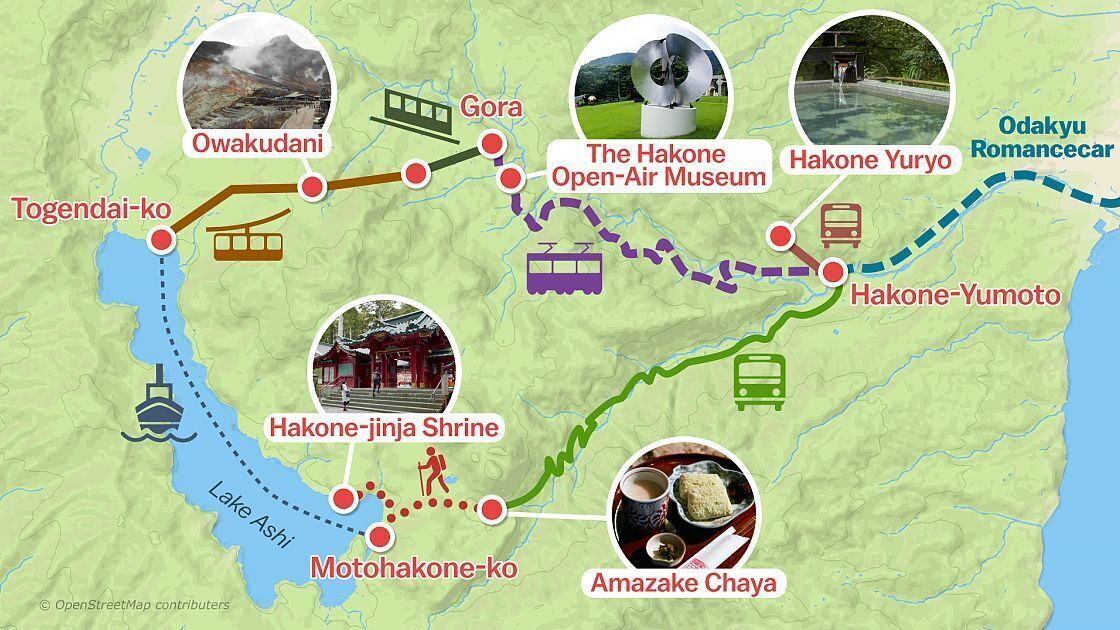
A convenient and useful pass to get when touring Hakone is the Hakone Freepass , a discount pass offered by Odakyu Electric Railway. The pass allows for a round trip from a station on the Odakyu Line, including Shinjuku in central Tokyo, and unlimited travel on all Odakyu-affiliated buses, trains, ropeways, cable cars and ships in the Hakone area for two or three consecutive days. The pass can be purchased at ticket counters and ticket machines, or ticketless in digital form online on your smartphone.
The process of purchasing a Digital Hakone Freepass is quick and easy. Simply access the Odakyu Electric Railway website on your smartphone, select the Hakone Freepass and purchase the pass with a credit card. Afterwards, just show the ticket on your smartphone to the staff at the ticket gates. Some of the benefits of purchasing a digital pass compared to a physical ticket include being able to purchase the ticket anytime and anywhere before your trip, and not worrying about losing the pass.
For my day trip to Hakone, I purchased a Digital Hakone Freepass, which I breezed through. I started my journey from Shinjuku Station in central Tokyo and took the Limited Express Romancecar on the Odakyu Line which requires an additional limited express ticket, to Hakone-Yumoto Station.
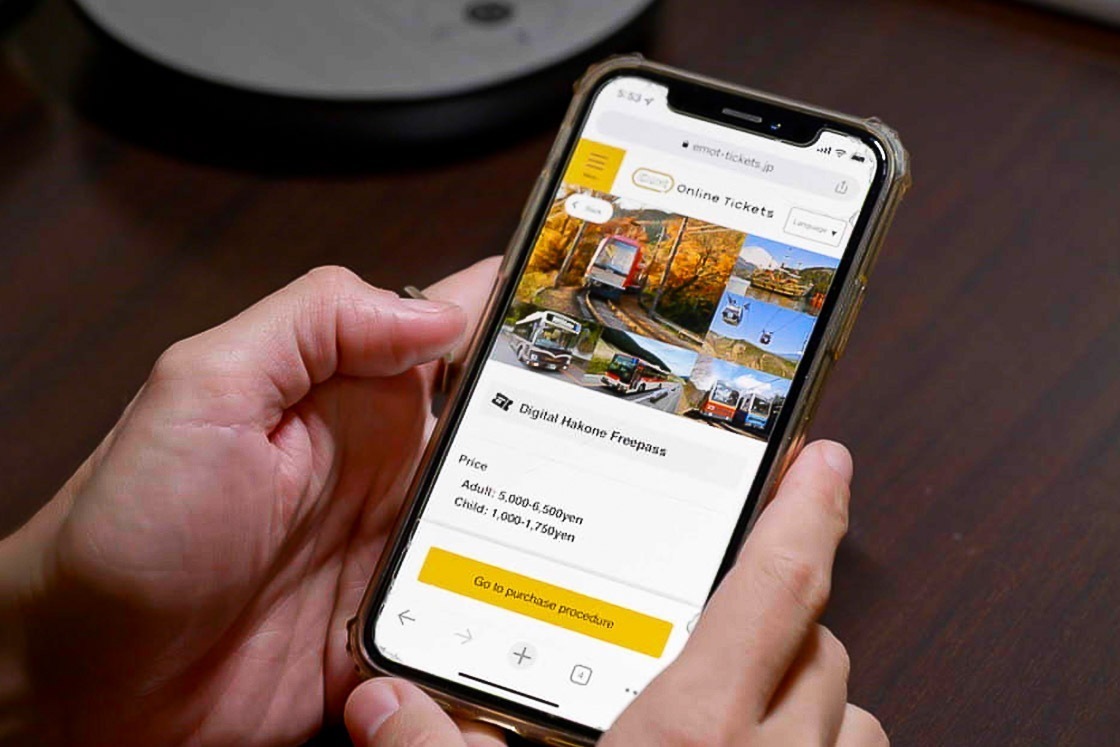
My day out in Hakone started with an approximately 30 minute bus ride from Hakone-Yumoto Station to Amazake Chaya , a traditional teahouse which has been family run since it was established about 400 years ago. The tea house is located along the old Tokaido, Japan's most important highway during the feudal times connecting Tokyo - then known as Edo - with Kyoto along the Pacific Coast, and has been offering tired travelers a place to take a break, have some food and drink for centuries.
A drink not to be missed is amazake, the namesake of the tea house. Amazake is a non-alcoholic, sugar-free drink made from rice which was fermented with koji yeast. The naturally sweet and nutritious drink can be drunk hot or cold, and would have nourished many tired travelers over the centuries. I ordered amazake and a small snack for sustenance in preparation for the next leg of my trip, walking part of the old Tokaido.
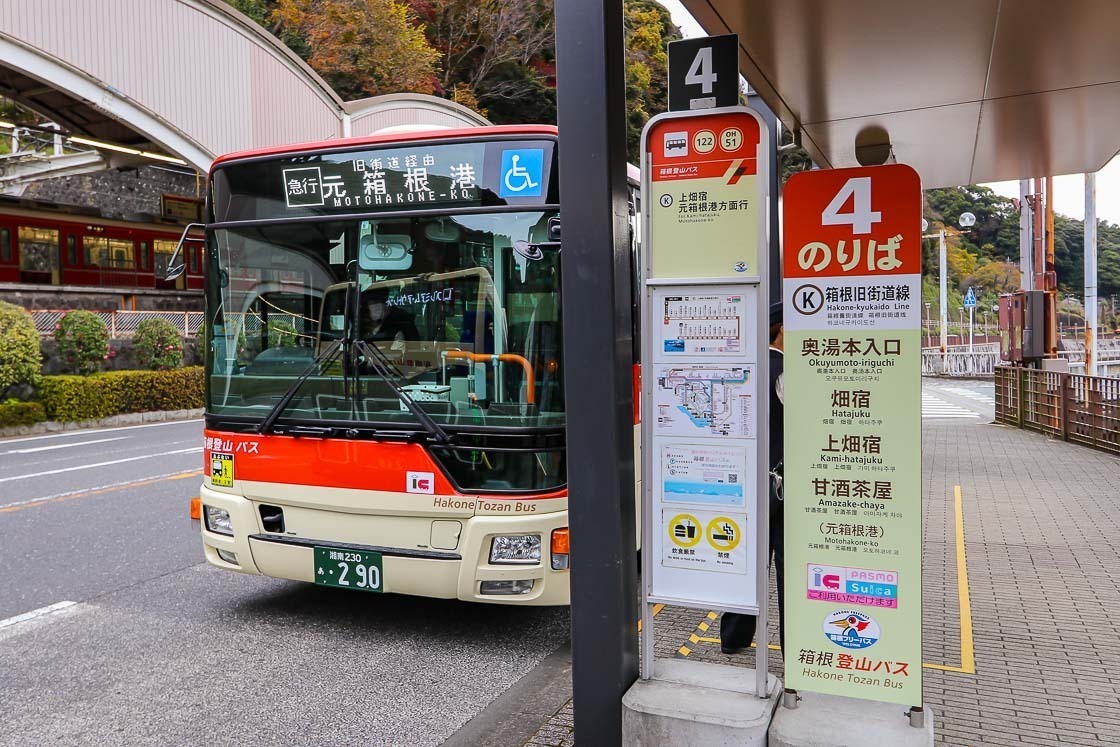
As mentioned earlier, the old Tokaido was Japan's most important highway during the feudal period, and two checkpoints were built to control traffic along the road. Hakone was one of these two checkpoints overseeing traffic in and out of Edo. Parts of the old Tokaido road have been preserved and the portions near Amazake Chaya is one of them.
My walk on the old Tokaido started from Amazake Chaya and led about 1.5 kilometers west towards Lake Ashi, which took me about 50 minutes. There were slightly steep inclines along the way, but it was nothing too strenuous and can be completed comfortably by those of average fitness. The preserved cobblestone path is flanked by tall trees, and I imagined that the view I saw must have been the same sight that travelers of the past saw. The old Tokaido road continues along the lakeshore towards the Hakone Checkpoint, but my walk ended in the small lakeside town of Moto-Hakone.
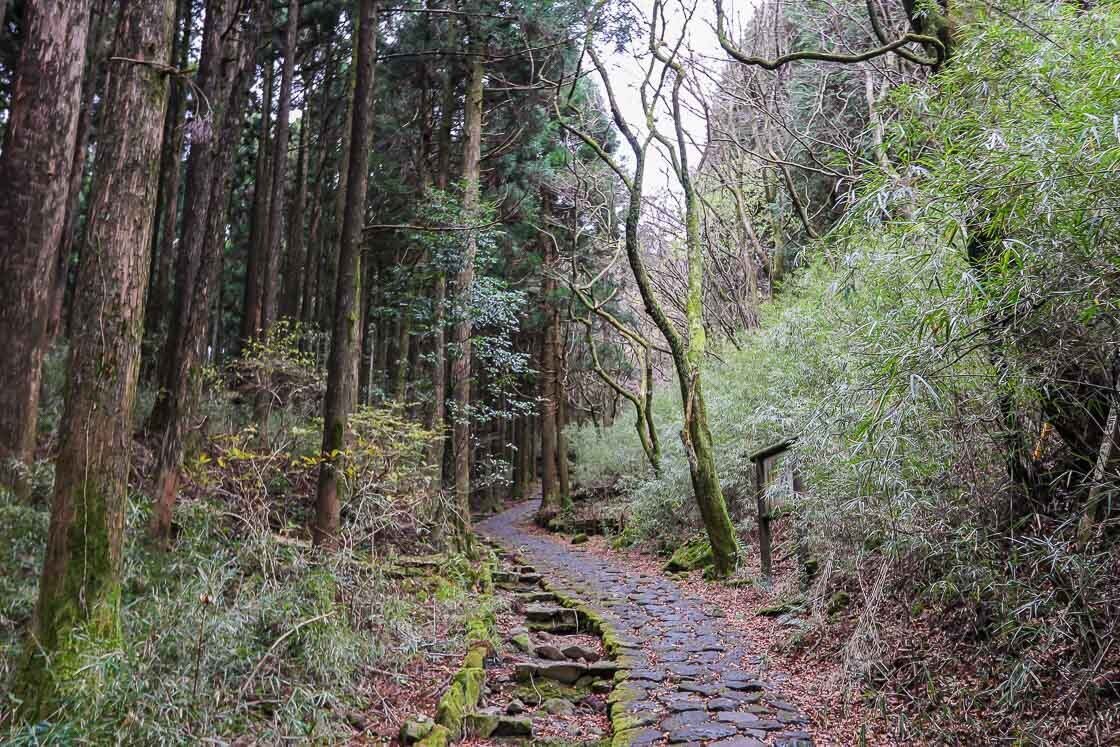
Moto-Hakone is where some of the best views of Mount Fuji in Hakone can be had when visibility is good. Additionally, sightseeing cruises depart from the Motohakone-ko pier, and the atmospheric Hakone-jinja Shrine is a short walk along the shores of Lake Ashi.
I continued on foot towards Hakone-jinja Shrine after arriving at Lake Ashi in Moto-Hakone, and went to the large torii gate that stands in the waters of the lake first. An image of the torii gate in the water together with Mount Fuji in the background make for an iconic image of Hakone, but alas, Mount Fuji remained hidden behind the clouds when I was there.
Located in the woods and surrounded by tall trees, Hakone-jinja Shrine is an oasis of calm and serenity. I made my way up the flights of stairs from the torii gate in the water to the main shrine building to pay my respects before going to the pier to catch a sightseeing cruise.
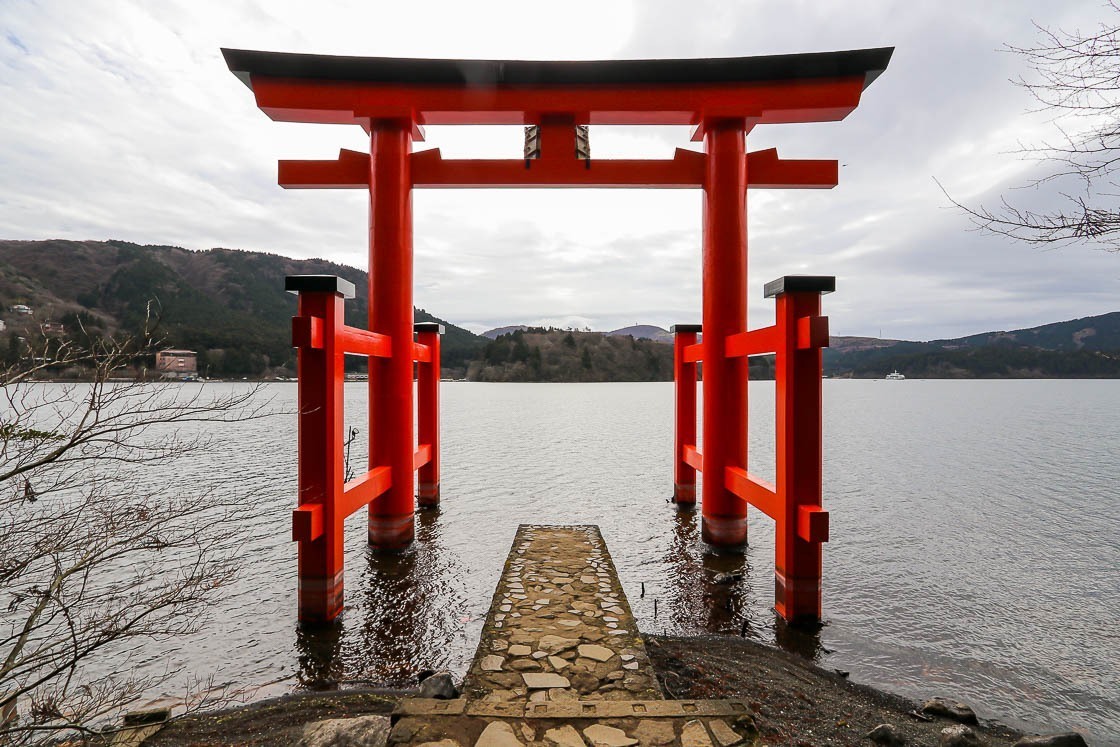
A fun mode of transport in Hakone is the Hakone Sightseeing Cruise , in which a few different types of pirate ships sail the waters of Lake Ashi. I boarded a pirate ship at Motohakone-ko and arrived in Togendai-ko approximately 30 minutes later. The cruise is fully covered by the Hakone Freepass, and was an entertaining ride across the lake. At Togendai-ko, I transferred from the boat to the ropeway to get to Owakudani.
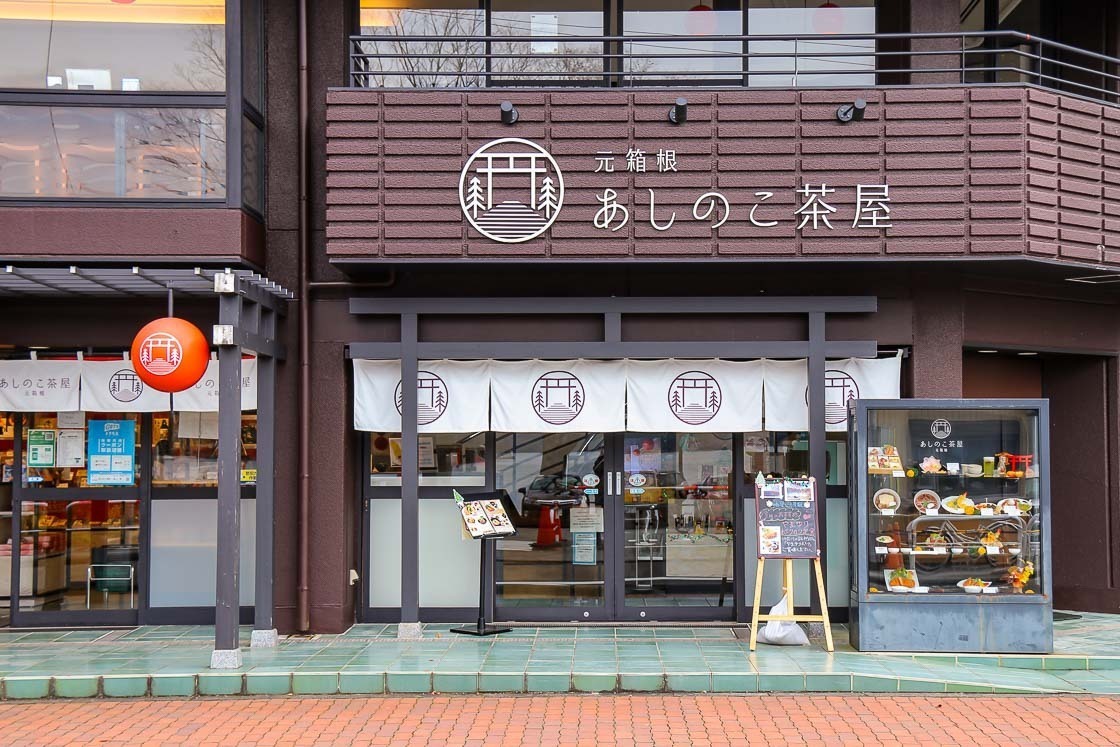
Owakudani is a volcanically active spot in Hakone that was formed over 3000 years ago when Mount Hakone erupted. Today, the area is a popular tourist attraction in Hakone where visitors can see volcanic landscape like smoking vents and boiling pools. Owakudani is also a nice place to view Mount Fuji when visibility is clear, like at Moto-Hakone. Owakudani is one of the major sources of the hot spring waters in Hakone, and its waters are piped from there to the various hot spring facilities.
In addition to seeing the volcanic landscape, Owakudani is famous for its black eggs - chicken eggs whose shells turn black from being cooked in the sulfuric pools. The black eggs are sold in packs of five, and eating one egg is said to extend your life by seven years. If eating eggs are not your kind of thing, other "black" foods at Owakudani include black curry, which I heard is quite delicious, black ramen, in which the noodles are black, and black soft serve ice cream which is made with bamboo charcoal. I couldn't help but go for the black ice cream before leaving the area.
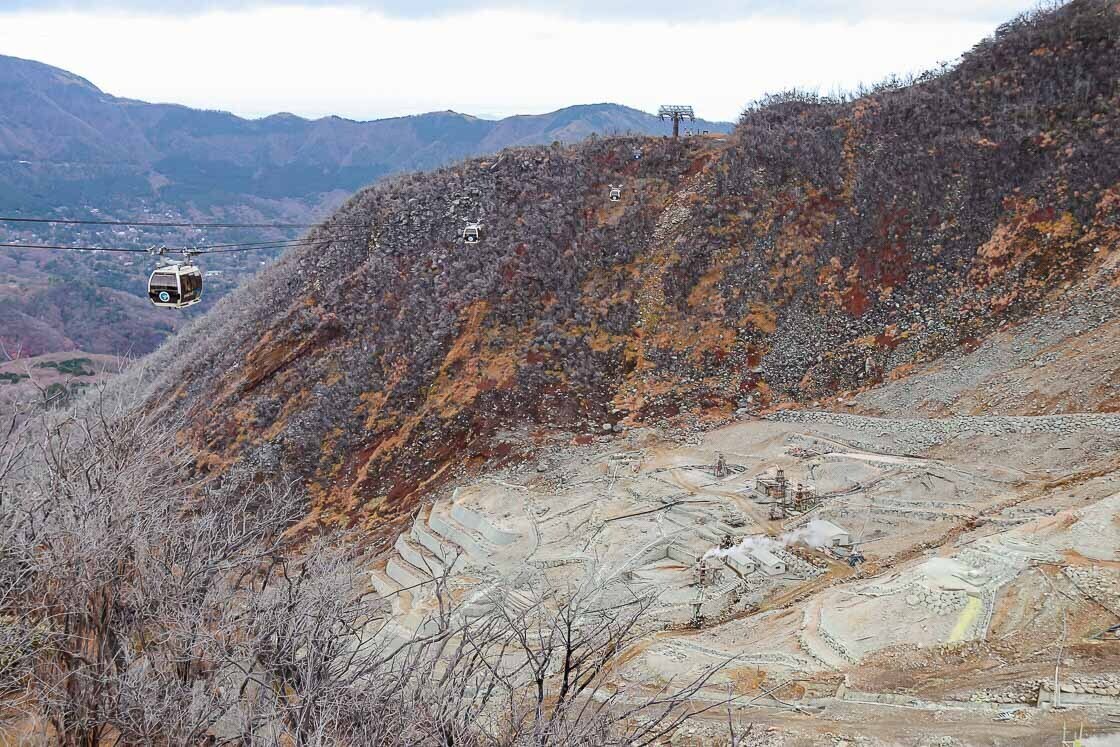
Continuing on my day trip, I got back on the ropeway, transferred to the cable car, then finally the train to get to the Hakone Open-Air Museum . The museum is one of the first outdoor muesums in Japan, and the spacious grounds contain a large variety of sculptures, installations and paintings in both indoor and outdoor exhibition areas. One of the missions of the museum is for visitors to enjoy and experience art in nature, and I had a lovely time walking in the wide lawns enjoying art alongside the colors of the season.
A visit to the Hakone Open-Air Museum typically takes about two to three hours, but I have been told that it is not unheard of for some to spend an entire day just at the museum and taking in all the sights leisurely. After spending some time at the museum, it was time to start winding down my day. I got back on the train and made my way back to Hakone-Yumoto Station, from where it was a three minute free shuttle bus ride to Hakone Yuryo.
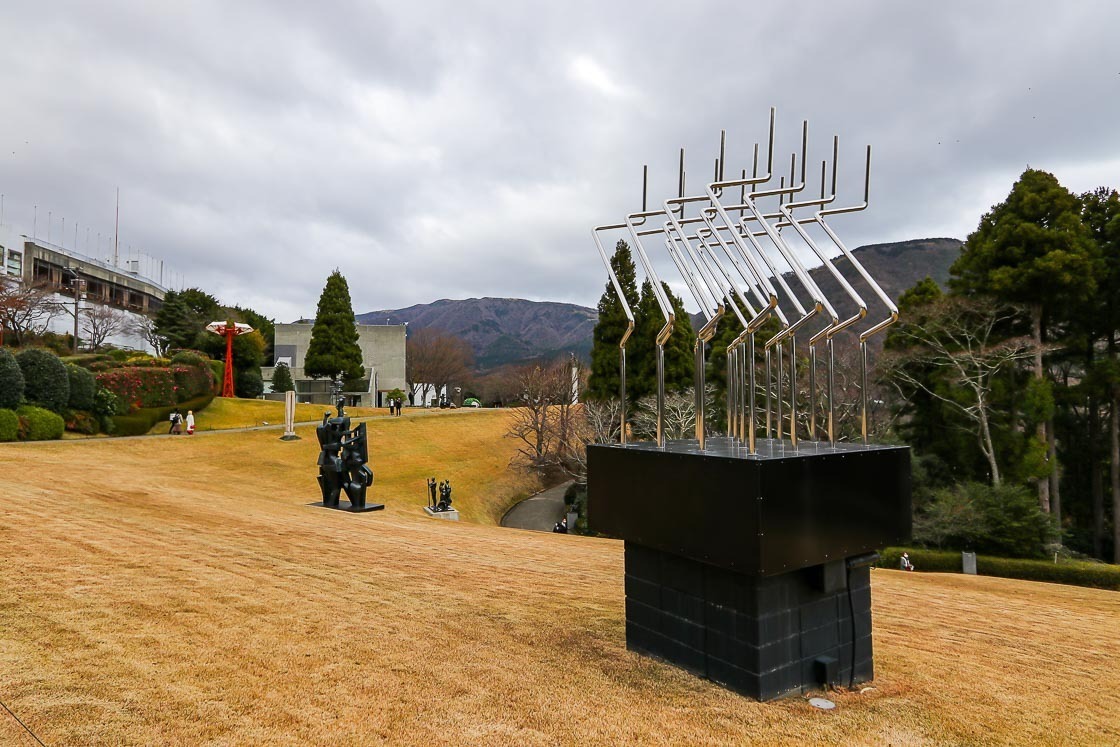
Hakone Yuryo is a day visit hot spring facility, which has both public and private baths. Having gone for a nice hearty walk in the morning and seeing one of Hakone's hot spring sources at Owakudani, going for a bath at Hakone Yuryo felt like a nice and deserving way to wind down. It was so relaxing to soak in a hot spring bath after a whole day out, and I felt recharged and refreshed after that.
As I had a bit of time before my train back to Tokyo, I took the opportunity to check out the local souvenirs in the shopping street beside the station. I had a great day out visiting the major sightseeing spots in Hakone, and I was already planning another trip back, an overnight one perhaps, as I left Hakone.
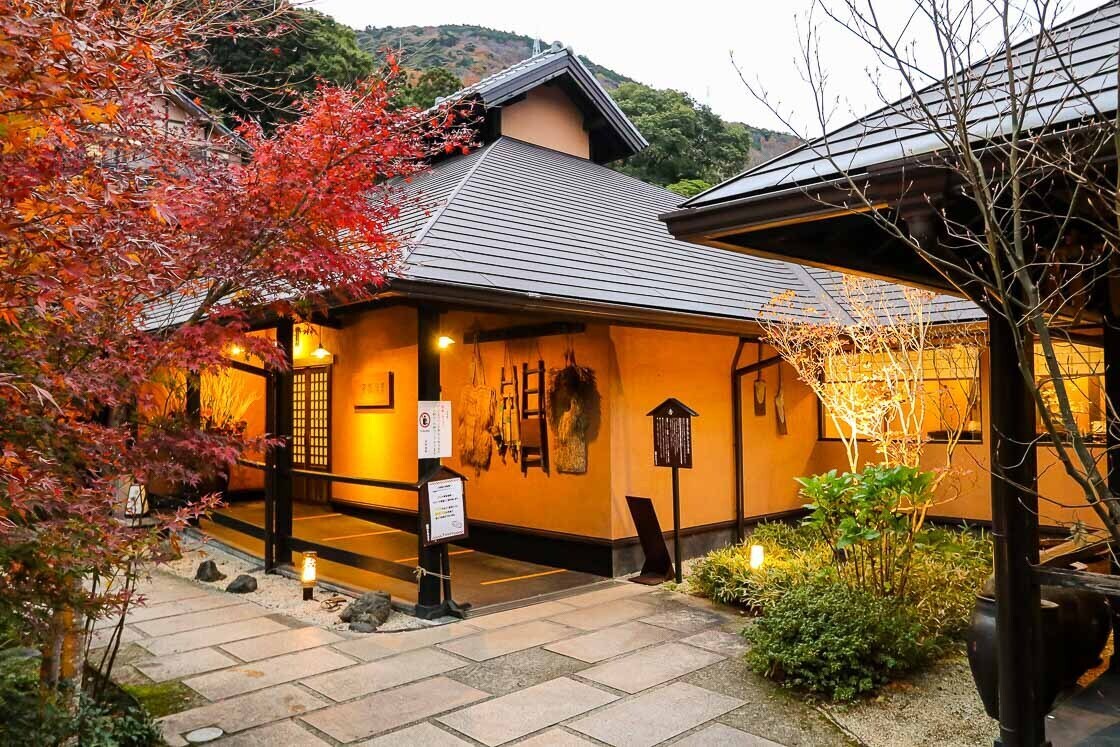
Hakone can be accessed from Shinjuku Station in central Tokyo, and Hakone-Yumoto Station is one of the area's main transportation hub. Regular trains make the journey between Shinjuku and Hakone-Yumoto in about two hours, and a transfer at Odawara Station is required. The Limited Express Romancecar provides a direct route between the two stations in about 80 minutes, but note that an additional limited express ticket is required which is not covered by the Hakone Freepass.
Within Hakone, a network of buses, trains, ships, ropeways and cable cars provide access to many of the sightseeing attractions. The modes of transport taken in this article are fully covered by the Hakone Freepass.
The Hakone Freepass is a discount pass offered by Odakyu Electric Railway. The pass allows for a round trip from a station on the Odakyu Line, including Shinjuku in central Tokyo, and unlimited travel on all Odakyu-affiliated buses, trains, ropeways, cable cars and ships in the Hakone area for two or three consecutive days. The pass can be purchased at ticket counters and ticket machines, or ticketless in digital form online on your smartphone.
The process of purchasing a Digital Hakone Freepass is quick and easy. Simply access the Odakyu Electric Railway website on your smartphone, select the Hakone Freepass and purchase the pass with a credit card. Afterwards, just show the ticket on your smartphone to the staff at the ticket gates.
- Hakone Freepass - Official website about the Hakone Freepass
Hakone Day Trip or Overnight Stay?
There are many things to experience in Hakone, but there are many things to do in Japan as well. Discover your best way to explore the Hakone area.
Hakone is a stop of many itineraries while visiting Japan. The mountains, nature, museums, and hot springs of the area draw people from around Japan. For any trip to Japan, there never seems to be enough time to do everything. Hakone also has many things for you to do and explore. Here is some information on whether a day trip or overnight trip to Hakone is good for you.
Odakyu Romance Car from Shinjuku Station in Tokyo
Hakone is less than two hours from Tokyo. You should take the Odakyu Romance Car from Shinjuku Station of the JR Tokaido Line and transfer at Odawara Station. Either trip will take less than two hours. There is a lot to see so get started early if you are planning to make a day trip to Hakone. A day trip from Tokyo to Hakone should start about 8:30am and get you back to Tokyo around 6:30pm.
Lake Ashi Cruise
The “ Hakone Loop ” is a suggested itinerary that will let you see the most popular attractions in the Hakone area. Make sure you get a Hakone Freepass to make the transportation by bus, train, boat, and ropeway cheaper and more efficient. The Hakone loop can be enjoyed in either a clockwise or counter-clockwise route. Going counter-clockwise will be less crowded, but allow you to see all the same sites.
Fountains of Hakone Shrine
With just a day, the highlights that can easily be seen together are the Hakone Shrine, Lake Ashi, steaming vents of Owakudani , and the towns of Moto-Hakone, Yumoto, and Gora. If you manage your time correctly you might be able to fit in a short hike the Chisuji Waterfalls or one of the many museums in Hakone.
An Overnight Hakone Stay
Hotel Green Plaza
Hakone is best experienced overnight because it gives you a chance to see more, but also lets you stay in one of the many people’s accommodation in the area. Hakone has refined the art of Japanese hospitality, omotenashi, over the centuries. People have traveled between Tokyo and Kyoto for hundreds of years and many stayed in the Hakone area. You can enjoy the area more with a stay at a traditional ryokan, luxury resort, or western hotel.
Yaeikan Ryokan Onsen
Staying in Hakone allows you to break up your exploration of the area into two days. Choosing an area to stay can also influence how you explore the area. Gora is centrally located, Yumoto is close to transportation, Miyanoshita has a historic vibe, Sengokuhara gives you easy access to Mt. Fuji, and Moto-Hakone lets you enjoy the peaceful lakeside area.
The western Kanagawa area also has some amazing sites to visit that can be easily reached from Hakone. Using Hakone as a base of exploration you can visit the castle and fish markets of Odawara, beaches, and the seaside town of Manazuru, zen temples and mountains of Ashigara, green tea fields and sake factories of Matsuda, Mt. Fuji and Gotemba are all just a short trip from Hakone.
Fukuzumiro Ryokan
Staying overnight gives you a chance to enjoy the beauty of Japan at a comfortable pace while also giving you the option of seeing some wonderful sites in the area. Just making it a day trip works into many itineraries for Japan and still gives you a chance to see the highlights in the area.
Hakone Travel Ideas
Travel between hakone and kawaguchiko.
How do you travel between Hakone and Kawaguchiko? These popular destination around Mt. Fuji are connected by bus, but there are some other options and plans available to help you make the best use of your time while in Japan.
15 Things to Do in Hakone
The Hakone Tozan Train
The Hakone Tozan Mountain train is one of Japan`s most impressive and beautiful train rides taking you through wonderful mountain villages and stunning views of nature
15 Best Places to visit in Hakone
15 Best Places to Visit in Hakone
Fuji Hakone Pass
Explore Mt. Fuji and Hakone on one ticket
Can I use the JR Railpass from Tokyo to Hakone?
The JR Railpass is one of the most convenient tools to use during your trip to Japan. Here is how to use your JR Railpass to get to Hakone.
JR Railpass and Hakone
The JR Railpass can help you get to Hakone. The Odakyu Freepass is your best option for the Hakone area, but the Japan Railpass can be convenient.
Travel between Hakone and Kawaguchiko Lake
Hakone and Kawaguchiko are two beautiful places that are conveniently connected by bus. See the different beauty of Japan from both.
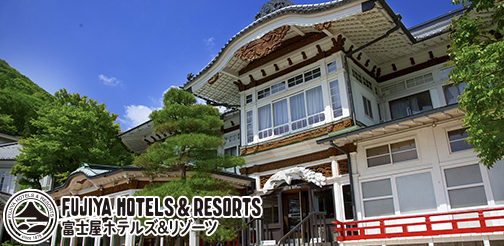
© hakone tourist association, All rights reserved.
- EXPERIENCES
- NATIONAL PARK
- FOODS & SHOPS
- EVENTS & FESTIVALS
- SIGHTSEEING
- HAKONE LOCAL TOURS
- GETTING AROUND
- ITINERARIES
- ACCOMMODATIONS
- HELPFUL INFO
- INFORMATION
Planning a great Hakone day trip
By Author Toni Broome
Posted on Published: April 16, 2015 - Last updated: August 31, 2021
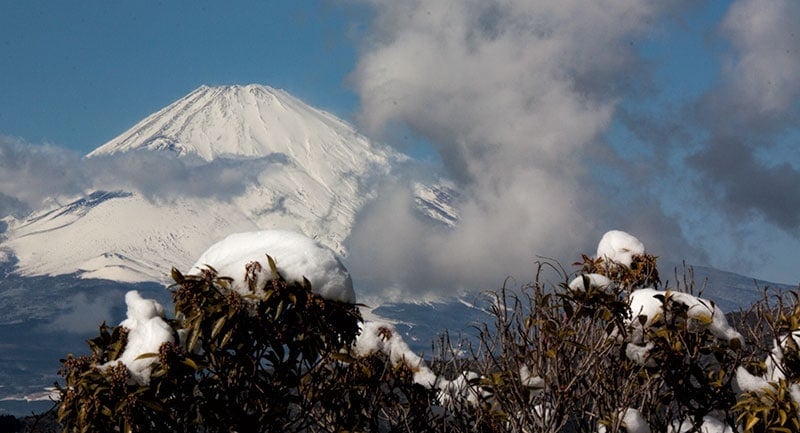
We decided that a Hakone day trip had to be included on our winter visit when we woke up one morning in Tokyo, flung open the curtains of our room at the Hotel New Otani and were greeted with an amazing view of Mt Fuji in the distance set against a clear blue sky. A few days later on another super clear morning, we jumped on an early bullet train and half an hour later we were in Odawara. We stopped into the information centre and picked up the ‘Hakone Free Pass’ and were on our way.
This pass was great value for us and there are a couple of versions to suit your travel needs. If you don’t have the JR Pass you can get the version that starts at Shinjuku in Tokyo, otherwise, jump on the Shinkansen to Odawara at Tokyo or Shinagawa stations and you’ll get there faster and save a few dollars.
The base pass is for 2 days but it’s still great value for a day trip, then there’s a 3-day version if you’re staying a couple of nights. The ticket we purchased was Y4000 (just over $43 Australian dollars). It covers all the transport you’ll need, the Tozan train and the cable car, the Hakone ropeway, a sightseeing cruise on Lake Ashi and a variety of buses between locations too. You can use all of them multiple times and in either direction. You also get discounts from dozens of museums, restaurants, onsen and other attractions by showing the pass.
>> Check latest prices for the Japan Rail Pass <<
We have another article on the site to give more information and to help you decide whether the Hakone Freepass is good value and if it might work well for you.
The variety of transport on this circuit and the amazing views they provide are a big part of this trip. We did the course anti-clockwise and if we did it again we would probably have doubled back after exploring the attractions at the southern end of the lake to enjoy the ropeway a second time. The bus was a faster way back to Odawara from Motohakone-ko but didn’t add much to the trip for us but we loved the ropeway and our time up the mountain.
>> Reviews and deals for the Hakone Freepass <<
Table of Contents
Hakone Tozan Train
Hakone tozan cable car, hakone ropeway, hakone sightseeing cruise, hakone checkpoint, there’s free wifi too, looking for a way to do mt fuji and hakone in one day, additional information for planning your trip to hakone.
We arrived at Odawara station on the Shinkansen but other JR local trains will get you to here too. We then took the Tozan train on the Odakyu line through to Gora. It’s a pretty standard older style train but very clean and comfortable as you come to expect in Japan. There are plenty of windows and we sat on the left-hand side which gave some gorgeous views as it meandered along its 40-minute route.

The train is built to climb the steep mountain slopes through the heavily planted area and over the 43-metre high Deyama Bridge. We’ve now been back through here in the autumn and I can imagine this route would be stunning in all seasons.
How gorgeous is the snow! Probably not so much if you live with it all the time but for someone from the sub-tropics it is a real highlight and had my camera out constantly. I had expected snow up the top of the rope-way but seeing it along the route was a definite bonus. The clear blue winter sky really made it extra special.

Hakone-Yumoto station is a popular stop on the Tozan Train route. This is the starting point if you arrive on the Odakyu Romance Car from Shinjuku or about a 15-minute ride from Odawara if you arrived by Shinkansen or other JR train. It’s an adorable little town with some good restaurants along the main street.
You can follow the river to the Tamadare waterfall and Shogenji Temple or do an onsen experience at Hakone Yuryo as we did if you can fit it into your day. Either start here or end your day with a relaxing soak and dinner.
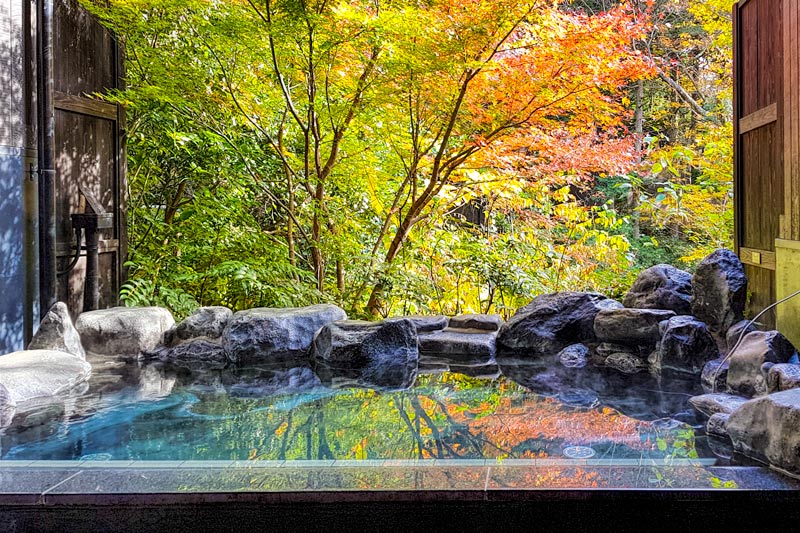
If you want to visit the Hakone open air museum , an outdoor art gallery and park then that is accessed along this route from the Tozan train. We visited it on a separate autumn visit and have included all the details you need and a load of photos to give you an idea of what to expect in the link.
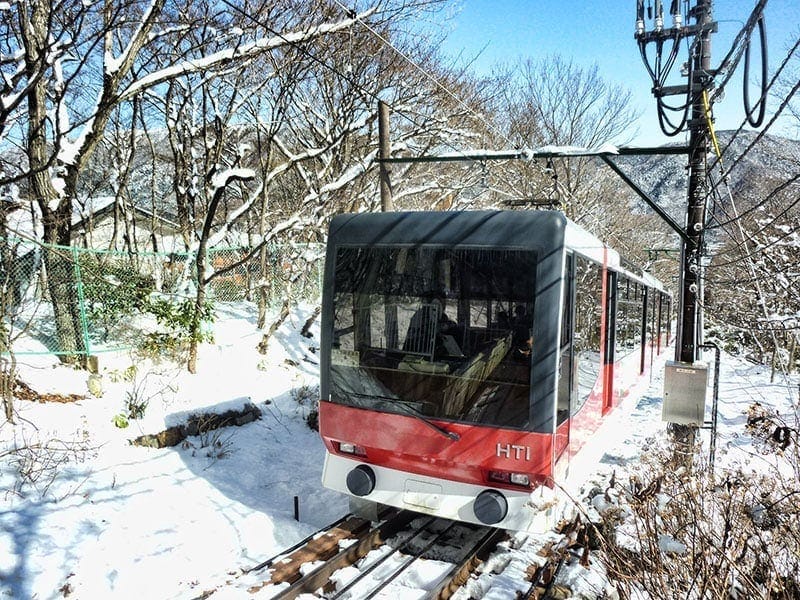
From the train station in the onsen town of Gora you walk to the adjacent cable car station. It looked a pretty town and I’d have liked more time in our schedule to explore a little on foot. Once on the cable car, it’s only a 10-minute ride up the hill and the views along the way are stunning, make sure you get a seat by one of the huge windows. Then at the top of the cable car is the first rope-way station.
The ropeway was amazing, each carriage has huge windows that provide amazing views of the mountain and the valley below. The full ropeway from Sounzan to Lake Ashi takes 30 minutes but you’ll want to get off in the middle to explore Owakudani.

Three thousand years ago Mount Hakone erupted leaving a crater that is known today as Owakudani. The area remains an active volcanic region with hot rivers and springs and the ever-present smell from the sulphur fumes. It’s sometimes called Hell Valley which may be a throwback to the name O-Jigoku meaning ‘great hell’ which the area was known as around 150 years ago.

You can walk up to see the kuro-tamago (black eggs) being boiled in the natural springs, the minerals turn the shell black but inside it still looks like a normal boiled egg. Legend says eating one will extend your life 7 years but I couldn’t bring myself to do it, I hate everything about boiled eggs. There are plenty of weird and wonderful things I’ll eat on my travels but a boiled egg, well heck no! The legend also says you should eat no more than 2 so don’t go trying to make yourself immortal.
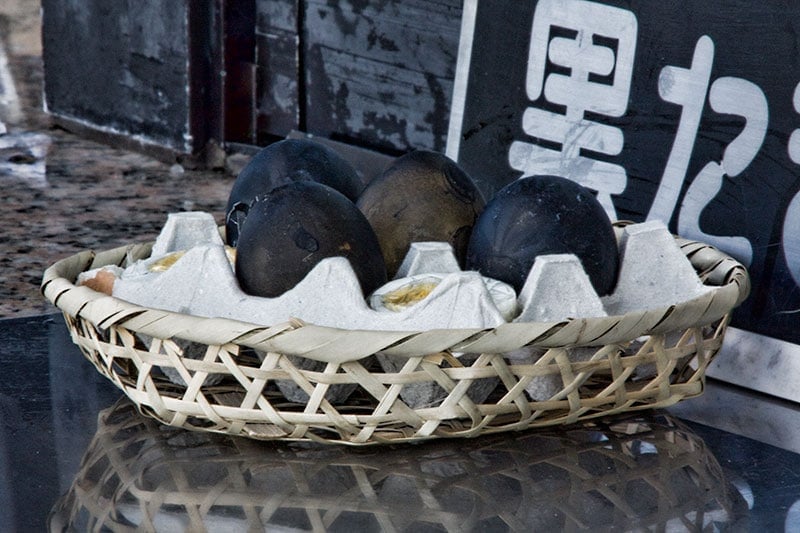
The view of Mt Fuji was unbelievably good from up here but I believe it does depend on the day. If you can pick a clear one it’s best, on a bad day Fuji-san might be off hiding in the clouds and you’ll never know it’s there.
I also loved this small Buddhist alter near the entrance to the walk up to the hot springs. The Buddhist monk Kobo Daishi who founded the Shingon sect in Japan visited this spot 1000 years ago, he prayed for those suffering in the hell realms and placed a statue of the Bodhisattva Jizo. Today the Enmei Jizouson Temple stands here.

From Togendai the pirate boat cruises the length of Lake Ashi to Moto-Hakone-Ko. The views of Mt Fuji are also pretty stunning from the lake but the day was starting to cloud over as the afternoon progressed. I would imagine in other seasons the hillsides would be really pretty but with just a dusting of winter snow, they were quite brown and bare.
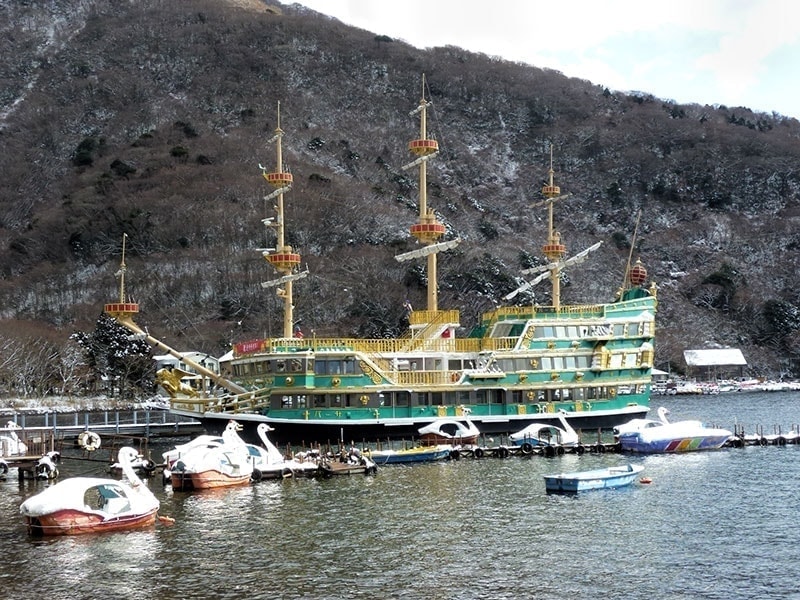
At the southern end of Lake Ashi is the Hakone Checkpoint. During the Edo period, this was an important checkpoint on the Tokaido highway that linked Tokyo and Kyoto. Recent work has restored it to a structure consistent with that time with gates, fencing, a lookout, prison and housing as it would have been for the officers and soldiers during that time.
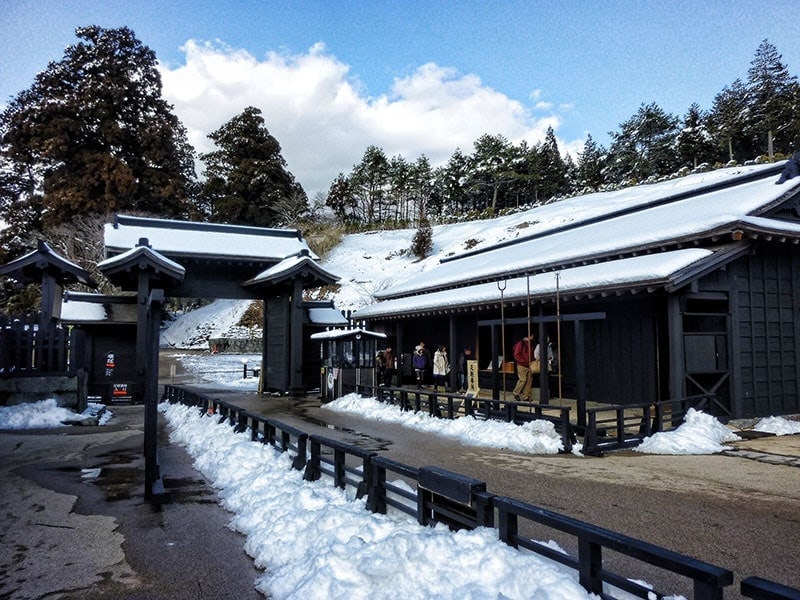
Also further on from here is the cedar walk, a segment of the old Tokaido highway. There was a good covering of snow on the ground so it wasn’t possible to tell on the day we went but I believe some of the original highway stone paving is visible here during most of the year.
A bit further on again you’ll come to the Hakone Jinja (Shinto shrine). It’s set into the forest but you’ll see the torii gates as you approach from the Moto-Hakone road. Once inside walk down to the lake and you’ll see a ‘floating’ torii, it’s much smaller but a similar concept to the one at Miyajima island.
We pretty much called it a day from here and headed back using the local bus service which was also covered by the pass. With a day trip during the short days of winter, it was difficult to fit much more in. We are slow travellers, love a bit of a detour and did spend longer than we planned at Owakudani. We decided to stop for lunch up the top of the mountain there as the views out to Mt Fuji were just so good.
We went back on another trip to visit the Hakone Open Air Museum (art gallery) as we ran out of time to loop back as we planned to at the end of the day. Also an overnight trip would allow you to make use of the hot spring onsens that the area is renowned for, several of the hotels have these available for guests. I’ve shared information on our Hakone Onsen experience and it is practical to add this and dinner to the end of your day’s sightseeing even if you’re returning to Tokyo or on to Kyoto.
You might have noticed that free Wifi isn’t as easily available in Japan as it is in many western countries. This had been a surprise to me given how technologically advanced Japan is. There are personal wifi options for travellers and some free connections available if you know where to look. We now choose to carry personal WIFI that works across our phones, tablets and computer across Japan. This WIFI service is a good option for many travellers and can be quickly collected from the airport when you arrive and dropped back as you leave
If you choose to use the free options when they are available then the Hakone day trip will make it a little easier for you to look up information or share those gorgeous pictures of your day on Instagram during the day using the Odakyu Free Wifi. There are blue signs with the international wifi symbol showing where it’s available but it’s at the various stations, ports and on the boat as you go around the course.
Travelling independently our experience is that Hakone and Mt Fuji require a minimum of a day each in order to see enough to really enjoy it. Sometimes though time is really limited and you just don’t know when you will have the chance to be back.
If that’s the case then there is a recommended tour option that includes the highlights of both Mt Fuji and Hakone. The tour picks you up from a variety of locations in Tokyo, you make the trip up to Mt Fuji’s 5th station for its incredible views, cruise in on Lake Ashi, and ride the ropeway taking in the unique perspective on stunning views of Hakone and Mt Fuji. The tour includes lunch and transfers back to Tokyo.
We have a few extra resources to help you plan your trip to Hakone.
- Our route and an assessment of when the Hakone Free Pass is good value
- Our experience at a traditional onsen in Hakone during the autumn season
- Tips for planning your trip to see the outdoor art display at the Hakone Open Air Museum
- The tips you need to get the most out of the transport system in Japan
- Our Japan Guide linking you up with all the information, tips and suggestions you need to know
Have you visited the Hakone area either on a day trip or longer stay? If you have a moment please leave a comment below to share your thoughts on your experience and your favourite spots in the area.
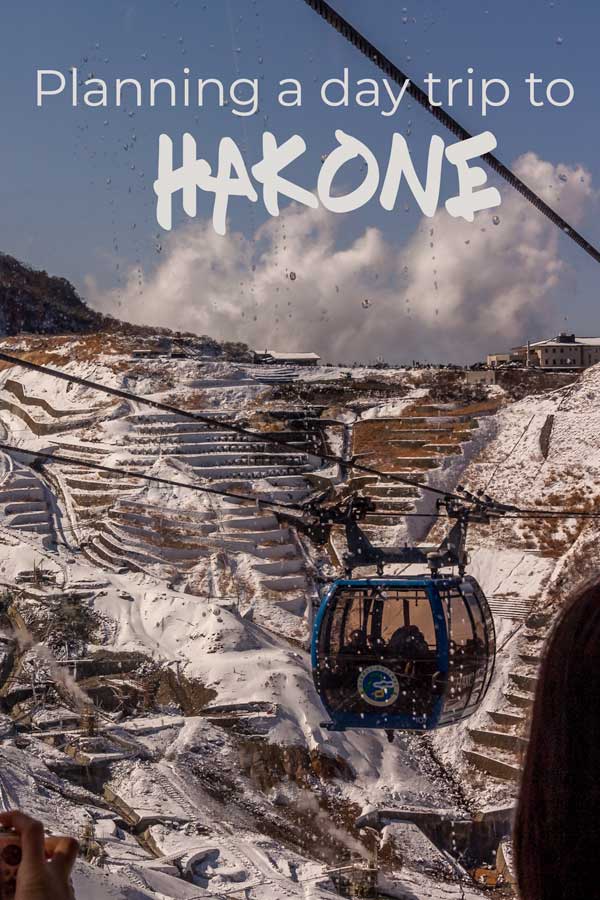
This site uses Akismet to reduce spam. Learn how your comment data is processed .
Saturday 18th of January 2020
Hello 2AT, thank you so much for your great posts! I will be traveling with my husband and 2 sons, ages 24 and 18 to Japan during the 2020 Olympics. We want to take one of the days from Tokyo to do a day trip to Hakone. Obviously, we anticipate big crowds. We think the Hakone Free Pass is the best choice, even though we will only be there one day and return to Tokyo in the evening. What happens if the trains are full? Do we catch the next one? Also, where is the absolute best view of Mt. Fuji? That is our main objective, since we will not have much time there. I appreciate your feedback. Vivian
Toni Broome
Hi Vivian, I think you are right that it will be very busy during the Olympics but it's much harder to predict how that will impact outside Tokyo than normal seasonal peaks. I would pre-book the romance-car or another train between Tokyo and Odawara/Hakone that way you know you are going to get there and back on your own timetable. The Hakone transport on the loop using the pass is just a case of waiting for the next one if it is full, it's less of an issue on the trains and buses but there is often a bit of a queue as they are loading up the cable car (due to be reopened in March after the typhoon damage) and at the ropeway stations but it moves quite quickly.
There are many places to view Fuji but all of them depend on the day and with the Olympics being in summer that is less likely to be a clear day although it changes frequently, our best view was from Owakudani near the geothermal area at the top of the ropeway but when we arrived it wasn't visible due to clouds, when they cleared just a few minutes later it was a stunning from up there. On Lake Ashi and from the shores around the lake is another top spot. Both are on the circuit with the Hakone Freepass.
IFTEKHAR I ASIF
Thursday 26th of December 2019
Thanks for the post. I am going on a day trip this new year's vacation. I will follow this blog.
Anyway, I have a question. If I take a 2-day pass & come back to Shinjuku that day, then can I use the same pass the next day? I am not getting this information anywhere. So, if you know please let me know before 30th December. Thanks!
At this stage (December 2019) the Tozan Cablecar is not operating due to damage to the track that occurred during a major typhoon in the late summer. Odakyu are operating an alternative bus between Gora station and Sounzan Station. This is expected to continue until late March 2020. The bus fare is included in the Hakone Freepass. Changes to services can be seen on the official site.
The 2-day pass includes 2 days of transport in the Hakone area but one return trip to Tokyo.
Travel in pictures
Thursday 5th of September 2019
Thanks for sharing. We went to Japan with the kids and it was amazing.
Tuesday 2nd of April 2019
Hi, Great post!! We are visiting Japan next week and will have a JR pass. Does this cover all the transport options you mention in your day trip? Thanks viv
Hi Viv. The JR Pass covers very little of Hakone. JR or Japan Railways is the National train company and operate most of the intercity routes and bullet trains in addition to some routes in city areas. There are also many smaller railway companies that cover smaller areas and provide commuter and/or tourist services in those areas. In Hakone that is Odakyu which is why their 'Hakone Free Pass' can be a good option for visiting here and saving money if you are doing the loop or moving around quite a bit. With your JR pass you will probably want to take the bullet train as far as Odawara (the JR Hakone stop) but from there will need individual tickets or the Hakone Free Pass. Odawara is a hub station, both JR and Odakyu use it. I'll link another article that shows a value calculation on the pass, this was based mostly on one of our first trips there where we also use the JR pass as far as Odawara.
Thursday 7th of March 2019
Hi, This article and the Hakone Freepass value was extremely informative. It has helped me plan my Hakone itinerary very well. I have one doubt though - All through your Hakone trip(Odawara-Gora-Sounsan-Togendai circuit), you do not mention the Fuji 5th station. Is this a deviation? I would like to include this also in the aforesaid circuit. Can you advise please?
While you can see Fuji really well from points around the circuit you aren't actually that close to it so it doesn't form part of the Hakone circuit. If you were going to do both destinations in a couple of days the Fuji Hakone Pass would be better than the Hakone free pass for that. By preference, if doing it independently I'd go directly from Tokyo to Kawaguchiko then take the bus from outside the train station (just under an hour) to the Fuji 5th station.
1 hr 14 min
Day Trips from Tokyo Sightseeing Japan
- Places & Travel
Tokyo has all sorts of attractions to offer, but venturing outside the bustling city for a day trip can unveil another side of Japan. Join Jason and Paul as they explore the many diverse experiences that can be had just beyond Tokyo’s borders! Topics Covered: Kamakura and Enoshima (Ep72) Kawagoe (Ep46) Nikko (Ep80) Mt. Fuji (Ep10, also mentioned Arakurayama Sengen Park) Amusement Parks (Ep 94) Mt. Takao (Ep 119) Utsunomiya Hakone Odawara Omiya Yokohama Chiba Shizuoka Join our Discord community! Become a member on Patreon!
- Episode Website
- More Episodes
- 2019-2023 Jason Nieling
- Japan Tourism
- Japan Hotels
- Japan Bed and Breakfast
- Japan Vacation Rentals
- Flights to Japan
- Japan Restaurants
- Things to Do in Japan
- Japan Travel Forum
- Japan Photos
- All Japan Hotels
- Japan Hotel Deals
- Last Minute Hotels in Japan
- Things to Do
- Restaurants
- Vacation Rentals
- Travel Stories
- Rental Cars
- Add a Place
- Travel Forum
- Travelers' Choice
- Help Center
Culture Day 2024 - Japan Forum
- Asia
- Japan
Culture Day 2024
- United States Forums
- Europe Forums
- Canada Forums
- Asia Forums
- Central America Forums
- Africa Forums
- Caribbean Forums
- Mexico Forums
- South Pacific Forums
- South America Forums
- Middle East Forums
- Honeymoons and Romance
- Business Travel
- Train Travel
- Traveling With Disabilities
- Tripadvisor Support
- Solo Travel
- Bargain Travel
- Timeshares / Vacation Rentals
- Asia forums
- Japan forum

Am at the end stages of finalising itinerary and wanted some advice on day trips on the Culture Day weekend (2nd - 4th November).
I am planning to do day trips to Nikko and Hakone but have seen that the weekend and the Monday are public holidays.
Question is whether day trips to either Hakone or Nikko would be worthwhile on the Sat, Sun or Monday or whether the crowds would mean it would be difficult to get to the main attractions.
I did see that there are festivities in Hakone on the Monday and would be interested to see those, but if the crowds meant it would be too difficult to move around would happily move to another day. Likewise assume that Nikko will be busy regardless, although noting that that there is a limited express from Shinjuku to Nikko that is attractive (as staying at Century Southern Tower ) but that this only departs on weekends.
I guess ultimately the question is whether I should schedule the day trips for earlier in the week that I am in Tokyo and leave Tokyo for the weekend (on the basis that Hakone and Nikko may be too crowded on the holiday weekend)
TIA for any advice
- Why do airlines do this? 9:27 am
- Best Grocery/Supermarket Stores 9:25 am
- Air conditioning in restaurants 8:59 am
- Strep A Infections rising in Japan. Cancel trip? 8:58 am
- What to should I arrive at New Chitose Airport 8:47 am
- Hakkaido Shinkansen 7:37 am
- Train and Bus to Hakuba 7:33 am
- Hotel in Tokyo 7:25 am
- 2 weeks in Japan - Takayama possibility 7:17 am
- Private driver from Kumamoto Station to Takachiho Gorge 5:56 am
- 3 weeks in Japan in May 2024 5:54 am
- Day trip to Nikko 5:36 am
- Koyasan August 13th (candele light festival) crowded? 5:21 am
- Day trip- Osaka-Hiroshima (Hijemi Castle) 5:12 am
- 'semi double' rooms 5 replies
- Pocket WiFi Rental Experience? 315 replies
- kyoto-takayama JR or Lmtd express??? 6 replies
- Best Japan travel guide book? 29 replies
- Best/cheapest time of year to visit?? 3 replies
- Radiation danger in Tokyo? 37 replies
- Best Skiing in Japan? And When? 3 replies
- Japan in 10 days 3 replies
- How far is Nara from Kyoto 8 replies
- how to get to Hokkaido from Tokyo? confused..pls HELP. 5 replies
- 2024 public holiday chart in East Asian countries
- Where can I find more onsen in Japan?
- Driving Information
- Catholic mass in English and other languages
- How can we access tourist attraction from cruise port?
- Pocket WiFi Rental Experience?
- Halal Information
- Tokyo trip report here


Tokyo with Kids (4-Day Itinerary + 12 Fun Things to Do)
F rom neon lights and tall buildings to theme parks and quirky dining experiences, visiting Tokyo with kids will be one that your children remember for years to come. In fact, the entire country of Japan is an incredible place to visit as a family.
One of the most popular destinations for family travel in Asia , Tokyo is easy to navigate and filled with unique activities and attractions. Not to mention, there are a lot of fun things to do in Tokyo for kids.
Whether you are looking for cultural experiences and educational elements for older children or fun theme parks and kid-friendly places in Tokyo, this larger-than-life city is a must-visit for families, and one of the best places to visit in Japan with kids .
Our experience in Tokyo with kids
We visited Japan with kids in 2018. However, so many things have changed since then. Some businesses have permanently closed, others have moved, many places have changed how they operate, and new businesses have opened.
So, we have researched and completely updated this Tokyo with kids itinerary with the latest information to help you plan your next trip.
Tokyo was the last stop on our 2-week trip to Asia, which included a short stay in Beijing, China to see the Forbidden City and the Great Wall of China , and a full 10 days exploring Japan.
We spent four of those days in the capital city of Tokyo and the surrounding area. The rest of our time in Japan was split between Kyoto , Nara , and Osaka.
We had 4 days in Tokyo, but giving yourself five days in Tokyo or even more would be better, as there are so many fun things to do in Tokyo for families.
How to get around Tokyo and the rest of Japan
We arrived in Tokyo by train after spending 3 days in Kyoto . Luckily, Japan has an awesome public transportation system, so there is no need to rent a car. Navigating the rail and metro system in Japan can be overwhelming at first, but is fairly easy once you get the hang of it.
We arrived at Tokyo Station, which is in the center of the city. This is the primary train station that connects Tokyo to other cities across Japan.
Tokyo Station is a sight to see! The central train station has lots of food vendors, shops, and the most unique vending machines you’ll ever see.
Kids will particularly like choosing a toy from one of the dozens of capsule toy vending machines clustered together inside the train station. Vending machines are quite impressive in Japan, and have become one of the things that the country is known for . You can get everything from toys, to beer, to full meals in a vending machine.
In and around Tokyo Station, you’ll find plenty of great places to buy unique and meaningful souvenirs from Japan .
Where to stay in Tokyo with kids
There are several convenient neighborhoods in Tokyo if you are visiting as a tourist. Shinjuku, Shibuya, and Ginza are perhaps the most popular areas to stay in Tokyo.
Ginza is the area nearest to Tokyo Station. Many chose to stay here for the sheer convenience of being close to the main train station, a lot of restaurants, and great shopping. This is exactly what we did. Not having to take another train or the subway with all of our luggage was a huge bonus to staying near Tokyo Station.
The hotel prices can be quite high in the area, but we found Hotel SUI Ginza Kyobashi reasonably priced and just a couple of blocks away from Tokyo Station. The rooms at Hotel SUI Ginza are nice but extremely small by western standards. The bathroom was slightly larger than an airplane lavatory.
The small room size is not uncommon in Tokyo or the rest of Japan.
Many of the places to stay in Kyoto and Osaka are also small by western standards.
If you have a larger family or simply prefer more space, Oakwood Premier Tokyo and the Four Seasons Hotel Tokyo are located just 2 minutes from Tokyo Station. Although a bit pricier, the location is ideal, which makes it easy to get around Tokyo with kids.
If you choose to stay in a different area of the city, there are lots of family-friendly hotels in Tokyo that cater to those traveling with kids in other districts, as well.
CLICK HERE TO COMPARE PRICES AND FIND HOTELS NEAR TOKYO STATION.
Itinerary for 4 days in Tokyo with kids
There are so many Tokyo activities for kids, museums, restaurants, and even complete districts in Tokyo that are seemingly designed with children in mind. For this reason you could spend weeks in Tokyo with kids and have plenty to keep your family entertained.
It is one of only six cities in the world that has a Disney Resort. In fact, Tokyo has both Tokyo Disneyland and DisneySea .
Our daughter was still a toddler when we went to Tokyo, so we decided to hold off on visiting a theme park until she is a little older. But if you are visiting Tokyo with school aged children – Disney should definitely be part of your Tokyo with kids itinerary.
Here is a look at our suggested 4 day itinerary for Tokyo with kids:
Tokyo Itinerary with kids: Day 1
- Arrive in Tokyo
- Check into hotel or drop off luggage
- Head directly to the Shibuya District
- Take the Scramble Crossing
- Shop and find a sweet snack in Harajuku
- Head to Shinjuku District to explore
- Walk through “Piss Alley”
- Dinner in a Shinjuku
Tokyo Itinerary with kids: Day 2
- Visit the Imperial Palace and Gardens
- Check out an arcade or two in Akihabara
- Tour the Sensoji Temple and Asakusa District
- Go up the Skytree Lookout
- Lunch in Asakusa
- Head to Tsukiji Fish Market
- Check out Kabukiza Theatre (pass on way from Tsukiji to Ginza)
- Enjoy some high-end window shopping and dinner in Ginza
Tokyo Itinerary with kids: Day 3
- Day trip to Hakone and Mount Fuji or Tokyo DisneyLand and DisneySea
Tokyo Itinerary with kids: Day 4
- Spend the morning in Odaiba District
- See the Rainbow Bridge, Statue of Liberty, and the Gundam Robot
- Play at Legoland Discovery Center
- Lunch at Tokyo Ramen Kokugikan Mai in Aqua City mall
- Museum of Emerging Science
As you may have noticed, this itinerary has some options. For example, we took a day trip to the town of Hakone , near Mount Fuji, during one of our four days in Tokyo.
While it was incredible, if you plan to visit one of the Tokyo Disney theme parks and you have only a limited number of days in Tokyo with kids, I would recommend skipping Hakone and doing Disney instead.
12 awesome things to do in Tokyo with kids
Now that we’ve laid out a solid – and jam-packed – 4-day Tokyo itinerary, here are a few of the things to do in Tokyo with kids that we mentioned on the itinerary above.
We have included what we consider the 12 best things to do in Tokyo with kids, going through our itinerary day-by-day.
But if 12 isn’t enough, you can read about some of the other quirky, and unique things to do in Tokyo that you might want to add to your itinerary.
Shibuya District and the Shibuya Crossing (AKA the Scramble)
Shibuya is the first place you should head after arriving in Tokyo and dropping off your luggage at your hotel.
The area of Tokyo known as Shibuya is home to the busiest crosswalk in the world. Often called ‘The Scramble’, at its peak time of day, 3,000 people cross the street at the same time.
While crossing the street may not seem like a tourist activity, the sheer number of people crossing the street at the same time is overwhelming! The Shibuya Scramble is the most “Tokyo” experience you can have, and a great place to start your Tokyo family vacation.
There are so many people, bright lights, and big city sounds in Shibuya that the district can be somewhat of an assault on the senses. But it is a sight worth seeing.
To escape the chaos of the crowds, head into one of the specialty chocolate shops in this area of Tokyo and indulge in a sweet treat or grab lunch at Katsumidori Seibu Shibuya , a unique sushi restaurant where the sushi comes out on a conveyor belt.
Known as kaiten sushi, or conveyor belt sushi in English, you’ll find several of these types of restaurants around Tokyo where your dishes go around on a conveyor belt so you can see and select what you want to order.
Harajuku and Takeshita-dori Street
If you are visiting Tokyo with older kids, particularly preteens and teenagers, Harajuku and the street known as Takeshita-dori is a must-visit. Known in Japan as “Teen Holy Land”, Takeshita-dori is practically the headquarters of teen fashion and pop culture in Japan.
You’ll find lots of inexpensive stores carrying the latest in teen fashion as well as lots of food stalls and cafes specializing in fun and Instagrammable food.
Japan is known for its “Kawaii culture” where everything is cute and little, and there is no better place to experience this cutesy culture than Takeshita-dori.
Wander through the crowded streets of Harajuku and give your kids a little money to spend on whatever they want.
Then head to one of the popular creperies on Takeshita Street for a crepe almost too pretty to eat or check out Totti Candy Factory for the giant, colorful cotton candy your whole family can share.
If you’re visiting Tokyo with children, ordering a massive cotton candy will be a fun Tokyo activity!
Takeshita-dori is roughly a 20-minute walk from Shibuya Station, but if you prefer a guided tour or want to make sure you see all the hidden gems of Shibuya and Harajuku you book a private guide here .
Shinjuku District
With your bellies full of sweet treats, head to the Shinjuku District. You can either take the metro which takes about 7 minutes or walk, which takes about 30 minutes.
If you decide to walk, you can also make a detour through Meiji Jingu Shrine . This beautiful shrine is surrounded by a beautiful park and forest in the middle of the city and is free to visit. It is a serene break from the busyness of Shibuya and Harajuku and the lights and city sounds.
If you have an hour to spare, you can even take a guided walking tour where you and your kids can learn about the history of the shrine and the culture of the Shinto religion. This is a great way to familiarize yourself with shrine etiquette and Japanese habits and ways of life.
When you arrive in Shinjuku, be sure to check out Shinjuku Station, the busiest train station in the world. Shinjuku is another district in Tokyo that is large, and at times, overwhelming.
In this particular area of Tokyo, you’ll find several ‘only in Tokyo’ experiences, including various cat cafes and other animal cafes, and Piss Alley.
Piss Alley is a narrow side street lined with small bars and cheap food stalls. Piss Alley got its name in the 1940s when it was an illegal drinking spot. Because of the lack of public restroom facilities, patrons who had a few too many would wander off and relieve themselves on the nearby train tracks, thus earning this small, lovely street its rather-unlovely nickname.
It can get quite crowded, so I’d recommend visiting on a weekday if possible.
If you’re a meat eater, definitely grab some yakitori while you’re there. Yakitori is a small skewer of flavorful grilled chicken, and basically the only thing our toddler wanted to eat the entire time we were in Japan.
If you plan to visit one of the animal cafes in Shinjuku or anywhere else in Japan, check the age restrictions ahead of time. Most of the cat cafes do not allow kids under the age of 11 to enter.
Shinjuku is a great place to end your first day in Tokyo with kids. Grab a bite to eat at one of the many restaurants or cafes in the district before heading back to your hotel for the night.
Imperial Palace and Outer Gardens
Your second day in Tokyo with kids will start at the Imperial Palace . The palace and outer gardens are perhaps the most iconic setting in Tokyo and one of the top tourist attractions in Tokyo, Japan.
It is just a short 10-minute walk from Tokyo Station, so if you stay in a hotel in this central area, it is the perfect place to start day 2 of your Tokyo family itinerary.
Although you can’t actually enter the Imperial Palace or inner gardens because it is the actual home of the emperor of Japan and the imperial family, the outer gardens are lovely and offer a fair amount of space for kids in Japan to run around.
This is just one of many incredible parks and gardens in Tokyo to experience during your visit.
You can book a walking tour through the outer gardens and public facilities with a local guide to see the highlights and learn more about the palace and history of Japan.
Akihabara is known as the electronics district in Tokyo. If your children love video games, this is the district to visit. There are even video games attached to some of the urinals in the 4-story Sega arcade.
Akihabara is also the center of anime in Tokyo, which is an extremely popular form of Japanese animation. Not familiar with anime? Some of the best movies about Japan are anime.
And if your child loves Pokémon, Akihabara is like a real-life setting from the children’s movies . We’d recommend checking one out before your trip so you’ll better appreciate Japanese animation.
While we are not personally big on video games or anime, we found that the district personified the uniqueness of Tokyo in an interesting and colorful way.
One of the best things to do in this district of Tokyo with kids is to meet the owls at the Owl Cafe in Akihabara . This is one of the few animal cafes in Tokyo that younger children can enter.
Or if you prefer, this is another great district to experience Kawaii culture at the Maid Cafe. It is another one of those places where you’ll find yourself saying “Only in Tokyo.”
Another fun option in Akihabara, if you visit the district at night, the Samurai Entertainment Night is a theater restaurant where you can enjoy a live performance while you eat dinner.
Sensoji Temple and Asakusa District
After spending a few hours in Akihabara, head to the Asakusa district. If you didn’t eat lunch at the Owl Café or Maid Café in Akihabara, Asakusa has a wonderful array of restaurants.
It is also home to the oldest temple in Tokyo, Sensoji Temple . This popular Buddhist temple and tourist attraction is unlike most temples in Japan that have a very serene and calming appeal. In fact, upon entering the outer gates of Sensoji Temple, you’ll find a bustling market where vendors sell a variety of trinkets, souvenirs, and food.
Inside the main temple area, you’ll find the main hall, a five-story pagoda, several small shrines, and different areas where you can take part in Buddhist rituals. It is a beautiful place to learn about Japanese culture in Tokyo with kids.
Asakusa is home to the oldest theme park in Japan, Hanayashiki .
If you have the time, you can book a private family tour of Sensoji Temple, Asakusa and enjoy Hanayashiki, or if you need a break from walking you can book a rickshaw tour through the district that will take you by all of the attractions in a private chariot pulled by your tour guide.
Tokyo Skytree
Also in Asakusa, you’ll find the tallest structure in all of Tokyo – the Tokyo Skytree .
The lattice tower is more than 2,000 feet tall. From the top of the Skytree you’ll get 360° views of the city. In fact, on a clear day, you’ll be able to see the shy giant, Mount Fuji, off in the distance.
Going up to the viewing platform at Tokyo Skytree is a great way to see Mount Fuji if you decide to spend day three in Tokyo with kids at Disneyland rather than taking a day trip to Hakone from Tokyo .
Although there is a small price for admission to Tokyo Skytree, the views make it well worth it!
Tsukiji Fish Market
After exploring Asakusa and seeing the epic views from atop Tokyo Skytree, head to the Tsukiji Fish Market . It is one of the most unique experiences in Tokyo.
You used to be able to watch a live wholesale fish auction if you arrived early, early in the morning. But the wholesale auction moved to the outskirts of the city. However, you’ll still find vendors selling the freshest sushi and seafood you will ever taste in Tsukiji.
Tsukiji Fish Market is a foodie’s paradise! We ate until we couldn’t possibly eat anymore. It truly is one of the best specialty food streets in Tokyo .
For children who are less adventurous eaters, there are stalls that sell things other than fish. In fact, you can find all sorts of unique and delicious foods from Japan .
You can purchase things like gyoza, yakitori, fruit, and mochi, all of which children will love!
To truly experience and appreciate Tsukiji Fish Market, join a food and drink walking tour where you can explore the outer market with your taste buds and sample a range of foods with a local guide who will explain what you’re eating and details the famous market’s unique history.
Not far from Tokyo Station, Ginza is a great place to window shop and people watch. Every high-end fashion brand is represented in this posh district.
Even if you have no plans of buying anything, it’s still a cool place to visit. While we were there, we were able to watch a 3D printer building a Nissan concept car.
There are also a ton of great restaurants from which to choose. Whether you want to try out another conveyor belt sushi restaurant or dine in a private room where you can close a door and keep the kids contained, there are a lot of great family-friendly options in Ginza.
On your way back from the Tsukiji Fish Market, walk past the famous Kabukiza Theatre on your way to Ginza.
Odaiba District
Odaiba is a popular shopping district in Tokyo built on a man-made island in Tokyo Bay. There are several large shopping malls in this area which are great for rainy days.
To get to Odaiba, you will cross one of the prettiest bridges in Tokyo, the Rainbow Bridge , which looks especially scenic at night. The area is not only known for shopping but is also a popular entertainment district.
You could spend an entire day in Odaiba, Tokyo with kids. It is one of the most kid-friendly places in Tokyo, with fun museums like the National Museum of Emerging Science, theme parks and LegoLand Discovery Center , a great experience with lots of kid activities in Tokyo.
Outside Diver City Mall , you’ll find a massive Gundam statue, which is a popular robot anime series that we knew nothing about until this trip.
You’ll also find one of the world’s largest Ferris wheels, and a miniature replica of the Statue of Liberty.
Tokyo Disneyland and DisneySea
If there is one word that is synonymous with family fun, it is Disney. Definitely one of the most fun things for kids in Tokyo, a visit to Tokyo Disneyland and DisneySea will make your visit to Tokyo with children the most memorable trip for your family.
Located on the Bay of Tokyo, not far from Odaiba, Tokyo Disneyland is the second most visited theme park in the world, behind Orlando, Florida’s claim to fame, Disney World.
To visit both parks you should give yourself at least a couple of days. However, if you only have 4 days in Tokyo, choose between Disneyland and DisneySea and enjoy a full day at just one of the parks.
You’ll find rides appropriate for all ages – from teenage and adult daredevils to those visiting Tokyo with toddlers.
Note: If theme parks aren’t your style, you can elect to skip Disney on day three, and do a day trip from Tokyo to Hakone.
Hakone is a charming and unique area with a volcanic valley, a pirate ship cruise and beautiful hiking trails. It is one of the best day trips from Tokyo for families!
Other things to do in Tokyo with kids if you have additional time
If you have extra time, here are a few more family activities in Tokyo that would make great additions to any Tokyo family itinerary.
Sanrio Cafe and Ikebukuro District
Food is often as much about presentation as it is about taste. And when it comes to presentation, Sanrio Café in Tokyo would top on a kid’s list.
The café, which is located in Ikebukuro offers a whimsical dining experience centered around the popular cartoon characters from Sanrio, including the widely popular Hello Kitty.
This is the perfect place to enjoy breakfast (or breakfast for lunch or dinner), especially if you have children. The décor and all the food served at the café is character themed, so you can get some Hello Kitty pancakes or sweet treats.
Ikebukuro is also home to the Sunshine Aquarium for kids who want to see and learn more about life under the water. The district is easy to access from Tokyo Station, Shinjuku, or Shibuya Station.
Ghibli Museum
Located in the Tokyo suburb of Mitaka , west of the city, Ghibli Museum is a fun, maze-like experience dedicated to the art of animation showcasing the work of the Japanese studio Ghibli.
The whimsical museum is currently a challenge to get tickets to. Due to the pandemic, a very limited number of tickets are available and book months in advance.
Japan’s oldest zoo, Ueno, is home to more than 3,000 animals from 400 different species, including giant pandas, tigers, and gorillas. The zoo, located near the Tokyo National Museum , is not far from Asakusa and the Senso-ji Temple.
So, if you have more than just 4 days in Tokyo with kids, you could spend an entire day in this area of the city and add the Ueno Zoo and Park and the National Museum to your family-friendly Tokyo itinerary.
Tokyo Tower
If you skipped the Tokyo Skytree, Tokyo Tower is another opportunity to get an awesome view of the city’s skyline.
Located in the center of Tokyo this iconic red tower offers panoramic views both day and night. But at night the tower lights up similar to the Eiffel Tower in Paris and changes colors depending on the season.
Learn more about Japan with kids
Tokyo was one of five cities we visited in Japan. While we love Tokyo, there are other areas of the country that are equally impressive and family-friendly.
For more information to help you plan your trip, check out all of our blog posts about Japan . But wherever you go in Japan, we promise the country will not disappoint.
Other resources for planning a family trip to Japan
- Buy your JR Pass
- Where to Stay in Kyoto
- Japan with Kids – Complete Itinerary and Why You’ll Love It
- Nara Day Trip
- 3 Days in Kyoto with Kids
- 5 Days in Tokyo (an alternative itinerary)
- Hakone Day Trip Guide
- Beautiful Japanese Habits We Should All Embrace
- Is the Japan Rail Pass Worth It?
- Skiing in Niseko Japan
- Purchase Travel Insurance for Japan
- Book your Hotel
- Book a Family Photo Shoot in Japan
Have a question or comment about visiting Tokyo Japan with kids? Let us know your favorite Tokyo family travel experience or ask your questions in the comments below!
Like it? Pin this guide to Tokyo with kids to save it for later!
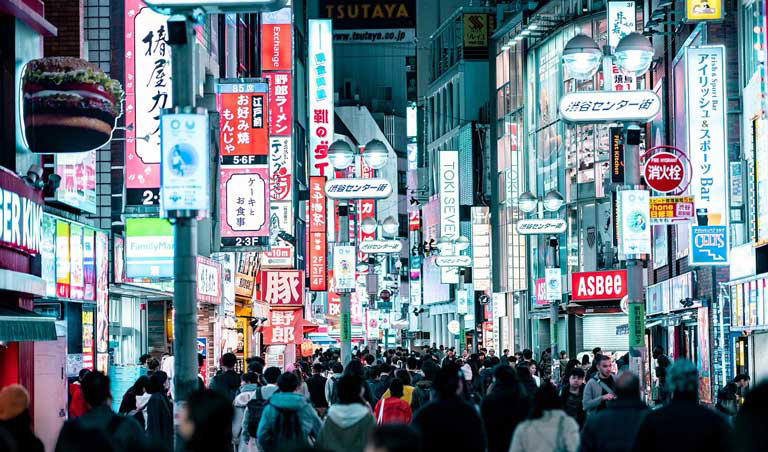

IMAGES
VIDEO
COMMENTS
Hakone Day Trip Itinerary. Make the most of a day out in the mountain town of Hakone, only 1.5 hours from Tokyo, with our Hakone Day Trip Itinerary. We've included a second day extension for those who want to stay overnight and explore the area further. When it comes to day trips, Hakone is one of the top choices for most visitors to Japan.
Find out how to take the perfect day trip to Hakone from Tokyo below. The beautiful mountain town of Hakone is located less than 100 km from Tokyo (1.5-2 hours). And with its stunning scenery, Mount Fuji views and hot springs, it makes for the perfect day trip from Japan's capital city.
Since Hakone is only 100 km from Tokyo, the climate is more or less similar to Tokyo. In general, the temperatures are slightly lower and there is a higher chance of rain. Since both climates are the same, Hakone is an ideal day or weekend trip in spring or autumn. However, the best chances of seeing Mt Fuji are in winter, when temperatures are ...
Mt Fuji and Hakone Day Trip. One of the most popular packages is an all-inclusive sightseeing day trip from Tokyo that takes you to both Mt Fuji and Hakone. You can take a bus tour with Klook — this costs US$85.76 *. However, Viator also offers a similar itinerary, but you can ride the Shinkansen back to Tokyo.
Having spent time in the Hakone region we have put together our recommended Hakone itinerary for a 1-2 day visit, including various options depending on your personal interests. Things to do in Hakone include fun train, boat and bus trips, a ropeway trip, exploring a volcanic area, views of Mt Fuji when the weather is co-operative, shrines and ...
8AM: Shinjuku Station - Board the Odakyu Romancecar bound for Hakone-Yumoto. 9.30AM: Hakone-Yumoto Station - Take the Hakone Tozan Bus bound for Hakone-machi-ko (H Line) 10.30AM: Take a 10-minute walk to Hakone-jinja Shrine. 12PM: Take a 10-minute walk back to Motohakone-ko and board the Hakone Sightseeing Cruise.
The Basics. Here are just a few essentials to think about when going about the day trip: Duration: 6 - 8 hours to fully enjoy the experience (starting in Odawara) Cost (with JR Pass): 5,000 JPY. Cost (without JR Pass): 6,100 JPY (includes round trip from Tokyo) Weather: Mount Fuji Forecast. Guided Option: Hakone Tour.
A perfect way to enjoy Hakone is to follow a round course itinerary. It encompasses all the main places of interest and uses all the five means of transportation. Actually, six - your feet as well 😊. You can start this 1 day Hakone itinerary at any of the local villages, returning to the same one - it's a circuit.
The opening hours are 9 am to 5 pm and the last entry is at 4:30 pm. Moreover, the entrance fee is 500 yen, however, if you have the Hakone Free Pass, then you can purchase a discounted ticket for 450 yen. Hakone Checkpoint and Hakone Sekisho Exhibition Hall / Tokyo to Hakone Day Trip. NUMBER 6.
In fact, this expansive outdoor sculpture museum is worth a day-trip to Hakone on its own, as there simply isn't anything like it in Tokyo. Hakone Open Air Museum was Japan's first outdoor sculpture park, when it opened in 1969. The 70000 acres featuring 120 sculptures by the likes of Henry Moore, Barbara Hepworth, Kyoko Asakura, Taro ...
The cherry blossoms peak in Hakone in early April, which might be the reason why most of the hotels are sold out then. A lot of Japanese head to Hakone to view the cherry blossom. Hakone is totally doable as a day trip from Tokyo or on your way to Tokyo. Make sure you take one of the early morning trains, so you have a full day in Hakone.
It runs every 15 minutes from 9am to 80pm on weekdays and is a short 3 minute ride to Hakone Yuryo. There are large communal baths called 'Honden Yurakuan Oyu', costs ¥1,500 for Adults. It also offers 19 private open-air onsen baths called 'Hanare Yuya Kaden'. It costs ¥3,900-¥56300 per hour for a private onsen.
Transportation and itinerary planning for a one-day trip to Hakone. If you start from Shinjuku Station in Tokyo, you can take the Odakyu Electric Railway to Hakone Yumoto Station to start a full-day Hakone day trip. Under normal circumstances, because it takes 2 hours to take the Odakyu Electric Railway train from Shinjuku Station to Hakone ...
Odawara is located at the east of Hakone Region, and is known as the gateway for guests coming from Tokyo to Hakone. Odawara station is directly accessible from Shinjuku in Tokyo. Take the Odakyu line from Shinjuku Station. The Rapid Express takes between 90 - 100 minutes. Waiting for our third Japanese train of the day.
1. Visit Hakone Shrine. The first stop to visit during your day trip Tokyo to Hakone is Hakone Shrine. Located at the base of Mount Hakone, this beautiful shrine has a history dating back to more than 1200 years ago. Hakone Shrine is highly visited by the travellers to pray for overall better luck or a safe trip.
Hakone Day-Trip Itinerary (Clockwise Route) From Hakone-Yumoto station, all the main attractions can be covered in a circle around Hakone so there's 2 ways around it. Most people take the anti-clockwise route starting from taking the Hakone Tozan train to Gora and ending at with a bus ride from Moto-Hakone. This route is ideal because the ...
Learn more about this trip: https://www.japan-guide.com/ad/digital-hakone-freepass/On this one-day trip, we explore Hakone, a popular destination close to To...
A Bit of Info About Hakone. Location: Hakone is a mountain town located in the Kanagawa Prefecture of Japan, about 100 kilometers (62 miles) southwest of Tokyo. How to get there: The trip from Tokyo to Hakone takes about 1.5-hours by train, making it perfect for those seeking an escape from the big city. Things to do: Hakone offers beautiful scenery, rich history, spectacular views of Mount ...
Hakone is an easy day trip from Tokyo and offers some awesome geology and unique things to see, including the incredible Mt Fuji. Here are some of the main reasons why you should visit Hakone.: Breathtaking natural scenery - Hakone is located within the Fuji-Hakone-Izu National Park, home to lush forests, volcanic peaks, and Lake Ashi. The ...
Odakyu Romancecar directly connects central Tokyo to Hakone in approximately 80 minutes, and a classic tour of Hakone is a round course which can be completed as a day trip. This round course starts and ends at Hakone-Yumoto Station, the entrance to Hakone, and is easily completed by public transportation. In this article, I will be going on a ...
You should take the Odakyu Romance Car from Shinjuku Station of the JR Tokaido Line and transfer at Odawara Station. Either trip will take less than two hours. There is a lot to see so get started early if you are planning to make a day trip to Hakone. A day trip from Tokyo to Hakone should start about 8:30am and get you back to Tokyo around 6 ...
The base pass is for 2 days but it's still great value for a day trip, then there's a 3-day version if you're staying a couple of nights. The ticket we purchased was Y4000 (just over $43 Australian dollars). It covers all the transport you'll need, the Tozan train and the cable car, the Hakone ropeway, a sightseeing cruise on Lake Ashi ...
Hakone Navi Official Tourism Site: First Trip to Hakone Itinerary. If you want the easiest option book a bus tour day trip. There's lots of these options too. Then you just get on the bus in central Tokyo and they drive you around to all the key spots. You can Google Hakone bus tour for options.
Tokyo has all sorts of attractions to offer, but venturing outside the bustling city for a day trip can unveil another side of Japan. Join Jason and Paul as they explore the many diverse experiences that can be had just beyond Tokyo's borders! ... Hakone Odawara Omiya Yokohama Chiba Shizuoka Join our Discord community! Become a member on ...
ChosenBreeze. • 12 min. ago. The 5000 yen 2 day Hakone free pass is worth it if you're doing the "Hakone Loop" just once. Upgrading to a free pass that includes a round trip from Shinjuku is not worth it if you're only doing one way to Shinjuku. You can ride Romanecar with or without the free pass, it doesn't change the cost calculus.
30 likes, 0 comments - nzdan83 on March 25, 2024: "Day trip to Hakone ️ was a drizzly, cloudy day so saw fuck all from the rope way 藍 but still a really nice day exploring ..." Day trip to Hakone ️🇯🇵 was a drizzly, cloudy day so saw fuck all from the rope way 🤣 but still a really nice day exploring ... | Instagram
97 reviews. 27 helpful votes. Culture Day 2024. Apr 5, 2024, 1:45 AM. Save. Am at the end stages of finalising itinerary and wanted some advice on day trips on the Culture Day weekend (2nd - 4th November). I am in Tokyo from 30/10 to 5/11, departing on the 5/11 for one night in Lake Kawaguchiko. I am planning to do day trips to Nikko and Hakone ...
Hakone is a charming and unique area with a volcanic valley, a pirate ship cruise and beautiful hiking trails. It is one of the best day trips from Tokyo for families! Other things to do in Tokyo ...